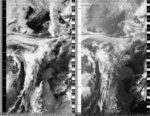2025-07-05 08:20:16
Steve Engelmann
Pacific Palisades, California, United States
United States
NOAA-15
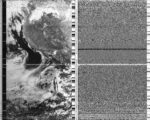
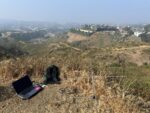
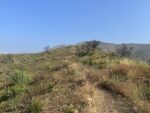
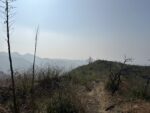
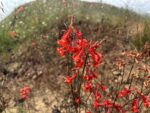
NOAA 15 was flying by with a great exposure of 88°, so I went for a short hike into the Santa Monica Mountains. The marine layer, known here as "June Gloom", is starting to burn off earlier in the morning as it was today. Most of the burned lots from the Palisades Fire have been cleared, but you can still hear some jackhammers at work. Six months after the start of the Palisades Fire most of the terrain is covered with plants. The burnt skeletons of taller shrubs have fresh, knee-high growth at the base. A friendly assortment of wildflowers bring yellow, orange, purple, white and red to the scene. Scarlet larkspur was showing off near the satellite capture.
After decoding the digital file, I was disappointed in the missing infrared channel. Looking at other NOAA 15 submissions, this seems to be a pattern. With the demise of NOAA 18, it looks like NOAA 15 may be next.
2025-07-04 22:48:33
Tom Lye
Bidston Observatory, Wirral, United Kingdom
United Kingdom
NOAA-19
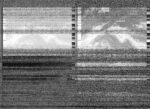
Sunny and hot over the last few days with the first rain coming last night - increasing clouds and spots of rain tonight with a big downpour coming soon. A nice group at Bidston Observatory with multiple folks holding the antenna and finding the beeps!
2025-07-04 11:11:53
Richard A Carter
University of York, Campus East, United Kingdom
United Kingdom
NOAA-19
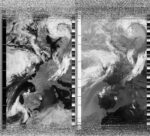
2025-07-04 09:56:09
Richard A Carter
University of York, United Kingdom
United Kingdom
NOAA-15
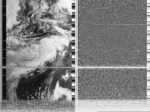
2025-07-03 11:26:07
Richard A Carter
University of York, Campus East, United Kingdom
United Kingdom
NOAA-19
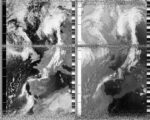
As a glider pilot, the sky today was wondrous: an ocean of large, fluffy white clouds with flat dark undersides, spreading from horizon to horizon - a clear sign of substantial thermal activity. The UK specific RASP weather model rated today five stars throughout the entire day - the star rating being the cumulative predicator of all the factors that can generate 'lift' for any soaring flight, with five being the very highest. Indeed, a glance at Flight Radar indicated that nearly every glider going was soaring UK skies today. The necessities of work meant that I could not join them, but an enjoyable sounding of NOAA 19 all the same, albeit marred by noise.
2025-07-01 11:50:02
Richard A Carter
University of York, Campus East, United Kingdom
United Kingdom
NOAA-19
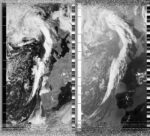
A gloomy, flat overcast, to match the mood - every satellite sounding is a quiet meditation, a few minutes to step away from troubles and focus intently on the ringing stream of data coming through. Yesterday was one of the hottest June days on record in the UK, and, though cooler day, the heat still lingers.
2025-06-28 19:02:18
Soph Dyer
Achmelvich, Scotland, UK
UK
NOAA-15
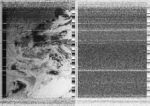

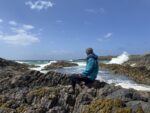
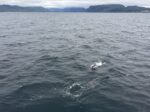
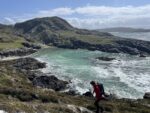
From the crew of the ferry from Mallaig to Armadale, I learned the joy of stopping take in what is in front of you.
In front of us was a pod of Short-beaked common dolphins. The crew turned the ferry towards the dolphins and killed the engine – it was a moment of collective joy.
From Ocean Vuong, I understood that "The hardest thing in the world is to only live once."
2025-06-27 11:00:05
Richard A Carter
University of York, Campus East, United Kingdom
United Kingdom
NOAA-19
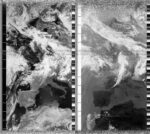
Quiet campus, wave-like formations of cloud overhead, a gentle breeze. A heat wave is impending for this weekend. Some rain last night, but too little overall.
2025-06-23 21:43:36
Alan Robertson
Bathgate, West Lothian, UK
UK
NOAA-19
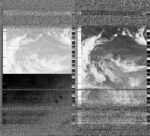
2025-06-23 11:50:19
Alan Robertson
Bathgate, West Lothian, UK
UK
NOAA-19
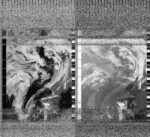
2025-06-22 12:04:38
Sasha Engelmann
Hackney Downs, London, United Kingdom
United Kingdom
NOAA-19
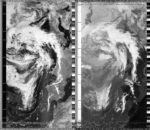
We woke up to news of US airstrikes on Iran. Operation 'Midnight Hammer' was later outlined in a press conference at the Pentagon as an 'overwhelming success'. Trump's actions were commended as 'bold and brilliant', and soldiers were called 'warriors'. God was invoked several times. Watching from London, I couldn't help but remember Brian Massumi's analysis of speeches by Ronald Reagan, and the way the content of Reagan's speeches mattered less than the way affect was 'modulated' on screen. Today, affect was heavily 'modulated' with word choice, repetitive gestures, and an absurd performance of stature and power.
The longest day of the year in the Northern Hemisphere passed by in a blur of heat. This weekend, London faced its first amber heat warning from the Met Office since 2023. At Loughborough Junction in South London yesterday, passengers were forced to wait in overcrowded, boiling train cars for up to two hours, and ultimately to walk along the hot train tracks to evacuate between stations. The dry, brittle grass of Hackney Downs was dotted with sunbathers but many people also hurried across, not willing to stop at the height of noon.
2025-06-19 11:00:42
Richard A Carter
University of York, Campus East, United Kingdom
United Kingdom
NOAA-19
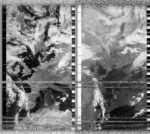
A fierce morning, sunlight pitching down, and a breeze that brings little immediate respite. The first of the summer heatwaves is here. Still sounding the remaining APT NOAA satellites where time and space permit. In recent weeks I have noticed a wandering band of noise, ill defined, which occasionally intersects with the NOAA signal, as here, and disrupts the reception.
2025-06-18 22:02:48
Nagy Istvan
Lajosmizse, Hungary
Hungary
NOAA-19

2025-06-18 08:33:06
Alan Robertson
Bathgate, West Lothian, UK
UK
NOAA-15
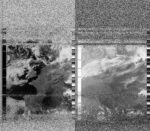
2025-06-17 23:06:11
Derrick Yohn
Transfer, Pennsylvania, United States
United States
NOAA-19



Images: (1) - Personal Weather Station at time of APT. (2)-APT Imagery with map overlay.
2025-06-17 21:19:15
Alan Robertson
Bathgate, West Lothian, UK
UK
NOAA-19
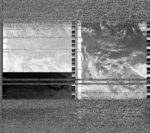
2025-06-17 08:59:13
Alan Robertson
Bathgate, West Lothian, UK
UK
NOAA-15
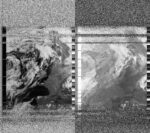
2025-06-17 08:28:13
Nagy Istvan
Lajosmizse, Hungary
Hungary
NOAA-15
Cloudy, 20Celsius, 62%Hum, 1021kPa, variable wind.
I missed the pass...
2025-06-16 23:15:42
Derrick Yohn
Transfer, Pennsylvania, United States
United States
NOAA-19




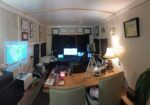
Photos: Weather Station Data at time of APT submission, Outside of weather office, 2 Interior photos of weather office. This is my 'outside office' typically used for Auxiliary Communications, Weather Analysis and other projects.
2025-06-15 11:02:26
JC
Nashville, TN, United States
United States
NOAA-19
2025-06-16 19:13:01
Alan Robertson
Bathgate, West Lothian, UK
UK
NOAA-15
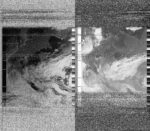
2025-06-15 21:45:36
Alison Scott
Arbroath , Scotland
Scotland
NOAA-19

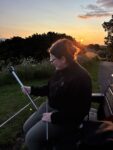
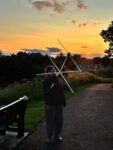
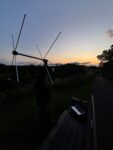
We’ve come over to the park in search of more open skies, but realise with the satellite travelling to the east the trees - a tangle of Scots pine, brambles and elder - will be in the way. Still. The sun is getting lower but you can tell it’s close to the solstice: a long bright evening. I’ve roped Aaron in to join me, and we set up on a bench near the top of the hill, next to the water tower. Kids on bikes and wandering teens don’t give us much notice. Around where we settle the broom is already full of leafy-green pods, cow parsley is high and my hayfever is off the charts. The pond below is gleaming with the setting sun, and to the west there’s an open view along the coast when the beachfront opens up and the Tay joins the North Sea.
I haven’t seen Aaron in a few days so I catch him up a bit about the End of Life Nowcast, and we reflect on the last one, during COP26 in Glasgow, laptop precariously shielded from lashing rain by a wonky brolly. It can be very useful to have a helper, whatever the weather is doing.
I think of NOAA18 still circling, silently. Pointing the antenna at the horizon, I realise I’m bracing to hear nothing, but out of static comes the familiar tones of NOAA19, if a bit faint (due to the trees). Again the idea: ‘the static's like the sound of thinking.’* I should really get another USB extender, or tape it together, this one is a bit loose fitting and when it detaches slightly from the dongle the recording stops and I have to restart it. So, my recording for this pass is in two parts. Both about 5mins. If I splice the audio files together and upload the file, what happens? Thinking with the glitch, being happy with the lack of and resisting the idea of a ‘good’ or clear image is always part of this process. Need to remember this. A counter to the closed, fabricated smoothness and place-less certainty of the pin sharp google image. The space that these DIY processes open with their fuzziness, the image’s materiality written in the grain.
*Tom McCarthy, ‘C’ (Vintage, 2010) pg63
2025-06-16 11:38:54
Richard A Carter
University of York, Campus East, United Kingdom
United Kingdom
NOAA-19
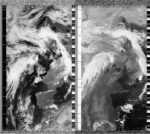
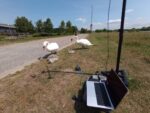
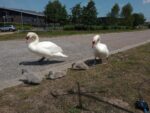
In the hope that the APT continues for a while yet, I couldn't resist trying another sounding today. Main highlight, however, was a very close terrestrial encounter with some interested passers by! (* I would not normally go anywhere so close, of course, but these particular visitors made a bee line for me and then peacefully waddled by - although I did shuffle behind the antenna as they did so!)
2025-06-15 12:52:37
EMBL ASTRONOMY CLUB
Heidelberg,Germany, Germany
Germany
NOAA-19
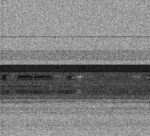
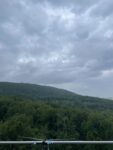
rainy, cloudy
2025-06-16 11:38:23
Alan Robertson
Bathgate, West Lothian, UK
UK
NOAA-19
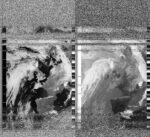
I wasn’t sure what to expect today with NOAA 19, but a strong signal is still being received on APT. Will you continue the project if APT remains active?
In terms of learning I have learned more of what doesn’t work rather than does work! Ferrite beads, position of the antenna, line of site not necessarily height, different antenna builds, directors, reflectors, element types, copper tape, wire types, skin effect, ¼ wave stubs, shielding, noise removing, software compiling, and a general “can do” spirit. VHF is ideal for inspiring and learning as it’s so hands on and forgiving if you don’t quite get it right, especially with the NOAA satellites.
I’ve started looking at the Meteor M2-3 and M2-4, and perhaps I might try other satellites at the 1700MHz range, but I can guarantee one thing - I would never have even thought this was all possible from an amateur set up without having experienced NOAA’s 15, 18 and 19! They truly are astonishing.
2025-06-16 07:07:24
Nagy Istvan
Lajosmizse, Hungary
Hungary
NOAA-15

21,9 Celsius,63%humidity, 1017kPa, variable wind, no clouds.
2025-06-15 23:56:00
Derrick Yohn
Transfer, Pennsylvania, United States
United States
NOAA-18


FLY BY - Ode to NOAA-18
I watched and I waited as you were set to fly by
A perfect night for reception, as we had a clear sky
As you grew near, there wasn't a peep
all of your speaking instruments were all fast asleep
You are right over head! But the static remains
I messed with the volumes, I messed with the gains
I watched on my tracker as you slowly flew by
my S-meter grounded, the waterfall was dry
We bid you farewell, oh watcher of the sky
and I will always remember you, as you silently fly by
2025-06-15 21:47:38
Derrick Yohn
Transfer, Pennsylvania, United States
United States
NOAA-19
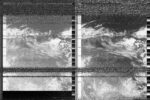

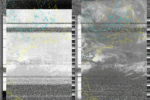
2 Extra Images are NOAA 19 Encoded with map overlay and my Personal Weather Station Data. A big SHOUT OUT to open-weather.community (Sasha & Co.) for bringing this to life and allowing us amateur radio/satellite/weather enthusiasts to have a place to share our work. Another Shout out to NOAA-15, NOAA-18 and NOAA-19 for years of relentless service. I don't know your fate, but I hope its as deserving as the service you have provided over the years. We will miss your shadows and echoes, but you will always be remembered in the annals of communities such as this. Fly high and free.
2025-06-15 20:37:17
Audrey Briot
In the village where I grew up and live, Saint André, Pyrénées Orientales, France
Saint André, Pyrénées Orientales, France
NOAA-15

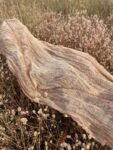
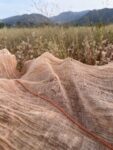
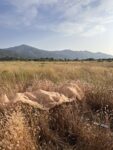
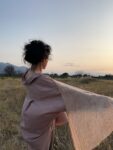
Particules have been in the air for weeks without interruption.
Depending on their density, the blue sky, the clouds and the sun are indistinguishable. The sky is white, blinding.There's a veil between us and the trees. Today was a little bit better than it had been for several weeks. Yesterday I was even worst ; in the night it rained for 2 or 3 minutes and dust settled.
2025-05-15 23:09:16
Audrey Briot
Merzouga, Morocco
Morocco
NOAA-18

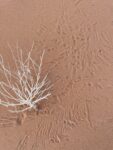
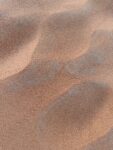
At night, life, elements and forces draw the star of Morocco.
2025-06-15 22:41:00
Eliot Lambert, Domi Rybova, Greta Weston, and Barbara Mele
Legoli , Italy
Italy
NOAA-19
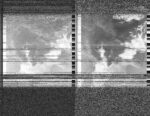
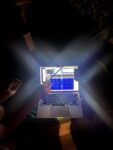
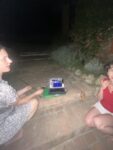
This is the first time I've picked up a NOAA satellite pass outside of NYC - I'm on a holiday with my close friends in rural Italy and it is unbelievably peaceful here - the dawn chorus/sound of cicadas at night is a far cry from the noise pollution of NYC...we just discovered a new birdsong from a Eurasian Nightjar - and it sounded like clockwork - or a faint chainsaw - it was beautiful and bizarre...I was scared we wouldn't pick up the NOAA 19 signal but after initial static it was so clear and was joyful to introduce my friends to SDR/to this methodology - one of my friends held the antenna for 15 minutes with impressive stillness - and we took a collective pause. And then to experience the decoded APT and the ephemeral cloud formations that emerged!! The last 6 minutes of the transmission were filled with static as seen on the bottom of the image - but I think I like that!
2025-05-15 19:44:58
Audrey Briot
In a tiny desert, Morocco
Morocco
NOAA-15
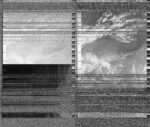
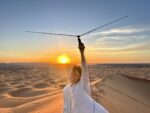
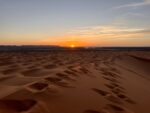
An empty place filled with waves.
2025-06-15 10:54:25
EMBL astronomy club
Heidelberg, Germany
Germany
NOAA-19
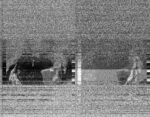
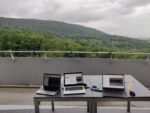
The weather was cloudy and rainy. The image of the region captured showed clouds over a part of the land regions.
2025-06-15 21:48:26
Daniel
Cambridge, United Kingdom
United Kingdom
NOAA-19
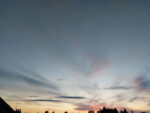
A fairly normal, sunny June day with sudden rain showers around noon.
2025-06-15 21:44:22
Alan Robertson
Bathgate, West Lothian, UK
UK
NOAA-19
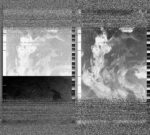
2025-06-15 10:46:46
Steve Engelmann
Santa Monica Pier, United States
United States
NOAA-19
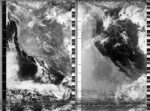
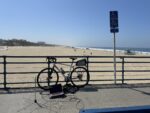
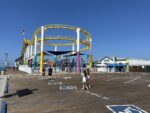

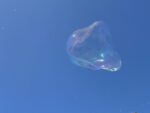
I went to the Santa Monica Pier to capture NOAA 19 as it flew over. The pier was a little busier than recently. The weather was great. School is out. It is Sunday and Father's Day. I was approached by a group of what I guess were Chinese tourists. They asked if someone is doing this in China. Almost a soon as they finished the question, they added, probably a bad idea. Another man was entertaining people with his bubble making abilities. The problem was his audience was up on the pier. He was down below on the sand. His tip bucket was in the sand next to him. Just as I was packing up a small airplane flew by pulling a sign that read, "TRUMP YOUR BDAY SUCKED #NOKINGS".
2025-06-15 18:57:07
Soph Dyer, Nicola Locatelli, Mykola
Steinspornbrücke, Wien, Austria
Austria
NOAA-15
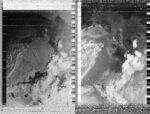
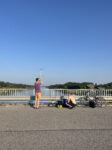
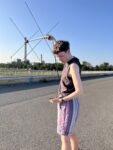
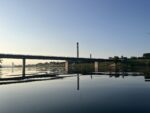
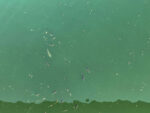
1.
It is a hot, cloud free day as Nicola and I drive down Refinery Road to a bridge over the Danube to capture this last image from NOAA-15's 'Extended Life' operations.
Car parking spaces back onto the river bank and grill parties are in full swing. Charcoal smoke and river mist hang in the air. Large groups of friends and families have set-up chairs, tables and gazebos. On the far side of the bridge, the road curves away creating an only slightly more secluded area that is designated nudist. The nudist zone extends well beyond its official markings on the cycle path that announce, 'FKK' (Freikörperkultur or Free Body Culture).
Nicola and I set-up our makeshift satellite ground station at centre point of the bridge: my rucksack shielding the laptop from cyclists, large cat fish swimming below. We are soon joined by Mykola, who introduces himself as being part of a 'space team'. Mykola is Ukrainian, has purple hair, and an immediate warmth about him. He stays for the entire satellite pass and after we listen to air traffic control chatter. Mykola has more technical knowledge than me, but is humble in his questioning and openness to learn. It is a good feeling to have shared this particular satellite pass with someone so enthusiastic, and at such a beautiful location.
2.
This symbolic image of three satellites transitioning to different 'life phases' is for my siblings. Three being, for me, ever associated with navigating siblinghood. Three in the back of the car, three battle-scarred teenage bedroom doors, and the skill I had no choice to develop of being able to accurately divide anything into three equal parts. I am one of four but my youngest sibling joined us years later. So, Ray and Joe: this image of transition, of storms, and of night turning to day, is for you.
3.
I am writing this Weather Note a day late, sat in bed, my mind and body still trying to cohere after ten days of international travel for work. I have a strong, consuming feeling that I have experienced since childhood, which is the world needs to slow or stop or pause just long enough for me to catch-up. I first felt this way as a primary school-aged child, sat on the intensely patterned carpet of the stairs in my parent's house, overwhelmed by the conviction that Earth was spinning too fast. I worried that if it sped-up anymore, I would be thrown off and tumble in outer space, my home receding into the darkness. I had good reason to feel this way, I was multiple academic years behind my school mates, unable to read even the most basic words.
Now, when I read the news, I have the sense that geopolitical events are accelerating. Yesterday, Iran and Israel exchanged missiles ("Tehran will burn" warned Netanyahu), the day before a US lawmaker and her husband were assassinated. Throughout, people in Gaza continue to be be killed by the Israeli military as they seek food aid.
In these unreal days, my thoughts often drift to our collaborator and friend, Golrokh Nafisi, who is in Tehran with her family.
2025-06-15 19:42:39
Alison Scott
Arbroath , United Kingdom
United Kingdom
NOAA-15
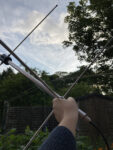
A partial image. Not where I intended to be. It's been a while since listening with the turnstile antenna, now the AGS is installed, and returning from some time away I'd forgotten my laptop needed charged. So, just catching the end of the pass by the time it had enough juice to get going. I'll head out later for NOAA19, energies permitting. This, a portion of NOAA15's pass, came as I sat on the slightly shoogly picnic bench in my wee bit of back garden, a bit too close to the building. The street in the post-tea-time lull, all the washing just taken inside from the lines that criss cross with the antenna's spindley structure as I look through it. There was a big storm here yesterday, thunder, the works, but I wasn't here, and just now it's bright and calm. Quite humid. I've just emptied assorted pots and trays of the water that gathered. I've got 3 bags with potatoes growing in them, right in front of me, and I noticed while listening to NOAA15 that the first flowers have bloomed since I was away. They are gently blue: it's a mystery purple potato seed that was gifted without a name nor an instruction. Perhaps we will yield a portion or two.
2025-06-15 12:52:38
embl astronomy club
heidelberg, germany
germany
NOAA-19
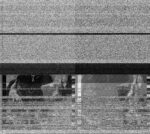
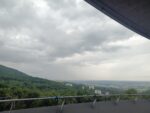
cloudy
2025-06-15 19:39:07
Alan Robertson
Bathgate, West Lothian, UK
UK
NOAA-15
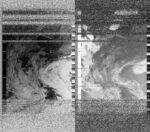
2025-06-15 08:43:21
Steve Engelmann
Pacific Palisades, California, United States
United States
NOAA-15
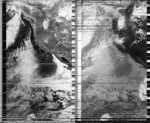
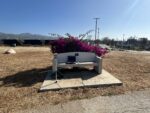
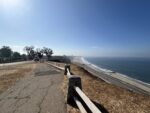
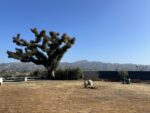
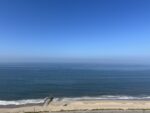
This was the first morning this summer that didn't start off under a marine layer. At the time of capture (08:43am) it was 20°C and will warm up to 27°C. Warm enough to push the marine layer out to the ocean. I could easily hear the waves crashing on the shore, as if I was on the beach. Early on a Sunday morning, the scene was very calm and tranquil.
2025-06-15 11:55:07
dan rhys wakefield
river thames near canary wharf, london, uk
uk
NOAA-19



I turn the corner onto the Thames Path and the sky opens out ahead of me, blue with white clouds scatted across it. The tide is at its lowest point and the river seems calm. This stretch of the river is ripe with new development in every direction and NOAA's signal weaves in and out of the towers as I listen. The pass rises to my north at Bow Creek, moving west across the sky, setting behind the new residential development under construction at Canary Wharf. The towers obscure the signal for the final minutes of the pass, so as I turn back towards the skyline all I hear is static, fading in and out of the tide as it crashes against the stone wall of the embankment.
2025-06-15 11:52:34
Sasha Engelmann
Hackney Downs, London, United Kingdom
United Kingdom
NOAA-19
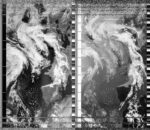
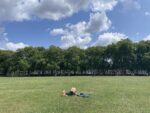
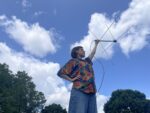
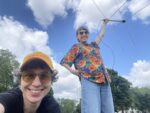
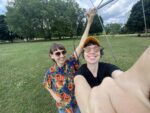
I sit on the browning grass of Hackney Downs in unseasonably warm weather and read Kaya Barry's latest article on 'unseasonable seasons'. Kaya - a fellow geographer, artist and allied thinker from many symposia and conferences - uses Rob Nixon's famous conceptual framework on 'slow violence' to explore changing meanings of seasons in a time of climate crisis. At least since colonial times, the seasons have been employed to overlay the Gregorian calendar and Western thought-systems onto many other landscapes and peoples, so that local observations of seasonality were heavily suppressed or treated as 'vulgar' (Barry, 2025). This is a slow violence of vernacular weather knowledge erasure. Yet the 'slow violence' of seasons is also about how unseasonable variations in temperature, rainfall, humidity, drought and cloud cover can sometimes be relatively subtle, minor variations, barely breaching thresholds of noticeability. I think of many years growing up in Los Angeles when an ever dryer and dryer, sunnier and sunnier winter was pleasantly enjoyed by most people I knew. Kaya cites artist Roni Horn: 'weather that is nice is often weather that is wrong' (2007: 10).
As I write, my home city of Los Angeles is invaded by the national guard: heavily armed military troops whose presence in a city that has just been devastated by wildfire is an obvious violence. 'First fire, now ICE' chant protesters in Pasadena and downtown LA, describing a feeling of living through a climate disaster that is underpinned and exacerbated by a human rights disaster, where migrant workers helping to clean up and remediate burned areas, not to mention how they sustain and contribute in myriad other ways to the culture, fabric and joy of life in Los Angeles, are ruthlessly targeted by ICE forces. The apocalyptic, elemental, even biblical metaphors of fire and ice are difficult to ignore.
These thoughts swirl like fractals as my partner and I catch one of the last passes of NOAA-19 over London to contribute to the open-weather 'end of life' nowcast, the day before most instruments on NOAA-15 and NOAA-19 will be shut down.
2025-06-15 11:53:35
Richard A Carter
University of York, Campus East, United Kingdom
United Kingdom
NOAA-19
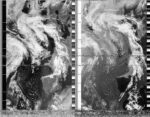
2025-06-15 11:54:51
Pauline Woolley
The Urban Garden, Nottingham, UK
UK
NOAA-19

The bees are busy. I wonder if they know.
2025-06-15 11:51:05
Alan Robertson
Bathgate, West Lothian, UK
UK
NOAA-19
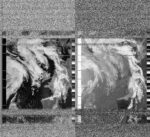
2025-06-15 19:08:10
YOHAN WON
Sejong City, South Korea, South Korea
South Korea
NOAA-15
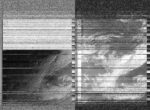
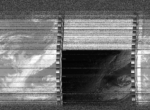
Captured on June 15, 2024 — the official retirement day of NOAA-15.
Received just before a summer downpour under the East Asian monsoon front.
The Korean Peninsula is hidden in clouds, but the image stands as a meaningful record.
2025-06-15 10:14:42
Pauline Woolley
The Urban Garden, Nottingham, UK
UK
NOAA-19

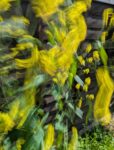
The rain from the night has cleared and sun begins to emerge along with heat and humidity.
An intermittent breeze moves the wild mustard flowers, creating a joyful sway. It bends instinctively, knowing what to do in order to move in time with the weather. In that brief moment it is apparent it's evolutionary development is far more refined than ours.
2025-06-15 09:52:02
Richard A Carter
University of York, Campus East, United Kingdom
United Kingdom
NOAA-15
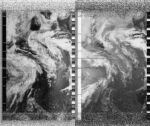
2025-06-15 09:51:32
Alan Robertson
Bathgate, West Lothian, UK
UK
NOAA-15
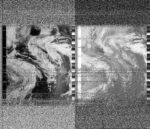
2025-06-15 08:11:41
Alan Robertson
Bathgate, West Lothian, UK
UK
NOAA-15
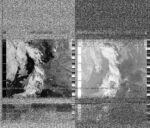
2025-06-15 06:32:31
JACQUES GENTIL
Quatre Bornes, Mauritius
Mauritius
NOAA-15

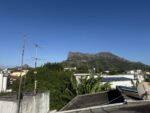
A rather strong anticyclone approaching from the South-West is causing moderate and relatively cold trades over our region.
2025-06-11 07:56:20
YOHAN WON
Sejong City, South Korea, South Korea
South Korea
NOAA-15


A humid summer morning in Korea. In small groups, my students built a DIY ground station and received this NOAA-15 image, clearly showing the monsoon front over the peninsula and Taiwan — a shared moment of wonder.
2025-06-15 09:28:29
Anna Madeleine Raupach
Sydney, Gadigal Country, NSW
NSW
NOAA-19
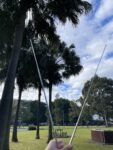
In sub-tropical Sydney, very green and humid for winter. I felt the climate today through noise - of traffic, planes, groups of people, sirens, and only a few birds. I could only recieve a faint satellite signal through it all, but am contributing the noise to the Now-cast.
2025-06-14 10:59:40
Steve Engelmann
Santa Monica Mountains, United States
United States
NOAA-19
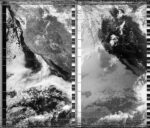
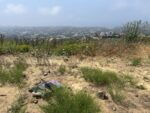
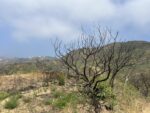
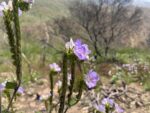

From a trail in the Santa Monica mountains just above Pacific Palisades I captured this satellite pass. The marine layer is beginning to burn off a little earlier in the day. What used to be a charred landscape just a few months earlier is now mostly covered with some plant life. Fresh growth is emerging from the base of many shrubs (chamise, laurel sumac, elderberry) as the roots are still very much alive. Coastal morning glory climb up burnt skeletons. Many bees take sips from large-flowered phacelia.
Meanwhile a "No Kings" demonstration in Santa Monica attracted thousands of peaceful protesters.
2025-06-14 09:38:37
Anna Madeleine Raupach and Leah Beeferman
Clear Range, Ngunawal Ngambri country, Australia
Australia
NOAA-19
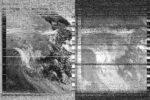
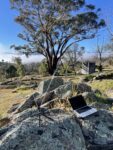
Recieved from a beautiful property in Clear Range, on a clear cold morning with bright blue skies up above the fog below.
2025-06-14 21:57:00
Alan Robertson
Bathgate, West Lothian, UK
UK
NOAA-19
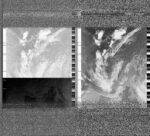
2025-06-14 21:13:02
Nagy Istvan
Lajosmizse, Hungary
Hungary
NOAA-19

No clouds, 18.3 Celsius, 64%Hum, 1021kPa, No wind, Sunset.
2025-06-14 20:05:25
Alan Robertson
Bathgate, West Lothian, UK
UK
NOAA-15
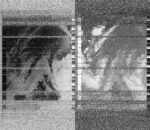
2025-06-14 12:03:46
Alan Robertson
Bathgate, West Lothian, UK
UK
NOAA-19
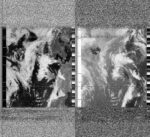
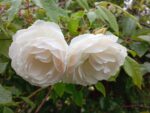
Warm with thundery downpours today - good for the garden!
2025-06-14 08:37:46
Alan Robertson
Bathgate, West Lothian, UK
UK
NOAA-15
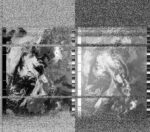
2025-06-14 08:00:00
Marius Sturza
Alba Iulia, Romania
Romania
NOAA-15
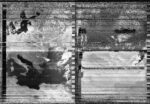
Today is a very nice day in my area, the temperature is expected to be around 25 Celsius, no clouds, 65% humidity and about 3km/h wind speed.
As this was one of the last good passes above my home, before NOAA shuts down transmissions, I wanted to immortalize this nice view of Europe and even Africa.
2025-06-13 22:09:41
Alan Robertson
Bathgate, West Lothian, UK
UK
NOAA-19
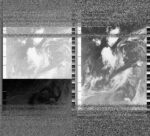
2025-06-13 11:13:18
Steve Engelmann
Pacific Palisades, California, United States
United States
NOAA-19
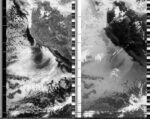
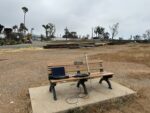
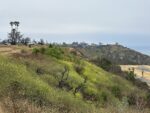
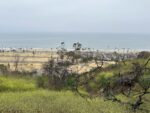
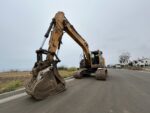
Returned to a spot in Pacific Palisades overlooking the Pacific Ocean. The overcast skies are typical "June gloom". In the second image you can see the opportunistic and invasive black mustard being among the first to recolonize after the fires. Below the bluffs there is a mobile home community which was completely wiped out by the Palisades Fire. On the left you can see the burned lots that have been cleared and covered with an organic pulp to help reduce dust. On the right of the same image are lots that have not been cleared yet.
Meanwhile, Los Angeles has been invaded by the National Guard which neither the mayor of governor requested. During the election, the current president categorized "illegal" immigrants as violent rapists and murders invading our country. Starting a week ago ICE officials started raiding a garment factory and a Home Depot where people go to find work. I didn't know the violent rapists and murders were also good a sewing and construction. Protests, mostly peaceful, showed up in a few areas. Questionable tactics targeting vulnerable workers justify the outrage.
2025-06-13 21:25:36
Nagy Istvan
Lajosmizse, Hungary
Hungary
NOAA-19
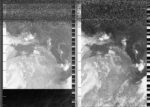
Sunset, no clouds, 17.5 Celsius, 1023kPa, No wind at moment.
2025-06-13 18:51:44
Alan Robertson
Bathgate, West Lothian, UK
UK
NOAA-15
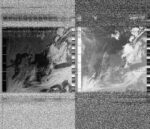
2025-06-13 12:16:29
Alan Robertson
Bathgate, West Lothian, UK
UK
NOAA-19
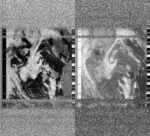
2025-06-13 09:03:54
Alan Robertson
Bathgate, West Lothian, UK
UK
NOAA-15
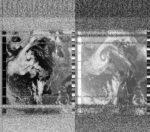
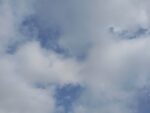
2025-06-13 09:04:26
Tom Lye
Bidston Observatory, Wirral, United Kingdom
United Kingdom
NOAA-15
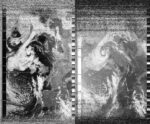
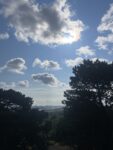
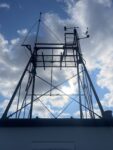
Very gusty on the roof today with fast clouds and pockets of sunshine! Nice to have a morning pass with NOAA-15 before I head back to London.
2025-06-12 22:23:35
Tom Lye
Bidston Observatory, Wirral, United Kingdom
United Kingdom
NOAA-19
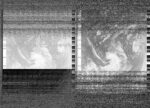
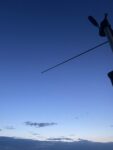
Lots of heavy rain this afternoon - walking through the woods and you could feel the clouds wanting to release for a long time before they did. A clearer sky this evening but it felt like there was more static in the air. I liked moving around a bit more this time and playing with the signal.
2025-06-12 19:17:40
Alan Robertson
Bathgate, West Lothian, UK
UK
NOAA-15
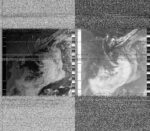
2025-06-12 12:29:37
Richard A Carter
University of York, Campus East, United Kingdom
United Kingdom
NOAA-19
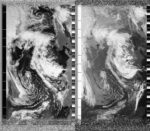
2025-06-12 10:49:45
Richard A Carter
University of York, Campus East, United Kingdom
United Kingdom
NOAA-19
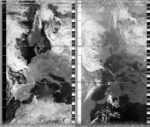
2024-12-12 21:54:12
clemens winkler
Berlin, Germany
Germany
NOAA-18




One of situated NOOA-18 readings as inspiration for a dramaturgical piece "Waiting for Satellite".
In this participatory play, new forms of dramaturgy emerge through our shared exploration of atmospheric phenomena—haunted by weather events, satellites, and cloud structures—as we attune to the invisible, question the origins and impacts of weather, re/pre/enacting weather events on stage. by MA students Anastazie, Annick, Frederik, Marla , Paolo, Szerafina, Yeganeh
2025-06-12 09:30:03
Alan Robertson
Bathgate, West Lothian, UK
UK
NOAA-15
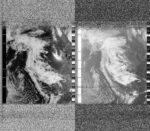
2025-06-12 08:51:34
Nagy Istvan
Lajosmizse, Hungary
Hungary
NOAA-15

Fully sunny, 18.8 Celsius, 1025kPa, wind: variable.
2025-06-11 22:36:57
Tom Lye
Bidston Observatory, Wirral, UK
UK
NOAA-19
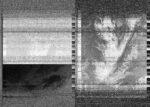
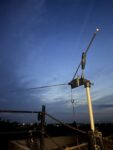
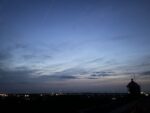
A warm and sticky day on Bidston Hill, with high clouds and wind moving in at dusk. I finally got the bits for a V-Dipole antenna and it felt nice to observe a passing satellite with an antenna in my hands.
I also felt a little sad knowing that NOAA18 had stopped signalling last week, so was galvanised to connect with 19 at last! More to come...
2025-06-11 22:35:11
Alan Robertson
Bathgate, West Lothian, UK
UK
NOAA-19
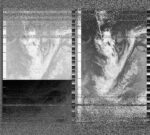
2025-06-11 19:43:49
Alan Robertson
Bathgate, West Lothian, UK
UK
NOAA-15
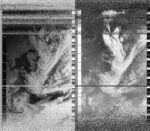
2025-06-11 11:01:03
Richard A Carter
University of York, Campus East, United Kingdom
United Kingdom
NOAA-19
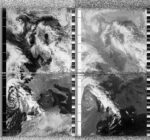
A large number of flying insects gathered around the antenna during this sounding, as Typhoon warplanes roared overhead. A collision of scales and contexts and modes of thinking and being in the atmosphere - as a critical medium of life, as a territory to be contested and controlled, as a domain to be observed and quantified, measured and modelled.
2025-06-11 09:56:43
Richard A Carter
University of York, Campus East, United Kingdom
United Kingdom
NOAA-15
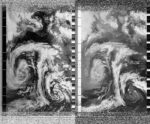
2025-06-11 11:01:06
Alan Robertson
Bathgate, West Lothian, UK
UK
NOAA-19
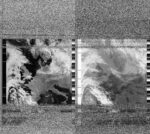
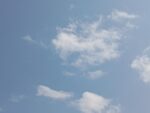
2025-06-11 08:16:21
Alan Robertson
Bathgate, West Lothian, UK
UK
NOAA-15
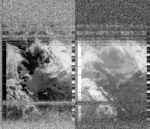
2025-06-10 11:13:45
Alan Robertson
Bathgate, West Lothian, UK
UK
NOAA-19
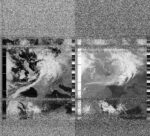
2025-06-10 08:42:26
Alan Robertson
Bathgate, West Lothian, UK
UK
NOAA-15
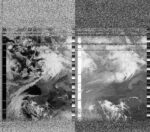
2025-06-09 21:19:59
Alan Robertson
Bathgate, West Lothian, UK
UK
NOAA-19
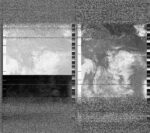
2025-06-09 18:56:22
Alan Robertson
Bathgate, West Lothian, UK
UK
NOAA-15
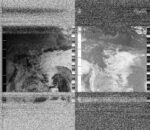
2025-06-09 11:26:27
Alan Robertson
Bathgate, West Lothian, UK
UK
NOAA-19
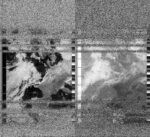
2025-06-09 09:08:33
Alan Robertson
Bathgate, West Lothian, UK
UK
NOAA-15
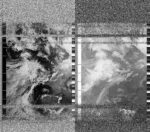
2025-06-09 08:30:05
Nagy Istvan
Lajosmizse, Hungary
Hungary
NOAA-15
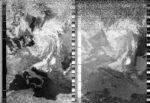
Fully cloudy, 15.9 Celsius, 1024kPa, Wind: 12.6km/h from NW.
2025-06-08 21:32:31
Alan Robertson
Bathgate, West Lothian, UK
UK
NOAA-19
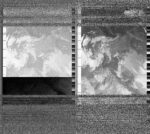
2025-06-08 19:22:20
Alan Robertson
Bathgate, West Lothian, UK
UK
NOAA-15
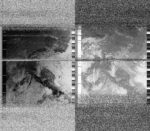
2025-06-06 13:03:24
Sasha Engelmann
Soph Dyer
under the magnolia tree, Ciutadella Park, Barcelona, Spain
Spain
NOAA-18

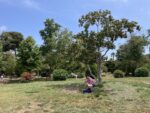
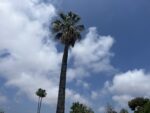
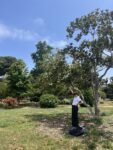
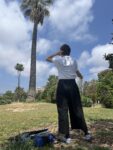
For open-weather, there is a politics to building and maintaining infrastructure to listen to systems at the threshold of transformation. In the long tradition of radio amateurs, cyberfeminists, and anticolonial practitioners, we feel that it is our responsibility to develop literacies with systems that capture and represent our planet – so that we are able to name and the violence they enact, as well as recognise their alternative meanings and potential openings for interventions or imagining otherwise.
For NOAA-18’s decommissioning, the collective was in Barcelona, Spain. We rushed from our lunch break to nearby Ciutadella Park and tuned to the satellite’s transmission for one last time.
2025-06-08 11:39:07
Alan Robertson
Bathgate, West Lothian, UK
UK
NOAA-19
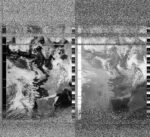
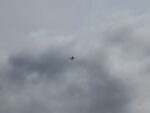
2025-06-08 12:40:55
Nagy Istvan
Lajosmizse, Hungary
Hungary
NOAA-19

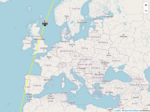
Sunny,, 29.4 Celsius, 1013kPa, Wind: 2.1km/h from West.
2025-06-08 09:34:43
Alan Robertson
Bathgate, West Lothian, UK
UK
NOAA-15
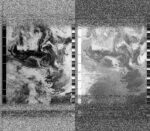
2025-06-08 08:56:18
Nagy Istvan
Lajosmizse, Hungary
Hungary
NOAA-15

2025-06-08 07:16:39
Nagy Istvan
Lajosmizse, Hungary
Hungary
NOAA-15

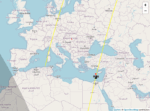
Sunny, 20 Celsius. Wind 8.2km/h, from NW.
2025-06-07 21:45:06
Alan Robertson
Bathgate, West Lothian, UK
UK
NOAA-19
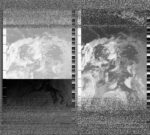
2025-06-07 19:48:30
Alan Robertson
Bathgate, West Lothian, UK
UK
NOAA-15
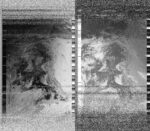
2025-06-07 19:18:02
YOHAN WON
Next to Sejong Arts Center, Sejong City, South Korea, South Korea
South Korea
NOAA-15
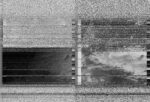
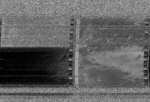
A cool summer evening.
I felt a sense of excitement and wonder as I held the antenna under the sky, listening to signals from space.
This was my first solo attempt before joining this project with my students next week — I’m thrilled to start this journey together!
2025-06-07 11:51:49
Alan Robertson
Bathgate, West Lothian, UK
UK
NOAA-19
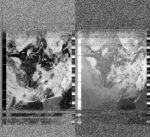
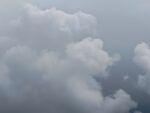
2025-06-07 08:21:38
Alan Robertson
Bathgate, West Lothian, UK
UK
NOAA-15
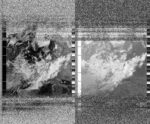
2025-06-07 07:42:35
Nagy Istvan
Lajosmizse, Hungary
Hungary
NOAA-15


Sunny. 24 Celsius degrees.
2025-06-06 21:57:45
Alan Robertson
Bathgate, West Lothian, UK
UK
NOAA-19
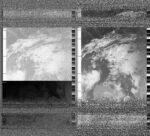
2025-06-06 19:36:00
wm6x
Ostrava, Czech republic
Czech republic
NOAA-15
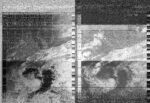
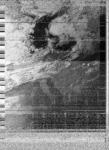
2025-06-06 12:05:10
Richard A Carter
University of York, Campus East, United Kingdom
United Kingdom
NOAA-19
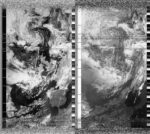
2025-06-06 11:57:45
Richard A Carter
University of York, Campus East, United Kingdom
United Kingdom
NOAA-18
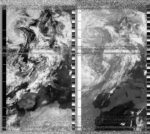
2025-06-06 11:56:49
Alan Robertson
Bathgate, West Lothian, UK
UK
NOAA-18
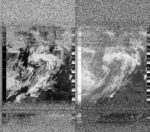
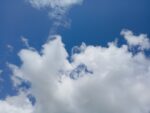
2025-06-06 08:47:06
Alan Robertson
Bathgate, West Lothian, UK
UK
NOAA-15
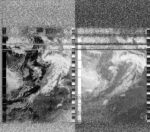
2025-06-05 23:43:42
Alan Robertson
Bathgate, West Lothian, UK
UK
NOAA-18
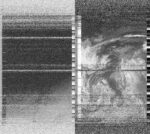
2025-06-06 09:38:18
Anna Madeleine Raupach
Ngunawal / Ngambri land, ACT Australia
ACT Australia
NOAA-19
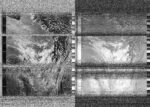
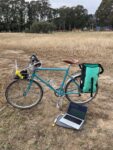
A cold morning after a frosty night - one of the first of our winter.
2025-06-05 22:10:25
Alan Robertson
Bathgate, West Lothian, UK
UK
NOAA-19
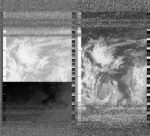
2025-06-05 22:59:20
Nagy István
Lajosmizse, Hungary
Hungary
NOAA-18


2025-06-05 21:26:20
Nagy Istvan
Lajosmizse, Hungary
Hungary
NOAA-19


My homemade QFH antenna, copper tube. RSP1A receiver, manual receiving.
2025-06-05 19:00:59
Alan Robertson
Bathgate, West Lothian, UK
UK
NOAA-15
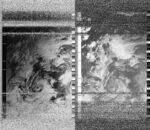
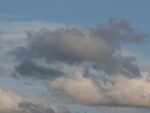
2025-06-05 12:09:43
Alan Robertson
Bathgate, West Lothian, UK
UK
NOAA-18
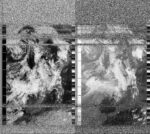
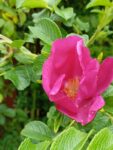
2025-06-05 09:13:14
Alan Robertson
Bathgate, West Lothian, UK
UK
NOAA-15
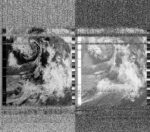
2025-06-04 22:16:02
Alan Robertson
Bathgate, West Lothian, UK
UK
NOAA-18

2025-06-01 10:35:35
Anna Madeleine Raupach
Ngunawal / Ngambri Land, ACT, Australia
ACT, Australia
NOAA-18

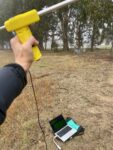
The heavy fog had not yet lifted by late morning, so tuning into NOAA connected me from below to above clouds in a particularly satisfying way. I have felt the climate crisis recently through the long autumn that has extended into winter giving us beautiful but unnervingly warm days for this time of year.
2025-06-04 21:38:54
Nagy Istvan
Lajosmizse, Hungary
Hungary
NOAA-19


2025-06-04 19:26:59
Alan Robertson
Bathgate, West Lothian, UK
UK
NOAA-15
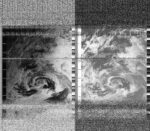
2025-06-04 12:24:03
Sasha Engelmann
Hackney Downs, London, United Kingdom
United Kingdom
NOAA-18
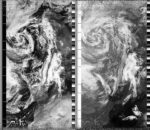
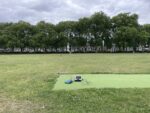
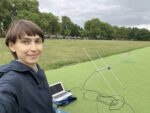
Today Soph and I learned (via Carl Reinemann) that "on May 31, 2025, the NOAA-18 STX-4 S-band downlink transmitter experienced an anomaly that resulted in considerable imagery degradation and data drop outs. Users are advised to discontinue use of all NOAA-18 science products immediately".
An announcement updated this morning further states "Based on NOAA’s requirement to responsibly manage on-orbit assets, NOAA will commence with decommissioning activities immediately for NOAA-18. The exact date/time of decommission is not yet determined, and is pending completion of pre-decommission processes". Such processes involve:
System Safing: Disconnecting batteries, disabling transmitters, and depleting propellants (like nitrogen gas) to make the satellite inert and prevent uncontrolled breakups.
Data Transition: Ensuring that all critical data streams from NOAA-18 are successfully transferred to newer, more advanced satellite constellations, such as the Joint Polar Satellite System (JPSS). NOAA-18, along with NOAA-15 and NOAA-19, has been in an "Extended Life" program, transitioning to a commercial ground system for continued operation as "data of opportunity," but this will cease.
Operational Handover: Shifting any remaining operational responsibilities or data product generation to other active satellites or ground systems.
Final Orbital Maneuvers (if applicable): While not always a de-orbit for end-of-life satellites like NOAA-18 (which will likely remain in orbit but be inert), some decommissioning processes might involve maneuvers to place the satellite in a safer, less congested orbital path.
Compliance Checks: Verifying that all decommissioning procedures adhere to national and international guidelines for space debris mitigation.
I saw an 88 degree NOAA-18 pass occurring over London and went outside to capture it. As it has always done since my first attempt receiving this satellite in July 2019, the characteristic APT signal reached my laptop speakers at the minute the satellite was due to crest the Northern horizon. I tried to observe any weakness in the signal, and couldn't detect any.
How many days do you have left, NOAA-18?
2025-06-04 12:22:38
Alan Robertson
Bathgate, West Lothian,
NOAA-18
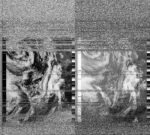
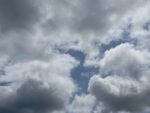
Today is mostly dry with patchy rain, which can be heavy at times.
2025-06-03 22:28:47
Alan Robertson
Bathgate, West Lothian, UK
UK
NOAA-15
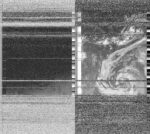
2025-06-03 19:53:11
Alan Robertson
Bathgate, West Lothian, UK
UK
NOAA-15
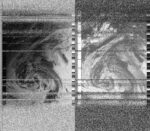
2025-06-03 12:43:09
Richard A Carter
University of York, Campus East, United Kingdom
United Kingdom
NOAA-19
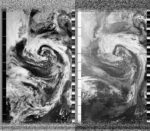
2025-06-03 12:35:18
Richard Carter
University of York, Campus East, United Kingdom
United Kingdom
NOAA-18
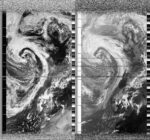
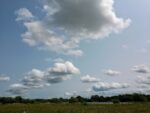
I've been reflecting recently on how my relationship with the atmosphere has changed since becoming a glider pilot. Different patterns and shapes of cloud are now read as resources for staying aloft, even on the ground. The photograph alongside this entry neatly illustrates a promising 'gliding sky' - large clouds with dark, flat undersides, and fluffy tops: all of which indicate potential for lift below. In particular, the clouds are forming a noticeable 'line of energy', that can be followed like a road, hopping from one source of lift to another. However, the one key aspect not captured here is the wind, which today would put paid to any flying - guests up to 32kts, which would exceed the safe takeoff and landing limits of any glider. Even if the wind was slightly lower, the strong drift would present a challenge for local soaring - hard to stay the course. Finally, there are sharp scuds of rain, which is always unwelcome, especially when airborne.
Today's NOAA imagery showcases the source of all this atmospheric energy very well, and I am very pleased to be on the ground!
2025-06-03 12:35:32
Alan Robertson
Bathgate, West Lothian, UK
UK
NOAA-18
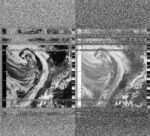
2025-06-03 11:01:49
Alan Robertson
Bathgate, West Lothian, UK
UK
NOAA-19
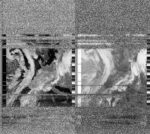
2025-06-03 08:25:39
Alan Robertson
Bathgate, West Lothian, UK
UK
NOAA-15
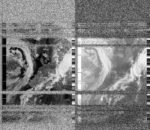
2025-06-02 22:41:35
Alan Robertson
Bathgate, West Lothian, UK
UK
NOAA-18
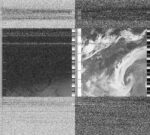
Strong winds.
2025-06-01 19:08:07
Sasha Engelmann
Hackney Downs, London, United Kingdom
United Kingdom
NOAA-15

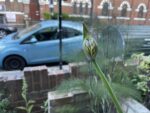
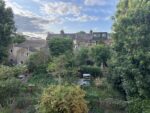
Today at a seminar, a woman asks me about 'witchy weather' and 'necromancy'. I blank on 'witchy weather' until I remember that, while the Palisades fire was still burning, my uncle sent me a YouTube video in which two men in a typical American podcast setting blamed the 'three lesbians' in the LA Fire Department, together with mayor Karen Bass ("rumoured to be a lesbian", they say) for the destruction of the fires. On the train ride home, I dig out an unfinished poem that I wrote some months ago using lines from that podcast. Reading it again, the link to the figure of the witch seems all too clear...
“The mayor was in Ghana
at a cocktail party
when she was warned
of the Santa Ana wind.”
“She was warned about the winds
that the chaparral had not been cleared
that there was not sufficient water”
“That she’d cut the fire department budget
by 17 million dollars
and wanted to cut it by 50”
“That she appointed an LGBTQ activist
as the fire chief
who bragged
she was to hire
70% DEI.”
~ ~ ~
“I just have to ask, as I don’t live in California:
Is most of the leadership of the LA fire department
overweight lesbians?”
“The fire chief is,”
“The assistant fire chief is,”
“There’s rumours the mayor is.”
2025-06-02 21:08:12
Alan Robertson
Bathgate, West Lothian, UK
UK
NOAA-19
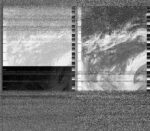
Gusty winds, cloudy, rain expected later.
2025-06-02 12:48:28
Alan Robertson
Bathgate, West Lothian, UK
UK
NOAA-18
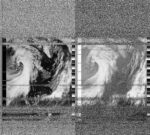
2025-06-02 11:14:29
Alan Robertson
Bathgate, West Lothian, UK
UK
NOAA-19
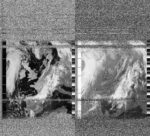
2025-06-02 08:51:45
Alan Robertson
Bathgate, West Lothian, UK
UK
NOAA-15
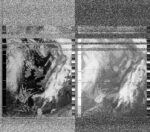
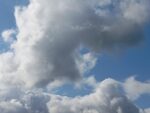
2025-06-01 22:54:25
Alan Robertson
Bathgate, West Lothian, UK
UK
NOAA-18
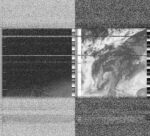
2025-06-01 21:20:42
Alan Robertson
Bathgate, West Lothian, UK
UK
NOAA-15
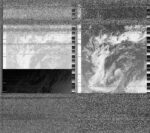
2025-06-01 12:01:44
Steve Engelmann
Pacific Palisades, California, United States
United States
NOAA-18





Today I returned to a spot on the bluffs of Pacific Palisades. I did a satellite capture at the same location on November 5, 2024 - the day of the US presidential election. While this location has a great view of the ocean, the early few minutes were problematic as there was a large eucalyptus tree blocking the northern horizon. The Palisades fire burned the foliage of that tree, but eucalyptus are know to tolerate fire. On the first image the tree looks like a fuzzy character from Dr. Seuss. The second image is looking up Temescal Canyon, one of the main access roads to the community. The four lanes are currently blocked to car traffic as it is being used to process and sort debris being removed from fire-damaged homes. The third image is from November 5th. It is interesting to compare the status of the road, the hillside homes and the mountains in the distance. The last image is towards the west with Malibu peaking out of the marine layer.
So much has transpired since the US election. Being ruled by billionaires has not been fun. Somehow I think they believe their wealth is a validation of their political ideology. Between the tariffs (taxes on Americans), the dismantling of government agencies, immigration anxiety, a shift away from science-backed health and environmental policy, the decline of reproductive rights, the instability of the US dollar, the general xenophobia and so much more, it scary that we aren't even 6 months in.
Perhaps what we are witnessing is the burning down of our country. Maybe the rebuild will offer opportunities to reimagine this country. It is hard to watch.
2025-06-01 19:05:37
Alan Robertson
Bathgate, West Lothian, UK
UK
NOAA-15
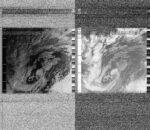
2025-06-01 09:20:47
Richard Brooks
Pembrokeshire, Wales
Wales
NOAA-15
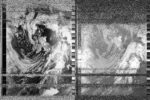

Mixed blue and cloudy sky, later overcast. Light breeze, Beaufort 2/3.
Rain in the west did not make it to the receiving station.
2025-06-01 13:01:23
Alan Robertson
Bathgate, West Lothian, UK
UK
NOAA-18
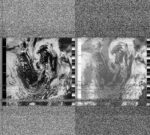
2025-06-01 11:27:10
Alan Robertson
Bathgate, West Lothian, UK
UK
NOAA-19
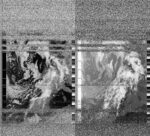
2025-05-31 23:07:18
Alan Robertson
Bathgate, West Lothian, UK
UK
NOAA-18
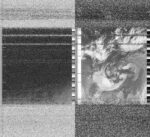
2025-05-31 21:33:14
Alan Robertson
Bathgate, West Lothian, UK
UK
NOAA-19
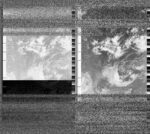
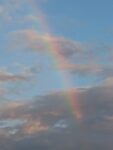
2025-05-31 19:31:38
Alan Robertson
Bathgate, West Lothian, UK
UK
NOAA-15
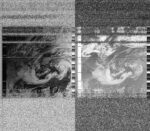
2025-05-31 10:59:20
Soph Dyer
Türkenschanzpark, Austria
Austria
NOAA-19
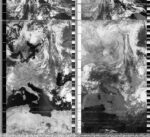
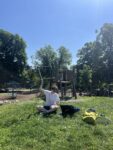
Despite planning to capture a high elevation NOAA-19 pass, when I loaded SDR++ it is NOAA-18's beep beep that I hear. I hit record before shifting frequencies, leaving NOAA-18 over the Balkans and picking-up NOAA-19's rising signal as the satellite crosses Finland. Unable to see my laptop's screen in the sun, I try but fail to stop and restart the recording, and so the software creates a long, stacked image.
In Vienna, we have had so much rain: light drizzle, heavy down pours, buckets, silvery mists, and sudden showers. It has also stayed unseasonably cold. Yet, since yesterday afternoon, the air has warmed and warmed until the temperature climbed to a body-loosening 28 degrees Celsius. The change has been so abrupt, it’s like the air arrived from somewhere else, already dried and heated. I will check the wind direction when home.
2025-05-30 23:20:14
Alan Robertson
Bathgate, West Lothian, UK
UK
NOAA-18
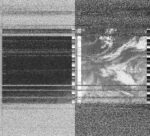
2025-05-30 21:45:50
Alan Robertson
Bathgate, West Lothian, UK
UK
NOAA-19
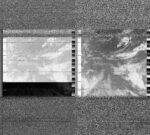
2025-05-30 11:52:30
Richard A Carter
University of York, Campus East, United Kingdom
United Kingdom
NOAA-19
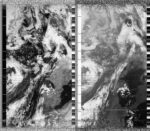
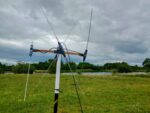
2025-05-30 11:51:36
Richard A Carter
University of York, Campus East, United Kingdom
United Kingdom
NOAA-18

2025-05-30 11:52:32
Alan Robertson
Bathgate, West Lothian, UK
UK
NOAA-19
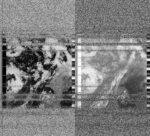
2025-05-30 08:30:18
Alan Robertson
Bathgate, West Lothian, UK
UK
NOAA-15
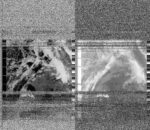

2025-05-29 23:58:27
Alan Robertson
Bathgate, West Lothian, UK
UK
NOAA-19
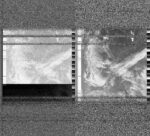
2025-05-29 08:56:24
Alan Robertson
Bathgate, West Lothian, UK
UK
NOAA-15
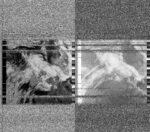
2025-05-28 19:10:13
Alan Robertson
Bathgate, West Lothian, UK
UK
NOAA-15
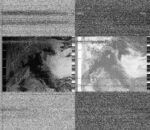
2025-05-28 12:12:16
Alan Robertson
Bathgate, West Lothian, UK
UK
NOAA-18
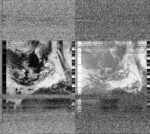
Cloudy with occasional showers.
2025-05-27 12:31:00
Richard A Carter
University of York, Campus East, United Kingdom
United Kingdom
NOAA-19
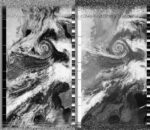
2025-05-27 12:25:38
Richard A Carter
University of York, Campus East, United Kingdom
United Kingdom
NOAA-18
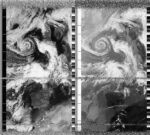
A sounding just as the weather turned - heavy rainfall threatening pristine computer electronics.
2025-05-26 11:32:17
Alan Robertson
Bathgate, West Lothian, UK
UK
NOAA-19
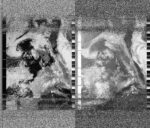
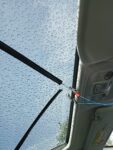
Experimental V-dipole mounted on car, using SDR++ for Android with RTL-SDR . Manual Doppler adjustments. Around 40 degrees elevation. Some interference from nearby aircraft - still testing gain settings. Rain and windy today.
2025-05-25 12:51:00
Alan Robertson
Bathgate, West Lothian, UK
UK
NOAA-18
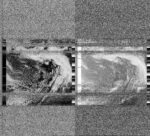
2025-05-25 09:01:02
Alan Robertson
Bathgate, West Lothian, UK
UK
NOAA-15
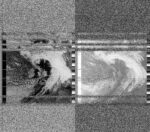
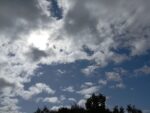
2025-05-24 22:56:55
Alan Robertson
Bathgate, West Lothian, UK
UK
NOAA-18
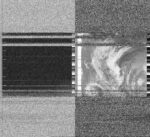
2025-05-24 12:02:37
Steve Engelmann
Pacific Palisades, California, United States
United States
NOAA-18
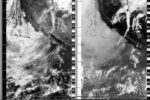




Today's capture was from the Palisades Bluffs. Growing up in the area, I spent many hours staring out at the ocean and contemplating whatever the topic du jour happened to be. Behind me were many piles of rubble and green gardens steps away from ash and a standing chimney. Below the bluffs there is, or was, a trailer park. There was a nonstop cacophony of jackhammers, the sound of trucks backing up, and the rumble of debris falling into a dump truck. More thoughts to contemplate.
2025-05-21 11:01:34
Steve Engelmann
Santa Monica, California, United States
United States
NOAA-19





Today I went to the top level of a parking garage next to the Sears building in Santa Monica. It was a beautiful view with clear skies. I was joined by a twenty-something who was using the empty lot to work on his skateboard skills. He also paused a few times to shout some indistinguishable words to someone below. Then he left.
2025-05-24 19:14:50
Alan Robertson
Bathgate, West Lothian, UK
UK
NOAA-15
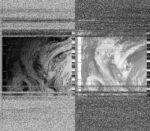
2025-05-24 11:27:51
Alan Robertson
Bathgate, West Lothian, UK
UK
NOAA-19
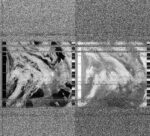
2025-05-23 23:09:49
Alan Robertson
Bathgate, West Lothian, UK
UK
NOAA-18
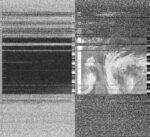
2025-05-23 21:35:28
Alan Robertson
Bathgate, West Lothian, UK
UK
NOAA-19
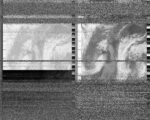
2025-05-23 11:55:35
Derrick Yohn
Transfer, Pennsylvania, United States
United States
NOAA-19
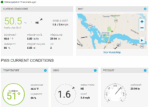
Extra images show PWS and noaa-apt imagery with map overlay
2025-05-23 10:58:10
Briged McCarthy
Denton TX, United states
United states
NOAA-19
2025-05-23 11:41:00
Richard A Carter
University of York, Campus East, United Kingdom
United Kingdom
NOAA-19
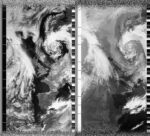
2025-05-23 11:36:20
Richard A Carter
University of York, Campus East, United Kingdom
United Kingdom
NOAA-18
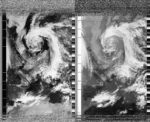
2025-05-22 23:22:47
Alan Robertson
Bathgate, West Lothian, UK
UK
NOAA-18
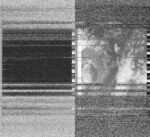
2025-05-22 21:46:29
Alan Robertson
Bathgate, West Lothian, UK
UK
NOAA-19
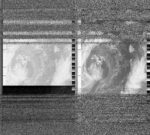
2025-05-22 11:53:13
Alan Robertson
Bathgate, West Lothian, UK
UK
NOAA-19
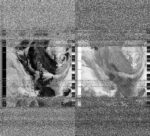
2025-05-22 08:39:33
Alan Robertson
Bathgate, West Lothian, UK
UK
NOAA-15
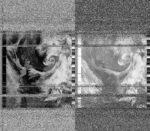
2025-05-21 23:40:07
Derrick Yohn
Transfer, Pennsylvania, United States
United States
NOAA-18



Including images from noaa-apt with overlay
2025-05-14 23:30:51
Derrick Yohn
Transfer, Pennsylvania, United States
United States
NOAA-18


Included processed image from noaa-apt showing mapping
2025-05-21 21:57:09
Alan Robertson
Bathgate, West Lothian, UK
UK
NOAA-19
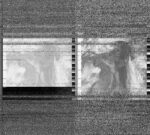
2025-05-21 18:53:31
Alan Robertson
Bathgate, West Lothian, UK
UK
NOAA-15
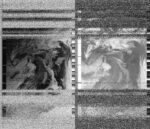
2025-05-21 12:06:00
Richard A Carter
University of York, Campus East,
NOAA-19
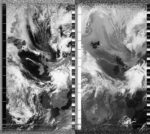
2025-05-21 12:02:20
Richard A Carter
University of York, Campus East, United Kingdom
United Kingdom
NOAA-18
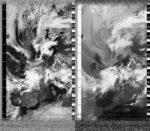
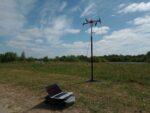
2025-05-21 12:05:54
Alan Robertson
Bathgate, West Lothian, UK
UK
NOAA-19
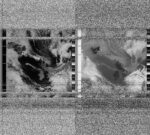
2025-05-21 10:27:54
Richard A Carter
University of York, Campus East, United Kingdom
United Kingdom
NOAA-19
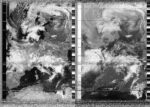

Alongside these soundings I have been conducting another small project of my own - Nephoscope. Named after 19th century instruments for measuring the movements of clouds, my digital equivalent analyses these movements using the camera in my phone, using the data to then generate a form of poetry over the video feed. I like this idea of these two electronic instruments, satellite and nephoscope, working together to map and articulate the atmosphere along two different registers, and at two very different scales.
2025-05-21 09:05:40
Alan Robertson
Bathgate, West Lothian, UK
UK
NOAA-15
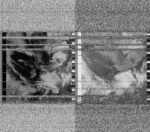
2025-05-20 21:29:54
Soph Dyer
Paulinengasse, Wien, Austria
Austria
NOAA-18
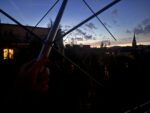
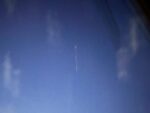
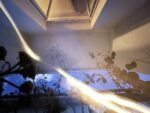
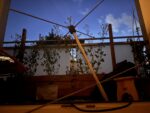
"We used to swim in the river at this time of year" a friend laments. It's true that the unheated, outdoor public pools have been open for almost three weeks, but I doubt that they've had many visitors. As a Northerner, I am tempted by the icy rewards of cold swim but I know that this is not what most Viennese have in mind when they think of the Freibäder.
From the other side of the Polar Jet Stream, my sister, Ray, writes that the UK has been dry and wam. It's so dry that the earth on the farm has cracked into irregular, tessellating shapes.
Earlier in May, when visiting family in England I read sections of my mum's childhood diary. The diary had been left out to cheer-up my Gran who has dementia. Each entry opens with a single line about the weather. On this day in 1971, Hampshire was the "same as yesterday", which was "a bit windier". Two days prior, it had been "very sunny and warm", my mum's 12-year-old self wrote.
2025-05-20 22:16:32
Derrick Yohn
Transfer, Pennsylvania, United States
United States
NOAA-19


Current weather conditions from my Home Weather System. Image is pretty bad tonight - a lot of noise. May need to relocate antenna.
2025-05-20 22:11:47
Alan Robertson
Bathgate, West Lothian, UK
UK
NOAA-19
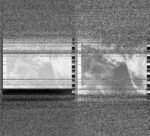
2025-05-20 19:19:26
Alan Robertson
Bathgate, West Lothian, UK
UK
NOAA-15
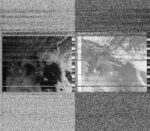
2025-05-19 23:20:00
jack hackerson
R9J9+C7F Dwingeloo, Netherlands, Europe
Europe
NOAA-18
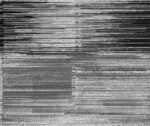
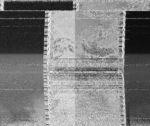
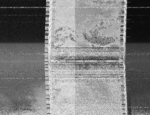
my first time doing this. i did my best and i might continue doing this for more pics ee
2025-05-19 22:24:30
Alan Robertson
Bathgate, West Lothian, UK
UK
NOAA-19
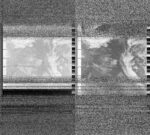
2025-05-19 19:45:34
Alan Robertson
Bathgate, West Lothian, UK
UK
NOAA-15
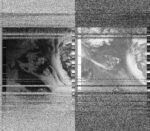
2025-05-19 12:27:41
Alan Robertson
Bathgate, West Lothian, UK
UK
NOAA-18
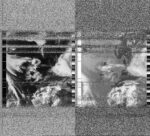
2025-05-18 12:54:23
Derrick Yohn
N3TTI, United States
United States
NOAA-18


2025-05-18 11:03:11
Alan Robertson
Bathgate, West Lothian, UK
UK
NOAA-19
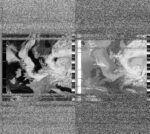
2025-05-18 08:44:11
Alan Robertson
Bathgate, West Lothian, UK
UK
NOAA-15
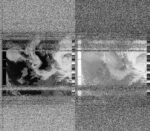
2025-05-15 21:56:49
Michele Boulogne
Sodankylä Geophysical Observatory, Finland
Finland
NOAA-19
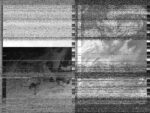
2025-05-15 18:32:00
Michele Boulogne
Sodankylä Geophysical Observatory, Finland
Finland
NOAA-15
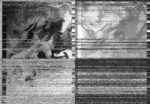
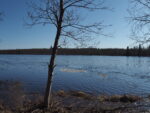
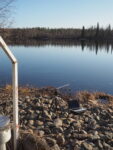
2025-05-16 11:31:01
Sasha Engelmann
Between Schilling and Queens Buildings, Royal Holloway University of London, United Kindom
United Kindom
NOAA-18

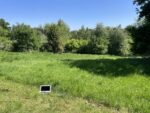
From the cavelike darkness of my university office, my day is textured by a slow livestream of weather from around the world. Yesterday we launched the Year of Weather Map - a collective map of weather created with satellite imagery contributions from DIY satellite ground station operators around the world. Around lunchtime a new series of images over Europe roll in, adding wispy cloud textures over the North Atlantic. Later in the afternoon, an incredibly clear image arrives spanning from the Great Lakes to Central America and featuring a brilliant sun-glint in the Gulf of Mexico. I await with some expectation an image from India but it does not appear in the Archive- suggesting a power cut, wifi failure or other infrastructure issue on the ground. Then on my train ride home it’s there in the archive and map - a ghostly nighttime image with a condensed mass of cotton-ball clouds to the South and the faint coastline of India and Pakistan. All of these weathers layer in slow, meditative fashion on the somewhat glitchy map we have created, the result of five years of network building, tool-making and the design, testing and crafting of small units of hardware.
2025-05-16 11:42:31
Derrick Yohn
Transfer, Pennsylvania, United States
United States
NOAA-19

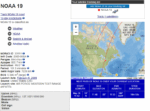
2025-05-16 13:10:08
Richard A Carter
University of York, Campus East, United Kingdom
United Kingdom
NOAA-18
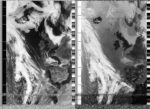
2025-05-16 11:28:52
Richard A Carter
University of York, Campus East, United Kingdom
United Kingdom
NOAA-19
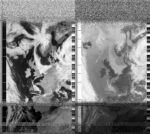
2025-05-15 18:31:00
Michele Boulogne
Sodankyla Geophysical Observatory, Finland
Finland
NOAA-15
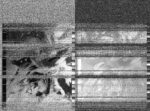
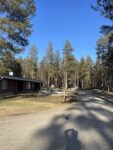
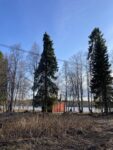
The weather is clear on Northern Finland this week, you can really feel the Spring starting strong finally. It felt extra special to catch a NOAA pass so close to the North pole.
2025-05-15 11:53:37
Derrick Yohn
Transfer, Pennsylvania, United States
United States
NOAA-19

From station N3TTI in Transfer, PA. Ground Station using RTL-SDR and SDR++. Current weather was overcast. Antenna is V-dipole tuned to 137MHz. The audio is captured to a WAV file and then run through the APT Image processor at open-weather.community for image processing. Future updates will be automatic signal captures and automatic uploading to the Public Archive. Thanks to open-weather.community for hosting such a fantastic project!
2025-05-15 11:48:00
Richard A Carter
University of York, Campus East, United Kingdom
United Kingdom
NOAA-18

A hurried, last minute sounding, and an odd sense of sadness, given the impending decommissioning of the analogue NOAA satellites. Cool and dry conditions, amidst what is likely to be the driest Spring on record in the UK.
2025-05-14 11:58:41
Richard A Carter
University of York, Campus East, United Kingdom
United Kingdom
NOAA-19
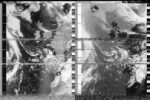

It is always pleasing to watch the signals of two NOAA satellites together, on the waterfall.
2025-05-12 12:20:14
Sasha Engelmann
Between Queens and Schilling Buildings, Royal Holloway University of London, United Kingdom
United Kingdom
NOAA-18

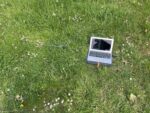
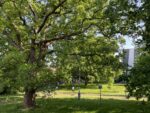
Another year, another Cosgrove Lecture at the Centre for GeoHumanities at Royal Holloway. Our speaker this year is Siobhan Angus who has written Camera Geologica, a book tracing the interrelations of geological materiality, social-environmental history and photographic image-making. I learn that in the 19th century, 20% of global silver went into photographic production processes. Gelatin, derived from animal bones, was so important for photographic practices that slaughterhouses were kept near Kodak and other major photo studios and facilities. Platinum printing processes were used to print and archive photographs of indigenous and global south communities, and the softer, ethereal aesthetics of platinum is therefore irrevocably linked to archives of communities at the threshold of ‘disappearance’. These are the traces of what Kathryn Yusoff calls ‘geological ghosts’ in historical visual cultures. Siobhan follows the work of Azoulay in stating that photography was not born in the 19th century, it was born in 1492 upon the threshold of the colonisation (and extraction from) the Americas.
2025-05-10 11:05:22
Sasha Engelmann
Hackney Downs, London, United Kingdom
United Kingdom
NOAA-19
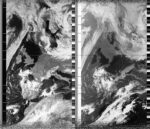
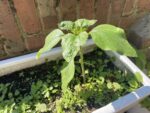
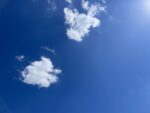
Our sunflower seedlings that we planted in mid March are now around 20cm high, and growing fast. Hackney Downs is scattered with blankets and some people are even in bathing suits, as the sun climbs toward noon. Later in the day at a playground with friends who have a three year old child, we make another 'sunflower' by spinning a yellow plastic bucket chair that has been filled with sand.
2025-05-09 11:51:30
Steve Engelmann
Tongva Park, Santa Monica, California, USA, Earth, United States
United States
NOAA-18
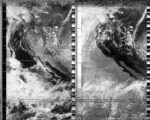
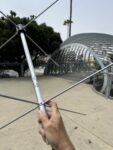
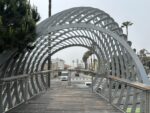
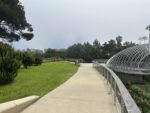
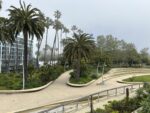
This satellite pass had a slightly better elevation than the earlier one. The marine layer is starting to fade. The pass was captured from Tongva Park (in honor of the indigenous peoples of coastal southern California). During most of the satellite capture a woman was loudly ranting at a police officer. Sometimes I feel like ranting too. Under the topic of "government efficiency" defunding the EPA's Energy Star program is the latest casualty. The program costs the government $32 million, while saving American consumers $40 billion annually. Maybe I missed something on efficiency, but that sounds like for every dollar the government spends on the program, consumers benefit $350. California's goal of selling only new electric vehicles by 2035 is also up in the air. And the defunding of NOAA may also result in NOAA 18 being turned off. From space, everything seems so peaceful. I guess appearances may deceive.
2025-05-09 08:11:58
Steve Engelmann
Sears, Santa Monica, California, United States
United States
NOAA-15
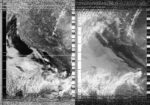
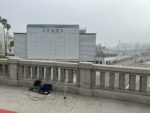
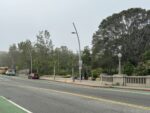
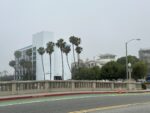
The call it May Gray (and then later June Gloom). It is a typical marine layer that hugs the coastline in late spring/early summer in southern California. The clouds usually "burn off" by noon and return in the evening. I found a nice spot on a bridge near the Santa Monica pier. The 10 fwy passes under and the historic Sears building stands nearby. The high school I teach at partially burned in the Palisades Fire. The Sears building has become our temporary school site. The sidewalk on the bridge is narrow. A number of students and teachers squeezed by as I was doing the recording. Only one teacher paused to ask me what I was doing.
2025-05-08 13:09:40
Richard A Carter
University of York, Campus East, United Kingdom
United Kingdom
NOAA-18
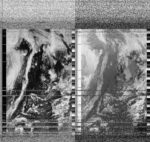
Last week was the hottest May day on record in the UK, today is decidedly cooler and greyer. A reminder that Spring is always an unstable threshold, like any season.
2025-05-07 11:48:24
Sasha Engelmann
Hackney Downs, London, United Kingdom
United Kingdom
NOAA-19

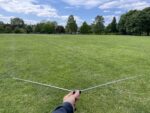

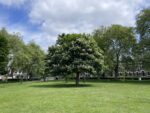
Last night, at an event called We Are Not Numbers at the Southbank Centre, Palestinian writer Ahmed Alnaouq and artist Malak Mattar shared stories from their personal lives and those of their family members in Gaza. Malak described an event of being denied border crossing into Israel for the purpose of showing her paintings in an exhibition in Jerusalem when she was just a teenager, and realising for the first time that she was 'in a cage'. Ahmed spoke about how writing and storytelling helped him emerge from a depression after his 23-year old brother was killed in an Israeli airstrike in 2014.
Both spoke about the sometimes visible, sometimes invisible barriers to speaking about Palestine in the UK. In Palestine, Malak said, "I would never be barred from speaking at my own exhibition". Yet she spoke about countless experiences of being silenced in the UK, whether in arts institutions or in public forums. Ahmed added that UK institutions are so concerned about being 'neutral' that they implicitly support Israel's genocide. For me, hearing these claims, especially from Palestinian artists whose family members have been killed in the current genocide and in previous Israeli assaults on life in Gaza, made the conditions of speaking, voicing and expressions of mere humanity in the UK more palpable than ever before.
2025-05-04 21:00:00
Moscow, Russia
Russia
NOAA-19
2025-05-04 16:38:00
Moscow, Russia
Russia
NOAA-18
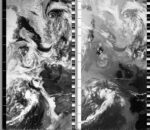
2025-05-01 13:02:16
Richard A Carter
University of York, Campus East, United Kingdom
United Kingdom
NOAA-18
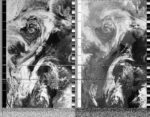
This image was gathered as part of a class workshop I ran today, as a simple way of bearing out the radio networks that underpin much of our contemporary environment.
2025-05-01 11:21:51
Richard A Carter
University of York, Campus East, United Kingdom
United Kingdom
NOAA-19
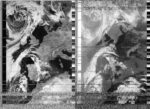
This image was gathered as part of a class workshop I ran today, as a simple way of bearing out the radio networks that underpin much of our contemporary environment.
2025-05-01 11:24:00
Hana, Iker, Silvia
New Cross, London, United Kingdom
United Kingdom
NOAA-19

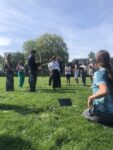
We made the mistake of starting and stopping the recording sporadically. So this image represents the individual recordings spliced together using Audition.
2025-05-01 11:18:54
Giorgia Chiarion, Delphine Tomes, Riccardo Rizzetto
Goldsmiths College Green, Lewisham, London, United Kingdom
United Kingdom
NOAA-19
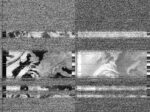
it was very hot and muggy but also dry? much excitement as we heard the sounds of the satellite broadcast. simultaneous conversations in Spanish Italian and English. Curious fellow students and researchers stopped by to experience what we were capturing.
we can see all of England some of Wales but Scotland and Northern Ireland were covered by a cloud_static_nebulous_void
we can see where all 3 of us were born!
2025-05-01 11:20:00
Silvia Gali
London, UK
UK
NOAA-19
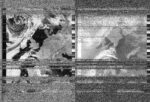
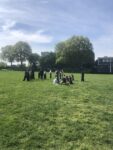
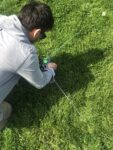
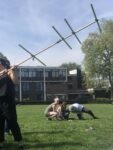
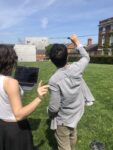
first time recording weather images
sunny day in london
amazing teachers, sensitive knowledge, embodied physics
2025-05-01 11:23:00
Prajvi, Lene, Ravza
Goldsmiths College Green, Lewisham, London
Lewisham, London
NOAA-19
Recording taken by Ravza, Lene, and Prajvi.
Lene holding the antenna.
22, mostly cloudy
2025-05-01 11:31:45
James, Fer, Paola
Goldsmiths University Greens, United Kingdom
United Kingdom
NOAA-19
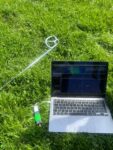
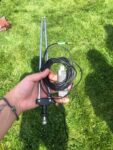

Sunny and clear, occasional fine clouds.
Faulty hardware.
2025-05-01 11:23:00
Prajvi, Lene, Ravza
Goldsmiths College Green, Lewisham, London
Lewisham, London
NOAA-19

Recording taken by Ravza, Lene, and Prajvi.
Lene holding the antenna.
22, mostly cloudy
2025-05-01 11:18:19
Sasha Milonova & Julia Nueno
London - Goldsmiths, United Kingdom
United Kingdom
NOAA-19
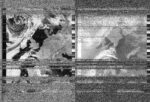
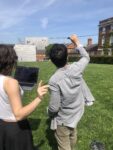
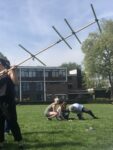
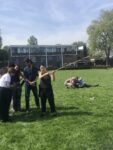
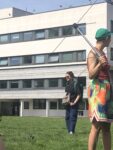
it's the hottest labour day that we have on record
it was our first time capturing satellite images
in our image we can see sunny London and cloudy Madrid
2025-05-01 11:26:00
tally, ayesha, ayşe
goldsmiths, uk
uk
NOAA-19
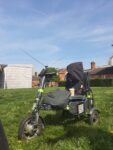
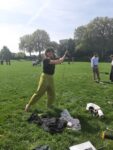
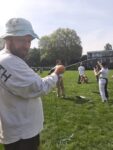
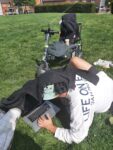
tally: "it is a very hot day in london. my min is blow by this "citizen science"."
ayesha: "it is hot, we see italy, climate crisis is in the blood"
Ayşe:"the screen is blinded by the sun, I sweat the sun, the grass is greener under the sun, and the climate crisis is disproportional to justice"
2025-05-01 11:15:48
Laura, Aya & Tom
College Green, Goldsmiths, New Cross, United Kingdom
United Kingdom
NOAA-19
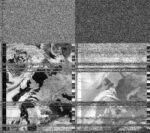
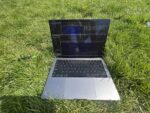
The hottest May 1st the UK has ever had at 28 degrees celsius
2025-05-01 11:23:00
Prajvi Mandhani
Goldsmiths College Green, Lewisham, London
Lewisham, London
NOAA-19



Recording taken by Ravza, Lene, and Prajvi.
Lene holding the antenna.
22, mostly cloudy
2025-05-01 11:21:38
Manu Sancho, Omar Ferwati
Goldsmiths University, London, UK
UK
NOAA-19

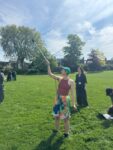
It was a very sunny day in London, it was 28º
2025-05-01 11:20:01
Bernal Pérez, Florence To, Laura Palmer, David Birkin, Debora Swistun
College Green, Goldsmiths University, London, United Kingdom
United Kingdom
NOAA-19
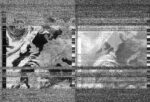
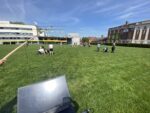
The weather was summy, clear, 27 degrees celcius. Capturing the waves started with white noise then eevntually after 5 minutes it became clear and sharp. Image captured from 11:18 - 11:26. It was a collective exercise with open weather community at Goldsmiths Univerity in the green.
2025-04-27 11:03:55
Steve Engelmann
Pacific Palisades, California, United States
United States
NOAA-19
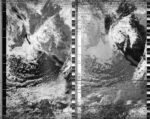




On January 7th I captured a satellite pass in the foothills of the Santa Monica mountains. The winds were wild and within an hour of the pass the Palisades Fire had started. Today I returned to the same location almost 4 months later.
The wind was gentle. It was cool as a light storm had passed the day before. In the distance there was the constant beeping of trucks backing up and the rattle of jackhammers. While the Palisades suburbs were a long way from recovery, the natural landscape seemed rejuvenated. This is a fire-climax biome. The tops of the shrubs (chamise, laurel sumac, coyote bush, and elderberry) were blackened, but from the base sprouted eager green shoots from the living roots. Many young wildflowers were present (mariposa lily, blue dicks, california brittlebush, bird's-foot trefoil and invasive black mustard). In my view, however, the clear winner is the wild cucumber. Early after the first rains, the cucumber took advantage of the lack of competition. Blackened hillsides turned green (and white flowers) as the vines stretched out in all directions. Many cucumber fruits are already the size of baseballs.
2025-04-27 08:24:59
Steve Engelmann
Santa Monica Pier, United States
United States
NOAA-15
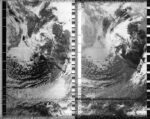




A typical April morning at the Santa Monica pier. A gentle breeze with a high of 16°C. A group of about 20 people gathered near me as I captured the satellite pass. They all wore a paper number pinned to their shirt. My guess is that there was some kind charity run/jog with the pier as the end point.
2025-04-25 12:38:47
Sasha Engelmann
Between Queens and Schilling Buildings, Royal Holloway University of London, United Kingdom
United Kingdom
NOAA-18

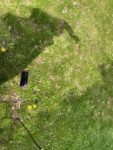
The morning is balmy and bright, but my university office feels far too cold. I layer with a grey wool jumper that I keep in my office for such days. Whereas my east-facing windows receive piercing sun during the winter, the dense foliage of the oak trees in the small grassy field outside the department keep most light out of my office in spring and summer. It feels like I am the only member of staff in today, everyone is sheltering from the start of Term 3 at home. I buy myself a hot chocolate with whipped cream in the afternoon as consolation!
This morning, T plays a video of a Spanish senator who is a trans woman, standing up and admonishing the senate for their attack on trans lives. She says ‘you insert yourself in every part of our lives!’ Then she lists all the invasive questions and topics asked by transphobes including ‘Do trans people orgasm?’ ‘Enough!!’ She bellows to the whole senate who applaud. Meanwhile in the U.K., Kier Starmer is ‘pleased’ that ‘we finally have clarity’ on the definition of a woman.
2025-04-25 10:55:27
Richard A Carter
University of York, Campus East, United Kingdom
United Kingdom
NOAA-19
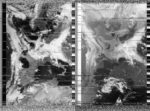
Calm, cool conditions were conducive to a clear and crisp recording, marred only by my perennial foe during recent efforts - software glitches, cutting out the audio! I had a chance to reflect at a conference yesterday on the nature of these sensory undertakings, the registers and durations that they speak to. Glitches themselves manifest across multiple durations, and begin to inscribe their marks long before they become apparent on recorded media. The deep, granular hardware incompatibilities that will forever prevent this computer from generating a clear image were established several years ago, when it was first built, and will now be registered in this archive for as long as it is sustained. There's something pleasing about this - a sense of material traces across time that the usual quest for the perfect image (the perfect sensory recording) would otherwise strive to eliminate. There are long histories of Western onto-epistemic-political imperatives at work here, and these are now manifest in the technologies and techniques that delivered the signal processing behind our digital world - along with its surrounding marking rhetoric of perfect reproduction, and seamless, immaterial operation. The computing of angels.
All this observed - I am presently dredging up an unusably 'glitched' computer that, nevertheless, once gave vastly better recordings than the more modern machine used here. I hope it might deliver a clearer image for the next pass, in 30 minutes time!
2025-04-24 10:41:00
Prajvi Mandhani
Noida, India , India
India
NOAA-18

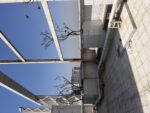
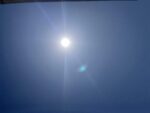
full bright sun and a slight wind. I went up to the terrace of my building to the 25th floor.
I was impatient as my sweat trickled down my forehead. Its hot.
trying to remember that there is still water in this atmosphere, no matter how dry today feels.
India just suspended the Indus Valley Treaty that comprises of sharing river, Indus, and five bank tributaries, Ravi, Beas, Sutlej, Jhelum, and Chenab with Pakistan after a brutal terrorist attack in Kashmir.
The land bleeds, the water is forced to stop. Is justice revenge or is justice freedom of the land, freedom of the water, freedom of the indigenous communities.
Thinking of this strange weather swept across India, dark storms leaking into language.
2025-04-22 10:51:00
Bandi b
Bekes , Hungary
Hungary
NOAA-19
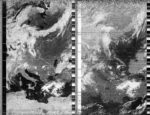
2025-04-20 11:00:23
Sasha Engelmann
Hackney Downs, London , United Kingdom
United Kingdom
NOAA-18
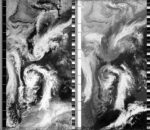
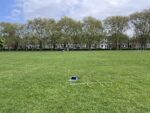
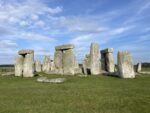
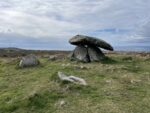
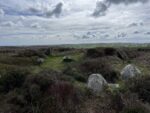
London has exploded in green during the week T and I were on holiday in Cornwall. The chestnut trees in Hackney Downs are in full foliage and already budding flowers, while the plane trees are a cheerful yellow green. While in Cornwall we spent much of our time visiting several obscure stone circles and ‘quoits’ in the treeless moors, though we did visit one very prominent stone monument that happened to be on our way back to London (Stonehenge!). In contrast to the exposed rocks and windswept hills of western Cornwall, the green of London’s treetop overstory is almost overwhelming…
In a unanimous decision a few days ago, the UK Supreme Court ruled that, under the Equality Act of 2010, “sex is binary” and it is based on biology. A trans woman therefore does not come within the definition of a ‘woman’ under the Act, and therefore loses protections made for the benefit of women. The court insists that trans rights are still protected under the ruling but it is very unclear how denying someone’s womanhood can be called protection. Shon Faye writes that the relative support (though ‘support’ is a strong word here) afforded trans people over the last two decades in the U.K. is coming to an end. Judith Butler points out, in an interview with Owen Jones, that anti-trans feminism is more virulent in the U.K. than in the US. T and I mull over the decision and its daily analysis, a decision that has wide ranging implications for many people in our immediate community, not to mention the health and wellbeing of queer and nonbinary folks more broadly. How are the rights of non-binary people to be seen under this ruling? Or any other place on the spectrum of transness? The U.K. remains by far the safest place to be out of our own two home countries (Italy and the US) but such laws - invisible anti-trans weather of the state - force us to consider both how to keep fighting and how to escape.
2025-04-15 11:59:24
Steve Engelmann
Pacific Palisades, California, United States
United States
NOAA-18
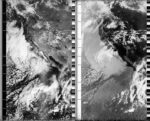
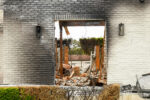
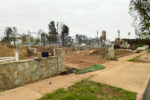
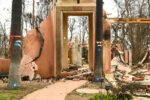
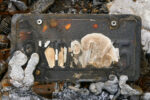
It has been over 3 months since the start of the Palisades Fire. I did a satellite capture less than an hour before the beginning of the fire on January 7th. I thought I would return to that location to do another capture. Road closures forced me to change plans. As the satellite was about to rise above the horizon, I found myself in the middle of the residential burn zone of the Palisades. With few trees standing, and even fewer homes, the skyline was favorable for a clear view of the sky. I found a convenient wall from a burned property to place my laptop. Several cars slowed during the pass giving me suspicious looks. Who is this man with an antenna in the middle of all the destruction? One car lingered for several minutes - I feel I was being filmed.
Meanwhile, we live in the chaos of tarrifs, the deportation of students with political views, the defunding of universities and the promise to increase domestic energy (fossil fuel) production. Later that day I attended a press conference at City Hall promoting the Polluters Pay Climate Superfund Act of 2025. The odds are long, but the effort is important.
2025-04-17 10:54:19
Richard A Carter
University of York, Campus East, United Kingdom
United Kingdom
NOAA-15
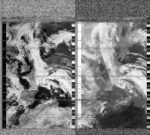
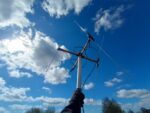
Cable problems mean even the slightest breeze generates noise in the image - but this does result in the rather pleasing fact that the weather itself affects the image generated. You can see when significant breezes come in as striations over the image.
2025-04-16 11:09:39
Richard A Carter
University of York, Campus East, United Kingdom
United Kingdom
NOAA-19
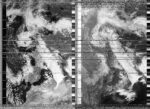
2025-04-15 19:35:37
Richard A Carter
York, United Kingdom
United Kingdom
NOAA-15
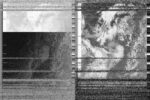
A very noisy sounding, but fortunately free of the audio cut-outs that have beset many recent efforts. A chance also to see the image 'click' across the night time threshold.
2025-04-11 12:14:47
Richard A Carter
University of York, Campus East, United Kingdom
United Kingdom
NOAA-18
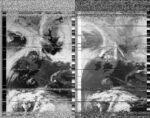
Today's sounding was mainly a test run, with noise and audio cutouts (the dark striations) proving a persistent issue - although the image was better than expected. Suspect these artefacts are a quirk of the new laptop I have been using, as previous devices (now sadly defunct) were fine. Once again, a reminder of the intricate chain of systems that all need to align in order for a recording to be gathered and processed.
2025-04-10 19:35:00
wm6x
Central Europe, Czech republic
Czech republic
NOAA-15
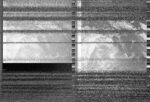
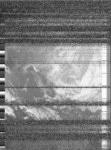
I dont see a lot, it is my first experience. But I see a lot of clouds above balkan countries
2025-04-07 10:45:17
David Alejandro Saavedra Herrera
Near of Zapatoca Market in the capital of Colombia, Colombia
Colombia
NOAA-18
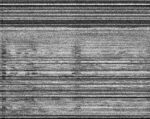
Well we are facing a very long rainy season so i guess thats why we can see that much clouds in the image
2025-04-07 10:45:17
David Alejandro Saavedra Herrera
Near of Zapatoca Market in the capital of Colombia, Colombia
Colombia
NOAA-18

It was hard to get it , but still i got an awesome result even for my first time and about the weather we are facing a rainy season so we can see the clouds
2025-04-05 10:40:00
Chase Graham
Defuniak Springs Fl, U.S.
U.S.
NOAA-19
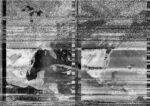
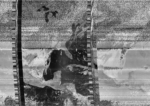
2025-04-05 22:35:00
Matti
Kassel, in my Backyard., Germany
Germany
NOAA-19
Today was one of the first warmer days of spring here in Kassel, Germany. But by the night it gets quite chill again.
2025-04-01 11:27:51
Sasha Engelmann
Nicosia, Cyprus
Cyprus
NOAA-18

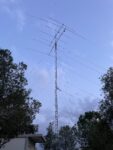


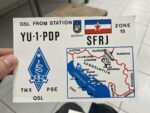
We drive up the road to the English School Radio Club at dust, the sky a soft purple-blue, and a tower with several Yagi antennas comes into view. At ground level are two bungalows, one with the historical 'home' of the English School Radio Club, and a new renovated bungalow used today, as the older structure is failing. Nestor (President of the Cyprus Amateur Radio Society) and Demetris (President of the Nicosia Chapter of the Cyprus Amateur Radio Society) tell me of the history of the club, the days when one had to call the fire department to be lifted on a raised platform to fix the antenna. They have a cabinet full of hundreds and hundreds of QSL cards, written postcards that confirmed amateur radio contacts between operators around the world. "There are some here from countries that no longer exist!" they tell me, and I immediately find myself spreading out hundreds of QSL cards from the former Yugoslavia on a peeling green table. Next door, we power up the transceivers and I make three QSOs (radio amateur contacts) with hams in Slovenia, Hungary and Barcelona. I speak the longest to the amateur in Barcelona, who tells me my contact is 'excellent' and makes good wishes to me and my family. While we listen and tune the radio, I hear many other stories of amateur radio on Cyprus, of speaking to amateurs in Syria, Egypt, Turkey and Iran, and of the politics of amateur radio and current educational programmes aimed to be inclusive to women and girls. The radio is so clear and engrossing - voice rising clearly on SSB through the 'whoosh' of the spectrum - that we are late for our dinner reservation.
2025-03-31 11:41:09
Sasha Engelmann
Nicosia, Cyprus
Cyprus
NOAA-18

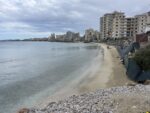
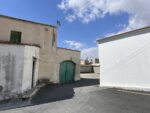
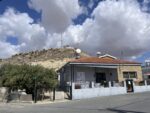
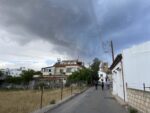
Teaching undergraduate UK geography students in Nicosia, Cyprus is an experience of a clash between worlds- the worlds of Greek and Turkish Cypriots living across checkpoints and buffer zones, and those of students eager to extract 'data' on life in a divided city. Standing on the beach of the suburb of Varosha, yesterday, our guide Georgia pointed to her apartment building, framed by two once-regal hotels, to which she she has not been able to return, like all residents of Varosha, since the Turkish army arrived in 1974. She was due to be married on the day she had to leave her town. She points out fields that once boasted dense orange groves, and speaks about the tradition of making sculptures from oranges in the shapes of dolphins and other animals. She shows us the shop that had the "best cheese sandwich of the 70s- a delicacy", and the boutique where women would buy fur coats. An abandoned kiosk marks the place where Varosha first served soft ice cream. There is an eeriness both to being in such places on a research trip, and to seeing the ruins being photographed by the numerous passerby and members of the public. Many pose in front of dilapidated photo shops and ruined movie theatres. We speak about ruins, aesthetics, dark tourism and what the gesture of taking a selfie in Varosha means. It is unseasonably warm in Cyprus, as most residents tell us- at least ten degrees above the average temperature of springtime. Saharan dust arrived in Nicosia over the weekend.
2025-03-27 12:24:38
KLIDEN FLORES LIMA
LIMA, PERU
PERU
NOAA-15
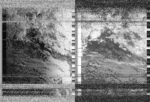

Satellite: NOAA 15
Pass Start: 27 Mar 2025 12:24:38 GMT
Pass Duration: 14:55
Elevation: 54
Azimuth: 281
Solar Elevation: 14.8
Direction: southbound
Creation Time: 27 Mar 2025 12:26:28 GMT
Satellite Type: NOAA
Channel A: 2 (near infrared)
Channel B: 4 (thermal infrared)
Enhancement: HVCT
Ground Station: LIMA, PERU/South America
My experience was pleasant because in my exact location there are no weather problems, but in other latitudes of my country there are weather crises of various types.
2025-03-23 10:08:54
Richard A Carter
University of York, Campus East, United Kingdom
United Kingdom
NOAA-19
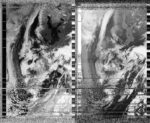
Equipment troubles finally subsided for today's pass, resulting in a pleasingly expansive view of Europe and parts of North Africa. One interesting aside is that the wind was such that it blew through small gaps in the antenna, making distinctly musical notes in the process - can imagine a speculative art project in which the antenna is turned into a sort of instrument, working alongside the distinct notes of the NOAA transmission coming in. It would be quite the composition!
2025-03-22 10:21:07
Sasha Engelmann
Hackney Downs, London, United Kingdom
United Kingdom
NOAA-19
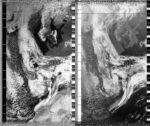
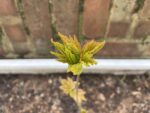
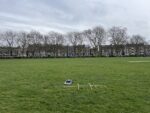
"That's so MacGyver!" says a blonde woman with a dog when I explain my tape-measure Yagi-Uda antenna. She and her friend / partner chat to me for a few minutes and walk off yelling back funding schemes that open-weather could apply to. "Welcome Trust.... Discovery Grant! Check it out!" I hear as they leave audible distance. I wonder if I've just met an arts and culture boss of some kind. I had come out to the park around 10:20am to catch a NOAA-19 pass that would pass over London at 90 degrees in maximum elevation- an elevation I have only rarely seen in my whole career capturing satellite images. A boy's football team is practising in my usual spot, so my reception is perhaps not as perfect as it normally is when I can see a perfect diagonal North-South across the Downs. Spring is everywhere today, in shooting daffodils and unfurling leaves. A twiggy plant that I had previously identified as a Serbian Lilac in my front garden reveals itselt to be a sycamore tree as its leaves unfold.
2025-03-21 12:25:10
Simeon Lok, Ella Richards, Rosie Everitt, Lena Prollochs, Millie Twist, Prinali Dilipo, Zhe Long Ou, Elinam Hammond, Maryam Ahmadi, and Sasha Engelmann,
Royal Holloway University , United Kingdom
United Kingdom
NOAA-18
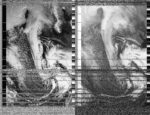
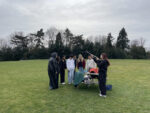
It was overcast and dry. Some sun was peaking through. It got a bit windy at times, but there was usually a nice gentle breeze. It was about sixteen degrees Celsius. The satellite pass was really interesting to see. The experience was quite grounding - being connected to an orbiting machine in the sky.
2025-03-21 12:25:30
Richard A Carter
University of York, Campus East, United Kingdom
United Kingdom
NOAA-18
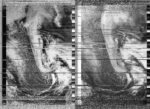
Software problems caused frequent glitches in the audio stream, resulting in this rather "striated" sounding, despite an otherwise excellent signal. A reminder, if there ever was, of the fragile chain of material structures and processes that enable these activities - and of how this fragility emerges from their status as constantly performing 'agents' in the world, rather than the typical image of technology as always fully tamed, always fully obedient to human imperatives.
2025-03-13 07:11:23
Arthur Almeida
Complexo da Maré, Rio de Janeiro, Brazil
Brazil
NOAA-15
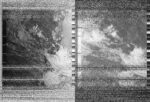
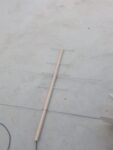

This is my first reception of NOAA-15 through a Yagi-Moxon Antenna.
2025-03-08 10:45:22
Steve Engelmann
Santa Monica Pier, United States
United States
NOAA-18
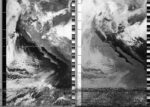
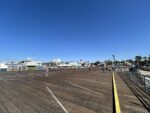
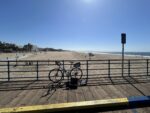
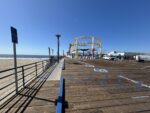
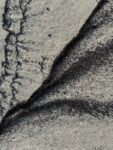
Captured a satellite pass today from the Santa Monica pier. Sunny and 16°C, a typical March day. Two months after the fires that leveled most of Pacific Palisades it is hard to tell anything happened in the rest of the LA area. The pier is full with the usual sight-seers. Bike riders and volleyball payers do what they do. You have to know where to look for the evidence. At the water's edge interesting patterns are made of burned vegetation and ash. The new presidency is hard at work making us look the other way with declarations of the Gulf of America and Mount McKinley. Apparently in America there are now only two genders. Meanwhile thousands of government jobs and agencies are being canceled. Services related to education, the National Parks and medical research are no more. And the Coast Guard Academy can no longer mention climate change in any of their trainings.
2025-03-03 11:14:02
Sasha Engelmann
Between Queens and Schilling Buildings, Royal Holloway University of London, United Kingdom
United Kingdom
NOAA-18
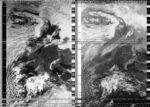
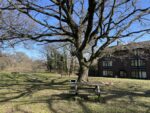
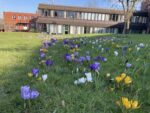
The alps curve with sharp icy edges, highlighted against the otherwise dark land surfaces of Europe. Around campus, and across parks in London, purple and yellow bulbs are pushing through the grass. I fight the urge to lie down on the grass and smell them up close, aware of surrounding students.
2025-03-02 13:06:06
Pauline Woolley
The Urban Garden, Nottingham, UK
UK
NOAA-18

A very low 22 degree pass on a cloudless March afternoon. After weeks of being trapped under a sheet of grey the scattered blue light of the sky is so very welcome. I sit listening to the beeps of the pass watching a sleepy Bumble Bee wave around after his winter rest. Yellow Hazel catkins tremble on a slight breeze and seem to vibrate in time with the click of the radio waves. For this brief moment, everything is connected.
11 degrees Celsius
54% humidity
1032mb
2025-02-20 11:54:48
Richard A Carter
University of York, Campus East, United Kingdom
United Kingdom
NOAA-18

First notably warm day of the year, unusually so in February, at 15C. Blustery. Malfunctioning equipment cut off both the start and end of the transmission recording - which also survived a complete computer crash.
2025-02-19 10:09:55
Emma
Royal Holloway University of London, United Kingdom
United Kingdom
NOAA-19
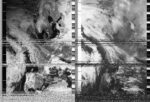
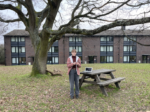
2025-02-17 12:32:20
Sasha Engelmann
Hackney Downs, London, United Kingdom
United Kingdom
NOAA-18
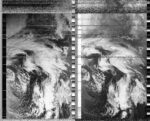

Some sunlight was very welcome after many days of freezing, rainy weather. As I tracked NOAA-18 over the Atlantic at only 31 degrees maximum elevation to the west, three women and a dog came over to ask what I was doing. One of them turned out to be a former physics teacher and professor, and we discussed satellite orbits. The small, short haired dog kept bouncing across my laptop.
During the pass I thought of a recent rebroadcast of a 1970s radio interview in which the host described February as a month that is 'honest'. It doesn't lead you to think that things are any different than they are. It is miserable, and everyone knows it. Cheerful holidays like Mardi Gras are balanced by Ash Wednesday. If you make it through February, the host said, you will make it through the year...
2025-02-15 09:54:38
Steve Engelmann
Santa Monica Pier, United States
United States
NOAA-19
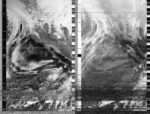
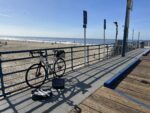
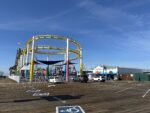
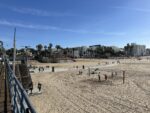
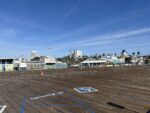
Mostly sunny skies and 16°C - pretty normal for a southern California February. After 8 months of no rain, the last 3 weeks has helped to finally put out the fires and bring the area out of fire danger.
2025-02-15 11:18:31
Applicant Visit Day attendees
Between Queens and Schilling Buildings, Royal Holloway University of London, United Kingdom
United Kingdom
NOAA-18


This image was collected by a group of secondary school students who attended an Applicant Visit Day at Royal Holloway. During the pass, Meteor MN2-3 made an appearance on the same frequency as NOAA 18!
2023-01-31 11:07:00
Prajvi + Alex
Landaff Fields, Cardiff , United Kingdom
United Kingdom
NOAA-18
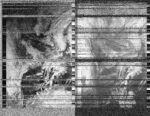
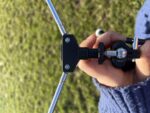
A second recording just after NOAA 19 passed our horizon.
2025-01-31 10:45:00
Prajvi + Alex
Landaff Fields, Cardiff , UK
UK
NOAA-19
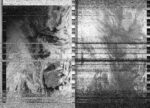
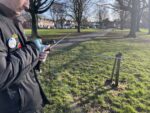
NOAA 19
clear sunny blue sky with 7pmh winds. Keeping the antenna close to our bodies helps to receive a clearer signal. Standing in the sun with our eyes closed and listening to the sound is meditative. Fascinating to see the image and imagine ourselves as a body in a green field, but also a global body in this vast sky
2025-02-11 18:38:54
nhciw
Lublin, Poland
Poland
NOAA-15


Receive location: Lublin, Poland
Time: 18:38
Software: SDR++
Hardware: RTL-SDR v4, dipole antenna on window
2025-02-09 11:32:13
Michele Boulogne and Judith Ramitha Gunaratne
Amsterdam, Nieuwe West area, The Netherlands
The Netherlands
NOAA-19

Heavy winter over the Netherlands, it's been weeks around zero; the dry air can get through anything. From above, NOAA19 beams through a wide mantle of clouds, they seem settled and a attached to the European continent- yet I've rarely see them swirling so fast, hiding then revealing our sun every hour.
2025-02-07 11:21:32
Sasha Engelmann
Between Queens and Schilling buildings, Royal Holloway University of London, United Kingdom
United Kingdom
NOAA-18

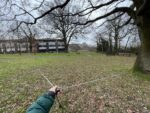
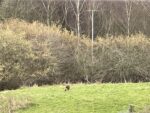
Yesterday the pressure over London climbed to 1034 hPa. As I cycled to London Bridge, it felt like anything in the air was being pushed out, even flung out, of the air above the city. I could see a dark cloud in the distance but as I cycled its shape got smaller and smaller, fleeing. The temperature had also dropped several degrees. Everything felt to be in motion, an intensity of forces.
As I left the house at 6:30am today, the coldness remained but the pressure had dropped. During my lecture in Atmospheres: Nature, Culture, Politics, the rain suddenly arrived, pelting the classroom’s porous windows with great urgency. ‘Hello rain!’ I said in my lecture. During a break I cracked a window and observed two muntjack deer grazing placidly on the field below.
2025-02-06 19:12:00
FF
Empoli, Italia
Italia
NOAA-15
Received with a remote SDR
2025-02-04 11:59:25
Deyi Xu, Guo Zhen, Somin Yu, Weiting Diao, Yu-Hsin Hsiao, Ziyi Yang
Near the Deptford Bridge DLR station, United Kingdom
United Kingdom
NOAA-18
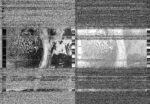
Cloudy, just like the typical British weather, also a bit cold. And I did see heavy clouds in the image.
2025-02-04 11:58:26
Ning Pang
Broadway Fields, UK
UK
NOAA-18
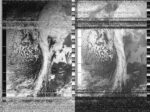
Cloudy, windy, a little bit cold. A long cloud through UK.
2025-02-04 12:04:03
deptford high street park, uk
uk
NOAA-18

Today in the UK, the weather was cold and grey, but while experiencing this, we were receiving ticking sounds from a satellite and converting them into an image. The resulting image of the sky was striking and different from the one outside, blending technology and nature. The climate crisis is evident in my community with more erratic weather patterns, storms, and rising pollution. The contrast between the natural world and the technology used to interpret it highlights both the challenges and potential solutions we face in addressing climate change.
2025-01-24 12:37:55
Richard A Carter
York, United Kingdom
United Kingdom
NOAA-18
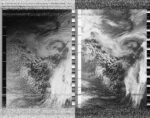
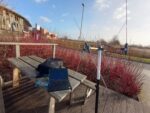

This weather sounding took place during Storm Éowyn. Even when undertaken within the ostensibly sheltered confines of York University campus, the roaring winds were more than sufficient to knock over and scatter the ground station equipment, even as the sounding was taken place! The double cross antenna fell to pieces and had to be repaired and held in position against the wind as NOAA-18 passed overhead - surprisingly, this did not appear to impact the recording.
Undoubtedly, the chief source of local concern around the climate crises is in its potential to generate flooding from the nearby rivers Ouse and Fosse.
2025-02-02 18:15:43
Pauline Woolley
The Urban Garden, Nottingham, UK
UK
NOAA-15

Having accidentally left out my aerial and SDR for two nights I feared my kit was dead. Having left the kit to dry for a good 24 hours I tried two passes this morning that had such bad interference I felt annoyingly gloomy even with a day of blue skies and sun. However after some online forum research and some kind soul giving me some tips for testing it looks like my precious kit is okay.
The Moon and Venus are neighbours tonight.
3.7 degrees Celcius
74% humidity
1015 hPa/mb
2025-02-02 10:21:25
Sasha Engelmann
Hackney Downs, London, United Kingdom
United Kingdom
NOAA-19
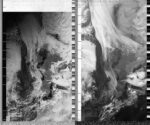
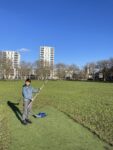
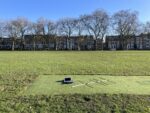
"Has your aerial gotten bigger?" a woman chasing a brown curly haired dog asked me. "Maybe its just how you're holding it!" she added. We laughed as her dog ran away. I tried to remember where I had met her before. After a somewhat stormy week, the air is crisp and the sky is a clear blue. The pressure is around 1023 hPa, suggesting clear weather for the rest of the day. I notice that bulbs are already poking up through the grass on the edge of the park. A 2022 study at Cambridge showed that flowers in the UK are blooming an average of one month earlier than they used to, and this is putting them out of sync with the insects that they need to reproduce, and that need them for food.
As of yesterday, the Palisades fire in Los Angeles is 100% contained. Checking the Calfire maps every day, often multiple times per day, since Tuesday January 7th was a ritual that I hope I will never have to repeat.
2025-02-01 11:54:00
Hanna&Flo
Leipzig, Germany
Germany
NOAA-18
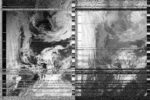
2025-01-29 11:35:49
Sasha Engelmann
Royal Holloway University , United Kingdom
United Kingdom
NOAA-18

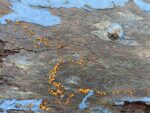
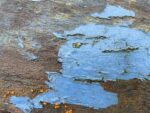
My colleagues joke that January has been a sodden, dark, misty tunnel. On a decaying picnic table next to the Physics Department, I notice bright orange fungi, like colourful jelly strung across the peeling blue paint. It reminds me of a kind of fungi I once saw in the temperate rainforest at the bank of the Puget Sound, near Seattle.
2025-01-28 08:22:43
Soph Dyer
Wien, Austria
Austria
NOAA-15
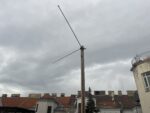
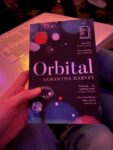
Testing, testing. Same antenna position, same satellite, different dipoles and a lower altitude pass of 54º.
Vienna Inner City weather station at 3pm:
temp. 16.8°C
relative humidity 52%
wind South, 29 km/h
precipitation [last hour] 0 mm
Sun [last hour] 19%
air pressure 997.0 hPa
Source: www.zamg.ac.at/cms/de/wetter/wetterwerte-analysen/wien
2025-01-27 18:29:14
Soph Dyer
Wien, Austria
Austria
NOAA-15

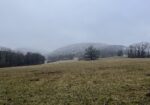
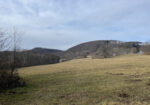
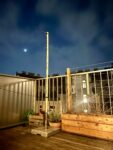
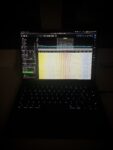
I am experimenting with different DIY antenna set-ups in an effort to reduce the electromagnetic noise that silently engulfs my apartment's balcony. Its origin remains a mystery.
At dusk, as I wedged the wooden pole supporting a new copper v-dipole into an umbrella stand, I could hear a blackbird's distinct evening song. Like me, the bird seemed awakened, and perhaps confused, by the warm weather. It is spring-like and yet we are January. Yesterday, the air in the woods smelled moist and leafy as if living things were stirring, breathing. The days have been mostly dry, with broken sunshine. Tomorrow afternoon, the temperature is forecast to reach 15 Celsius. If true, that will be a whopping 20 degree increase on last week.
The photograph on the left was taken on 18 January, the photograph on the right was taken on 26 January. There appear to be lots of fresh moles hills in the photograph on the right, although it is impossible to say as the framing is different.
2025-01-27 06:47:32
Arthur Almeida
Complexo da Maré, Rio de Janeiro, Brazil
Brazil
NOAA-15



We can see the state of Rio de Janeiro in Brazil completely covered in clouds.
2025-01-25 10:53:10
Prajvi
Ferranti Park, London
London
NOAA-19
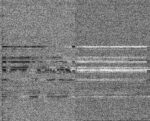

Clear sunny day at Ferrenti Park next to my flat. I am struggling with getting a clear signal with my di-pole antenna. There is a glimpse of an image between all the noise. The signal was very sratchy and noisy but clear for a bit when I kept the antenna near my stomach
2025-01-26 11:06:49
Steve Engelmann
Santa Monica, United States
United States
NOAA-18

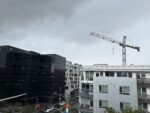
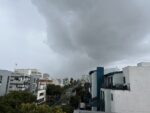
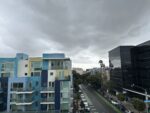
I went to the top of a parking garage in downtown Santa Monica in the hopes of having a clear view of the sky. I didn't get as clear of an image as I hoped for. Perhaps some interference from the surrounding buildings, etc.
Today was the first meaningful rain event for almost 9 months. This has been the driest start of the rain season since records began in 1877. Not a surprise when 3 weeks ago dry winds conspired in the development of six fires burning simultaneously around Los Angeles. 28 lives were lost and over 16 thousand homes destroyed. The human fingerprint is all over this event from the initial ignition, the preparation and response from the fire department, housing development within a flammable ecosystem, and ultimately, the climate crisis. A lot of finger pointing from the new president to the individual. Will there be any meaningful change? This will happen again.
2025-01-26 17:54:58
Pauline Woolley
The Urban Garden, Nottingham, UK
UK
NOAA-15
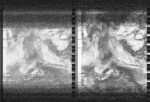
After Storm Éowyn. More wind is on it's way and the sky tonight has layers of higher denser cloud with lower and thinner fast moving cloud that race by across the faces of Jupiter and Venus. The breeze is getting stronger and by the time the pass has finished the clouds part like theatre curtains to reveal more of the planets and the winter constellations of Orion and Taurus. The idea of grabbing my telescope briefly floats in my head but it's quickly squashed by the processed pass of NOAA 15 more where I can see more weather from the west and pushing up from the south. Like the life span of a cloud the moment has gone.
5 degrees Celcius
88% humidity
974 mb
2025-01-25 09:25:34
Arthur Almeida
Complexo da Maré, Rio de Janeiro, Brasil
Brasil
NOAA-19
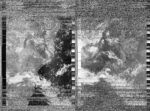


Na imagem, vemos a vinda de nuvens que aparentam ter uma grande densidade em direção à América do Sul, maior parte indo ao sul e sudeste do Brasil.
2025-01-26 19:09:09
Mehmet
Mersin Tarsus, Turkey
Turkey
NOAA-15
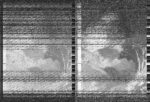
2025-01-23 11:00:00
Marius Sturza
Alba Iulia, Romania
Romania
NOAA-19
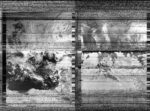
This is my first time using a home made V dipole antenna. Although the quality doesn't seem to be that good. This may be because of the weather or because I somehow didn't build the antenna correctly. Keep in mind that I still use a Baofeng Uv5r and a phone to record. The weather wasn't great, with a little shower pouring down on my location, lot of fog and the average temp. was 4 degrees Celsius. Quite impressed by the range of the transmission being able to see a little of the NNE part of Africa and up to the Baltic Sea.
2025-01-25 12:25:52
Sasha Engelmann
Hackney Downs, London, United Kingdom
United Kingdom
NOAA-18
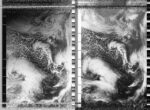
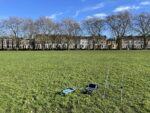
The aftermath of Storm Éowyn is a beautifully calm, sunny and clear day in London. The storm hasn't left much of a trace- there were barely any high winds in the Southeast, whereas the Met Office issued a very rare 'red' weather warning for Scotland and Northern Ireland, where winds surpassed 100mph, millions were left without power and roads were damaged. Between 2011 and 2024, there were 'red warnings' on just 19 days. During the same time, 521 days saw amber warnings while 1,922 had yellow warnings. One of the recent red warnings was in July 2022 during the 'severe heatwave' that raised temperatures over 40 degrees Celsius, melted train tracks and started wildfires across the UK.
I collect a satellite image from the middle of Hackney Downs. The orbit is very far to the West of London, only 34 degrees in maximum altitude. As the image loads, the prominent swirling cyclone over the Atlantic feels incongruous to the blue sky above. It is an image of extreme drama and turbulence. Here, we are in an envelope of calm.
2025-01-23 10:07:23
Soph Dyer
Augarten, Wien, Austria
Austria
NOAA-19
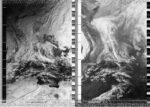
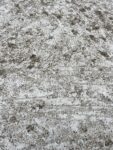
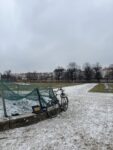
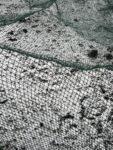
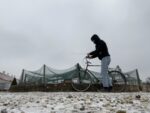
I began to think in "un-"s after reading Naomi Klein's proposal for "unselfing" in resistance to a politics of self-preservation and algorithm-fuelled ego. Around the same time, I realised that adding "un-" to German words is a shortcut to expanding my limited vocabulary. This is how I came across the German word for severe weather, "Unwetter". "Unwetter" is the opposite of "Wetter" and literally translates as un-weather.
This week, the transatlantic weather of Trump's inauguration and the explosive fire weather of Los Angeles has been so severe, it has felt like both an Unwetter and an un-doing. That is to say, I can see in the people around me how the events of this week have undone certain beliefs about the past or expectations of the future.
At the same time, five days into the ceasefire in Gaza, Palestinians are reckoning with a new un-peace or Unfrieden.
2025-01-22 17:59:07
Pauline Woolley
The Urban Garden, Nottingham, UK
UK
NOAA-15
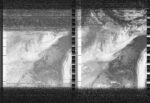
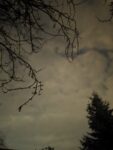
Storm Éowyn is on it's way but they are unclear how it will unfurl. I can see from the pass that something is heading towards us off the Atlantic. Warnings are changing from yellow to red and I feel for those who will again experience flooding or winds that will cut power for hours or days. We are not a robust country. Our red warning is very different from other places on the planet. The merging of seasons has left us confused and stuck. Sort paralysed by the bigger picture. A low cloud sits above my head as it glows an unsightly orange from the light of the city. Jupiter's pinpoint of light shines through the blanket of cloud. This is another night without the stars.
5 degrees Celcius
90% humidity
995 mb
2025-01-22 11:24:14
Sasha Engelmann
Queens Building Fire Escape, Geography Department, Royal Holloway University of London, United Kingdom
United Kingdom
NOAA-18

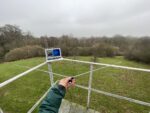
A last minute tutee cancellation gave me a fifteen minute gap in my back to back student meetings, and I snuck out the back of the department to the fire escape overlooking Egham. It was bitingly cold, but fresh. Though the pass was relatively high, the signal struggled to emerge from the static, and I decided the fire escape might not be the best location given interference from heavy machinery, air venting and lab equipment directly adjacent.
The news has been filled with the Trump inauguration. For those of us, like my family, who have been directly affected by the LA fires, the slew of executive orders since Monday has felt like another set of fires that were foreshadowed by the burning of Los Angeles over the last two weeks. I am still checking the Calfire map many times daily, and stunned that 'containment' of the Palisades fire is still only 63%. A county infrastructure damage map has recently been released. It looks like a pointilist painting of red, black, green and yellow, but the coloured dots are houses, schools, cafes, libraries, offices and other structures in various states of damage. The map is mostly red, which means 100% structural damage. I found a photo of the house I lived in during high school and couldn't stop looking at it. It is marked as 100% damaged, but unlike other homes that are just piles of rubble, our former house is a hollow cinderblock rectangle with the remainder of the two-story facade pointing to the sky. The single window in the facade looks like a wide eye. Everything inside has burned, but because of the existence of the facade and cinderblock walls, it feels like a hollowing-out rather than a burn-to-the-ground. One can see directly into the corner of the garage where we used to have our family desktop computer- this was where I downloaded music on Limewire for the first time and made CDs for myself and family road trips. It is also the corner of the garage where I sat and chose my first semester's courses at Stanford University. The remainder of the house is a poetics of space- of corners, bubbles, staircases and windows where so much of my life unfolded. The second story - where my bedroom was - is completely gone, and the ring of tall bamboo that used to surround the house is absent. This means the hollow house is open to the sky- in the photograph, this is a pale gray sky that suggests ash still swirling in the air.
2025-01-19 12:00:00
Marius
Alba Iulia, Romania
Romania
NOAA-18
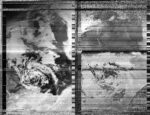
2025-01-19 10:54:52
Steve Engelmann
Studio City, California, United States
United States
NOAA-18

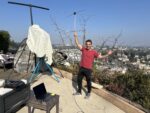
This pass was captured from the Hollywood Hills facing the San Fernando Valley. My friend Henry helped out. There were some large power cables just overhead which I suspect created a little interference initially. The skies were a bit hazy, which is a big change from just the day before. I do not think this is related to the fires as they are mostly contained at this point and not actively burning.
2025-01-19 12:01:13
Pauline Woolley
The Urban Garden, Nottingham, UK
UK
NOAA-18
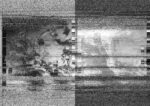

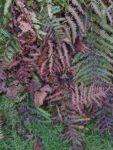
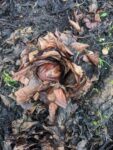
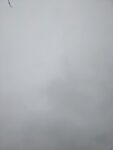
It's mid January and grey. There is no bird song today. Just one lonely gull flying above land locked and trapped between the desolate winter ground and the concreate pallor of the thick cloud. During the pass I look for signs of spring from plants and fruits that shrivel to nothing to protect themselves. Today's pass isn't clear. An over sight from me for not unravelling the cables properly. Cracked lines and a broken image seem to echo a deeper global anxiety. Or maybe it's just January blues.
2 degrees Celsius
81% humidity
1019 mb
2025-01-19 12:02:27
Sasha Engelmann
Hackney Downs, London, United Kingdom
United Kingdom
NOAA-18
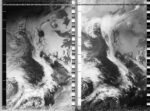
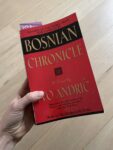
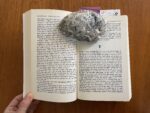
A passage of the novel Bosnian Chronicle (Travnička hronika) by Ivo Andrić accurately depicts London's weather today. Reading before bed last night, I marked the page of weather scenography with a large stone, and found it on my desk in the morning - a note to self from the Bosnian town of Travnik in the late 19th century:
"It meant rain and mud and snow; snow that turned to rain while still in the air, rain that became mud as soon as it hit the ground. At dawn, from behind the patch of clouds, a pale and listless sun would paint the east a wan rose; at the end of a gray day it would reappear again in teh west as a sickly yellow glow, just before the grayness passed into the pitch-black of night. During the day, as at nighttime, the damp breathing of the sky and the soil mingled together in a smoke-thin drizzle that seeped through the town and pervaded everything; in the silent, inexorable alembic of the damp, solid things lost their shape and color, animals changed their temper, men thought and acted moodily"
"The wind, soughing along the narrow valley twice a day, merely shifted the damp around and, by wafting sleet and a smell of wet woods as it went, brought new waves of humidity; so the pools of dampness only nudged and overlapped one another and the raw, bone-chilling mountain mist merely replaced the stale, moldering kind in the town"
- Ivo Andrić, Bosnian Chronicle, pp. 109
2025-01-19 10:14:00
Marius
Alba Iulia, Romania
Romania
NOAA-19
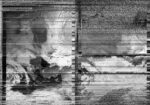
2025-01-19 08:13:00
Marius
Alba Iulia, Romania
Romania
NOAA-15

Yes, I know the photos look bad, but my rig was a Baofeng UV-5r with the stock whip antenna, recorded with a phone. The NOAA-15 came today at 6:19 UTC almost over head with 89 degrees of elevation. There was a lot of fog out, humidity 84%. Temp was -3 Celsius.
2025-01-12 10:44:13
Soph Dyer
Diepoldpark, Wien, Austria
Austria
NOAA-19

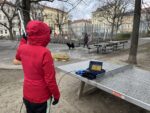
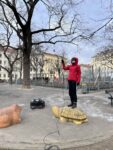
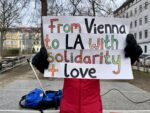
I stood in a flurry of snowflakes that would not settle. Large, restless and white-grey, they took on the appearance of ashes.
From Vienna to LA, with solidarity and love.
This is my first satellite image capture of the year.
2025-01-11 10:56:21
Steve Engelmann
Santa Monica Pier, United States
United States
NOAA-18
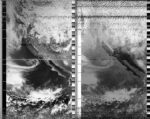
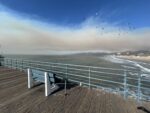
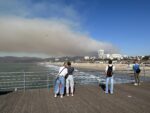
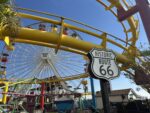

This is day 4 since the Palisades Fire began and it has been quite the rollercoaster. Regardless, NOAA 18 decided to fly over with an elevation of 89°. You don't get much better than that. I decided to visit the Santa Monica Pier as it has great exposure to the sky, and is about as close as I can get to the fire zone. One of the top destinations for tourists, there was much activity. A bodyboarder screams as he catches a wave. The rollercoaster operator ask his riders if they want to go for a second spin. A neon sign above a cafe reads, "Salty air, and not a care".
On a small island of homes, my house defied all odds - standing strong. My classroom of 25 years went up in smoke. About 6 1/2 minutes into the satellite pass you can see a thin strip of clouds headed out to the ocean. The winds have died down, but the fire continues. At just 11% containment, it is now threatening Brentwood and Encino. 8 months of no rain and some strong winds. It doesn't take much to change your course.
2025-01-09 18:37:29
Pauline Woolley
The Urban Garden, Nottingham, UK
UK
NOAA-15
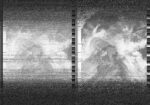
Another cold frosty night. An 80% Moon illuminates the frost on the grass. Tiny ice crystals shimmer and glimmer in brightness of the reflected moon light. I try and spot the satellite overhead but lots of fainter objects are fighting for recognition in the blinding lunar light. There the pin sharp brilliance of Venus to the west, Jupiter to the south east and Mars rising in the east. On packing away I walk across the grass leaving footprints that remind me of the moon landings or the fossilised prints left millions of years ago by the dinosaurs. As I type this I can hear the news from the next room reporting on the fires in California. What kind of footprints are being left there today and what about the footprints of the generations to come?
0.1 degrees Celsius
90% humidity
1005 mb
2025-01-08 20:25:10
Sasha Engelmann
Hackney Downs, London, United Kingdom
United Kingdom
NOAA-19
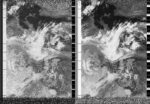




For the Los Angeles fires:
Blame it on the wind: blame it on the ‘devil’s wind’ that gusts over Los Angeles at 60+ mph, ‘fanning the flame’ of five ongoing, devastating wildfires, as yet ‘uncontained’.
Blame it on the wind, an unpredictable, invisible, seemingly chaotic, uncontrollable force: the easiest scapegoat.
Whose wind is this? Who remembers its names or its cultures? Who is willing to counter the ‘blame’ with the knowledge that a wind like the ‘Santa Ana’ has a cultural history more than 5,000 years old in the lifeways of the Tongva, Tataviam, Serrano, Kizh, and Chumash Peoples, on whose land Los Angeles was settled and built?
The Santa Ana winds may be arid and dry, originating from the desert of the Great Basin. These winds may increase static electricity, topple trees, and produce ‘strange luminosities’ in the sky. Yet being affected by a dry, desert wind is not the same thing as codifying it with sensationalist and ‘demonic’ fears. In demonising the wind, whose demonic actions go unnoticed? Which demons are free to roam?
As we blame the wind, how can we have a conversation about the extractive legacies of water stealing, draining and rerouting? Or fire suppression tactics that make the world more flammable? Or centuries of encroachment on more and more arid land?
How do we talk about the fact that the logic that pumps money into LAPD and enlists hundreds of incarcerated peoples to fight an uncontainable fire for $4 per day is the very same logic that sends arms to Israel as it burns entire cities and perpetuates another prison?
How do we resist sensationalist narratives of neighbourhoods where “millionaires are getting a taste of the apocalyptic movies they have produced and acted in” to be able to see the marginalised, differently abled, and elderly existing side by side, whose narratives of ‘escape’, or simply survival, are far less appealing to a media elite?
I pray for the sake of my family home (if it still exists) that the wind relents. But this disaster is not about the wind.
(images are screenshots from videos by Steve Engelmann, maps by CalFire, words by me)
2025-01-07 09:39:57
Steve Engelmann
Pacific Palisades, California, United States
United States
NOAA-19
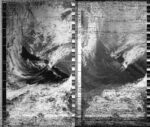
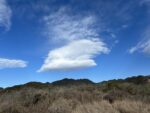
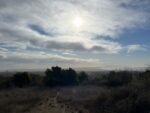
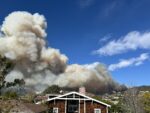
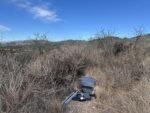
Today is a blustery day in Los Angeles. The National Weather Service predicts a "life-threatening and destructive" windstorm, with gusts of wind up to 160 kph. Over the last 8 months, southern California hasn't received a rainfall event with more than a few millimeters of precipitation. The landscape is dry and the humidity is expected to drop (currently 20%). A spark from a power line can ignite the extremely flammable brush and then carry embers great distances. "Fire season" used to refer to late August, September and October. In recent years, some of the worst fires in California history happened in November, December and January. With a changing climate there is a need to update our terminology.
While some people might think this is an excuse to hunker down and ride out the storm, I thought this is a reason to break out the antenna. I went up into the hills of the Santa Monica Mountains and captured a pass.
While writing this weather note, I started hearing sirens. A neighbor sent me a text. I hopped on my roof and watched flames come over a ridge (see image 3). Ended up evacuating due to air quality.
2025-01-07 20:36:34
Pauline Woolley
The Urban Garden, Nottingham,
NOAA-19
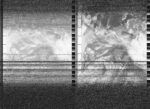
A clear cold night. The winter constellations hang overhead in all their beautiful glory. Orion, Pleiades, Auriga and Taurus drawing out the maps of ancient skies. The lawn is crispy underfoot. The UK is clear on the map except for some small parallel clouds across the counties of Cheshire and the cities of Liverpool and Chester.
1 degree Celsius
90% humidity
1001 mb
2025-01-06 20:50:07
Pauline Woolley
The Urban Garden, Nottingham, UK
UK
NOAA-19
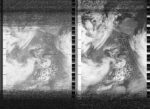
It's cold. It's been cold all day. I am stood watching Mars and Jupiter fade in out of the clouds along with a quarter Moon. There are layers of cloud tonight. Lower ones are moving fast and in small wispy shapes. The higher clouds glow an orange colour from the light pollution and as I pad around on the lawn during the pass I hear the splashing of water against my boots and I notice that the lawn is water logged in places. There was so much rain last night and another down pouring of sleet and snow today. Airports were shut, roads and rail lines flooded. More to come.
3.1 degrees Celsius
99% humidity
990mb
2025-01-04 10:47:21
Steve Engelmann
Bel Air, California, United States
United States
NOAA-18
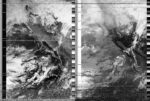
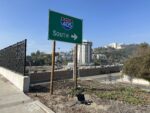
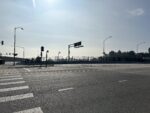
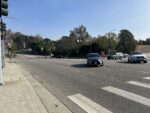
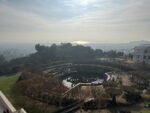
Today I thought I would visit LA's Getty Center. They are coordinating a project called PST:ART which includes over 70 exhibitions throughout southern California with a focus on how art and science collide. The Getty Center also has an amazing outdoor area with spectacular views of Los Angeles. What a great place to also grab a satellite pass - I thought. When security took a look at the disassembled antenna I was bringing along, they had second thoughts. I wasn't able to convince security, or her supervisor, that my intentions were harmless. But I've learned to be flexible. On the spot I hatched a plan B. With 20 minutes to go, I used my speed-walking skills to relocate on an overpass where Sunset Blvd crosses the 405 freeway. On the first image you can see the Getty Center in the background perched on a hillside. The view was a step down from the Getty, but also, not bad. I'm sure there were many suspicious looks from the busy street with a strange man pointing an antenna at the sky. Then again, this is a stone's throw away from Hollywood. At a little over 8 minutes in, a commuter bus blocked by reception for two seconds. A line of static documents the interference. Life throws us many curveballs. The next four years should be no different.
2025-01-03 10:58:05
Steve Engelmann
Pacific Palisades, California, United States
United States
NOAA-18
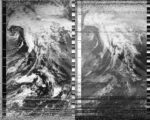

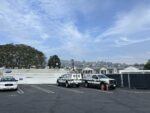
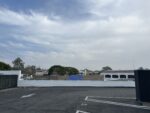
It is hard to pass up an opportunity when a satellite is passing by with an elevation of 87°. Back in Los Angeles I thought I would try out roof-top parking for an unobstructed view. The skies were mostly cloudy with a cool marine layer bringing in a little fog. There was also a light scattering of stratocumulus and high cirrus clouds, but no precipitation. The Air Quality Management District initiated an Air Quality Alert. An inversion layer, which is common in LA, traps air pollutants low to the ground. For this reason there is a ban on wood burning. The fine particulates get deep into lungs and can trigger a range of health issues. Could use some rain, but nothing in the forecast for the next 10 days.
2025-01-02 10:19:52
Steve Engelmann
Newberry, Florida, United States
United States
NOAA-19
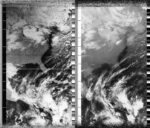
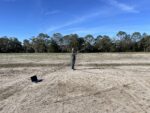
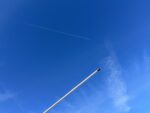
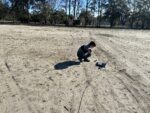
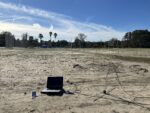
Went out to capture a satellite pass with a super high elevation (87°). Found an abandoned golf course in the process of being repurposed with a relatively clear skyline. The skies were mostly clear with some cirrus clouds toning down the sunlight. It was a crisp 10°C at 10AM, which seems a bit unexpected for someone not from Florida. Just at the satellite was at it's highest point, an airplane left a contrail, as if to mark the spot.
2025-01-02 10:06:55
Pauline Woolley
The Urban Garden, Nottingham, UK
UK
NOAA-19
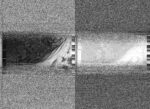
A bright and crisp morning. Blue skies and frost underfoot. There is a stillness to the day and though it's already the 2nd January the new year feels like it's still slowly unfurling. Blue Tits and Robins interject with pips and chirps that are bumped off the musical score by the prehistoric caws and croaks of the corvids.
The British Isles are clear. A rare sight indeed.
2 degrees celsius
82% humidity
air pressure 1011 hPa/mb
2024-12-31 11:00:29
Pauline Woolley
The Urban Garden, Nottingham, UK
UK
NOAA-18
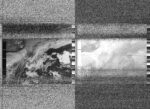
A low winter sun brushed over the bare trees and though it tried to break through it was beaten by the cloud. While the pass happened I moved the outside furniture and bins around in preparation for the windy weather that was forecast for the afternoon.
10 degrees Celsius
2024-12-29 20:52:41
Pauline Woolley
The Urban Garden, Nottingham, UK
UK
NOAA-19

A night time pass. It's 8 degrees Celsius. Cloud whispers across the sky. Jupiter is a small smoky dot that battles for attention. There is a slight breeze and it feels much colder than the temperature states.
90% humidity
1018 air pressure
2024-12-31 11:14:24
Steve Engelmann
Newberry, Florida, United States
United States
NOAA-18
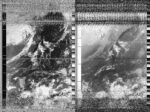
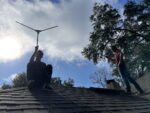
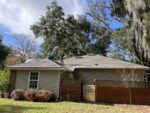
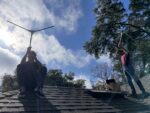
Got up on a roof in central Florida with my nephew to do a little training and compare two different antennas on a satellite pass. The sun came in and out of the clouds often. Combining the warm December temperatures, humidity and the dark roof surface I came down a little sweaty.
On the last day of 2024 it is always interesting to assess the year that just passed and contemplate what lies ahead. 2023 was the warmest year on record regarding global temperatures. The consensus is that 2024 will end up being warmer still. At this moment there is a polar vortex sending frigid temperatures to the midwest and northeast. Ironically, climate change makes these events more likely. Searching for opportunities to dial down carbon emissions would be a great new year's resolution.
2024-12-31 09:15:30
AxiomVk
GREECE, Northern Greece
Northern Greece
NOAA-19


NOAA 19 from Greece at 09:15 AM local time (07:15 UTC)
2024-12-28 11:53:14
Sasha Engelmann
Steve Engelmann
Gainesville, Florida , United States
United States
NOAA-18
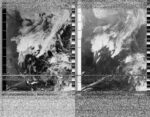
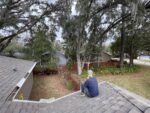
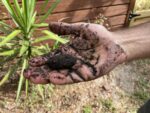
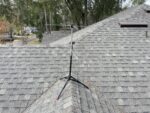
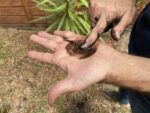
To continue our antenna comparison, we sat on the roof shortly before noon with a weatherised V-Dipole and the tripod- mounted Turnstile, looking north. The V-dipole was hooked up to AGS 15, while the Turnstile received via an android phone running SDR++. The image attached to this post is from the latter. After the pass, Steve did a soil texturing test which revealed the local soil to be ‘loamy sand’.
2024-12-26 10:09:05
Filip Shatlan
Gainesville, FL, United States of America
United States of America
NOAA-19
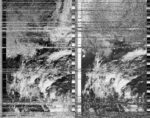
This was my first time picking up a satellite signal! Very intriguing process. It was chilly (compared to typical Florida weather) and very cloudy, but not windy. There's a bit of South America in the lower part of the image, such as the Panama Canal, as well as most of the East Coast. We can see some tougher, perhaps stormy clouds moving in from the bottom.
2024-12-23 22:32:51
Denys
Portsmouth, UK
UK
NOAA-18
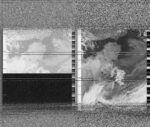
Tiny amounts of rain at receiving spot. Image shows some rain clouds over France and Bay of Biscay and just off the coast of Ireland in the Atlantic Ocean.
2024-12-21 11:40:57
Sasha Engelmann
Steve Engelmann
Old golf course next to W Newberry Road, Gainesville, United States
United States
NOAA-18
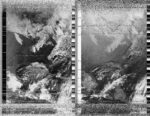
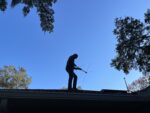

A clear, cool, breezy day here in Florida. We stand on separate hills in the former golf course, one of us with a turnstile antenna, another with a v-dipole. Later, comparing images, we notice how there is a clear line at the midpoint of the turnstile's image that doesn't appear in the image made with the dipole. This line is appearing at almost the same spot in previous images collected with the same laptop and antenna - a signature of the laptop? or a glitch in antenna reception, at the peak of the satellite pass? Later in the day, we test the same antenna from the roof, shaded by southern live oaks. As there is no wind or rain predicted, we tape it to an old camera tripod found in the garage, simply stand it up on the roof's apex, and run a cable through a crack in a window.
2024-12-20 11:54:51
Sasha Engelmann
Southern live oak tree, former golf course, Newberry, United States
United States
NOAA-18
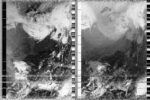
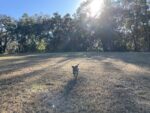
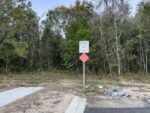
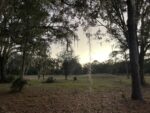
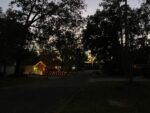
After a few warm, humid days, the air today felt lighter, cooler and clearer. I took a long walk around the neighbourhood, and it wasn't long before I came across the edge. A grid had been carved into the land near a local forest, sandy flats exposed, and the sounds of hammers and staple-guns echoed back and forth. I walked to the very limit of the housing development and found a gap in the trees, but as soon as I entered the forest I could see someone was living there, or at least squatting for a while, in a shelter made of tree branches. Being alone around sunset, I turned away and found the empty pavement again. As I returned home, the orange sunset light was glowing through the palms, matching in intensity the light-up candy canes on a nearby lawn.
2024-11-22 08:21:11
Georgia Rhodes
Southern Ocean,
NOAA-19
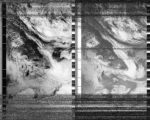
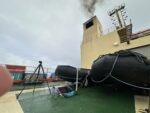
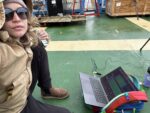
Another day, another storm in the Southern Ocean. I thought about removing the tip of my finger from my photo of my station, tucked in with the Zodiac boats and surrounded by coring equipment, but it shows a signal of how difficult it can be to operate anything that isn't tied down. The rolling of the ship and the strength of the mind make any one-handed task just on the edge of impossible. I don't expect to experience weather like this again in my lifetime, but I also don't hold a lot of expectations that anything will remain as expected.
2024-12-18 10:07:46
Sasha Engelmann
Patio Homes, Newberry , United States
United States
NOAA-19
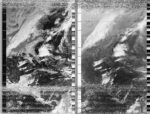
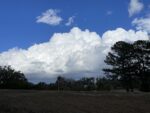
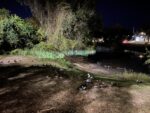
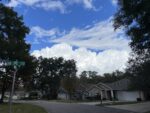
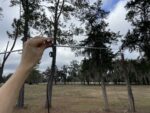
Cumulus clouds tower to the east of "Patio Homes" in Newberry, so sharp and iridescent, they look like they have crystalline facets. It is muggy today, but I stubbornly wear my Mom's flannel-lined denim jacket on my walk to the local golf-course-turned-park - I am needing protection. The political 'climate' of Florida has been on my mind today. An organisation called Safehome ranks Florida the second most unsafe state in the USA for LGBTQIA+ people based on current legislation and records of hate crimes. Governor Ron De Santis' GOP-led 'Don't Say Gay' law, passed in 2022, barred instruction on sexual orientation and gender identity in kindergarten through the third grade on its inception, and was later expanded to all grades. It had a chilling effect across the state, caused queer teachers to hide photos of partners and take down rainbow flags, queer festivals to be cancelled, and books featuring queer characters to be removed from curriculums. It also inspired a series of other similar laws in states like Arkansas, Alabama, Indiana and North Carolina. A 2024 'settlement' clarified that LGBTQIA+ discussion can happen in classrooms "as long as it is not part of official instruction", and that the law doesn't apply to books with incidental references to LGBTQ+ characters or same-sex couples, "as they are not instruction on sexual orientation or gender identity any more than a math problem asking students to add bushels of apples is instruction on apple farming". Though it is a relief to know that some books are being allowed back 'in', it is frightening to think they were removed from teaching in the first place, and the comparison between queer characters and 'bushels of apples' feels particularly wrong. Ron De Santis called the 'settlement' a 'huge win'. In August 2024, all of the webpages on the Florida state tourism website related to LGBTQIA+ resources and travel advice were quietly removed. On my walk back to 7th street, I notice two American flags raised high on a dedicated pole in the front yard of an olive green house.
2024-12-17 10:20:29
Sasha Engelmann
Old golf course next to W Newberry Road, Gainesville, USA
USA
NOAA-19
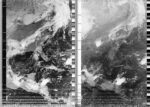
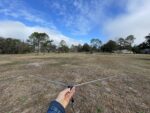
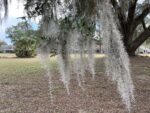
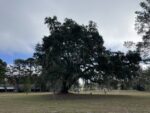
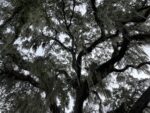
The unusual humidity and warmth woke me up from a dream in a shadowy landscape, and it took me more than a few seconds to realise I was in Florida. Peaking out the window I saw a suburban street framed by massive palm trees, southern live oak, bald cyprus and lots of ferns. Spanish moss trailed down from the southern live oaks, sometimes so thick it seemed to cover the entire tree. On a morning walk I discovered what seems to be an old golf course turned into a neighbourhood park, and I climbed the only hill (a very small mound) to see further across. As the landscape is so flat, I could see further than expected. On the other side of the cul-de-sac where I slept, there appeared to be a quarry full of excavation machinery and a bright turquoise pond, a bit too turquoise to be non-toxic. As I listened to NOAA-19, a group of men in high viz outfits drove up and down the golf course in small open door vehicles that appeared to be cutting the dry, light brown grass. I watched them run over and over the same spots, and wondered what the purpose of this was- a seemingly futile looking attempt at edge-maintenance, kicking up small clouds of dust.
2024-12-08 21:12:27
Soph Dyer
A hotel, Eindhoven, The Netherlands
The Netherlands
NOAA-19


I lean out of the hotel window to catch a noisy signal. The signal and noise come in waves: signal rising, noise rising, signal rising, rising, rising, rising. "Assad’s gone." "I told you," my closest Syrian friend writes from Hong Kong. "How are you celebrating?" I ask. He sends a photo of him looking sharp, wearing a Mercedes cap, with a keffiyeh draped over his shoulders, holding a slice of red velvet cake.
"U have no idea how ecstatic I am," he writes.
No one I know believed that this day would come. And, at what cost? "I'd written off a future without Assad," WhatApps a former human rights colleague who, in 2016 interviewed survivors of Saydnaya Prison. I recall her saying that the investigation had almost folded as they could not find enough interviewees because so few people left the prison alive.
I watch on Al Jazeera as a stream of men and women walk up a dirt path between mine fields, into the open gates of Saydnaya.
2024-12-15 11:03:50
Sasha Engelmann
Hackney Downs, London, United Kingdom
United Kingdom
NOAA-18

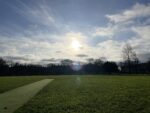
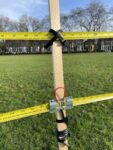

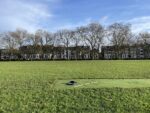
Today is my last satellite pass in London during the year-long attempt at capturing satellite images and weather observations that began on the solstice in December 2023 and will come to an end in a few days. Hackney Downs was the best version of itself for the occasion, a low-lying sun shining across the grass, and reflections from apartment block windows adding a kind of sparkle or glimmer. Tomorrow I travel to Florida to visit my Mom who moved there a few months ago. As I traced the typical arc of the satellite orbit, I realised I would need to invent a somatic ritual for this year's solstice- both as a way to recognise the culmination of this near-daily practice of satellite image capture and weather sensing, but also as a means to start a new cycle, a new set of practices that I can't quite foresee yet. On a call with two very good friends later in the afternoon, this sentiment was confirmed. Speaking a set of rituals they have carried out during a time of transition, a time that is joyous but not without difficulty, one of them said "everything is meaningful, everything is magical - it has to be".
2024-12-15 09:26:13
Steve Engelmann
Pacific Palisades, California, United States
United States
NOAA-19

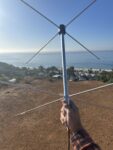
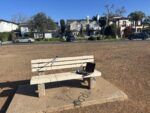
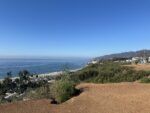
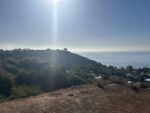
The view from the bluffs was a sunny and calm Pacific Ocean with only a distant layer of low clouds hugging the horizon. A fifteen minute drive north along the coast would take you to Malibu where roads are closed due to the Franklin fire. A week earlier a fire erupted late at night. 8 homes were burned as Santa Ana winds gusted to 100 kph and humidity levels dropped to 5%. Pepperdine University was completely surrounded. The fire stands at 43% containment, but dry winds are expected to return in a few days. In November of 2018, the Woolsey fire burned 97,000 acres in just a few days. The term "fire season" has little meaning at this point. Insurance companies have been refusing to write new policies due to the increased risk of loss due to the changing climate. This last week California agreed to allow insurance companies to increase their premiums in response to the new climate reality.
2024-12-12 11:42:49
Sasha Engelmann
Hackney Downs, London, United Kingdom
United Kingdom
NOAA-18
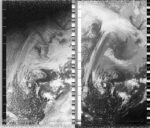
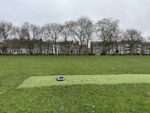
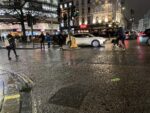

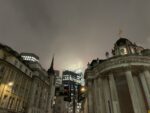
London is all glare and reflection today as a very low cloud-mist settles over the city. The sheen of street signs, asphalt, vans, and buses makes everything more obviously aggressive and frantic. As I cycle to south London after dark, a white Prius pulls out in front of my bike, so close I have to skid to a halt. When the driver looks over his shoulder, and sees me braking and motioning my fright, he hardly blinks as he merges into the centre of the road. The tops of tall buildings are drowned in cloud so it feels like we are living in a reduced space, the ceiling coming down. I am reminded of the fictional city Ravicka in Renee Gladman's novel Event Factory. Ravicka is a city of smoggy, ‘yellow air’ that, “vibrates around the foreigner in the street” (Gladman, 2010: 41). Edges and borders shape-shift as the city appears to rearrange itself, or, as the main character observes, “the singing structure eludes me” (Gladman, 2010: 93). Today, in Gaza, a house was flattened in the packed Nuseirat refugee camp, while two separate strikes targeted local workers securing aid convoys. US officials claim they have a 'jurisdictional dispute' with the ICJ and reject its call for arrest of Netanyahu and Yoav Gallant; another 'structure' that continues to elude.
2024-11-15 08:05:33
Georgia Rhodes
Southern Ocean, Antarctica
Antarctica
NOAA-19
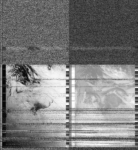
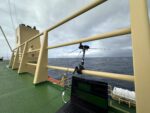
This is the farthest south towards Antarctica my body would go, although I didn't really put that together at the time I was receiving this image.
2024-11-14 08:20:04
Georgia Rhodes
Southern Ocean, Antarctica
Antarctica
NOAA-19
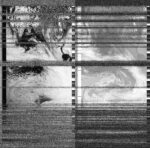

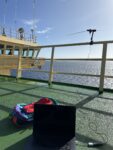
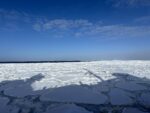
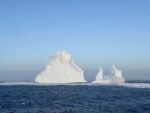
This day was sunny and clear, which was very rare to see during my trip through the Southern Ocean. The second mate has told be this is the grayest, stormiest research cruise he's ever been on. But this particular morning broke clear and bright and while it got a bit dark midday the afternoon was sunny again which offered a shadow of the ship onto the pancake ice. Later, at what would be considered night but is in fact still light, the people of the ship would all pour out onto the decks to see the last glorious iceberg patch we would end up having passed through. The remainder of the time at sea would be in open ocean.
2024-11-28 08:44:24
Georgia Rhodes
Southern Ocean, somewhere in the vicinity of 170°W, 57°S, Antartica
Antartica
NOAA-19
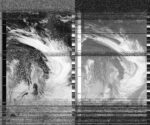
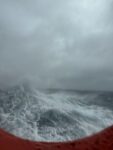
This is an image taken from the porthole next to my desk on the RVIB Nathaniel B. Palmer on the day I imaged the weather. Typically the weather decks on the ship are closed during storms like this, but I was allowed outside to take my satellite reading. It was so windy I had to hold onto the antenna and my computer the entire time.
2024-12-11 11:55:04
Sasha Engelmann
Hackney Downs, London, United Kingdom
United Kingdom
NOAA-18
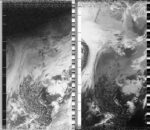
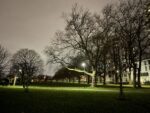
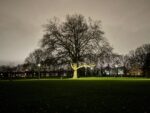

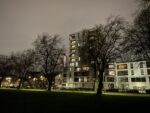
Whether by icy air or circulation of blood, the act of going out for a satellite pass at lunchtime managed to break a mild migraine - my first ever, I think - that had been ongoing for the last twenty four hours despite many painkillers, salves, and hours lying down. By the time my brain and vision had relaxed from the pain enough for my senses to be alert to detail in the world, the sun had fallen. I haunted the park at night, peering into blue-lit windows and noticing the ways streetlights highlighted the elegant curves of plane tree branches from below. A faint oval-shaped pink cloud hovered over one hill of the park like an omen. Two dogs tossed and tumbled in the dark, their paws vying for dominance and their teeth glowing. They were eerily quiet except for their panting breaths. A person pushing a baby stroller walked briskly along a lit path with a tied up Christmas tree slung across their back.
2024-12-10 11:35:24
Sasha Engelmann
Hackney Downs, London, United Kingdom
United Kingdom
NOAA-19
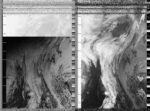
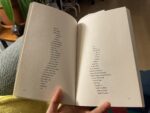
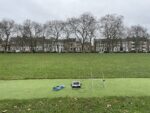
to / desire / the world / as it is / not as / it was / falling / feather / attaches / to new life
The third poem in CA Conrad's book 'Listen to the Golden Boomerang Return' makes me forget to breathe while I read it over coffee.
for a moment / when the hammer / approached we thought / is that thing coming this way
I think of the many 'hammers' still falling on Gaza, on Syria and Lebanon, and of the metaphor of a meteor strike as world ending event, when we already have so many-
we are the fractal / drop to hear / our own / harmonics / in the muffled / underground / hum of seeds
2024-12-09 10:07:04
Sasha Engelmann
Hackney Downs, London, United Kingdom
United Kingdom
NOAA-19
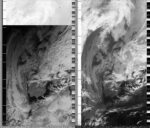
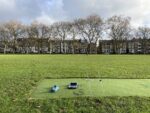
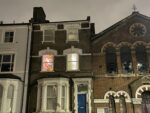
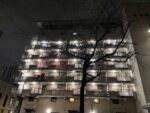
The sky was a thin, eggshell blue when T and I woke up this morning. Two cats, a ginger and a spotted black one, were playing hide and seek in the overgrown grass of the back garden. For a few hours, perhaps three or four, the sun shone in London, but the night came so quickly that every flat on the street had lamps turned on by three. I spent most of the day writing and thinking about projects sent to me by a network of friends and collaborators from whom I had solicited 'new and exciting work in the geohumanities beyond the US / UK'. My friend Cecilie sent me a link to a project called The Conference of the Birds, a transdisciplinary, socially engaged arts collaboration named after the 12th century epic poem by Persian poet Farid ud-Din Attar. Focused on the loss of birds in the High North, the project involves community based exhibitions and events in Norway, Finland, Denmark, Sweden, Iceland and North-Russia. Reading the conference programme, I learned that one of the participants is a twenty five year old person who left home at 17 to learn birdsong and learn to survive alone in the forest. Apparently they can now sing the songs of 130 different species of birds, and they continue to live outside of human dwellings. In their profile photo, they are pictured shoulder up, with bright blond hair in dredlocks, and a small black bird on their shoulder, to which their face is turned in affection.
News came over the weekend that the Assad regime has fallen in Syria. We see scenes of thousands of people celebrating in the streets, crying and cheering. On Democracy Now, an interviewee refuses to 'analyse' the political moment, saying that analysis needs to be suspended while the feeling of this moment resonates.
2024-12-08 10:19:14
Sasha Engelmann
Hackney Downs, London, United Kingdom
United Kingdom
NOAA-19
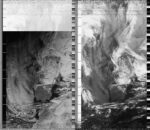

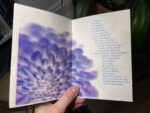
"You look like the old man from Back to the Future" T says to me as I head out to capture a satellite image in still-raging Storm Darragh. "You mean Christopher Lloyd?!" I ask and she smiles a yes. I wonder about the resemblance as I walk to the middle of the park and set up a makeshift shelter for my laptop with one of the umbrellas borrowed from the communal umbrella area near the entrance of our building. No matter which umbrella I chance to grasp, I always end up with a wire poking through torn Rayon, like a featherless wing. To keep the umbrella firmly over my laptop, and thus to protect it from random sprays of rain seeming to come from all directions and nowhere, I stood on the handle with one foot while shakily steering the antenna. When sharp unexpected gusts threatened to carry the umbrella away from my exposed keyboard I had to lean my entire weight on top. There were a surprising number of people in the park with their dogs, so these antics were in full view. A chocolate Labrador came bouncing over. Normally I am happy to play with dogs while holding my antenna, but this one threatened to collapse my entire delicate balance in the wind. "You nosey dog!"" I heard a woman's voice say before the wind drowned her out. When I finally got to the end of the pass and started packing up, my fingers were so icy cold they fumbled, and somehow I managed to get a slab of mud on my trackpad.
Later at Cafe Oto I saw the great poet, ritualist, mystic and queer icon CA Conrad read their poems. For almost fifty years, CA has travelled by car across the US, writing poems and inventing somatic rituals. One of their rituals involved leaving tear off paper notes on notice boards across Philadelphia inviting people to call a number and leave a message for Elvis. Several people would call each day, some multiple times. Another ritual involved them bathing their body in the sounds of extinct species. Later they started working with the sounds of coyotes, crows and foxes: "We've got to learn to love the world we have, not the one we lost" they said. I was moved by all of their poems, but one in a new pamphlet (created in collaboration with Jacken Elswyth, a queer banjo player) resonated especially well today. It ends: "I've got the wind I say / with both hands".
2024-12-06 11:18:06
Sasha Engelmann
Hackney Downs, London, United Kingdom
United Kingdom
NOAA-18
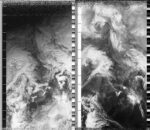
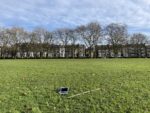
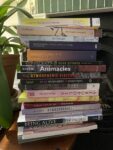
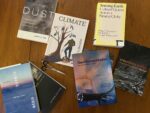
As I look ahead to the final sprint of a writing project, for which I will be submerged in books and my laptop the whole weekend, I am inspired by the collections of geographical thinking and arts practice that I pull out of the towering pile of books on my desk's side-table. I read of 'volcanic polyphonies', 'magmatic languages', 'fluvial hydropoetics', 'sand saltations', 'geo-mimicry' and 'reclaiming energy flows'. I think about the ways in which, across scholarship and creative practice, artists and writers are amplifying the animacies and memories of the elements, from Sotaventine rivers in Mexico, to tidal islands in Scotland, to the humid 'warm fronts' of Southeast Asia.
In the satellite image that I capture today from Hackney Downs, I wonder about the repeated patterns and rehearsals of clouds in the North Atlantic, and consider these patterns as another form of air's 'working memory... a memory of energy' (Szerszynski, 2019).
2024-12-05 11:32:21
Sasha Engelmann
Hackney Downs, London, United Kingdom
United Kingdom
NOAA-18
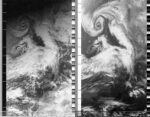
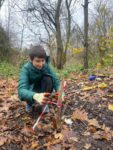
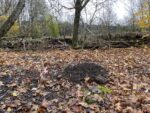
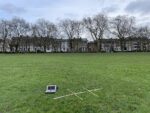
The satellite image starts in darkness. Absent of any rays of light from our nearest star, the top left hand corner of the image is almost pure black. I think of NOAA-18 and its near-infrared sensors trying to capture any stray photons as the satellite crosses the Arctic circle and the Nordic countries. The darkness feels vast, like what I imagine the deep space around Earth must feel like.
While planting a willow tree named Hildegard at the Stave Hill ecological park in South London on my lunch break yesterday, I dug into deep, black layers of topsoil. Rebeka, keeper of Stave Hill, had inherited a mountain of rubble deposited from war-ruined buildings, as well as imported trash, on which the eco park was established in the 1980s. She asked all of the schoolchildren from nearby schools to bring worms to the hill, and over the decades, the worms got to work. The deep, dark mulch that I dug into yesterday is the intergenerational inheritance and gift of these worms, and the soil that my almost seven year old willow tree will grow into. Hildegard joins around ten other willows of ‘diverse varieties’ planted in a new willow coppice near Russia Dock Woodland and the Globe Pond. As Rebeka explained to me, over the decades, these small twig-like willow trees will sprout from their bases, and their bendy branches will be sustainably harvested to build fences and other infrastructure around Stave Hill, another gift for the future.
2024-12-02 10:31:29
Weitao Wang and Sasha Engelmann
Fire escape at the back of Queens Building, Department of Geography, Royal Holloway University of London, United Kingdom
United Kingdom
NOAA-18

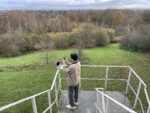
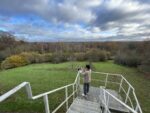
This weather note was written by Weitao Wang, PhD student in the Geography department at Royal Holloway University, currently doing a fantastic project on the 'The geopower of air and fire: a cultural geography of fiery rituals in China'.
“It’s a typical day in the UK, partly cloudy day, a bit windy, and not too cold. As it’s the first time for me to participate, I feel a sort of transit in terms of the ‘body-(satellite)-weather’ relation. At the beginning, I found myself disconnect with the weather (and satellite) because I had no idea of where it would come from and where it would go. However, as time moved on, I felt my body gradually coordinate with the satellite movement in the sky as I listened to the noises in the signal. At the end, the signal slowly faded with noise, which made me wonder whether my direction was still correct and thus feel out of sync again with the satellite".
"The weather images produced on the screen reminded me of the previous remote sensing course I had took before, where the date collection process was more detached, abstract and rational because we were just sitting in front of the computer, clicking, and typing. However, today’s outdoor data acquiring seems to invite me to be closer to the real-time weather dynamics.”
2024-11-30 18:38:57
Soph Dyer
Waxeneck, Austria
Austria
NOAA-15



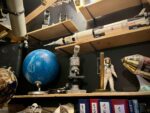
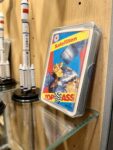
2024-11-30 20:10:00
Sasha Engelmann
Hackney Downs, London, United Kingdom
United Kingdom
NOAA-19
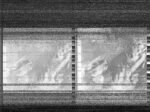

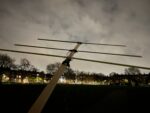
I've been testing open-weather Automatic Ground Stations all week, and as we are still seeing some unusual patterns and distortions in the images, I brave Hackney Downs long after sunset tonight with AGS 12 and my Yagi-Uda antenna. It is wet and cool but not freezing. Today the pressure on my home weather station (given to me by Soph on my birthday last weekend) reads 1024 hPa, and points toward the symbol at one pole of the barometer that says 'clear bright sky'. This feels at odds with the low-hanging cloud that I feel all around Hackney, but it is true that the weather is stable, and it doesn't feel like a storm is brewing, yet.
2024-12-01 10:07:00
Sasha Engelmann
Hackney Downs, London, United Kingdom
United Kingdom
NOAA-19
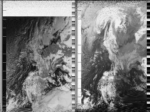
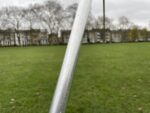

In a recent article on 'Clouding knowledge in the Anthropocene', Kate Lewis Hood proposes a "cumulative reading - where cumulative shares an etymological root with cumulus, a type of cloud (OED, 'cumulate') - that shifts from clear skies to fog, between atmospheric transparency and opacity" (2018: 83). Exploring poetry including The Weather by Lisa Robertson and Drift by Caroline Bergvall, Lewis Hood suggests that "such experimental practices enable a shift from asking whether to read or interpret in a certain way to engaging with the weather system of a text: its unpredictable changes and complex patterns" (2018: 185). If today's weather system in London was a text, it might read like this passage from Robertson's The Weather:
Our skies are inventions, durations, discoveries, quotas, forgeries, fine and grand. Fine and grand. Fresh and bright. Heavenly and bright. The day pours out space, a light red roominess, bright and fresh. Bright and oft. Bright and fresh. Sparkling and wet. Clamour and tint. (Robertson, 2001: 10)
2024-11-29 11:08:30
Sasha Engelmann
Near Ledbury Building, Friary Estate, Southwark, United Kingdom
United Kingdom
NOAA-18

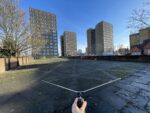
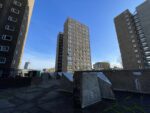

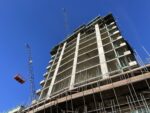
I found myself at the Southwark Reuse and Recycling Centre shortly before 11am this morning. I have been fascinated by this place for a while- it is a series of gigantic warehouses where one can bring any kind of object, from clothes to appliances to batteries to cleaning equipment to stones and plates to furniture, in any condition, and after putting each item in the right place, the team at the Centre takes care of sorting, testing and repurposing. Clothes and linens are sent to local charities, appliances are tested and re-used if possible, batteries and old phones are recycled and household items of all kinds are either repurposed or ground down into their raw materials to make new things. As I pulled up in a cab with a bunch of stuff from my old flat in the trunk, an older man with long gray hair was manning the entrance, and assessed me and my things before allowing me entry, like a guardian or gnome giving way to a magical place. I took my time sorting my things into different corners of the warehouse, and was amazed at everything else that was there, from phones that looked like they were last used in the 90s, to very nice bags of clothing. In various corners and levels of the cavernous space, I could see staff moving around.
As there was a satellite pass shortly after I left the centre, I found a corner of a nearby housing estate- one with at least three tower blocks of dozens of stories each- and propped my laptop on a mossy wall. Later I noticed how odd the concrete infrastructure of the estate was. There were multiple sharply angled concrete features built into the walkway in between the tower blocks. Their shape and star-like structure, and simultaneous brutalist aesthetic, reminded me of some of the socialist monuments I had seen in Croatia and Bosnia while on fieldwork earlier this month. The crisp blue sky opened above the estate, and magnified the concrete edges.
2024-11-28 09:37:09
Steve Engelmann
Venice, California, United States
United States
NOAA-19
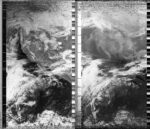
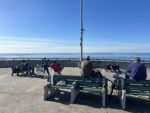
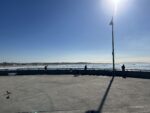
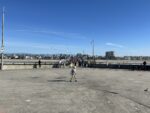
Went out to the Venice Pier to capture a satellite pass on Thanksgiving. From the image it looks like blue skies for the entire California coast. The pier was busy with sport fishermen. One approached me and asked me if I was looking for aliens. The aliens he was referring to, however, were not extraterrestrials. He was suggesting that immigrants were coming ashore via boats at night. We I explained that the NOAA-19 satellite was harmlessly taking our photo, he suggested we all give it the finger.
Sarah Josepha Hale had been campaigning for decades that the US celebrate Thanksgiving. In 1863 she finally convinced Abraham Lincoln to make the last Thursday in November a national holiday. In the midst of the Civil War, it was intended to find common ground and unify the country. Many Americans express anxiety at sitting down with relatives and navigating the inevitable awkward conversations. Sometimes I wonder if I am the "crazy uncle" at the table.
2024-11-26 10:37:48
Steve Engelmann
Topanga, California, United States
United States
NOAA-18
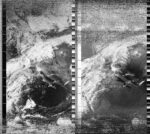

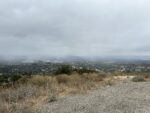
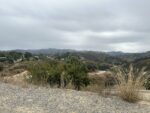
Captured this satellite pass from a helicopter landing site on a ridge of the Santa. Monica mountains with the San Fernando Valley to the north and the Pacific to the south. From the overlook you could see small patches of light precipitation. I was visited by a curious crow and a grizzled hiker. The hiker had more questions.
2024-11-26 07:58:00
Sasha Engelmann
Hackney Downs, London, United Kingdom
United Kingdom
NOAA-15

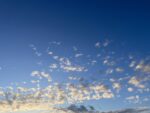
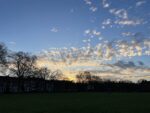
After another round of Automatic Ground Station testing late last night, I saw that there would be a NOAA-15 pass around 7:50am today. Carrying the AGS in a tote bag, and my turnstile antenna in another, I found a spot on the largest field in the park, as the sun searched above the horizon toward an array of small cottonball clouds. A man was in the middle of the field before me, pacing up and down with a flip phone in his hand. The grass was damp and water-logged. A few schoolchildren hurrying along the park's main path looked over and pointed in my direction.
2024-11-25 18:09:02
@astro.anderson
South West England, United Kingdom
United Kingdom
NOAA-15

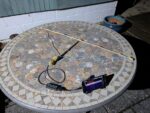
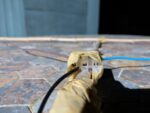
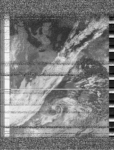

As storm Bert leaves I take the opportunity to test my mobile rig consisting of electrical wire in a joiner, a short coax, RTL-SDR and a Samsung Galaxy S6.
With no rain and a light breeze I was quite happy wandering around and aiming it roughly. I did not expect it to work so well after reading up on the 137MHz antenna variants and the precice calculations, pass filters and leaky coax.
2024-11-25 18:08:48
Sasha Engelmann
Hackney Downs, London, United Kingdom
United Kingdom
NOAA-15
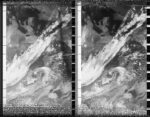
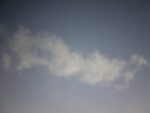
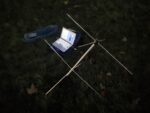
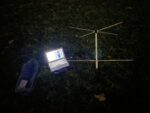
The air bit my fingers as I held onto the metal handle of my turnstile antenna in the pool of darkness that is Hackney Downs at night. A police siren rang out in the distance and a high-speed chase progressed, two police cars tailing another car around two sides of the park. Suddenly a faint neon light appeared to bounce and leap toward me, revealing itself to be a small bulldog wearing a glow-in-the-dark collar. NOAA-15 circled overhead, scanning the outlines of North Africa, Italy and Croatia until I lost the transmission in the blurriness of the Arctic.
2024-11-25 11:19:06
Soph Dyer
Diepoldpark, Vienna, Austria
Austria
NOAA-18

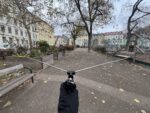
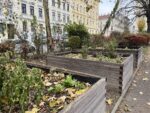
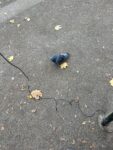
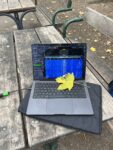
I feel a dangerously numb to news of extreme weather. Yesterday, as I read a long and moving article about drought hit farming communities in South Africa, Storm Bert inundated costal towns in the UK. Is numbness what happens when, to quote deputy first minister of Wales Huw Irranca-Davies, the feeling is “here we go again. These traumatic weather incidents are a pattern of our weather”?
2024-11-25 11:57:44
Sasha Engelmann
Hackney Downs, London, United Kingdom
United Kingdom
NOAA-18
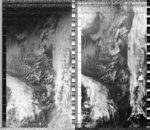
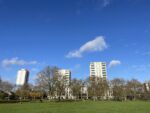
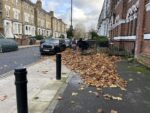
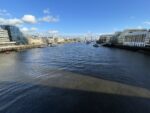
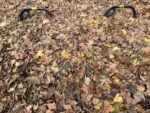
Overnight, mountains of plane tree leaves have amassed on sidewalks, against walls and fences. Leaves paper walls, cars and bike sheds. While Storm Bert has resulted in mass-rearrangements of leaves in London, elsewhere in the UK roads have been flooded, and thousands of people were without power. Although relatively minor compared to these other events, the leaf-mountains feel oddly dramatic in today's calm, blue sky weather. Photographs don't do them justice- they are space-invaders, yellow-brown fillers of unused corners and parking spaces, where the westerly wind carried and dropped them.
2024-11-24 11:08:24
Steve Engelmann
Malibu, California, United States
United States
NOAA-18

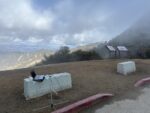
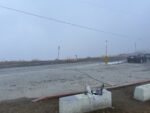
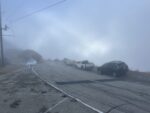
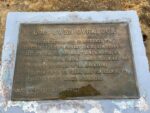
I went to the Lois Ewen Overlook in the Santa Monica Mountains hoping to maximize my capture length, but missed the first few minutes of the satellite pass. At the beginning we were in complete fog-out with a visibility of maybe 20 meters. By the time I took photos there was better visibility. The day before was the first precipitation of the year, though not even 1 cm. Slightly more rain in a few days. Los Angeles is rare in that it has a mountain range that bisects the city.
The COP 29 negotiations ended today. Experts assess that $1 trillion/year is needed to assist developing countries as they address climate impacts and build a low-carbon infrastructure. The countries agreeed to $300 million. The Trump presidency vows to withdraw from the Paris agreement - again.
2024-11-24 09:58:41
Sasha Engelmann
Hackney Downs, London, United Kingdom
United Kingdom
NOAA-19

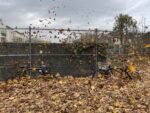
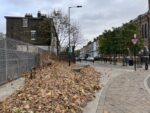
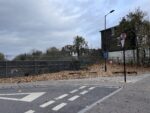
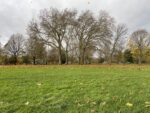
Storm Bert - the 'named storm' that was brewing on the Atlantic when I last contributed to the Archive on Thursday - is sweeping the UK this weekend. "More than 200 flood alerts put in place and three men die on roads as wild weather crosses country" reports the Guardian this morning. The flood alerts are due to the rapid melting of ice and snow across the north of England and Scotland, as the storm brought milder temperatures. Indeed today in London, it is shockingly warm, around 17 degrees- a huge jump from previous days. The Met Office has issued yellow warnings for rain and wind across large swathes of the country into Sunday, and this is felt in London, with gusts battering houses, trees and infrastructure. As I braved the park with my turnstile antenna, I noticed how a mountain of plane tree leaves had been pushed against the fence near the train tracks, drowning two bikes and the fence itself. In the middle of Hackney Downs, the force of the wind meant that people walked with their heads down, hoods pulled over their faces. My laptop flung wildly left and right as I tried to track the satellite pass. The turbulence reminded me of a day back in 2021 when Soph and I went out to Burgess Park to capture an image of Storm Eunice- against the advice of the Met Office- and I had to kneel on my laptop to keep it from flying away. The blustery conditions affected the satellite image I captured today, as I struggled to keep hold of the antenna. Oddly, although the Guardian headlines its reports with various numbers of injuries and deaths across England and Wales, reading further into the reporting, a phrase consistently repeats: 'It was not clear whether the incident was linked to the storm'.
2024-11-21 07:17:23
Steve Engelmann
Pacific Palisades, California, United States
United States
NOAA-15
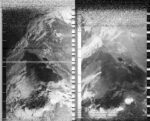
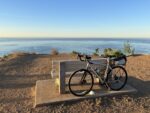
Took another satellite capture from the bluffs over-looking the Pacific Ocean. Over the last couple of days a "bomb cyclone" formed and is making landfall in the Pacific Northwest. The name comes from how fast the storm developed. Heavy rains and strong winds have hit Washington state already. A few lives were lost to falling trees. From the image you can see a tail of the cyclone that might bring some precipitation to Southern California in the next few days.
While recording the pass a construction worker came over for a chat. He asked if I was recording aliens. I later pulled up a hotspot, decoded the wav file and showed him the image. He then asked me if the world is really round or flat. I guess sometimes it is however you want to see it.
2024-11-21 11:09:00
Sasha Engelmann
Hackney Downs, London, United Kingdom
United Kingdom
NOAA-18

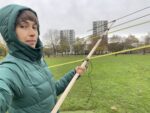
Today's test of an Automatic Ground Station involves me carrying the AGS in a tote bag to keep it dry and away from dogs, and tracking the satellite with my Yagi-Uda antenna. The results show a diagonal current of squigly lines in channel b - lines we think might have something to do with a recent update to the code in the AGS system that attempted to produce clearer images, but might have introduced other noise signatures. The air is still freezing, and I regret not bringing gloves and a woolly hat.
2024-11-20 20:39:00
Sasha Engelmann
Hackney Downs, London, United Kingdom
United Kingdom
NOAA-19
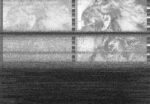

A freezing night in the park, with a clear, faintly star-lit sky. As I return to Hackney Downs long after sunset to test the open-weather Automatic Ground Stations, I am getting better at recognising night-time park activity. Though many people warned me of entering the park at night, I am growing to feel more safe. Perhaps its something about holding a tall pole with a metal object attached at the end. I've also realised that, while daytime park activity happens on the fields, with dogs galloping and racing around each other, night-time park life stays close to pathways and the deeper shadows of trees. I have rarely seen another person walk directly across the largest field, where I stood this evening.
As I watch the BBC weather report later in the evening, I learn that the beginnings of a 'possibly named storm' are brewing in the North Atlantic. I wonder and try to anticipate what the name of this storm will be.
2024-11-19 20:49:00
Sasha Engelmann
Hackney Downs, London, United Kingdom
United Kingdom
NOAA-19


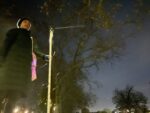
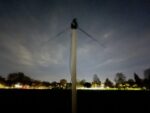
It has rained, it has snowed, and the crevices and corners of London are thoroughly drenched in semi-freezing moisture. This is testing the infrastructures of the city, a city that one might expect could have weathered many cold winters in its time. Yet, one of my best friends, K, who was over for a spontaneous Monday dinner last night, told me and T of her crumbling, disintegrating roof in Dalston. The roof has been leaking for months, and mould has been growing along the walls and in corners. She had stopped paying rent after her umpteenth attempt to ask the landlord for repairs, failed. Within weeks of her stopping payment, the landlord had workers visit the flat, and they claimed to have 'fixed' the issue. But yesterday, when she got home after dinner, she texted me photos and videos of the rain coming straight down onto her floor. A long curving crack in the ceiling gave me shivers- as if the whole roof was going to collapse. Luckily, K left to stay at her girlfriend's place. I couldn't help but think how many people in London are feeling similar exposures to the rain, the cold. How many walls are being eaten from the inside out, by the creep of humidity and the mould that thrives in it?
I tested the AGS in the park late at night today. I didn't want to 'expose' the AGS in the park, less because of weather, wind or rain, and more because a number of people have had phones stolen in the park recently. As the AGS is so conspicuous with its glowing light, I hid it in a tote bag. For the antenna, I wrapped the legs of an rtl-sdr v-diple around the top of a PVC pipe. Standing in the middle of the dark field, holding the pole to the sky, I felt a little like a fictional character enacting some magical ritual. The moon rose against the silhouetted plane trees and the outlines of bodies crossed under lamp posts. Most avoided the dark, open grass.
2024-11-18 08:07:00
Sasha Engelmann
Hackney Downs, London, United Kingdom
United Kingdom
NOAA-15


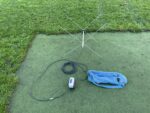
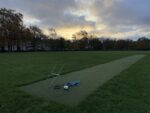
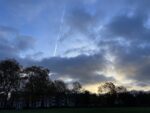
It was 8am, but the sun hadn't properly risen over Hackney. As stream of uniformed children ran across it diagonally, somehow in an evenly spaced line, sleepily on their way to the primary school on the opposite corner. In five minutes I was smothered by a black terrier, trounced on by a visla, and I had to separate an Australian shepherd from the previous two, while their owners called vainly in the distance. Perhaps my status as a single dog-less human in the middle of the largest field meant I was a good one to mess with! As I was testing an Automatic Ground Station outside for the first time, using a battery pack and my phone as a hotspot, I was anxious that one of the dogs would sit or step on the delicate cables or pee on the station itself, open as it is to the air because of the need for heat vents. Luckily only one dog leg brushed the AGS, and in a few minutes more, they had raced off. The satellite image collected by the station was oddly grainy, and I resolved to try again later tonight, after 9pm.
2024-11-18 11:05:52
Soph Dyer
Kleingarten Schmelz and Waxeneck, Austria
Austria
NOAA-18
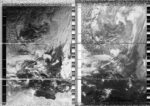
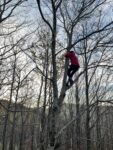
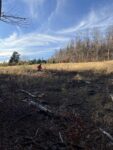
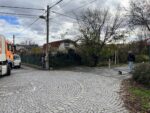
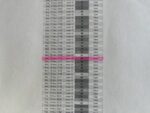
It's cloudy and cold, but no longer freezing. It's also Monday yet, I mistakenly checked the satellite pass times for Sunday. My displaced weekend feeling is because N and I have taken off work. We decided to only last week. The idea is to spend a day outside the heavy weather that has characterised this year. So far, we have gone swimming and eaten omelettes with pickles. Later, we plan to cook a roast and watch an episode of Self-portrait in a Coffee-Pot. In other words, cultivate our own fragile high pressure system. If its strong enough, maybe it'll even persist into the week, this indoor sunshine.
2024-11-17 10:52:00
Steve Engelmann
Venice Beach, United States
United States
NOAA-18
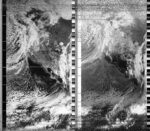
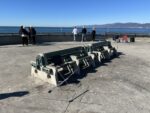
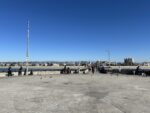
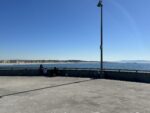
Went to capture a satellite pass from the Venice Pier. Beautiful blue skies. The pier is covered with tourists, fishermen and many spectators watching the 40 plus surfers on both sides of the pier. A number of people approached me curious about what trouble I was into. There was a family with three small children from Italy, a pair of senior citizens and a guy named Sidney. All were dazzled with the antenna and the concept. To complete the magic trick I used my phone as a hotspot and decoded the wav file live. The audience was impressed.
Two weeks after the election the news is full of the latest on the cabinet picks for the next administration - an anti-vaxer in charge of health, a former oil executive to regulate fracking, and an alleged sex-trafficker to run the justice department. I wish I believed in magic.
2024-11-17 11:58:56
Sasha Engelmann
Hackney Downs, London, United Kingdom
United Kingdom
NOAA-18
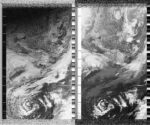
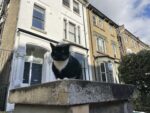
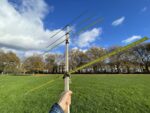
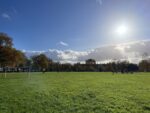

In a short essay titled 'The sound of temperature rising' in the edited book 'Bodies of Sound: Becoming a Feminist Ear' (Irene Revell and Sarah Shin), Christine Sun Kim writes of an artwork she made while pregnant with her first child, and while watching the devastation of Trump's first term as president. She elaborates, "Persistent droughts, floods and storms were marking the effects of climate change and a warming world. I felt these different kinds of rising temperatures intertwining, and used an open-ended musical notation to capture the feeling. When I draw musical staff lines, I use four lines instead of the standard five, which references how staff bars would be signed in American Sign Language (ASL) as four fingers pulled across the front of the body. Like my other mural and billboard works, I want the scale to actively impose Deaf people's existence and culture into the everyday lives of hearing people". Kim's drawing is evocative - four lines curve from the bottom of the page to the top right, and musical notes dance on either end. The line 'the sound of temperature rising' hovers above. Today, as I think about the multiplicity of weather during a satellite pass in Hackney Downs, and reflect on how much of the 'sound of temperature rising' is felt in our bodies, our lungs and other organs, Kim's artwork and words resonate powerfully.
Around halfway through the satellite pass, as the image creeps down my screen and the deep darkness of the Arctic circle gives way to a few pieces of lighter cloud and land, the satellite almost over London, a football player comes trotting over. He finds my tape measure Yagi antenna interesting, commenting, 'I never would have thought a tape measure could be so useful!'. When I point to my screen, he drops his chest and body to the field so fast it startles me, and for a moment he has his face a couple inches way from the slow-loading image. I become self-conscious of the layer of dust on my laptop which, combined with the glaring sunlight of the afternoon, makes the satellite image challenging to make out. Yet he hops up as quickly as he went down, and satisfied with his understanding, jogs away.
2024-11-15 11:46:37
Soph Dyer
Magazin, Rembrandtstraße 14, 1020 Vienna, Austria
Austria
NOAA-18

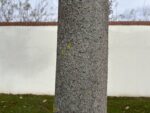
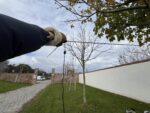
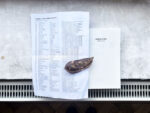
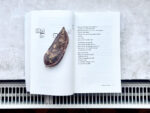
I finish writing the talk at the same time as my phone alarm rings, reminding me to leave the relative warmth of our studio to receive NOAA-18's transmission. The satellite will pass 77º overhead. It always feels like a waste to not catch such a 'good' pass, so I pack my ground station bag make the short cycle to the edge of the Augarten park. I have learned to stay outside the its impressive brick perimeter wall, so as to avoid confrontation with Austrian rules-based culture. In the past year, multiple gardeners have told me that I need permission to have an antenna in the park and my German is not good enough to argue. The satellite is above the horizon when I hit record. I use the 10 minutes of bleep-bleeps to think about what I will say tonight. The talk is written, but I want to begin with a pause to think of Gaza, our former classmates, friends and colleagues in the Middle East, and to hold in our minds those whose names we will never know but whose existence is resistance to Israel's genocidal drive. The architectural exhibition that the talk is a response to is a installation of Breathe Earth Collective's archive. Material samples, organic matter, salt, copper pipes and more fill the gallery space, each exhibit labelled with a small paper number as part of archeological dig or forensic scene. This anarchic yet indexed presentation and the earthy smell of decay in the gallery reminded me of the book 'M Archive: After the end of the world' by American writer and poet Alexis Pauline Gumbs, in particular her description of an 'Archive of Dirt'. The book is dedicated "to the purveyors of our bright black future". Tonight I will read for Gaza the following poem:
they came with sugar not of sugarcane
sweetness not of cotton but of air
they came with cakes not funneled down to grease
with layers like clouds
they came every day like it was their birthday
or yours one or both
that was when they first came
and then they came with salt
with water and blood to wash you
they came with spit and sand to shine you
they came with cleansing first in mind
and woke your soul with it
next time they come
i hope they bring soil and green
soothe for the roots
i hope they bring dirt and depth
and plant us in it
we could sure use the grounding
for remembering earth'
Alexis Pauline Gumbs, 2018
2024-11-12 10:04:55
Soph Dyer
At the cross roads, but the tram lines, Austria
Austria
NOAA-15
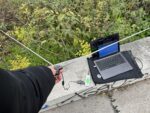
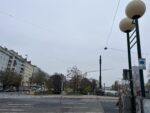
Grey skies, newly biting cold.
My attempt at recording a satellite pass for several weeks. I forgot the radio frequency extension able and used a wobbly USB converter… which caused SDR++ to freeze multiple times. Next time I will pack different kit.
2024-11-15 10:43:20
Sasha Engelmann
Hackney Downs, London, United Kingdom
United Kingdom
NOAA-18
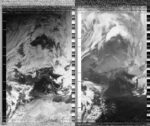
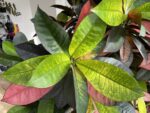
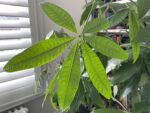
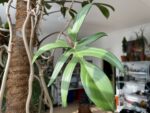
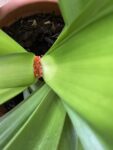
As the sun gets lower in the winter sky, the plants in our flat receive more light, and today they seem to be basking in it. The flat almost feels like a greenhouse with fronds and stems poking out of all corners. One of our bushy plants is even growing a new orange flower from between two leaves.
A finger of dust reaches from Tunis to the Balearic Sea, another from Misrata into the Mediterranean. During the satellite pass, a group of dog walkers notices me and my antenna, and while they stay on the far side of the field, I overhear the older woman in the group tell the others - 'yes yes... she does the weather'. Later, as I await the phone call of a doctor, the passing of the light feels slow and sluggish. I bury myself in email hoping to move it along.
2024-11-12 11:23:50
Sasha Engelmann
Hackney Downs, London, United Kingdom
United Kingdom
NOAA-18
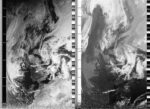
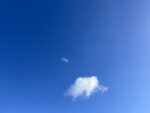
It is a brilliantly sunny day in London and the sky is a deep, clear blue. A lonely cloud skirts the horizon to the east. As I set up for the satellite pass in the park, I think of a poem I have just tried to translate from Croatian/Serbian/Bosnian. It is called 'Pjesma žena' or 'woman's song' and it was written by Ana Matanja who is described as 'seljanka iz Ledenica' or 'villager from Ledenica'. The first lines go like this:
Crna noćca svud pritisla
Nigde bjela dana,
U kuhinju stoji žena
Ćvrste prikevana
To je bilo prošlog ljeta
A sad toga nije
The poem- from the archive of the Antifašistička Fronta Žena in Sarajevo - describes a scene in which the 'The black night fell / no daylight anywhere / A woman is standing in the kitchen / Tightly chained / That was last summer / And now it is no longer' (loosely translated by me). It goes on to make a call to arms and to the voices of women who form that AFŽ to protect their rights, including those of voting. The author - Matanja - is a villager, but 'Ledenica' literally translates as 'icicle' or 'icebox'. This, combined with the scene of the first lines, gives this poem of activism and mobilisation a sense of the dark, the cold, and the surreal.
As I attempt to catch the last fragments of signal from NOAA-18 over the southern horizon by standing on my tiptoes, two dog walkers approach and ask what I am doing. I explain, and we chat about my tape measure Yagi antenna briefly. As they are leaving, the man of the couple turns around and says:
'It's not who you know, it's what you know!'
2024-11-11 11:33:59
Sasha Engelmann
Hackney Downs, London, United Kingdom
United Kingdom
NOAA-18
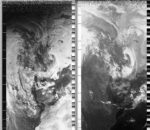
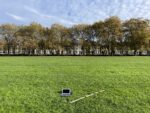
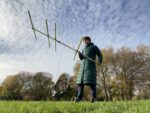
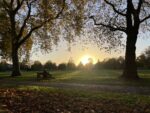
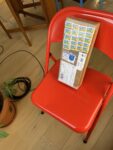
A radio antenna arrives in the mail, from Florida. It comes in a rectangular box covered almost halfway down one end with rainbow 'first class' stamps, each individually advocating for breast cancer awareness. For the first two hours of the morning, Soph, Lizzie, Dan and I discuss ways to 'animate' material in the Public Archive spatially, textually and visually. Later I test three 'automatic ground stations' in various corners of my flat, and watch them boot-up to a new version (v1.1.4) of the programme they are running. Around 11:30 I catch a NOAA-18 pass from Hackney Downs, happy once again to be back in the park with my tape measure Yagi-Uda antenna. Though I do lots of university work as well, catching up on the various crises and urgent demands in my inbox, today is a day mostly 'weathered' by open-weather.
2024-11-11 09:49:13
Steve Engelmann
Pacific Palisades, United States
United States
NOAA-19
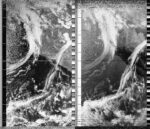
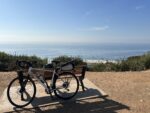
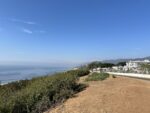
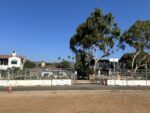
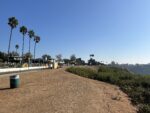
Looking out over the Pacific Ocean on another beautiful day. City crews are busy behind me trying to stabilize the bluffs from their relentless slide towards the ocean. Multimillion-dollar homeowners are in denial of the inevitable, attempting to resist the forces of nature. It has been nearly a week since the election. Trying to find my tribe. Spent most of my Saturday with Climate Strike LA. This morning it was a zoom meeting with Human Rights Watch. Concerned, but feeling the energy. We too shall resist.
2024-11-10 12:19:21
Moose
Albany, Oregon, USA
USA
NOAA-18
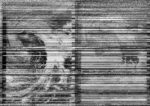
I’m really struggling to get images. I have SLIGHTLY better luck with a dipole. I tried a random wire to see if that helped but not really. I’m working on building a QFH but it’s complicated. I’ll keep at it.
2024-11-10 09:17:26
Sasha Engelmann
Via Giovanni da Udine, Latisana, Italy
Italy
NOAA-15
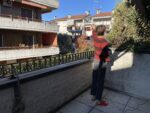
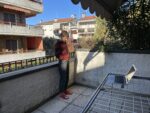
A NOAA-15 satellite pass at only 21 degrees to the west was not the strongest option for an image of the Adriatic, but I wanted to capture one last satellite image while nearby to this sea. Standing at the corner of a balcony reachable from T's childhood room, I fished for signals in the quiet Sunday morning. I could hear the squeak of laundry lines being pulled in, and the occasional shutter being lifted, but otherwise it was calm, near-silent. The sky lifted into a clear blue and I felt a little cold in the wool jumper that T's mom had given me when she last visited in London.
2024-11-09 07:33:11
Steve Engelmann
Pacific Palisades, California, United States
United States
NOAA-15

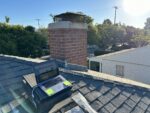
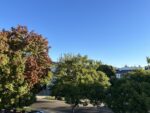
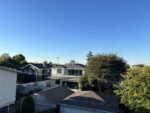
In the wake of last week's national election I've been trying to find silver linings among the chaos and wild projections over what the next four years will bring. My email feed has been flooded with requests from environmental/social justice NGOs. Apparently membership and donations increased during the last time this happened. In blue California there are pockets of red. Beverly Hills High School needed to institute new regulations to tone down celebrations by teens. Monday is the beginning of the next climate conference - COP 29. The tone of the conference will pivot widely on the election results. Curious to see what, if any, strategies arise. Hopped up on my roof this morning to capture NOAA 15. Seems as if some power lines interfered with the end of the pass.
2024-11-09 11:22:19
Sasha Engelmann
Tagliamento Riverbank, Latisana , Italy
Italy
NOAA-18
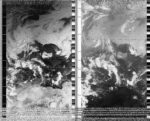
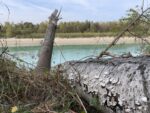
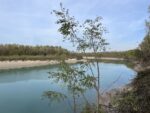
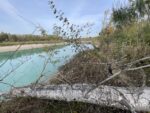
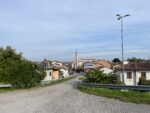
I emerged from an overgrown path, full of fallen birch branches and reeds, onto a small sandy bluff above the bank of the Tagliamento. The river ran a cool green-blue that changed shades as clouds periodically covered the winter sun. It was chilly but not cold. The sound of farm equipment echoed over the opposite riverbank and a single engine plane passed by overhead. This weekend, the village of Latisana is celebrating the festival of San Martino. As T's mom tells us, traditionally this festival marked the time when farmers (il contadini) had sold their autumn harvests and had some spending money. They would celebrate as lavishly as they could. Most women were married around this time, when their families could afford to purchase cloth, lace and housewares for dowries.
I sat on a mushroom-speckled birch log and watched the slow moving water. A strikingly blue bird - perhaps an Eurasian Blue Tit - landed on a branch near the beach and darted away. A small flock of pigeons skidded to the water’s edge, dipped their beaks in the river for a split second, and took off again. They returned at least five times in the same configuration.
Yesterday, as T and I returned to Italy from Rijeka, last week seemed like a blur- a blur that felt very similar to the smog-fog of Sarajevo and its surrounding villages. At some distance to the Balkans, I can now visualise the histories, weathers, archives and monuments that I visited in the last week with a little more sharpness and clarity, like the circuitous and sandy curves of the Tagliamento.
2024-11-06 09:40:11
Sasha Engelmann
Miljacka River, Sarajevo, Bosnia and Herzegovina
Bosnia and Herzegovina
NOAA-19

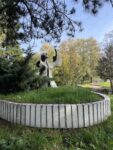
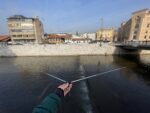
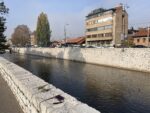
Thankfully it is morning now, and the sun is shining on the Maljicka River in Sarajevo. I woke around 1am last night in tears, thinking of all of the places I have seen so far on this trip in the Balkans, and the way my family history is so inscribed in this landscape, a landscape that has felt so much pain. I thought about the memories the landscape holds, that monuments to anti-fascist resistance or tombs of fallen fighters, or memorials to the more recent Yugoslav Wars of the 1990s, only manage to represent partially. Upon properly waking, the news of the US election was shocking, but somehow dulled by the intensity of the last few days. I almost found it darkly humorous, that in the week I am spending engaging with my family’s history, and the very concrete, serious struggle of anti-fascism, a movement for which my great grandfather risked everything, a fascist has been elected to power in my birth country. As the news sunk in later in the day, the dark humour faded and despair set in.
I kept the despair at bay by throwing myself head first into the story of Sarajevo womens’ resistance to authoritarian power, and their role in the communist movement. T and I drove to see a monument to Sarajevo victims of the national liberation war at Vraća Park, on the west of the city. The park itself is not well maintained, with trash and graffiti everywhere, and much of the original stone architecture crumbling. However, at the far end of the park, stands a monument to ‘Women Fighters’ by Sarajevo sculptor Alija Kučukalić. The sculpture is a 2-3 metre tall figure of a woman, from the torso up, wearing a sharp jacket, and gazing to the sky, arms open in a cactus shape and fists clenched. She has a long braid that flows down her back, and her face turns upward. An early sketch for the sculpture that I found online shows a female figure with an agonising face - indeed the original title of the work was “Stratišta” (Executions). While the sculpture is meant to be representative of all fallen women victims and fighters, many believe the sculpture depicts Radojka Lakić, a female leader of the Sarajevo underground communist resistance who was executed at Vraća in September 1941. The sculpture is in poor condition, emblematised by the fact that the right arm has been sawed off. Yet, even with only one arm raised, the figure is striking - a reminder of the immense strength of resistance, and the cost of truly fighting fascism.
2024-11-05 17:48:43
Sasha Engelmann
Zemaljski muzej Bosne i Hercegovine, Sarajevo, Bosnia and Herzegovina
Bosnia and Herzegovina
NOAA-15


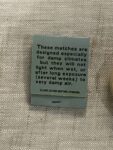
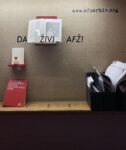
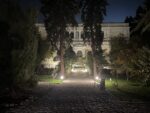
It’s dark, and I am standing in the botanical garden of the National Museum of Bosnia and Herzegovina in Sarajevo. It has been a sunny, cold day. Across the street from where I am standing is the US Embassy, a place whose politics will change in the next 24, or maybe 48 hours, depending on how close the election is. The embassy is measuring the air quality as part of the IQ Air network. The level of pollution is currently 122 on the AQI scale, meaning ‘unhealthy for sensitive groups’. The main pollutant contributing to this unhealthy air is PM2.5, the most deadly of the microscopic particles. In comparison, London’s air today is around 70-80.
It feels somewhat prescient that, on the day my home country is voting to elect (or not) a fascist leader, I have been conducting historical research on the Antifašistička Fronta Žena (AFŽ) at the nonprofit organisation and art space called Crvena. I learned about women’s efforts to organise between 1942-1953, largely around issues related to women’s working lives, their capacity to aid in the fight against fascism by taking up all manner of jobs, their need for labour recognition, their literacy, and childcare practices. As Andreja Dugandžić, co-director of Crvena explained to me, the term ‘feminism’ was not so popular at the time as it was seen as a bourgeois idea, but a ‘women’s antifascist front’ was a concrete and inspiring movement for many women in former Yugoslavia. I read magazines like ‘Nova Žena’, poems by women writers, and looked at prints and engravings. Some of it felt very contemporary - expressions of power and voice - while other parts would turn to the domestic, for example ‘how to treat diarrhoea in your baby’ or even an article on 'butchering chickens'. One article was called ‘čudno kuhinje’ (strange cooking) and I look forward to translating it to understand what kind of cooking the AFŽ thought to be strange! I wasn’t able to understand or read everything given my basic Croatian/Serbian /Bosnian, but I absorbed so many themes and images, it will take months to entirely unpack. I am left with the feeling of the Yugoslav women’s antifascist movement as a prideful one. I also felt something resonant between the thematics of the AFŽ and what I have come to understand as ‘cuerpo-territorio’ (body-land) in South American feminisms. Like cuerpo-territorio, the movement of AFŽ was about relations to land, as much as it was about anti-fascist struggle. Sharing some of the poems of 'Nova Žena' with my Mom, she immediately replied with the exclamation that she felt so much pride, like those women did, and that she also wrote poems as a teenager in Belgrade about the pride and struggle ('borba') of Yugoslavia. As I ride the tram back to the hotel, I think of my Mom, who now lives in the 'red state' of Florida, and I reflect, not without a lot of worry, about the political systems she has weathered in her life.
2024-11-05 07:32:33
Steve Engelmann
Pacific Palisades, California, United States
United States
NOAA-15
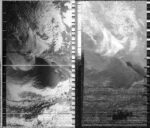
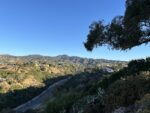
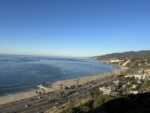
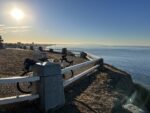
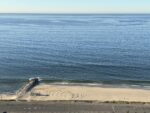
As the sun rises over the western US, the national election is in full swing. Regardless of the outcome, about half of the US adult population agrees with a candidate who thinks the climate crisis is a hoax played by the Chinese government. As president he pulled the US out of the Paris Accord and promises to resurrect the coal industry. Two days before the election he stated that the cool weather in Pennsylvania was "evidence". Looking out upon the calm Pacific Ocean hasn't done much to calm my nerves - yet.
2024-11-04 10:44:11
Sasha Engelmann
Roadside near Raðici, Bosnia and Herzegovina
Bosnia and Herzegovina
NOAA-18

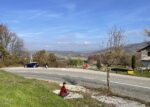
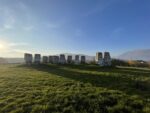
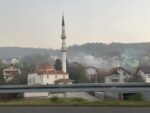
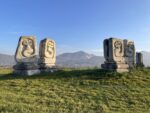
Turning off a narrow street, we climb a dirt road into hills of farmland. The smell of manure permeates the car as we pass farm equipment and local men that wave kindly at us. I think I hear one of them call out but he doesn’t follow us. The road winds steeply onward and turns against the edge of recently turned fields. Next to two stacks of hay, sandwiched between two different fields, both steaming with manure and dust, we can see curved shapes of stone. At the base of the hill, a plaque in an odd mix of Latin and Cyrillic letters, lines running at odd angles, seems like a warning, but we climb the hill anyway. We are completely alone except for two men driving tractors. There, on the hilltop, is a kind of assembly, a collection of surreal stone figures around two metres tall, arranged at odd angles to each other, resting on stone plinths. Like serpents with eyes or faces in contorted shapes the figures peer wildly and hauntingly into the distance. I notice there are rotting cobs of corn scattered on the grass in places, and I wonder if there are any offerings to these creatures. The site is Nekropola žrtvama fašizma (Necropolis for the Victims of Fascism) or Spomenik na Smrika (Monument on Smrike) designed by Bogdan Bogdanović and it is both monument and underground crypt. This is the site of a great massacre of around 700 Serbian civilians and communists by Ustaše forces during WWII. Of the monument, Bogdanović apparently said: “It is a story of mythical creatures: the ambisbaena is a two-headed serpent that goes by day in one direction and by night in another. It symbolizes the end of time." To me, though, the figures are less serpent-like and more like currents or energies.
Leaving Smrike by car, it is not long before we enter a valley shrouded in haze, and it only increases in density as we approach Sarajevo. We notice white smoke plumes pouring out of peoples’ chimneys and large currents of either steam or particulate flooding from thermo electric plants. I remember reading how a combination of local fuel burning in winter and heavy industry is creating an air pollution crisis in this part of Bosnia. The five o’ clock prayer echoes from minarets as the air thickens, spectral timing as voices mingle and seem to repeat across the landscape, and materialise the feeling that the air is a carrier of many things in these valleys, of faith and ghosts and microscopic toxicity.
I think about the double headed serpent invoked by Bogdanović and I wonder about the ‘end of time’. T and I both peer hard at the sky, wondering if we are seeing the sickle moon or a strange small arc in the sky. When the air is so thick and unbreathable, do we see and feel time passing more slowly, finding our circadian rhythms numbed, or do we see and feel what lies underground?
2024-11-03 10:29:57
Steve Engelmann
Red Rock Conservation Area, Nevada, United State, Nevada
United State, Nevada
NOAA-18

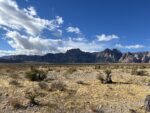
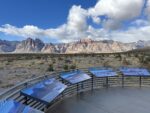
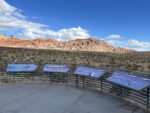
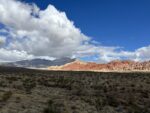
The Red Rock Conservation Area, just outside of Las Vegas, has been a work in progress for over 500 million years. It has seen oceans, sand dunes, the formation and dissolution of supercontinents, mass extinctions, indigenous peoples and more. Midway through the satellite capture sudden strong winds blew away my notes (later retrieved) and nearly capsized my laptop from a precarious railing (I should make better choices in the future). I was stabilizing my computer against the wind with one hand, tracking a satellite with the other and trying to convince some humanities academics from Chico State that the extraterrestrial I was following was benign - all in preparation for my audition at the 3-ring Circus. On the time log of Red Rock Canyon us humans will be nothing more than a minor footnote. What mark shall we leave on the geologic record?
2024-11-03 18:39:01
Sasha Engelmann
Petra Kočića Street, Banja Luka, Bosnia and Herzegovina
Bosnia and Herzegovina
NOAA-15

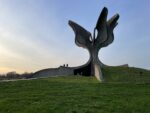
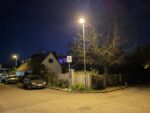
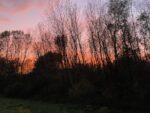
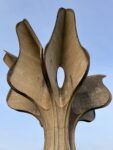
“Gdje je mala sreća, bljesak stakla, lastavičje gnjezdo, iz vrtića dah; gdje je kucaj zipke, što se makla, i na traku sunca zlatni kućni prah?” wrote Ivan Goran Kovačić in the poem Jama or ‘the pit’. It describes village life near the town of Jasenovac in modern day Croatia. In these lines, happiness flows through a ‘window’s glint’ and ‘windborne garden sweet’. It manifests ‘by the threshold, sunshine at my feet’. These lines evoke a bucolic, gentle, rural life. And yet the poem - immediately recognisable from these four lines by anyone borne in the Balkans - is far from a picture of happiness. It narrates what occurred at the town of Jasenovac after Axis forces invaded the Kingdom of Yugoslavia during WWII, and installed an Independent State of Croatia (NDH) ruled by the nationalist Ustaše militia. Jasenovac became the site of one of the deadliest forced labour and extermination camps of the war. What happened at the camp is disputed, but most evidence suggests that the majority of people imprisoned and executed at Jasenovac were ethnic-Serbs, largely civilians brought there for their collaboration with Partisan rebels. My grandfather, Deda Milan, was one of those anti-fascist Serbs brought to Jasenovac, but luckily he was released after my great grandmother, of Croatian / Hungarian heritage, managed to use her influence to save him. Roma, Jews, and political communists were also targeted. Kovačić’s poem goes on to narrate the horrors of Jasenovac in gruesome detail, and its power in communicating these scenes made it one of the most celebrated anti-war poems of its time. Most children educated in former Yugoslavia (and even, I learn at dinner in Banja Luka, in present day Croatia and Bosnia and Herzegovina) learn this poem in school. This context might help explain why the lines quoted at the beginning of this note - about happiness, gardens and sunny thresholds - are engraved in a plaque inside a large scale monument designed by Bogdan Bogdanović in the 1960s that now stands at the former centre of the Jasenovac camp. Its shape resembles a giant flower with six petals from some angles, but from others, it looks like a pair of wings. The edges of the petals are sharp, and diamond shaped holes allow the sky to shine through, against the heaviness of concrete. As I walked around it at sunset, its form seemed to transform, always asymmetrical. In the landscape around the monument, Bogdanović created mounds to denote the places where buildings of the camp used to stand. The monument was Bogdanović’s attempt to memorialise the history of civilian suffering without reproducing it, toward “termination of the inheritance of hatred that passes from generation to generation". To place lines of poetry depicting ‘sunny thresholds’ or ‘windblowne gardens’ at the heart of this monument is perhaps to use peaceful images - peaceful weathers - to break the ‘inheritance of hatred’ while recognising the importance of careful, watchful memory.
2024-11-02 08:10:31
Steve Engelmann
Las Vegas, Nevada, United States
United States
NOAA-15
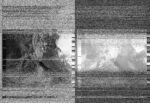
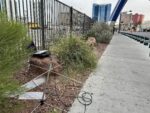
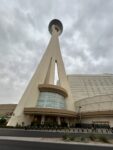
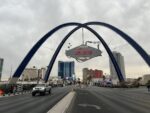
8am on a Saturday morning outside the Strat casino in Las Vegas is pretty quiet. Few cars, but a disheveled man with many tattoos asked me if I was communicating with aliens. When I told him I was receiving an image from a passing NOAA satellite, he seemed interested - but not enough for a conversation.
2024-11-02 11:41:15
Steve Engelmann
Near Nelson ghost town, Nevada, US, Nevada
US, Nevada
NOAA-18
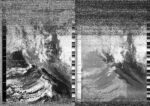
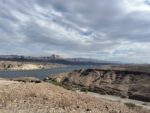
On my way to my nephew's wedding I pulled over near the Colorado River for a satellite capture. There has been controversy regarding who gets to use the Colorado River water. California has gotten the lion's share mostly, but the quantity has been declining for several decades and sometimes it doesn't reach Mexico. The best of plans get ruined when there isn't enough water. All the best wishes to Chris and Heather.
2024-11-01 12:01:36
Sasha Engelmann
Hackney Downs, London, United Kingdom
United Kingdom
NOAA-18
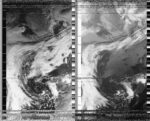
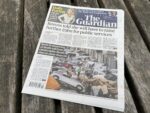


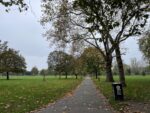
The reports of flash flooding in Valencia fill the front pages of newspapers in London. At lunchtime, the BBC shares the feed of a Spanish news network where a journalist breaks into tears while describing the losses of life, and damage to neighbourhoods. "The worst part..." he says in between attempts to catch his breath "is that our government knew that this was going to happen. They knew this was coming, and they did nothing". Hundreds of people are known to be dead, and some are still missing after days of search and rescue. "There is mud everywhere" an English reporter comments "on everything, on me". In London, the city is covered in low gray cloud, light barely penetrates through. On my way to mail one of the new open-weather automatic ground stations to northern Scotland, I pick up a copy of the Guardian and try to take a picture of its cover near a market on Mare Street in a way that also captures the lack of light, the gray mist, the way even important stories and images of loss seem slightly shadowed, out of focus.
2012-12-12 12:12:12
test 2
tes 2,
NOAA-19
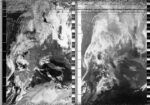
2012-12-12 12:12:12
test 1
test 1,
NOAA-19
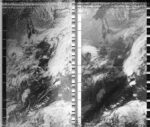
2000-01-01 00:00:00
test,
NOAA-19
2024-10-31 09:50:53
Sasha Engelmann
Hackney Downs, London, United Kingdom
United Kingdom
NOAA-19
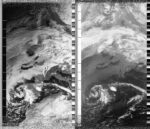
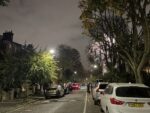
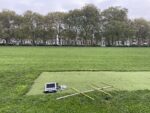
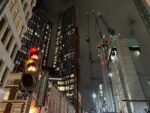
The humidity is 100% today. When T and I wake up, we see condensation on the living room and kitchen windows- as if the flat is sweating. Yet it is not warm, it is strangely cold. Later in the morning, I find myself getting anxious at the amount of assessments I have to review for an external examiner appointment at another university, and for which I need to synthesise feedback to the whole department by the end of tomorrow. To calm down, I spend twelve minutes on the couch after lunch meditating with the help of an app. This meditation is called 'Sense' and at several points, the guiding voices says 'There's no need to go out looking for sounds. Just like a satellite dish, we can simply receive what's coming'. I find myself puzzling at this metaphor while the meditation continues, so much so that I realise I am not following the instructions anymore. Does a satellite dish 'simply receive what's coming'? And is the body anything like a satellite dish? I remember the meditation Soph invented for their students in Eindhoven, called 'Your body is an antenna'. I have always loved this meditation, and find that it makes sense- an antenna can just exist, and it can pick up a wide ranging but also environmentally limited amount of information around. A satellite dish, on the other hand, feels intent on capture, on picking up a television signal. Later in the day, after I have made some headway through the external examining, my body antenna feels less tense, more open. Outside I can hear the beginnings of Halloween, as mobs of small children spill out of houses and make small shrieks of excitement on their way down the street.
2024-10-28 11:11:12
Sasha Engelmann
Between Biology and Physics departments, Royal Holloway University of London , United Kingdom
United Kingdom
NOAA-18

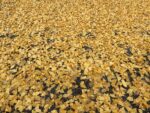
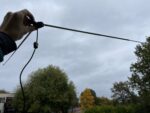
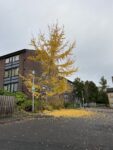
The Ginko trees make pools of yellow everywhere on campus, from the parking lots behind student dorms, to the small copses between departments. As the day is grey lit and damp, and Heathrow borne planes roar past overhead, invisible through the cloud, the pools of colour are welcome.
Later in the afternoon, Soph and I compare 'lighting gell' colours on a role of about 200 samples, ranging from fluorescent magenta to eggshell yellow. The colours come with short descriptions of their intensities and transparencies. Soph asks me to hold up the small rectangular transparent samples against a black and white photograph in a book on my desk, the better to compare how the colour enhances or mutes the detail in the image. It is difficult to make a choice of colour when only one of us can actually see the physical 'gell'. We end up choosing a green called 'half plus green', which is a more transparent version of a green called 'plus green'. Hovering between a bright green and a lemony mint, and around 80% transparent, the green film adds a beautiful intensity to grayscale text and imagery.
As I leave campus at 5:30 it is almost pitch black. Students in hooded sweaters walk past in small groups, dorm kitchens are brightly illuminated, and rows of liquor bottles balance precariously on window ledges. As I pass the parking lot into the deep dark of the woods at the bottom of campus, a Ginko leaf catches my attention- it is fanned out against the asphalt, an opaque yellow through which dark textures permeate.
2024-10-27 11:23:20
Sasha Engelmann
Hackney Downs, London, United Kingdom
United Kingdom
NOAA-18
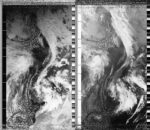
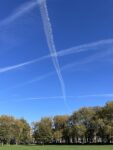
I awoke to a creeping feeling that the plants in my and T's flat were feeling very happy today. Leaves of monstera deliciosa, begonia maculata and weeping willow seemed unusually vibrant and springy from their stems. The lower angle of the sun at this point in the autumn means that the flat is flooded with rays. Throughout the morning, the sun climbed slowly over the three-story houses and the 'Open Doors' Baptist Church directly opposite our second floor windows. Later in the park, a local young family and a couple of mid-20s french women asked about my antenna, and I got to explain the 'magic' of radio twice. It was so bright I had to squint to see their faces. Above, an intersecting set of contrails looked like another, much larger Yagi-Uda, pointing south.
2024-10-27 10:35:55
Steve Engelmann
Pacific Palisades, California, United States
United States
NOAA-19
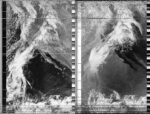
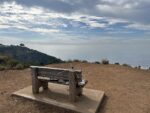
In a late morning pass overlooking the Pacific from some neighborhood bluffs. A thin layer of stratocumulus clouds add a calming effect to the Fall and a little more than a week before the US election. Hardly a mention of the climate crisis amid fictitious tales about Haitian immigrants and praise of Nazi generals. Crossing my fingers for a favorable forecast.
2024-10-26 12:36:11
Sasha Engelmann
Hackney Downs, London, United Kingdom
United Kingdom
NOAA-18
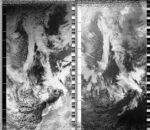
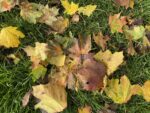
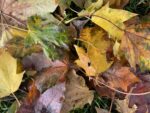
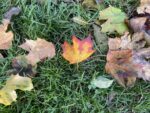
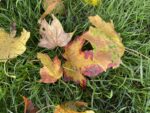
The fallen brown and golden leaves from plane trees are the brightest thing in the park today, as a grey and muted bank of cloud wraps London. I keep thinking of an interview I read with Stefan Rahmstorf, an oceanographer and climatologist who is well known for studying 'Amoc' or what is now known as 'Amoc breakdown'. The article in the Guardian explains: "Amoc, or the Atlantic meridional overturning circulation, is a system of ocean currents that brings heat into the northern Atlantic. Warm surface water from the tropics flows north and releases its heat in the subpolar Atlantic, south of Greenland and west of Britan and Ireland. Then it cools and sinks to a depth between 2,000m to 3,000 m before returning south as a cold current. Amoc is one of our planet's largest heat transport systems, moving the equivalent of 50 times the human energy use, and it has a particularly strong impact on the climate in Europe".
This description of great waters rising and sinking, and carrying heat across the planet, is captivating. Yet scientists like Rahmstorf suspect Amoc could be slowing down and even about to stop. Apparently "the most ominous sign is the cold blob over the northern Atlantic. The region is the only place in the world that has cooled in the past 20 years or so, while everywhere else on the planet has warmed - a sign of reduced heat transport into the region". There is also "excessive heating along the east coast of North America" which could be another sign of a slowing Amoc current that drifts closer to shore, and the "reduction of salt content of seawater" especially in the "blob region". A less salty 'blob' is harder to sink, and therefore harder to mix into the Amoc cycle. According to Rahmstorf, there is a 50/50 chance that Amoc stops in our current century. The collapse of Amoc will have global effects: the sea level of the Atlantic will rise by half a metre, the tropical rainfall belt will shift south, leading to floods in places not adapted to so much rain, and droughts elsewhere, and less CO2 would be taken up by the oceans, further driving global warming. Rahmstorf explains that all of these changes are poorly modelled by scientists and reported on by the IPCC because they are considered extreme, but at the same time they are probable, and on a timescale that humans alive today may witness.
As the satellite image I am capturing loads line by line, I peer into the darkness of the North Atlantic. I think about the word 'Amoc' and how it can also have connotations of 'going astray' or 'running wild'. I wonder whether I can see the 'cold blob' west of Ireland, and what one might see in that part of the ocean in decades to come.
2024-10-24 11:24:20
Sasha Engelmann
Millfields Park, London , United Kingdom
United Kingdom
NOAA-18

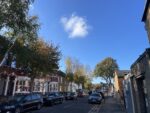
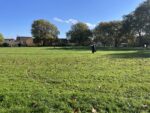
A black cloaked, elderly woman steps slowly across the dense, wet grass of Millfields Park in East London. I worry about her feet getting wet, as mine have soaked through already. Though it is nearing 12 noon, the sun casts long shadows against the plane trees, shapes forming and rearranging on the ground.
2024-10-22 11:14:35
Sasha Engelmann
London Bridge, London , United Kingdom
United Kingdom
NOAA-19
2024-10-23 10:50:16
Sasha Engelmann
Eastfield Grass Pitch, Royal Holloway University of London , United Kingdom
United Kingdom
NOAA-19
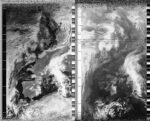
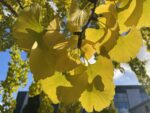

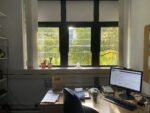
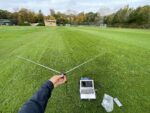
The department is hosting an 'authors meets critics' session with Henry Wai-Chun Yeung, an eminent economic and human geographer from Singapore, and I am on a panel of respondents. Henry's book is called Theory and Explanation in Geography, and it synthesises vast literatures in the discipline informed by theories such as non-representational theory, actor network theory, assemblage and feminist and postcolonial theories. As I need to formulate something to say, I spend the morning and most of the afternoon buried in this book, thinking about Henry's proposals for theorising. In one chapter, Henry proposes that 'relational' theories in geography need more concreteness, focus on causation, and specificity, so that they can better explain the world. He advocates for what he calls relational ‘geometries’ or ‘relational specificity’ or ‘relational complementarity’. An example of relational geometries is regional union networks and their ways of complementing each other, to gain power and resources. The response I decide to give reflects on what a specific focus on the geometry of relation might do - how does it operate? What does it explain?
I have recently been puzzling over the geometry of relations in a paper on the ‘aerial turn’ in geography - I have been observing how, for quite a while now, geographers participating in the ‘aerial turn’ are writing about air in three key modes: i) as something that flows or can be traced, most often on a line ii) as a collection of particles iii) and as a volume. Although these three ‘orientations’ to air are persuasive, and in many ways helpfully explanatory for all kinds of aerial processes, from atmospheric warfare to the relations between breathing bodies and spaces, they produce versions of air and atmosphere that are linear, particular, and volumetric, and they distance other ‘versions’ of air that are more difficult to draw into geometric forms or shapes. I have been wondering how the ‘aerial turn’ is thus reproducing spatial geometries that say more about disciplinary formalism and perhaps modernist aesthetics than anything about air itself.
Geographies of air are indeed a very small part of the discipline, but in my hesitation around the ‘relational geometries’ in Henry's book, I wonder if there is something else going on here. I wondered if the proposal to adopt ‘geometries’ felt at odds with the ‘relational irresolutions’ ‘topologies’ and disorientations being developed and theorised for studies of infrastructure by people like Jerry Zee and Aya Nassar. I think also about the outpouring of work on quantum field theory and quantum mechanics in black studies and geographies, for example in new work by Pat Noxolo, and I think it is important to take seriously what a turn to the quantum does in this work, that geometry simply can’t. As important as it is to be specific and practical about spatial relations and how our theories of relation can explain causal effects, I feel that these and other movements in the discipline suggest plural, capacious, perhaps less immediately geometric forms of relation, and yet they are doing so without the vagueness or flattening that might have characterised relational theories of ten-twenty years ago.
For the seminar, the room is packed- geographers from across the department are present, as well as people from other departments. Henry gives a presentation on the book and I am impressed with the way he manages to make theory sound exciting and approachable. After me and three of my colleagues have offered responses, we discuss what it means for goegraphers to 'do theory', what kind of theory that might be, and whether the issue is rather than geography is both a social science and a humanities discipline- theory works differently and does not necessarily need to 'explain' in the humanities, as it might do in the social sciences. After the event, the atmosphere of the department is animated. A PhD student comes to my office and speaks for thirty minutes about how excited she was by the seminar. From time to time, I catch a glimpse of the ginko trees outside the window of my office. The golden leaves are glowing in the afternoon sunlight, so that they seem to be projecting light in all directions.
2024-10-21 11:15:17
Sasha Engelmann
Canada Copse, Royal Holloway University of London, United Kingdom
United Kingdom
NOAA-19
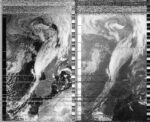
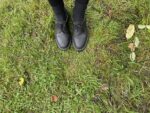
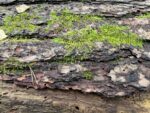
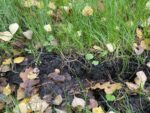
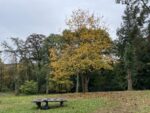
"Late nights in black silk in East London / Church bells in the distance / Free bleeding in the autumn rain / Fall in love again and again" sings Caroline Polachek in a somewhat cheesy but also beautiful remix of the Charli XCX song 'Everything is romantic'. The song has been circling around in my head for several days, and I hear it when I leave my flat in the dark at 6:30am this morning, spotting the waning moon in a fuzzy glow above. A tank truck rolls slowly along the edge of the park. A man in a high viz jumpsuit is walking ahead of it, using a pressurised hose to blast aside the golden leaves that paper the asphalt in wet layers. In the early morning moonlight, they look like a chimera - half machine, half person. Though Storm Ashley has not affected the southeast of England, the world feels soaked with water- a ubiquitous saturation.
2023-08-20 08:34:30
Steve Engelmann
Pacific Palisades, California, United States
United States
NOAA-15
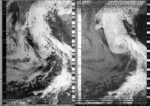
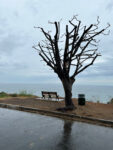
Standing on the bluffs overlooking the Pacific Ocean you could feel the anticipation. Light rain had started and the winds of the incoming storm were beginning. Over 50 years I have spent many hours looking out, working through dilemmas, contemplating, searching for perspective. Today was like no other. Hilary had been down graded to a tropical storm by the morning. She tracked east of Los Angeles and ended up closing down Death Valley with historic floods.
2024-08-01 12:24:05
Steve Engelmann
Geneva, New York, United States
United States
NOAA-18
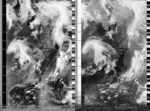
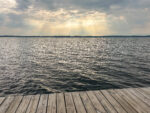
Cloudy with spots of sunlight breaking through. Potential for thunderstorms later in the day. Pleasant view across Seneca Lake.
2024-10-19 12:29:47
Sasha Engelmann
Downs Road, London, United Kingdom
United Kingdom
NOAA-18

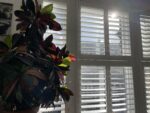
The sunlight stretches through the shutters as I prepare a roast vegetable and fish lunch for T and her mom who are on their way back from the airport. I mix purple carrots, magenta-striped beets and lightly gold potatoes with extra virgin olive oil and a mix of spices and herbs - a medley of oregano, peppers, sage and other 'bilke' from my grandmother's village on the island Hvar in Croatia. When the vegetables have roasted, I place three marinated 'John Dory' fish on top of everthing and keep the oven hot for another twenty minutes. As I cut, season and roast, my turnstile antenna leans out the kitchen window. My hands are too oily to hold or point it, so the resulting image is just what the antenna receives from its resting position. At one point, though, I graze the handle with the dishwasher door, and the whole antenna slips out the window and dangles on its cable over the edge- luckily there is a small ledge immediately underneath, otherwise it might have fallen to the steps below!
2024-10-18 12:36:47
Sasha Engelmann
Hackney Downs, London, United Kingdom
United Kingdom
NOAA-18
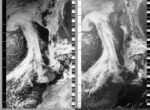
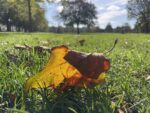
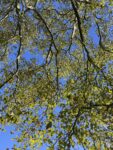
The day started with low, misty clouds and rose to a golden, clear-skied afternoon. The last few days have been much warmer, even balmy. I noticed the transparency of fallen leaves, shining like small lanterns in the grass.
2024-10-15 13:15:53
Sasha Engelmann
Hackney Downs, London, United Kingdom
United Kingdom
NOAA-18
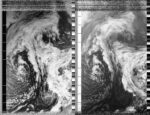
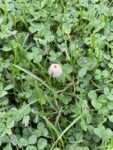
"You might find me with some tims on, rockin fascinators and clutches / marchin' through these streets my face on double decker buses / London's been all love, from the dancehall to the pub / when we play the O2, or back when subterranea was the club / real Fugees lovers / big up you know them, all my sisters and my brothers!!" spoke Lauryn Hill, reading a poem she had written in the twenty four hours before her performance at the O2 Arena last night. T and I were in seats so far away, on the opposite side of the stadium, that the sound seemed to bounce and refract in odd echoes. But that didn't matter- squeezed into tiny steep seats, all 20,000 people were dancing the whole night. I looked over my shoulder to see several grey-haired ladies singing all the words, while below our row, a group of teenagers managed to dance and livestream at the same time. This morning the energy stayed with me as I got ready for the day, another grey and cold one in London. The park was full of dogs, including an incredibly fast whippet named Ziggy. In several places, the gilled cap of a small mushroom pushed through the blades of damp, freshly mowed grass.
2024-10-14 11:49:15
Sasha Engelmann
Picnic table near Bourne Building, Royal Holloway University of London, United Kingdom
United Kingdom
NOAA-18

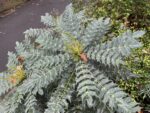
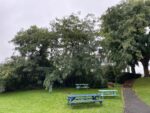
Arctic air, icey wind and a cold drizzle- a combination that makes any Monday morning feel especially gloomy. I take shelter under a small tree on a field between the biology and physics departments on the university campus. Part of me questions my decision to even try to catch a satelltie image, as the pass is only 50 degrees at maximum elevation to the west, and it's so freezing outside. I hum Lauryn Hill lyrics to myself as the satellite image loads, the pixels looking fractal like ice. "Possibly speak tongues / Beat drum, Abyssinian, street Baptist / Rap this in fine linen / From the beginning / My practice extending across the atlas / I begat this". The 'atlas' on my screen builds southward, tendrils of cloud extending in blurry motions, like something moving too fast before it can be captured, stilled. Every so often the tree is pushed by the wind and fat droplets shower down. The song ends: "Everything is everything / What is meant to be, will be / After winter, must come spring / Change, it comes eventually".
2024-07-30 08:46:30
Steve Engelmann
Geneva, New York, United States
United States
NOAA-15
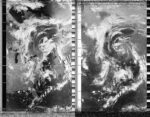
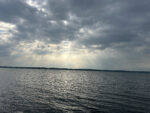
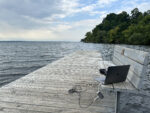
From the docks of William and Hobart Smith Colleges in Geneva, New York the weather was humid, but pleasant, from the shores of Seneca Lake. Powerful thunderstorms were developing for later in the day.
2024-10-13 11:14:35
Sasha Engelmann
Hackney Downs, London, United Kingdom
United Kingdom
NOAA-19
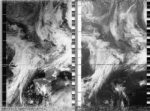
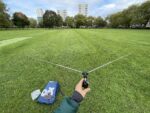
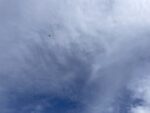
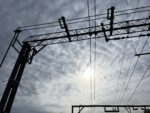
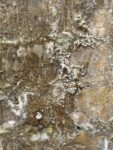
As I ride the 35 south from Liverpool Street the sun begins to pierce through the matted, slightly hazy sky. A current of ‘Arctic Air’ has flowed across the U.K. this weekend and lowered temperatures at least six degrees. At a performance yesterday afternoon in a roofless Anglican Church in Nunhead Cemetary, the cold entered deep into my lungs and bones. After an evening at the pub, T and I ran to the overground station and realised we had fifteen minutes to wait for the train - it felt like an interminable time in that level of cold. As we entered Tesco to warm up before the train, an older man sitting on the pavement near the streetcorner lost his paper cup in the wind and it spun into the traffic. After I retrieved it for him, he asked if I could buy him a chocolate milkshake. He drank the cold drink in big gulps as me and T ran back to the station for our train.
2024-10-11 12:24:58
Sasha Engelmann
Hackney Downs, London,
NOAA-18
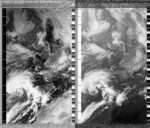
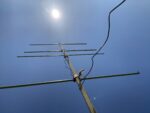
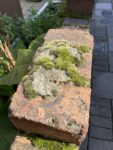
Of a day like today, Derek Jarman might write, "Crystalline sunlight, all the dark humours blown away by the wind" (1991, 235). As my partner opens the curtains in the morning, the blue of the sky pierces through the growing gaps in tree branches, blue against yellow and light brown. Before lunch I set the automatic ground station up in my flat, leaving the turnstile antenna resting against the open windowsill in the kitchen, and I head out to the park wtih my tape measure Yagi-Uda antenna. Later I enjoy comparing the images: not surprisingly, the automatic station has captured a swathe of the satellite pass to the south (as our kitchen window is south-facing) and lines of interference from the building pulse through it. Out in the park, I receive a good signal for most of the 86 degree pass, enjoying the 'crystalline' sun and the momentary break from the 'dark humours' of recent grey and rainy days.
2024-10-10 12:37:28
Sasha Engelmann
Hackney Downs, London, United Kingdom
United Kingdom
NOAA-18
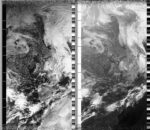
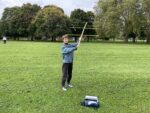
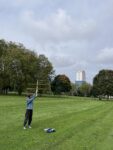
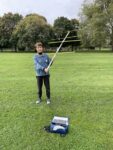
Representative Michele Rayner, Democratic Florida State representative calls in to Democracy Now. As the sun rises on a night that saw the landfall of Hurricane Milton, she describes the situation in St Petersburg, Florida, where there is no power, where there has been large amounts of flooding, 120 mhp winds and failures to infrastucture, including cranes collapsing into buildings. "I don't even know what my own home looks like right now" she says, "I can't get there". She describes gridlock on the highways and price gouging of hotels, flights and Airbnb accommodation in safer areas of the state. Her voice breaks up and the 'call dropping' sound happens several times. Amy asks her about the misinformation being propagated about the government withholding FEMA funding, or government officials taking peoples homes, and even that the US government is 'controlling the weather'. These are lies with life and death consequences, Amy comments. It is possible to hear Rayner say "people have lost so much... people need help" before the call drops again. Meanwhile videos of trees propelled sideways, people walking through knee deep water, and couches floating down sidewalks rolls on the screen.
2024-10-09 12:50:19
Sasha Engelmann
Hackney Downs, London, United Kingdom
United Kingdom
NOAA-18
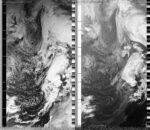



"Even though it looks beautiful, this is very bad, this will cause a lot of damage" says a forecaster of Hurricane Milton in one of many livestreamed weather reports I consult throughout the day. He repeats this phrase several times, as if he has to convince himself that it is true. Yet he still calls Milton 'healthy' as he describes its current trajectory and form. I learn that Milton has an 'eye' or 'core' that is among the smallest ever recorded - only about 4 miles across - and this is one of the reasons its effects could be so devastating. Another forecaster uses the metaphor of an ice skater doing a spin and hugging their arms closer to their body, therefore spinning faster. A very different set of affects was offered by John Morales, a Puerto-Rico raised, Florida-based meteorologist and weather forecaster for 30+ years, who became emotional on live television yesterday while describing the fact that the pressure in Hurricane Milton had dropped 50 millibars in ten hours. Morales takes a deep, shaky breath and continues 'this is just horrific'. The video circulates widely on social media. As the hurricane moves north, its proximity to the jet stream will cause wind shear, and some of its 'arms' will 'tear to shreds' according to another newscaster. The storm will likely downgrade to a level 3 hurricane by the time it meets land. But this does not mean it will be weaker or cause less damage, as the weaker storm-system will become wider, potentially affecting much more of Florida. The jet stream will not remove enough 'arms' to reduce the storm's strength. The site of landfall remains uncertain, with some forecasts suggesting the beach of Tampa, where the consequences in terms of storm surge and infrastructure would be catastrophic, while others suggesting it may land further south. It is both fascinating and terrifying that less than twelve hours away from 'landing', the landing-site is still unknown. To follow Milton in all of these ways is thus to process an extreme set of affects, prognoses, visualisations and predictions - everything from figure skater metaphors to public displays of despair. I make a special trip to the park for a satellite pass that is quite far to the west of London, over the Atlantic. I try to stabilise my experience of Milton by 'seeing' some of the weather in its proximity, the cloud systems and extra-tropical cyclones that are somehow linked to Milton's energetic core.
2024-10-06 11:02:38
Sasha Engelmann
London Bridge, London, United Kingdom
United Kingdom
NOAA-19

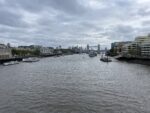
On London Bridge, loosely knit groups of people wander by. I notice two families in which the Dad is pointing across the Thames to skyscrapers and offering some words of information or wisdom to his children. They don’t look interested. It’s the kids instead who are interested in me, asking ‘but what is she doing ??’ in voices that implore an answer. A tall man passes very close to my left shoulder and says in passing ‘watch out with that thing’ even though I am standing well to the edge of the bridge and there is tons of empty space to walk. The pass is a bit staticy at times but I have come to expect this from most of London’s bridges - too much happening by land, river and air.
2024-10-05 12:01:49
Sasha Engelmann
Hackney Downs, London, United Kingdom
United Kingdom
NOAA-18
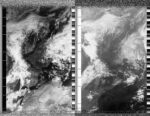



Today is October 5th, and a national protest for Palestine solidarity in London is underway, slowly moving from Russell Square to Downing Street. Many posters and banners point to the fact that the genocide in Palestine has been going on for one year. There are photographs of victims, messages to Netanyahu and Kier Starmer, and demands for reckoning. Chilling, however, are attempts in the wider media to memorialise this moment in ways that justify Israel's ongoing agression Gaza and Lebanon. Naomi Klein writes in the Guardian today: "What is the line between... memorialization and weaponization? What does it mean to perform collective grief when the collective is not universal, but rather tightly bound by ethnicity? And what does it mean to do so while Israel actively produces more grief on an unfathomable scale, detonating entire apartment blocks in Beirut, inventing new methods of remote-controlled maiming, and sending more than a million Lebanese people fleeing for their lives, even as its pummeling of Gaza continues unabated?" In light of this, the protest feels like more than a public demonstration- it is also a collective remembering, a coherence of what we remember.
2024-10-03 12:30:08
Sasha Engelmann
Finsbury Square, London, United Kingdom
United Kingdom
NOAA-18
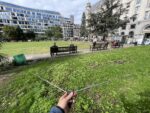
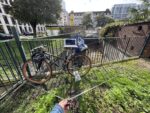
It is a relatively warm and mild day in London, and people pour out into the streets at lunchtime as I set up for the satellite pass. Yet I am thinking about the wind and it's relationship, provocation (?) or resonance with memory. Writing from the depths of February in Dungeness, Derek Jarman is listening to the wind, observing: "Fragments of memory eddy past and are lost in the dark". The wind is blowing "high in the tower blocks and steeples, down along the river, invading houses and mansions..." He continues: "But the wind does not stop for my thoughts. It whips across the flooded gravel pits drumming up waves on their waters that glint hard and metallic in the night, over the shingle, rustling the dead gorse and skeletal bugloss, running in rivulets through the parched grass - while I sit here in the dark holding a candle that throws my divided shadow across the room and gathers my thoughts to the flame like moths. I have not moved for many hours. Years, a lifetime, eddy past: one, two, three: into the early hours, the clock chimes. The wind is singing now".
2024-09-29 10:46:38
Sasha Engelmann
Hackney Downs, London, United Kingdom
United Kingdom
NOAA-19
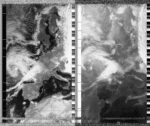
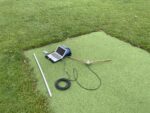
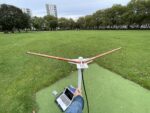
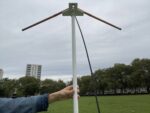
Today we put on the heating in our flat for the first time this autumn. The air temperature has dropped significantly over the last week, and there is an 'edge' or 'bite' to the weather outside. At dinner on Friday night with a very good friend, we all agreed to change our duvets to the heavier 'winter' version. This collective decision made me think of squirrels and other forest creatures adding leaves and twigs to their nests for warmth. I tested a new antenna in the frosty park this morning - a copper, weatherised V-dipole made by a radio amateur supplier in Florida. I used a PVC pipe given to me by Martin Collett (for another tape measure Yagi) to elevate the antenna above ground level, as if on a small mast. A woman walking two chihuahuas smiled at me. A small cyclone of clouds emerged, swirling over the UK, but hopefully leaving some space for bursts of sun over the rest of the day.
2024-09-27 10:22:22
Alabama, United States
United States
NOAA-19
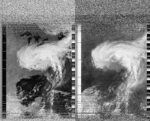
2024-09-26 12:13:45
Sasha Engelmann
Downs Road, London, United Kingdom
United Kingdom
NOAA-18

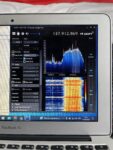
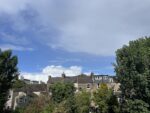

A rolling family of storms passed over Hackney today - one body after the next. Alternating floods of sunlight and dark shadows passed through the flat, a changing scenography to breakfast, PhD student supervisions and emails. As it was pouring when I planned to head to the park with my Yagi, I instead tried fitting the antenna out of the bedroom window - more difficult than the compact V-dipole or tunstile antennas I've used inside before. It worked somewhat- both detecting the 'flood' of Meteor MN 2-3 before picking up NOAA-18 - though I think it also proved sensitive to lots of interference coming from flats and the building itself. By the end of the pass the sun was shining and an orb-like cloud receded into the distance.
2024-09-21 19:16:12
Sheepy coco
Imperial California , Imperial county
Imperial county
NOAA-15

2024-09-20 11:07:14
Melody Matin
Toronto (High Park), Canada
Canada
NOAA-19
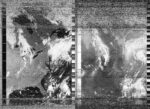

2024-09-19 12:10:06
Melody Matin
Toronto (High Park), Canada
Canada
NOAA-18


2024-09-19 11:19:56
Melody Matin
Toronto (High Park), Canada
Canada
NOAA-19
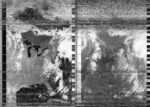
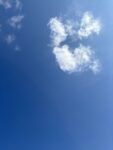
2024-04-14 22:23:46
Soph Dyer
Augarten, Wien, Austria
Austria
NOAA-18

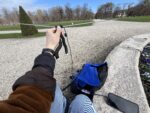
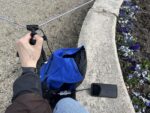
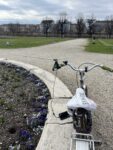
The wind has been squally, like my body. I woke tired. To reclaim my body, I swim one kilometre at the local pool. The full sensory experience of swimming focuses me on breath and rhythm, in ways other sport cannot. I feel my muscles and enjoy imagining the small exercised-induced testosterone boost. I feel back inside my body, home.
2024-06-25 12:36:45
Soph Dyer
Augarten, Wien, Vienna
Vienna
NOAA-18
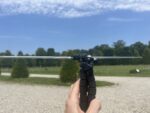
I thought that I'd overheat but cloud came between me and the sun. It's hot, but not too hot, and the heat is dry. I feel more at peace in my body today. I know that I need to listen to it and respect its limits while it heals. The city building's are no longer cooler inside than out. I am trying to be productive, get work done, but really I want to be lying flat on my bed or dipping in the cool waters of the Danube. How are you Sasha?
2024-06-14 11:36:59
Soph Dyer, Nicola Locatelli
Stefy & C. Market Di Gallizia S. e Valent S. Snc, Moggio di Sotto, Italy
Italy
NOAA-18

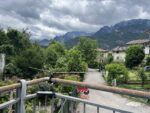
I cannot focus on the meteorological weather as a delivery truck arrives to unload at the supermarket, which carefully crop out of shot. In the moment irritated the moment, but later accept my foolishness of my desire to document the mountains without people, cars and the heavy industry that lines the Fiume Fella river valley.
2024-06-12 20:04:12
Soph Dyer
Dordolla, Italy
Italy
NOAA-15

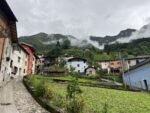
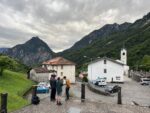
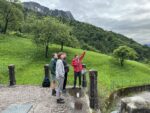
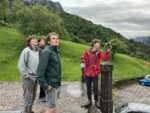
A musician, Pietro, joins us for the satellite pass. The alpine village of Dordolla is so small, we just needed to walk around for word to get to Pietro that we were at the only bar. There is a light drizzle. N makes a beat to the sound of the satellite, tapping the puddle with his foot. Pietro makes a sound recording. He is a drummer. The air is thick with moisture. The energy of yesterday's electrical storm has dissipated, but the clouds have not broken yet.
2024-06-14 21:53:37
Soph Dyer
Tiere Viere, Dordolla, Italy
Italy
NOAA-19

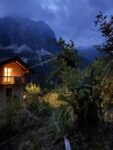
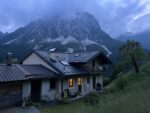
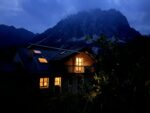
The sky is meeting the mountain. Fair weather, finally. Rain was forecast but did not come. The air smells good. It is a crisp, clear night.
2024-06-16 22:39:42
Soph Dyer
At home, Wien, Austria
Austria
NOAA-18

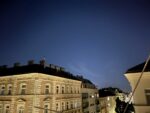
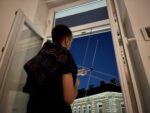
The tat tat tat of toy machine gun drifts up from the otherwise empty street.
It is warm, comfortable.
When we got home from the holiday the tomato plants were stressed from thirst and had curled their leaves from prevent water loss.
After visiting such radically different climates – the dry heat of Istria and the wet cold of Firuli – and after overhearing my sister swap farming anecdotes of a too wet, too cold spring-summer with our host in the agriturismo, I contemplate how local climate is is and the importance of grounding theories of weather knowledge in specific sites.
2024-06-17 12:37:54
Soph Dyer
At home, Wien, Austria
Austria
NOAA-18

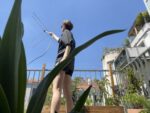
I rush out between Zooms calls to receive this satellite image on the balcony. The weather is warm dry, my mood is light, even joyful. I prop the my phone up on a potted Yuca, so as to get the tomato plants in the frame.
2024-06-18 12:23:59
Soph Dyer
Augarten, Wien, Austria
Austria
NOAA-18
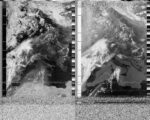
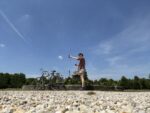
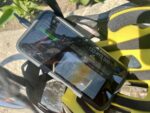
It's heating up. I enjoy how the city radiates heat from all directions, loosening my muscles. I embrace the floppy feeling. Yet Vienna is not yet built for sustained summer heat. Its surfaces are mostly sealed, there is too little vegetation, and it does not cool-off enough at night.
I am standing in the blazing midday with sun cream and sun glasses but no hat. I am still learning how to live in a country that is a little hotter, a little drier than the North of England where I grew up. A group of young school children pass, all wearing matching caps. I take note. Buy a cap. During the satellite pass I try turning on a feature of the software defined radio programme called Automatic Gain Control or AGC for short. Gain is a property of the antenna, which can be manipulated in the software … and this still confuses me. Usually, I use the programme's waterfall display to manually adjust the gain, however today, keen to improve my understanding of gain and the software, I experiment with turning the two AGC functions on and off, and then both on at the same time. The waterfall display turns from blue to yellow to red. To my ears, the signal to noise ratio sounds worse, however the resulting image looks surprisingly uniform. In my studio, M, shares with me a weather forecast from the ORF, Austria's national public broadcaster. She wants me to know that Saharan Dust is forecast for Friday.
2024-09-17 10:58:00
Soph Dyer
On a train and in my bed, Between Czechia and Austria
Between Czechia and Austria
NOAA-19

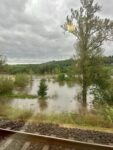
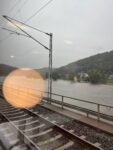
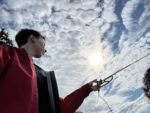
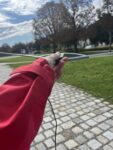
I wake groggy from the late arrival of my flood delayed train. Out of habit, I open my phone. Brown water fills the screen, punctured by branches, buildings and the fluorescent jackets of emergency workers. I read a quote from the climate scientist, Sonia Seneviratne, saying that "most of the water vapour came from the Black Sea and Mediterranean Sea, both of which have grown hotter as a result of human-induced climate breakdown". I share the article in our Signal group. Our intern, LJ, replies that this is a "vivid image". I agree, picturing the Mediterranean falling onto Vienna, in an inversion of sky and sea. It is a literal image of our world turning upside down.
2024-09-14 12:22:00
Lotti Jones
Leipzig, Germany
Germany
NOAA-18


It felt magical when a bright-green signal began to cascade down the waterfall display. I turned to Heide, my partner in our Leipzig open-weather workshop, who was next to me. We both made excited, eyebrow-raised faces. Were we imagining things? Was everything set up right? Our laptops responded with reassuring rhythmic tick-tocking and high pitched sounds that danced around our ears. I was surprised how the satellite continued talking with me, even as I played with different heights of the v-dipole antenna and the wild wind whirled around us. Ten minutes passed quickly. Soon I was angling southwards, feeling the radiant sun on my face and seeing other workshop people communing with NOAA-18 across the park while it faded into static.
2024-09-14 12:23:54
Ani
Leipzig, Germany
Germany
NOAA-18
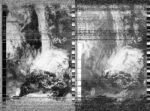
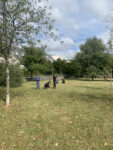
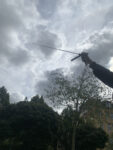
Here: Warm sun, grey skies. Just south of here: Extreme weather events all over Central Europe.
2024-09-14 12:22:00
Florian & Hanna
Leipzig (West), Germany
Germany
NOAA-18

A cloudy and windy day with some sun coming through the clouds. One of the first colder days after summer.
2024-09-14 12:22:00
Constanze Müller
Leipzig, Deutschland
Deutschland
NOAA-18
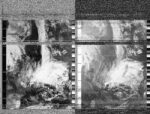
2024-09-11 11:08:41
Sasha Engelmann
Burgess Park, London, United Kingdom
United Kingdom
NOAA-19
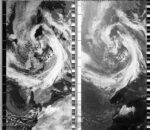
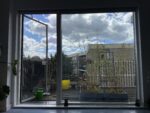
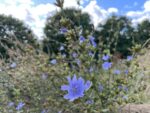
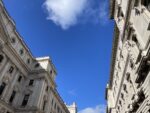
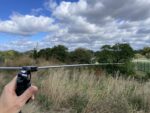
Grazie! Grazie! T and I pronounced our happiness at the blue sky when we woke up this morning. The blue is a deep cerulean and small cottonball clouds dotted the horizon. As we ate breakfast we watched the debate between Kamala Harris and Donald Trump that had aired last night in the US, and within minutes my heart raced and my stomach spiralled. Phrases like ‘illegal transgender aliens’ and ‘killing babies at the seventh, eighth and ninth month’ and ‘immigrants eating dogs’ were spat out of Trump’s mouth. I was reminded of a scene in Leslie Marmon Silko’s book Ceremony that depicts a group of evil ‘witches’ from different Native American tribes at a witch ‘conference’ in a cave. Most witches in the room show their power by donning animal skins and making terrifying performances, but one witch claims their power lies in telling a story, and that as they tell it, the story will already begin happening. They begin telling a tale about dark forces releasing energies into the world and this energy arriving in North America in the form of white people who bring weapons, diseases and greed. In other words, white Europeans are figured as the shapes or shadows of the darker evil at work, but in the story they do wreak havoc. The other witches complement the storytelling witch on their power but say they would prefer this story to not unfold - they ask to call the story back. But the witch says it can’t be done, it is already unravelling. As I listened to some of Trump’s language - the crude and demonic shapes he was conjuring - I couldn’t help think of the power of stories, even if they are neither true or realistic. Something is released when these figures or shapes are vocalised. I do not want to give Trump the credit afforded to the storytelling witch in Silko's novel. I do want to think more about the power of plot, story, and fiction in creating the 'capitalist sorcery' (to use a Stengerian phrase) that we are experiencing in great intensity before the current election.
2024-09-10 12:24:00
Melody Matin
Toronto (High Park), Canada
Canada
NOAA-18
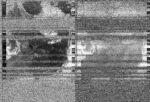

2024-09-10 11:33:04
Melody Matin
Toronto (High Park), Canada
Canada
NOAA-19


2024-09-10 12:14:14
Sasha Engelmann
Hackney Downs, London, United Kingdom
United Kingdom
NOAA-18
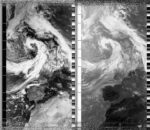

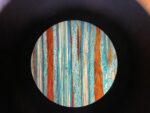
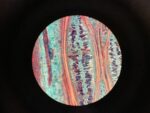
This morning a PhD student wrote in an email to me that the "Autumn very much feels like it's arrived!". I agree wholeheartedly- and wonder how many days have gone by without the golden sunlight I have come to expect from London in early September. Instead we are soaked in thin, grey and matte light emitted from low-hanging cloud. As I read onward about 'global darkening' and the 'State of the Climate' as assessed by close to 600 scientists in a report published last month, I read that this 'darkening' (or increased absorption of light by earth's surface) is, "linked to increased plant growth (which causes the absorption of radiation) in other parts of the world" and that "Plants directly responded to the warmth" (State of the Climate, 2023). To describe how plants responded to the warmth, the report continues: "early in the year [2023], the full bloom for the cherry trees in the Arashiyama district of Kyoto, Japan, occurred on the earliest date in the over-1200-year-long record" (State of the Climate, 2023). I find this so fascinating and devastating at the same time: that a 1200 year old cherry tree grove in Japan - the symbol and site of so many romantic films and stories - is a sentinel for plants' reactions to global warming and planetary 'darkening'. Seeing a line like this in a report written by hundreds of scientists also gives me pause. Who chose this example of the Japanese cherry tree grove (as opposed to, say, the effects of warming on forests in the Amazon, or the great forests of the boreal regions)? Was it purely based on record keeping (the cherry tree grove has been maintained for centuries) or is there another set of concerns around cultural landscapes, histories, symbols and aesthetics at play? Back at home, I peer through a sample of lime or 'linden' tree wood in the microscope, in awe of its graphic and formal beauty.
2024-09-09 12:36:26
Toronto (High Park), Canada
Canada
NOAA-18

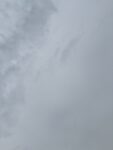
2024-09-09 11:33:25
Sasha Engelmann
Hackney Downs, London, United Kingdom
United Kingdom
NOAA-19
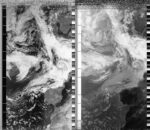
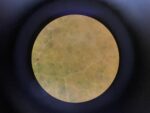
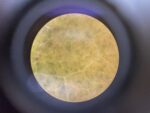
A low-hanging layer of clouds obscures the sky today, and very little light illuminates the streets and gardens of our neighbourhood. I think about a passage in the recently published 'State of the Climate' report by the American Meteorological Society. It explains that, in 2023, there was more water vapour in the atmosphere than many years past, but also, "Despite this increased moisture aloft, 2023 had the lowest cloud area fraction since records began in 1980 with skies clearer globally. Consequently, the clouds reflected away to space a record small amount of shortwave radiation, but also blocked a record small amount of longwave radiation from leaving Earth. The overall effect was the weakest cooling effect of clouds on record". The report goes on to explain a global 'darkening' due to reduced sea ice and other ice-covered areas - here 'darkening' refers to the increased proportion of earth's surfaces that absorb light, rather than reflect it. At the same time, in the UK and across northern Europe, the changing and 'wobbling' route of the jet stream is bringing cloudier, stormier, wetter weather. As I peer up at the thick grey cloud, the term 'darkening' seems to register with many meteorological and more-than-meteorological affects. I manage to coax enough light from a table lamp into the microscope to see the veins of a fallen, yellow Plane tree leaf.
2024-09-08 12:39:48
Sasha Engelmann
Hackney Downs, London,
NOAA-18
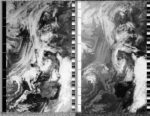
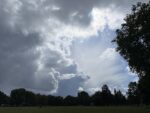
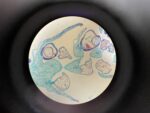
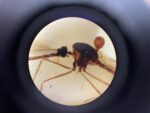
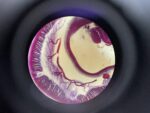
To the southeast, a gap in a towering panorama of clouds looks like a giant lens or a portal, magnifying rays of light. Two men walk by my ground station asking 'is there signal??' and then exclaiming 'you see the storm is picking up!'. Yet the wind does not rise further than a few sharp gusts and the clouds dance past. In my daily micro-weather observations, I look at 'Lumbricus' (an earthworm with its movement muscles), 'Anopheles male E' (a male mosquito) and a fragment of Selaginella sporophylls (also known as the spikemosses or clubmosses). I read that Selaginella are known as the 'fern allies' - I thought this was a nice phrase, if read non-scientifically. Some species of Selaginella are known as the 'resurrection plant' because they can survive complete dehydration, much like the lichens I wrote about yesterday. These moss-like plants roll up into brown balls, but rehydrate and expand when moistened. On this theme of 'resurrection' or 'time-traveling' or bending of temporal/ spatial ideas of life, I am reminded of a passage in the book Ceremony (1977) by Leslie Marmon Silko. It is a scene from the perspective of Tayo, a man of Laguna Indian and Mexican heritage who returns from the war in Vietnam. At dawn, Tayo is watching the life emerging around a small pool filled by a spring in the otherwise bone-dry mountains on the reservation. He observes: "When the shadows were gone, and the cliff rock began to get warm, the frogs came out from their sleeping places in small cracks and niches in the cliff above the pool. They were the colour of the moss near the spring, and their backs were spotted the colour of wet sand. They moved slowly into the sun, blinking their big eyes. He watched them dive into the pool, one by one, with a graceful quiet sound. They swam across the pool to the sunny edge and sat there looking at him, snapping at the tiny insects that swarmed in the shade and grass around the pool. He smiled. They were the rain's children. He had seen it happen many times after a rainstorm. In dried up ponds and in the dry arroyo sands, even as the rain was still falling, they came popping up through the ground, with wet sand still on their backs. Josiah said they could stay buried in the dry sand for many years, waiting for the rain to come again" (Silko, 1977: 87-88).
2024-09-07 12:51:46
Sasha Engelmann
Hackney Downs, London, United Kingdom
United Kingdom
NOAA-18
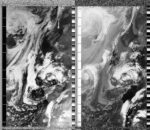
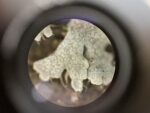
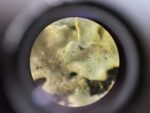
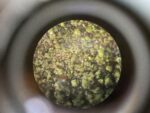
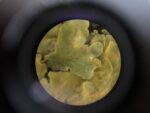
Hello lichen, who and when are you? This morning over breakfast I read a post by my friend Adriana Knouf about project Obxeno which is an automomous, solar-powered apparatus and camera watching lichens in a park around the clock. Though lichens are famously slow growers (some only grow around 1mm / year) one of Obxeno's timelapse videos seems to show a rapid grown of a lichen leaf or thallus, sort of blossoming out of the larger body. A curved piece of bark glowed bright yellow and green on the pavement on my way back from the farmers market. Later in Hackney Downs, I saw many smaller fragments of lichen in the grass, and I couldn't help borrowing two small pieces to put under the microscope at home. As I wandered through the labyrinths, caves, colours and depths of the lichens I brought home, I learned they were, like many lichens, collaborations between a green algae and a fungus. For the (at least) two lichens I was looking at, the lichen-forming fungi were Physciaceae and Teloschistaceae, both apparently relatively common and 'cosmopolitan' according to what I could find online. I read these samples in my living room were 'micro-lichen' and their shapes were foliose (leafy) and leprose (like a powder dusting). Lichens are believed to be some of the oldest organisms on earth (though how to define the limits of their identity as 'singular' organism challenges many of Science's principles). They can grow on almost any surface and they can even live inside solid rock, growing between the grains! The collaboration between the algae and the fungi is beneficial because the algae produce carbohydrates via photosynthesis that are used by the fungi, and the fungi provides a protective environment while also gathering moisture and nutrients. When fungi form partnerships with cyanobacteria in certain species of lichen, the cyanobacteria can even fix Nitrogen from the air. I learned that lichens were sent to the vaccum of space by the European Space Agency and exposed for fifteen days to the vacuum, with its widely fluctuating temperatures and cosmic radiation. After 15 days, the lichens were brought back to earth and were found to be unchanged in their ability to photosynthesize. If a lichen can live without water, and even without air; if it is never only 'one' but 'more than one'; if a lichen may be ancient or renewed each day, then perhaps, from the perspective of a lichen, energy, space and time are things that can be bent, molded, malleable. People like Adriana have said this to me before, but I am finally understanding lichens as both space and time-travellers...
2024-09-06 10:29:48
Sasha Engelmann
Hackney Downs, London, United Kingdom
United Kingdom
NOAA-19
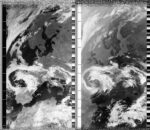
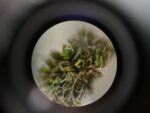
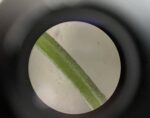
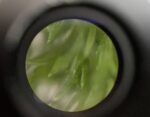
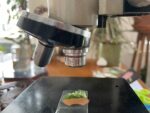
For the second day, the weather is damp, grey and dark, with intermittent rain. The park was wet and puddled, but plenty of people were out walking, having coffee and running with dogs. I breifly cuddled with Moonpie as Dave arrived at the park: 'you're one of the only people he runs up to like that, and also lets pet him' Dave said. By the time that sentence was finished, Moonpie was off again, racing to the other corner of the park. I collected some specimens - a leaf of clover, common yarrow and a tiny bump of moss found on the damp brick of the wall outside the house - to explore with the microscope. The 'weather worlds' of these small plants came alive under the lens - the moss danced with long whitish filaments that I learned could be sporophytes, and its stems and leaves bristled below. The yarrow was difficult to bring into focus because of its three dimensionality, but slowly the tips of leaves came into view, and I saw that it was covered in micro droplets. The stem of the clover almost shimmered, and I wondered if this was water coursing within the tissue, or just a quality of the surface.
2024-09-05 19:09:26
Sasha Engelmann
Hackney Downs, London, United Kingdom
United Kingdom
NOAA-15
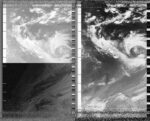
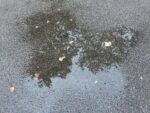
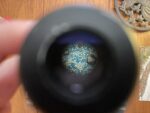
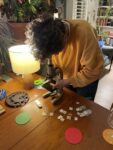
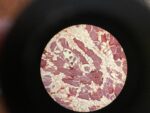
'Cabbage clubroot'; 'bee leg with pollen sack'; 'cucurbita ts stem' (cucumber stem); 'dryopteris filix-mas' (male fern); T and I pored over dozens of microscope slides rescued from an old science building due to close or be refurbished at Goldsmiths University. T had even rescued a microscope - the older kind with no light for illumination, and only a mirror - that otherwise would have been tossed. Too engrossed to cook dinner, we ordered pizza and kept speculating about the worlds made visible through tiny pieces of glass and magnifying lenses. Based on my undergraduate training in plant biology I thought I could identify the cambium in a slide containing a sliver of wood, but I wasn't sure. In the midst of this I went outside for an early evening NOAA-15 pass and wondered again about scale, patterns, fractals.
2024-09-04 23:28:08
Melody Matin
Toronto, Canada
Canada
NOAA-18


2024-09-04 19:40:52
Melody Matin
Toronto (High Park),
NOAA-15

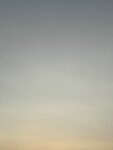
lots of mosquitoes out this evening
2024-09-04 12:03:01
Melody Matin
Toronto (High Park), Canada
Canada
NOAA-18


2024-09-04 10:55:07
Sasha Engelmann
Hackney Downs, London, United Kingdom
United Kingdom
NOAA-19
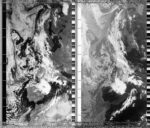
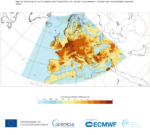
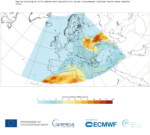
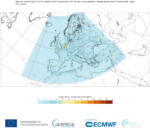
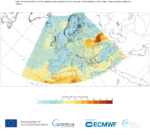
"We need to understand weather to understand where and how toxic air is held closer to peoples' lungs" - this is a statement that I wrote years ago as part of a grant application. Today I wondered: how much do I understand about the inter-implicancies of weather and air pollution, at least in the region where I live? I deep-dived into the Copernicus Programme's Atmosphere Monitoring Service (CAMS) and the freely available air quality forecast plots available at the link below. Out of the four plots I studied most closely - for Dust, PM10, NO2 and Ammonia - I was most surprised by the Ammonia plot, which shows the vast majority of continental Europe covered in what looks like a toxic orange cloud. Ammonia is less publicised as an air pollutant in the media- we more often hear about 'Saharan Dust' or 'Nitrogen dioxide' or 'Ozone'. Yet I learned that ammonia leaks from agricultural practices, livestock waste, and the use of synthetic fertilisers. Moreover it combines in the atmosphere with sulphates and nitrates to form secondary fine particulate matter (PM2.5) which can enter the bloodstream of breathing bodies due to its very small size. Ammonia and PM2.5 are clearly too small or fine to 'show up' in satellite images like those of NOAA-19, but I learned that newly launched satellites, like NASA's PACE satellite, are intended to fill in the gap in knowledge around what aerosols actually do in the atmosphere. For example, according to climate scientist and modeller Gavin Schmidt we don't yet understand how a change in regulatory policy affecting ship fuel (mandating a move away from sulfur-based fuels toward 'cleaner' options) might have had on the climate in 2023. Sulfur can combine with other molecules in the atmosphere to reflect light and change the density of clouds, therefore possibly having a cooling effect, so moving away from such fuel sources is speculated to have had warming effects. The implications of such vast changes in fuel use for the types of aerosols in the atmosphere are immense, and yet it is hard to scale up from particulate to cloud or weather. I studied the satellite image I captured today and wondered about whether dust, perhaps, was blurring the borders of land and sea...
Source: https://tinyurl.com/4xcpkaxx
2024-09-04 11:07:28
Melody Matin
Toronto (High Park), Canada
Canada
NOAA-19


I'm having a harder time these days tracking the satellites as they pass overhead. With one small movement I can lose a good signal. But I try to stay positive as I redirect the antenna to find the signal again.
2024-09-03 11:19:32
Melody Matin
Toronto, Canada
Canada
NOAA-19

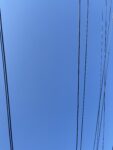
It's one of those September days where the air is cool in the shade and hot in the sun. After a few days of struggling to get good signal, it was encouraging when I heard those very clear ticks and beeps. I did this capture in my backyard with just a short view of the sky.
2024-09-03 11:08:44
Sasha Engelmann
Hackney Downs, London, United Kingdom
United Kingdom
NOAA-19
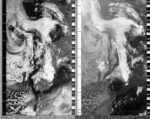
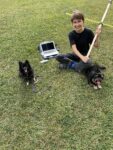
"Muffin man!" "Moonpie!" I heard in the distance as a black ball of fur careened into the side of my body and I was greeted by the happy face of a small pomeranian mix who promptly sat down against my leg. The wobble of my radio antenna probably registered in the satellite image I was capturing but the company was more than worth it! Muffin Man followed Moonpie, as well as another dog called Star, and I was soon surrounded by small joyful dog energy. I learned that Star was being fostered after having been rescued from perilous conditions, and would soon be given to a family for care and a home. Our conversation attracted another dog owner who came over to get information on a recent incident where an off-collar dog attacked another dog in the park. For some minutes, rumours circulated about who the attacking dog belonged to and what had happened, with speculation that the owner might even have been sent to prison. The moral of the encounter seemed to be that dogs are capable of anything, no matter how cute and lovable they are- yet no matter how hard I looked at Moonpie, I just couldn't imagine him being scary. In the swirl of activity, dog-cuddling and conversation, the satellite passed overhead and crested the southern horizon, and I packed without so much attention to the semi-clouded sky.
2024-09-02 12:15:45
Sasha Engelmann
Hackney Downs, London, United Kingdom
United Kingdom
NOAA-18
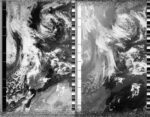
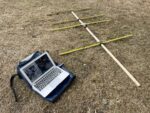
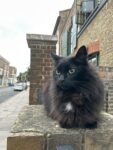
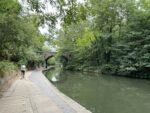
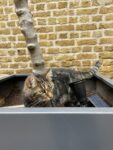
A fine drizzle was carpeting the neighbourhood as I went out with my tape measure Yagi antenna today. I wasn't expecting the rain, so I found a still densely foliated Plane tree to give cover. Later in the day, en route to South London, the rain had started again. I had checked and rechecked the weather report before getting on my bike, and all that was predicted was a lot of cloud. I remembered what my scientist colleague said earlier this summer about the increasing moisture to be expected in a climate-changed Northern Europe based on a wobbling jet stream. Despite the moisture-laden air, the rest of the day was textured with immense relief, new knowledge, and support from my partner T. Two cats offered their emotional energies too.
2024-07-25 22:53:01
Soph Dyer
Lacknergasse, Wien
Wien
NOAA-18

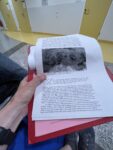
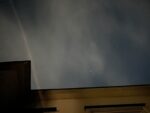
Cool temperature. Still night. There is a thin film of cloud.
Earlier, inn the hospital, I read a draft of Wind’s Animacies by Sasha. The article sweeps me up, taking me far from the fluorescent lighting and airless weather of the waiting room. I turn over her question, "what does the wind remember?" I am moved by it, perhaps because I am grappling with how to reorganise or cohere a messy medical history of ill health with the new knowledge that comes with a diagnosis.
I find myself caught between wanting to forget the lost days in bed with a pillow tucked under my abdomen, or the sleepless nights and listless days that followed. Could an earlier diagnosis have changed the course of my access to treatment? This is is both too painful and utterly pointless to think about.
I want to reorganise my memories into a tidy narrative of endometriosis, cysts and fibroids, rather than the current cluster of unexplained, possibly unrelated symptoms that moved around my body to the extent that I stopped trusting myself as reliable narrator.
I am thinking with Sasha's words: is pain is similar to wind? Neither are immaterial or material. Is pain not energetic, “slippery”, “leaky”?
Thinking about wind’s memory is an analytic move away from asking “where does the wind come from?” (n.d. Engelmmann) A question that forces an artificial cut into time to arrive at a single origin point. I exercise changing the familiar questions “Where does the pain originate?” or “When did the pain begin?" to “What does my body remember?” This new question requires me to relearn to trust it my body and its complaints. To piece it back together.
In a wholly different context, that of the 2016 US presidential election, American essayist and anarchist Rebecca Solnit writes “when the subject is grim, I think of the act of naming as diagnosis.” Diagnosis does not equal a cure, but it is an act of recognition that has the potential to reorganise and make sense of memories.
2024-07-02 21:32:41
Soph Dyer
Sarajevo, Bosnia and Herzegovina
Bosnia and Herzegovina
NOAA-19

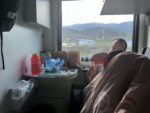
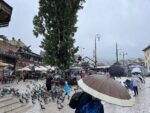
It's been raining. I wait for the weather to clear and capture the satellite's transmission in the dark next to Kovači Cemetery. The low stone wall I am sitting on is cold and damp. The cobbled road near me is empty but at its end, where it opens onto a broader street, people gather at the entrance to a mosque. Uneasy about the location, chosen without knowledge of the city because of it is the closest open space to where we are staying, I attempt blend with the night.
2024-07-09 10:12:00
Soph Dyer
Duboka, Vis, Croatia
Croatia
NOAA-19

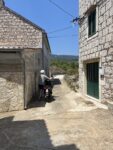
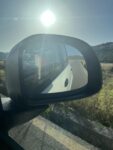
Woke surprised by hot the apartment already was. As I set up my antenna on the track leading into the village, an older man and woman came out of their house to offer me local produce. Sweating, declined in stilted English. Perhaps I sounded Spanish as the conversation turned into an exchange of "Mucho calor!"
2024-07-04 21:05:37
Soph Dyer
Miholjače, Bosnia and Herzegovina
Bosnia and Herzegovina
NOAA-19
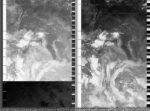
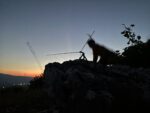
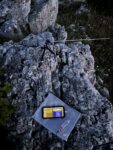
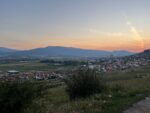
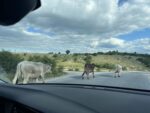
Two fire flies flash. I watch the coal mine and power plant on the plateaux, my radio antenna balanced on a rock above the road. A hazy red sunset bleeds out into darkness. On a walk this afternoon, the owner of the guest house pointed to the where an underground river was being rerouted to accommodate industry. His tone seemed to express a mixture of depression and despair. He did not mention the coal power station, which is not visible from the house. Now I see it, I imagine it thirstily drinking the river.
2024-07-03 21:19:36
Soph Dyer
Sarajevo, Bosnia and Herzegovina
Bosnia and Herzegovina
NOAA-19

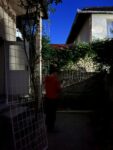
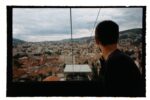
I am stood in the backyard of our host's house. Deep greens and reds of a flowering vine frame the midnight blue sky. Today, N and I visited the Museum of Crimes Against Humanity and Genocide, and then rode a cable car built for the 1984 Winter Olympics to a hilltop overlooking the city. In the evening, we walking along the Miljacka River to the book store 'Buybook Sarajevo' we stumbled on the opening of the BOOKSTAN literature festival. Before we realise that there is a festival, the crowd gathered out side felt familiar. Enjoying the atmosphere, we purchased two white wines and sat on a park bench. As N is at the bar buying a second round, I complement the small dog of an elegant older woman. She tells me that she is a translator of an English language book about the siege written by an author living in the United States. She is here to meet the author, she tells me, and will not stay for the festival as she is already looking forward to returning to her home in the countryside. When I later search for the festival programme online, I find its tagline: “A literary festival where there is neither East nor West, but just humans and their stories”. This evening my memories of working on war crimes investigations in Syria, Iraq and Ukraine, mingle with the stories of survivors from the museum displays. As we were entering the last room of the museum, I thought I could hear a video. There was no video, instead an older woman and man speaking in Bosnian. They looked distressed, I think the woman was crying. The couple were being interviewed by a small film crew. The walls of the yard block my view of the Sarajevo below, yet I know that the city I arrived in three days looks different.
2024-07-10 11:46:31
Soph Dyer
Duboka, Vis, Croatia
Croatia
NOAA-19

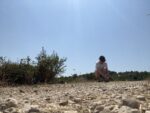
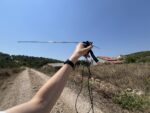
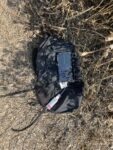
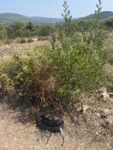
Intense heat stops me thinking. I sweat into my teeshirt and instantly regret exposing myself to the unforgiving sun. "Tomorrow", I note to myself, "wait until nightfall".
2024-07-13 22:42:00
Soph Dyer
Duboka, Vis Island, Croatia
Croatia
NOAA-18
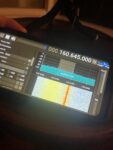
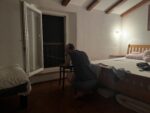
2024-08-31 19:39:13
Melody Matin
Toronto (Sunnybrook Park), Canada
Canada
NOAA-15
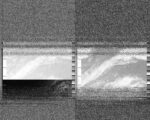
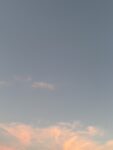
2024-08-29 10:37:08
Melody Matin
Toronto (High Park), Canada
Canada
NOAA-19
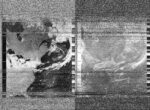
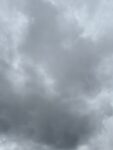
2024-08-29 09:13:02
Melody Matin
Toronto (High Park), Canada
Canada
NOAA-15

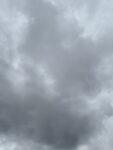
2024-08-28 10:53:24
Melody Matin
Toronto (High Park), Canada
Canada
NOAA-19

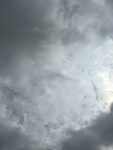
2024-08-27 19:46:18
Melody Matin
Toronto (High Park), Canada
Canada
NOAA-15

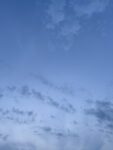
2024-08-26 20:10:27
Melody Matin
Toronto (High Park), Canada
Canada
NOAA-15
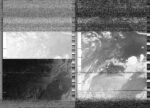

2024-08-29 10:31:59
Sasha Engelmann
Hackney Downs, London, United Kingdom
United Kingdom
NOAA-19
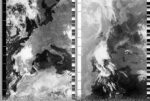
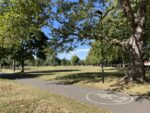
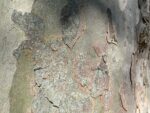
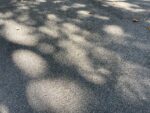
Today I am presenting in a panel on 'Open Geographies' at the Royal Geographical Society annual conference. I plan to speak briefly about the 'openness' in open-weather. For me, in addition to 'un black-boxing technology' or 'visceralising data' (d'Ignazio and Klein, 2020), the openness in open-weather may be about different dimensions of the ‘commons’. The late queer theorist Lauren Berlant describes a world that is, “intimately touching from near and far and therefore changing what proximity does” (Berlant, 2022: 99). I want to suggest that ‘the common of contact’ between a ground station operator and a satellite is both ‘intimate’ and ‘changing what proximity does’. Figuring this ‘common of contact’ leads to alternative and perhaps more thoroughly open readings of environment-sensing infrastructures and commons. It demonstrates how the effort of holding an antenna to the sky is built on a form of sociality and even desire, manifested in the collecting and caring-for of images otherwise considered faulty. Yet, lest I create a romantic picture of desiring bodies and machines - there is ample boredom, frustration and ambivalence too. Through repeated, modest, noisy contact with the technologies of earth observation, open-weather helps me envision a progressive politics of openness, one built on, in the words of Berlant, “affective infrastructures that admit the work of desire and the work of ambivalence as tactics of communing” (Berlant, 2022: 116).
2024-08-28 10:46:50
Sasha Engelmann
Hackney Downs, London, United Kingdom
United Kingdom
NOAA-19

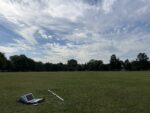
Today the air is still - not so much as a small gust as I orient my Yagi antenna from north to south, tracking NOAA-19. The sky is veiled with light cloud and contrails, and things feel grounded, heavy but not placid. Indeed I feel so unusually calm that I don't leave the house until the satellite pass is actually starting, meaning I am six minutes late to press 'record'. A man is driving around the park with a large tank of water on the back of a truck, watering trees. This feels like such a benevolent and kind thing to do, though I am sure water must be rationed as the trees are turning yellow-brown far too early. As he drives by me, he smiles and gives me a thumbs up from the car window.
2024-08-27 11:52:02
Sasha Engelmann
Hackney Downs, London, United Kingdom
United Kingdom
NOAA-18

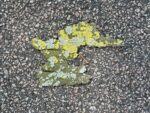
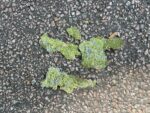
Another windy day, with gusts coming from both the south and west across Hackney Downs. Tree branches and pieces of bark have been peeled off trees and lie on the pavement or grass. Once again my tape measure Yagi was pushed and pulled around by the air, and once again I feared the delicate bits of soldering would come undone. When the dipoles bent down at odd angles, lines of noise permeated the audio recording. I realised today that I had never fully explored the fact that antennas could be malleable- able to move and bend with the wind. We associate antennas with very tall steel towers or elaborate metal sculptures that are nevertheless solid and static- but what about an antenna made of flexible material? I've been aware of 'wearable antennas' via the work of artists like Afroditi Psarra or Audrey Briot, and I have seen experiments in metal weaving, but my tape measure Yagi has raised other questions about working with semi-flexible, yet conductive materials that change rather than holding shape when exposed to air.
2024-08-26 12:02:33
Sasha Engelmann
Hackney Downs, London, United Kingdom
United Kingdom
NOAA-18
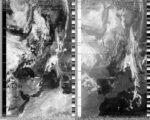
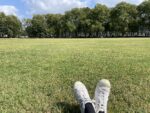

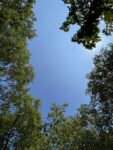
On my way back from the park with my tape measure Yagi, I saw the well-known local character who wears a tracksuit and stands on benches practicing martial arts, every day rain or shine. I smiled and waved hello, and he immediately exclaimed 'there's the aerial!' and for a moment, I think, mis-gendered me, as he called out something like 'oh- a girl!'. He jumped down from his bench and started asking questions- had he seen me before in the park? was I from America? how do I like Hackney? I learned his name is 'Joe' but everyone calls him 'Shaolin Joe' because he practices the Shaolin Arts (martial arts) in public around Hackney and Clapton. I tried to explain why I use my Yagi antenna to capture images from satellites, and he compared my daily satellite passes to the Shaolin Arts... 'meditating with your satellites'. We shook hands and he called out after me 'Have a great day!!' and something like 'good American!'
2024-08-25 18:56:29
Sasha Engelmann
Hackney Downs, London, United Kingdom
United Kingdom
NOAA-15

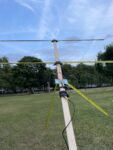
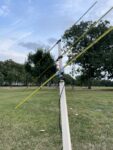
I awoke to a flood of sunlight in the apartment, though the colder air temperatures persisted. My head and body ached and I wondered about residual tiredness or a travel bug. This was all counter-balanced by a morning of indoor plant gardening: trimming the willow tree in the corner of the living room, crafting support structures for newly grown arms of vines near the ceiling, and watering others. When I finally emerged from me and T's apartment to catch an early evening pass in the park, the wind caused the dipoles of my tape measure Yagi to bend and angle all over the place. I tried to find positions where the antenna would slice through the air rather than be buffeted like a kite, but often gusts came from unexpected directions. It was not stormy, but unusually unpleasant, especially with the recent memory of sun-drenched beaches and warmer air.
2024-08-25 12:22:03
Melody Matin
Toronto (High Park), Canada
Canada
NOAA-18
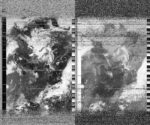
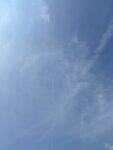
The Canadian National Exhibition is on this weekend, an end of summer festival with rides, music, and an international air show including the Royal Air Forces Red Arrows, Canadian Forces Snowbirds and the United States Air Forces F-22 Raptor. I think some of the planes were practicing as I was capturing this pass, buzzing through the sky, flying low and close to the ground.
Otherwise, a very typical summer day in Toronto, pretty warm, humid and little cloud coverage.
2024-08-24 12:35:33
Melody Matin
Toronto (Sunnybrook Park), Canada
Canada
NOAA-18
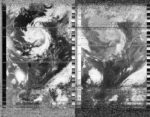
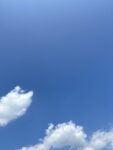
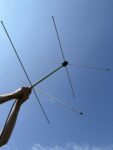
2024-08-24 19:20:36
Sasha Engelmann
Hackney Downs, London, United Kingdom
United Kingdom
NOAA-15
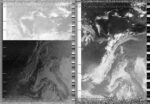
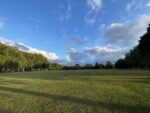
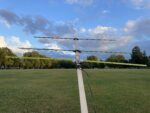
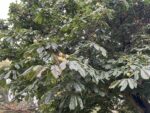
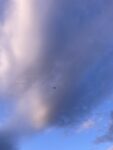
From the heat, humidity and air pollution alerts of northern Italy, T and I travelled back to the UK by airplane in the mid-morning. The previous evening, a thick red and orange layer of particles coated the horizon. It was particularly visible during a long, late afternoon swim to the buoy that marks the limit of the swimming zone at the beach of Lignano Sabbiadoro. Normally, while swimming one can see the coastline of the lagoon and even as far as Trieste, but the haze completely occluded our vision. I read that the air pollution alert would increase in urgency over the rest of the weekend, and wondered whether my asthmatic lungs would react, or whether we were leaving too early on Saturday for my lungs to register. The airplane journey was cloud-free until we reached the agricultural flatlands of Germany, when a few cotton ball clouds appeared. By the time we were crossing the English channel, there were at least three layers of cloud: a thin, staccato layer above the airplane; an intermediary, patchy layer below; and a thicker, grey, monotonous layer close to the ground. We descended through the middle layer but spent another thirty minutes circling above and within the lower layer before landing. As we emerged from the plane, passengers cried out at the cold drizzle and wrapped their bare, tanned shoulders in scarves and other random clothing items - taken by surprise. The rain came and went for the rest of the day. I chose a lucky rain-break to head out to Hackney Downs with my yagi antenna for an evening pass. I noticed yellowed grass; large clumps of maturing chestnuts; and the late-August sunset piercing through the trees to the west, making silhouettes of people gathered around a bench with a sound system. I thought about Soph and urged Soph's cells and molecules to keep binding, smoothing, healing.
2024-08-23 12:47:53
Melody Matin
Toronto (High Park), Canada
Canada
NOAA-18
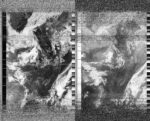
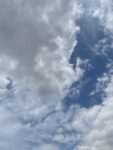
I was rushing to finish a paragraph of my dissertation so I could hop on my bike and get to my usual spot on time for the pass. I'm starting to get familiar with the speed in which the satellites move through the sky. Now when I'm pointing the antenna at the sky I hear no static, just clear ticks and beeps. The same curious stranger was at the park today - and wished me luck on my capture!
2024-08-23 11:04:44
Sasha Engelmann
Belvedere Trabucco in Lignano Sabbiadoro, Italy
Italy
NOAA-19
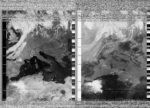
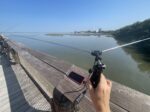
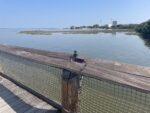
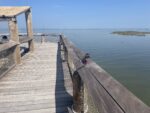
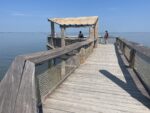
When I arrived at the Belvedere Trabucco - a wooden pier facing the lagoon north of Ligano Sabbiadoro - I discovered it was full of fishing poles. Some older men and a few teenagers were monitoring the poles and their long, taught fishing lines. One young person re-attached the lure on their line - it looked like a spider or dragonfly. Fixing my radio antenna to the edge of the wooden railing, I fished for signals. The sound of NOAA-19 emerged soon after, and gained in strength quickly, as there was almost nothing between me and the Northern horizon except the lagoon and a thin line of land in the distance. In the greenish water below I could see the characteristic clumps of material called 'mucilagine' in Italy. Though mucilagine has been known for hundreds of years and is caused by a non-toxic microalgae, Gonyaulax, it has increased in quantity with rising Adriatic sea temperatures and it poses a growing problem to small fishing boats and businesses. Apparently, some hotels along the Italian coastline are even sending 'mucilagine weather reports' to tourists and travellers who want updated, semi real-time information on the spread of mucilagine in seawater before arriving at the beach.
2024-08-22 13:01:47
Melody Matin
Toronto (High Park), Canada
Canada
NOAA-18

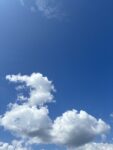
It's starting to warm up again after a few chilly days in Toronto. I biked to my usual spot in High Park and had a few extra minutes after setting up to read. As I was packing up, a stranger came up to me to ask what I was doing - this happens every time. They are fascinated after I explain the process and I've started sharing the website with everyone who is curious about it.
2024-08-21 12:28:55
Sasha Engelmann
Quercia delle Checche near Pienza, Italy
Italy
NOAA-18

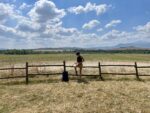
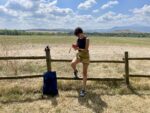
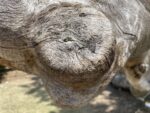
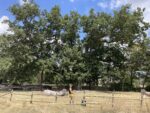
The quercia delle Checche, an approximately 300 year old oak tree and Italy’s first ‘green monument’, is full of dense, perfectly shaped leaves and is apparently thriving despite the dry summer. Planted in the 18th century, the oak was one of the few to survive the rapid landscape changes of the Tuscan countryside as the oak woodland was deforested in favour of agriculture. Rumour has it that Napoleon’s troops stopped to rest in its shade. Numerous local weddings, trysts, rituals and gatherings have occurred under and around its branches. Two large horizontal branches have fallen and now lie like giant bones in the yellow grass. Up close, the dry wood of the branches has whorls and shapes that remind me of Kármán vortex streets caused by wind flowing around islands or mountains. I wonder what events caused the wood to ‘flow’ in this way- what memories does it hold?
2024-08-21 22:03:26
Melody Matin
Toronto (High Park), Canada
Canada
NOAA-19
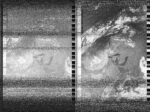
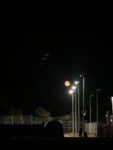

Went for an evening capture today. I was different and super fun! The park was very quiet, and only lit with street lamps. The air was chilly and the sky was clear, I could see some stars and the moon was huge.
2024-08-17 23:02:39
Sasha Engelmann
Jadrolinja Ferry in the Adriatic Sea between Split and Ancona, Croatia
Croatia
NOAA-18
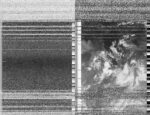
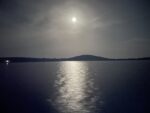
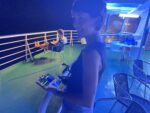

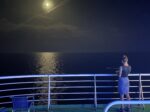
The almost-full moon hung ponderously over the southern horizon of the Adriatic as we made our way slowly across it in an overnight ferry from Split to Ancona (Italy). T and I had hustled on with our car and luggage around 21:30 and by 23:00 we were in the open sea. Languages swum between Croatian, Italian and French as we qued for dinner and wandered around. People had hung hammocks up between stairwells and railings. Others had blown up mattresses on the landings between stairwells, and others were just lying on a thin layer of blanket, exposed to the wind and weather of the sea. As I set up for a 23:01 satellite pass, the air was so humid and sticky- touching the metal railing of the ferry felt like touching liquorice. The darkness of the sea at night felt ominous and limitless.
2024-08-17 18:24:32
Sasha Engelmann
Jadrolinja Ferry between Stari Grad and Split, Croatia
Croatia
NOAA-15
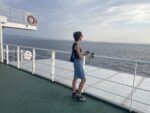
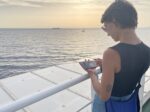
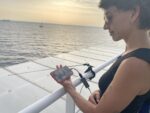
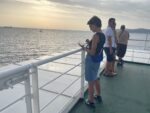
The inside deck of the Jadrolinja ferry from Stari Grad to Split was far too crowded, so me and T sat on the floor of the upper deck. The air rushed around us, but the humidity stuck to our hair and skin. We said goodbye to Hvar for the summer. I said goodbye to my Baba.
2024-08-17 10:39:33
Sasha Engelmann
Zaraće, village of Gdinj, island Hvar, Croatia
Croatia
NOAA-19

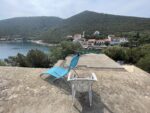
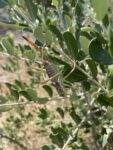
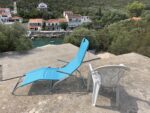
A thin veil hung over the bay this morning, making the sunlight a little bit weaker and more silvery. Me and T had slept in after a hot and sweaty night during which both of us sat up awake at 3am. I squeezed between the bunk beds and tiptoed outside with my radio antenna before any coffee was brewed. As I suspected, leaving out the extension cable meant that I could receive the pass easily and clearly from the rooftop terrace. I hooked the antenna tripod on the edge of a plastic beach chair and held the android phone on my lap, watching the patterns of the mid-morning current in the bay. By the time I was done, I could see the grills starting to smoke to the left and across the water, preparation for a fish lunch.
2024-08-16 18:53:42
Sasha Engelmann
The rocks of Zaraće, village of Gdinj, island Hvar, Croatia
Croatia
NOAA-15
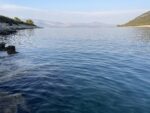
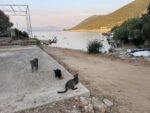
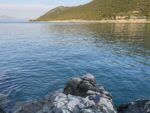
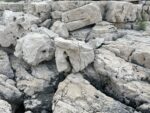
A school of tiny black fish swirled around the rocks, and island swallows swooped and dived for insects above. I sat on a rocky perch at the edge of the sea, under the fisherman’s chapel, where someone had left a bouquet of olive branches, Tradescantia pallida, yellow cow parsley and long grass. A fisherman walked past me on the rocks and I suspected I had taken his usual spot, but he didn’t ask me to move, and he climbed on further, somewhat awkwardly navigating the steep Karst with its jagged edges and slant into the sea. I meditated on the deep time histories of Hvar - how my memories of Zaraće were so bound up with every edge of these rocks, and how far back in time they had emerged from the ocean floor, pushed up by tectonic and geomorphic processes. As I faintly recorded NOAA-15 at only thirty degrees to the east, the tide was coming in, and by the time I packed up, the sea was waking up the limpets and sleeping snails where my feet had been.
2024-08-18 21:56:16
Soph Dyer
Lacknergasse, Wien, Austria
Austria
NOAA-19

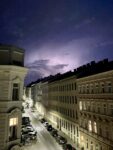
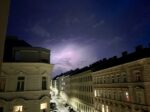
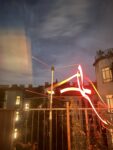
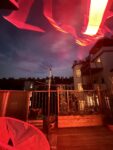
There was a big electrical storm this evening. Bolts of lightening flashed between clouds for hours. As I have spent most of my time indoors over the last two weeks, so to witness this weather event, even from the window, was exhilarating. My recovery from the surgery has been uneven and absolutely nonlinear. I have moments of pure joy, such as when I woke from a nap feeling completely rested, my mind loose but still. But by the afternoon, I miss physical exercise and social contact. I know that I need to ride out this turbulence. Or rather ride with it.
NOTE: I received the satellite image after the storm had passed and the stars were out.
2024-07-18 21:38:15
Soph Dyer
Diepoldplatz, Wien, Austria
Austria
NOAA-19
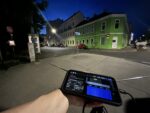
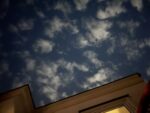
A soupy night. Warm and still. Older men on park benches smoke and watched as I point my antenna. My phone crashes multiple times. I focus on the long beans handing from the tree in front of me. The last kids of the day shouted in the park, two whizz around on scooters with LED lights in their wheels. I try to ignore the men’s gaze and relax into the warmth of the night.
2024-07-17 21:51:08
Soph Dyer
Lacknergasse, Wien, Austria
Austria
NOAA-19
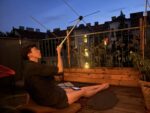
Mottled cloud mellowed the sun and a breeze prevented the air from feeling too close. On the balcony it is dark, grasshoppers sing. The tomatoes are recovering from a lack of water while N and I were on holiday. The crop is about on third ripe. Despite the stress of returning to medical admin and heavy weather between me and N, it’s been a good first day back at work. Sasha and I spoke for more than three hours. The feeling of pressure on my chest is easing. I will make the most of the cool night and sleep early.
2024-08-12 21:29:05
Sasha Engelmann
Zaraće, village of Gdinj, island Hvar, Croatia
Croatia
NOAA-19

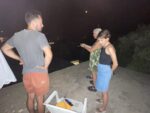
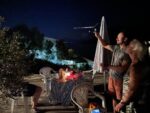
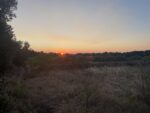
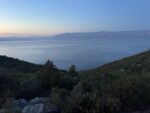
As I set up my ground station on the edge of the concrete terrace at my Mom’s house in Zaraće (a small bay in the village of Gdinj, island Hvar, Croatia) I could feel the concrete emanating heat accumulated over the day. The prior evening a small group of us (friends and family) had ventured out to the warm rocks at night to watch for the Perseids - and we saw several meteors, sometimes so numerous they seemed to speak to each other in the sky. One very powerful meteor passed from 90 degrees above us in a long orange streak to the horizon. Gdinj (and Zaraće) is an origin point for my family - one that stretches back for generations on my mother’s side, through the Čurin family who settled in Gdinj, grew lavendar, cultivated olive trees for oil, and fished in the sea. I remember my Deda (grandfather) waking up at dawn to collect the fish of the day from nets that had been laid out by hand the evening before. It wasn't so long ago that the only way to travel from Gdinj, on the top of the island, to Zaraće at the sea, was by mule or donkey along a narrow dirt path. It wasn't so long ago (only last summer) that I came to Gdinj for my Baba Albina's funeral, an event that drew the whole village, and with people driving from as far away as Belgrade. In the local cemetary, mom and I each read a small passage, and my Mom also read a poem by Vesna Parun. It is always intense for me to be (back) here. I want to forget about the practicalities of life - how to get clean water (the water 'cisterns' aren't always the safest to drink from), how to get food, who to go for ‘kavu’ (coffee) with. I want to just lie without a towel or goggles or rock-shoes on the pale, jagged, karst rocks and stare at the sea. Indeed I have spent so many of my summers doing exactly this, I wonder if my small bones are laced with limestone, seawater, algae, olive, lavender.
2024-07-15 22:12:09
Soph Dyer
Perković Railway Station, Croatia
Croatia
NOAA-19
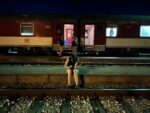
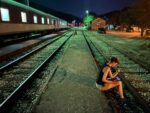
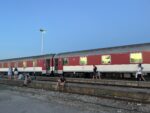
"I wonder if climate change can be measured in hot tracks?" you reply in response to my photo. N and I are waiting with perhaps a hundred other passengers at a small railway station outside Split. The reason, we are told by a cheery Austrian train guard, is that the railway tracks are too hot for the train to proceed. We must wait for them to cool. It is more of a novelty than an inconvenience to be stranded in the warm night with strangers. Assured by the guard that the train will not leave anytime soon, I made a dash to a local store to buy extra water and two ice creams. The small shop is filled with fellow passengers. The atmosphere is convivial if a little restless as we wait for the shop attendant to finish slicing ham for a local customer. I return feeling victorious, carrying the ice creams, the train has not left and will not leave another two hours.
2024-07-14 23:32:15
Soph Dyer
Duboka, Croatia, Croatia
Croatia
NOAA-18

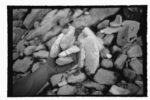
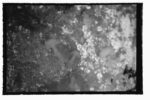
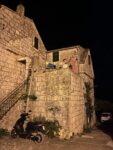

There are even more Mauve Singers in the bay, too many to swim without being vigilant. N and I collect white plastic rubbed smooth by the Mediterranean and bring it back up to the village in bags. Our host is distressed and moved to apologise by the sight of so much plastic. He is an older man possibly no longer unable to make the steep 25 minute hike down to the water. He mentions the heat and then "the Albanians". N is confused and thinks that Albanian tourists have been littering in the bay, as opposed to racialised ocean currents carrying the trash from the Albanian coastline. His misunderstanding lightens my mood.
2024-07-11 22:25:02
Soph Dyer
Duboka, Vis, Croatia
Croatia
NOAA-18
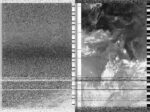
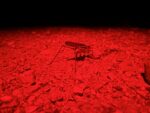
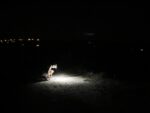
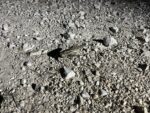
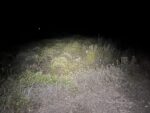
I am getting better at staying cool headed in the heat. Blue skies, a few clouds. A gentle wind brought some relief. Today was hotter than yesterday. Our host said that he installed the air conditioning unit the day we arrived. He complained many times about the heat. It was a reassuring to know, as a Northener, that I was not the only on struggling. Yet it was disconcerting to know that the heat was new. It has not always been this way. N and I waited until the relative cool of the night to receive a satellite pass. We walked down to a track leading away from the village. Using a head torch, I checked for snakes. To my relief, I found a grass hopper laying eggs and a stray cat. Towards the end of the pass, curious to know what other animals might be near, I looked around for more eyeshine. My survey revealed many small green dots. I approached, expecting to find small animals, perhaps lizards warming themselves on the stone? Instead, behind each green dot was a Radiated Wolf Spider. N and I were being watched by tens of spiders. I dislike spiders so quickly packed-up and retreated to the house, eyeing the green dots lining the track.
2024-08-19 11:01:31
Melody Matin
Toronto (High Park), Canada
Canada
NOAA-19
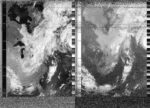
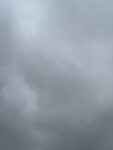
temperatures dropped today, the air was mild but the wind was super chilly.
2024-08-18 12:11:43
Melody Matin
Toronto (High Park) , Canada
Canada
NOAA-18

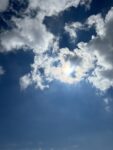
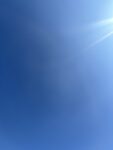
sunny, hot, humid. second capture of the day!
2024-08-18 12:11:43
Melody Matin
Toronto (High Park) , Canada
Canada
NOAA-18
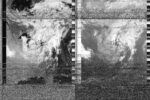
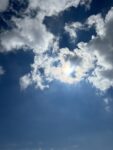
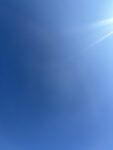
sunny, hot, humid. second capture of the day!
2024-08-18 11:14:47
Melody Matin
Toronto (High Park), Canada
Canada
NOAA-19
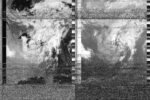
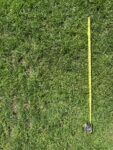
It was a really sticky and humid morning in Toronto. My partner (Rory) and I cycled to High Park to capture two back to back satellites. I suspect I am getting disoriented halfway through my captures so we marked north and south with a tape measure so I could follow it without having to check my phone's compass. Fuelled on just coffee this morning, we enjoyed the sunshine in between satellite passes.
2024-08-17 12:26:02
Melody Matin
Toronto (Don Valley Brick Works Park Lookout), Canada
Canada
NOAA-18

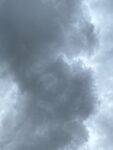
Went to a lookout today, the same spot I saw the eclipse a few months ago. Thought I could get a clearer image, I'm starting to think I am getting a bit disoriented with my directions, I'll have to think of some solutions. Big grey clouds were rolling as I was setting up, and an hour after the satellite passed, there was a thunder and lightning storm!
2024-08-16 12:36:12
Melody Matin
Toronto (Earlscourt Park), Canada
Canada
NOAA-18
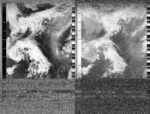
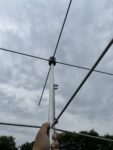
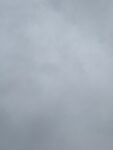
I biked up a few blocks from my home, up a steep hill to a park I had never been to before. Lot's of kids playing, and runners around the park. Grey skies, very humid!
2024-08-15 19:56:25
Melody Matin
Toronto (Sunnyside beach) , Canada
Canada
NOAA-15
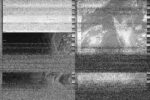
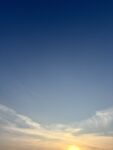
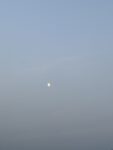
I biked to the edge of Toronto, on Lake Ontario this evening. I am trying different city parks to see where might be the best place to capture. It's been fun to cycle around the city to scope out potential sites. The Toronto beaches aren't very accessible, I have to cross a large highway on a very narrow bridge. But the sunset over the bridge on my way back home was really beautiful. Clear skies for my on-the-lake capture, very humid, and I got a lot of questions from folks on their evening stroll.
2024-08-15 12:48:52
Melody Matin
Toronto (Sorauren Park), Canada
Canada
NOAA-18
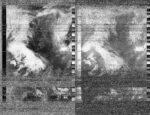
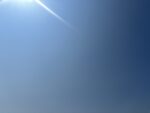
2024-08-04 20:20:00
Melody Matin
Toronto (High Park), Canada
Canada
NOAA-15
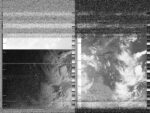
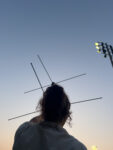
The weather in Toronto was beautiful today, the air was a bit humid and there was no cloud coverage. The satellite passed exactly as the sun was setting, and the sky was turning pink and orange. This was my first capture in Toronto, so the image came out a bit noisy, but I as thrilled to see that I had captured the Great Lakes and Hudson's Bay! My goal is to capture The Canadian Arctic which begins at the North end of Hudson's Bay. This time of year, the sea ice has melted and we can see an ice free Hudson's Bay!
2024-08-14 21:07:30
Marcin Jasiukowicz
Iława, Poland
Poland
NOAA-19

2024-06-07 13:41:29
Sasha Engelmann
Hackney Downs, London,
NOAA-18
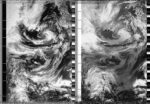
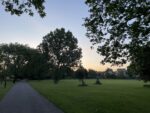
The sun was rising when I rode my bike through Hackney Downs this morning, coming back home from a club in Dalston. My limbs felt both heavy and light in the very pleasing way that limbs feel when you have been dancing for hours. People were already in the park, or maybe they had been there the whole night. I could see the faint spark of a cigarette in a huddle of bodies between the hedges. I thought about getting my radio antenna and catching a pass at dawn, but sleep was too tempting. Later, at almost 2pm, I re-emerged from my flat and went back to the park. In contrast to the soft, orange-pink glow of the early morning, the early afternoon was warm, hot and dry. As I started the pass, a man in a group of men that normally always stand around a bench at the north-east corner of the park, around thirty-forty metres away from me, yelled "Is that for free internet?!". I could only think to yell back, "No!". As I couldn't explain at such distance, I used my free arm to point to the northern horizon and traced an arc through the sky from North to South. That seemed to help. He yelled again "What are you tracking!!?" and I replied "A satellite!! An image!!". As no members of the group looked like they were going to come any nearer, I walked over to them after the pass was done, and showed them the live-decoded image. They huddled around my computer. I wondered what they might say about the weather, given that the five to six of them are always here at this bench, all day, every day, rain or shine. Instead, they asked me what the weather was going to be like. I said I was not a meteorologist, but the image was showing different patterns of clouds over the Atlantic, maybe coming to the UK. They seemed to like this. One of them said 'nice one mate' and shook my hand in the way men do when they put out their arms, bent at the elbow, with the hand close to the chest. When you close hands you end up getting pulled together in a show of comraderie.
2024-06-06 12:11:30
Sasha Engelmann
Hackney Downs, London, United Kingdom
United Kingdom
NOAA-18
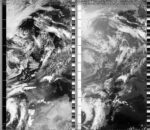
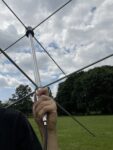
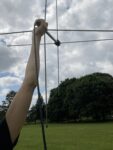
Over these last couple weeks, I sometimes observe the darkness of the landforms in the satellite images, especially in the Infrared Channel, usually on the right side. Though I have not studied infrared radiation scientifically, I know that, in the Infrared channel, the darker the pixels suggest that something is 'warmer' while the lighter pixels suggest 'cooler'. In today's image, even the northernmost part of Norway appears to be relatively dark, emanating and radiating heat against the neutral gray of the Barents Sea. The coastline and interior of the African continent also stands out in the InfraRed channel. Yesterday, a colleague who works in Cambodia studying the lives and labour of brick kiln workers told me about how the workers measure time and seasons by how fast it takes a large ball of clay to dry outside. In some seasons it takes five days, while in other seasons it only takes five hours. Their work rhythms are intimately related to the drying of the clay, and so also the heat and movement of air. In a meeting this morning I was reminded of Michael Taussig's writing on heat. He says, "Heat is a force like color, that sets aside the understanding in place of something less conscious and more overflowing, radiance instead of line, immanence instead of the famous bird's eye view" (Taussig, 2004: 31). As I pored over the 'satellite-eye's view' of today, I wondered about where heat as a 'force' shows up. Does it only show up in the clay ball that tells about heat by how fast it dries? Or does the force somehow also 'show up' in the satellite image, in the darkness and contrast of pixels? Thinking of the ball of clay makes me feel more connected to the idea of heat as 'force', but I keep wondering whether there are ways to use colour ('something less conscious and more overflowing') to demonstrate or express more of heat in the satellite image. In contrast to 'heat maps' where red and dark purple often signify the intensity of heat, how else could colour map heat, how else might it suggest 'immanence' or 'radiance' instead of line?
2024-06-04 09:27:43
Sasha Engelmann
Grassy Field near the Physics Department, Royal Holloway University of London, United Kingdom
United Kingdom
NOAA-15
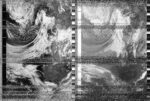
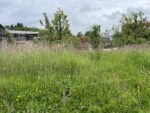
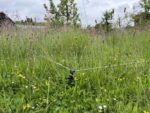
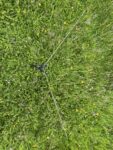
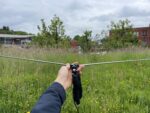
Today has been about rhythms. I organised and choreographed so many rhythms for myself and others, but the most intense was chairing a meeting with Soph and two Croatian scientists with whom I have been in email contact for months, and whose work I have studied extensively in order to include in a recent article on 'wind's animacies' and dust over the Mediterranean and Adriatic Sea. After so many protracted email exchanges and engaging slowly and carefully with their scientific work these last months, meeting them online was an experience of personality-encounter, joy, Croatian-language exchanges and rapid firing of questions (though I didn't manage to ask all the questions on my list). Later, during a research group seminar on ‘research rhythms’, we read aloud and discussed fragments of writing that suggested different rhythms, whether poetic, scholarly, scalar, material, or musical. The notion of ‘rhythming’ in research and a general tuning to the ‘science of the word’ is examined in an essay called "Rhythm, or On Sylvia Wynter's Science of the Word" by Katherine McKittrick, Frances H. O'Shaughnessy and Kendall Witaszek (2018). Starting from the work of poet and philosopher Aime Césaire, the authors write: “Césaire’s observation—that a creative science reckons with how poetic knowledge “is born in the great silence of scientific knowledge”—calls on the harmonious structures of collaborative thought in order to reconceptualize what it means to be human”. In other words, a 'creative science' suggests that there are ways to speak and enunciate research (including science) that are more truly collaborative and so rhythmic. I was immediately reminded of the interdisciplinary collaboration of the Croatian scientists and their willingness to be in dialogue with me and Soph on the call. McKittrick et al (2018) continue: “Like Césaire, Wynter does not turn away from scientific knowledge and privilege poetic knowledge, but rather shows that science of the word is an articulation of science and poetics together. This provides a “fulfilling knowledge,” one that understands the human in its most actualized form through the “climate of emotion and imagination.”” I love the idea of ‘science of the word’, that through a sensitivity to the craft of writing and ‘making’ words we are enacting a science that can perhaps see through the ‘silences’ of normative Science, which as the authors outline, has been responsible for articulating a version of nature that makes it possible to imagine and enact culture as separate to nature. We can ‘think science and poetics together’ in ‘fulfilling’, actualised and emotional ways. This is where I hope the collaboration and conversation with the scientists is going, though I know it is unfair to presume or predict outcomes. In the mean time, I want to return to their articles with an attention for 'science of the word' and 'narrative devices'.
2024-06-03 12:49:14
Sasha Engelmann
Hackney Downs, London, United Kingdom
United Kingdom
NOAA-18
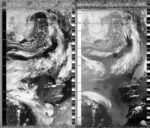
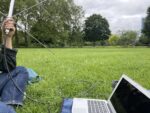
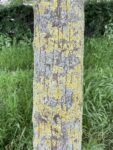
This Monday was full of grey light and low hanging cloud, and after a morning of open-weather meetings, I found myself sitting in the middle of Hackney Downs, happy to be listening to the sound of a satellite but craving some colour. On my way back from the park, a bright burst of lichen caught my eye. I identified the species (or 'collaboration' between species) as within the family of Teloschistaceae which really refers to a large group of mostly lichen-forming fungi that have a 'cosmopolitan distribution' (meaning that they can be found in most places around the world, much like the pigeon and the orca). Most members of Teloschistaceae are lichens that either live on rock or on bark, but about 40 species are 'lichenicolous' – meaning they are non-lichenised fungi that live on other lichens. Apparently, in Spain, a member of this family of lichen-forming fungi has been included in wine-based decoctions for menstrual issues, and infused in water as a remedy for kidney and tooth ailments. Later in the day, I bought raspberries and blueberries entirely because of how they glowed bright-red and blue-purple in the fruit section of the local market.
2024-08-08 23:17:13
Sasha Engelmann
Lignano Sabbiadoro , Italy
Italy
NOAA-18

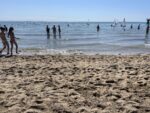
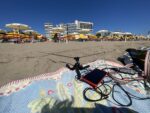
Acqua! ventisei. Sabbia! trentasette. (Water! twenty six. Sand! thirty seven). A voice called out the temperature of sea and land on a loudspeaker at the beach of Lignano Sabbiadoro on the Italian coast. I placed my towel on the sand next to a lifeguard station and felt the heat. People were running from their umbrellas to the sea (sometimes carrying small children) as the sand burned underfoot. I debated trying a satellite pass, decided not to in this unlikely location, and finally thought I’d try. Something about being in a swimsuit with the ground station immediately felt weird! My radio antenna got the attention of many, even at a distance - I caught several men with beer-bellies and leathery skin staring at me. Sadly I didn’t catch any signal - I had a big view of the sky, and checked and re-checked my settings, but it was difficult to see the tiny numbers in the android radio software in the sunlight. I decided to try again later, and I ended up catching a pass late at night from the balcony of T’s mom’s apartment. The shadowy form of the boot of Italy appeared in the infrared channel, lighter than the water (and therefore cooler). This puzzled me until I realised that land loses heat faster than water; the sea ‘holds’ it.
2024-06-02 13:03:32
Sasha Engelmann
Hackney Downs, London, United Kingdom
United Kingdom
NOAA-18

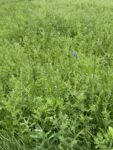
My arms and legs are scraped from nettles and bracken after an afternoon at Richmond Park, but I feel so happy to have these reminders of a day among the oaks, elms and white-tailed deer. After I captured a hurried satellite image from the middle of Hackney Downs, my partner and I took a long overground train from Dalson Kingsland to Richmond station, and once in the park, we followed several trails away from the central lake and 'acid grassland' where most people congregate. The park was golden and shimmering in sunlight, and the greenness of everything was 'overwhelming' as my partner put it. Lying on a log in the sun, I opened my eyes to see a hawk making circles overhead, barefly moving a wing-feather. I heard a sound like a sneeze, and looked to the right, spotting a doe with two fawns. Lime green parrots talked excitedly in the branches and zipped from gnarly twig to tree trunk. A spider with a large bulbous abdomen scrambled over my leg.
2024-06-01 11:34:03
Sasha Engelmann
Hackney Downs, London, United Kingdom
United Kingdom
NOAA-18
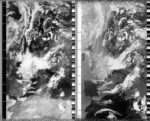
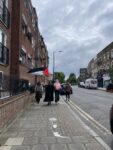
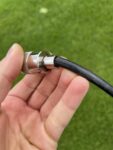
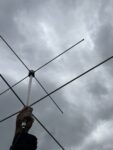
As I begin the satellite pass, a young group of friends pass by, and one asks whether I am responsible for the pile of soccer balls a few metres away. This is a little funny, as there is an active young boy's soccer game on the field where we are standing, and I doubt I look much like a soccer player with my radio antenna. A young woman in the group yells to ask what I am doing, and after my one-sentence answer, they turn away and proceed to set up their picnic toward the south edge of the field. As I am packing up ten minutes later, though, the woman runs over and asks to see the image. She is joined by another friend. As I show them the enhancements of the image data, she remarks on the jagged coastline of the northern part of Norway, and the western edge of Scotland, wondering aloud whether the coasts are so complex because they receive the wind of the North Atlantic, whereas the east coasts are 'smoother' because they are more sheltered. As she speaks I admire her sparkly turqoise eyeliner and try not to stare. They are especially impressed by the colour infrared image of the highest cloud tops. They joke about how many times I must have explained this to other people in the park, and it's true, I say, I've met more people in the neighbourhood by waving an antenna at the sky than I might have by going to town hall. Half an hour later, I actually do join a Palestine march to Hackney Town Hall, following the echoes of protest chants through grey skies and an unusually cold wind.
2024-05-31 10:32:35
Sasha Engelmann
Burgess Park, London, United Kingdom
United Kingdom
NOAA-19

Today I am striking in solidarity with Palestine together with other UK-based practitioners and organisations. The strike is organised by Mosaic Rooms and Migrants in Culture, specifically calling for groups and individuals engaged in cultural work to withold labour today, May 31st. My academic work as a cultural geographer is part of the cultural milieu in the UK, as I publish open access articles related to artworks, artistic collaborations and networks. Though open-weather is a fragmentary, precariously funded cultural project, it does participate in the cultural sphere. In lieu of a long-winded 'weather note' or working on a new academic article, I am spending the day doing the following:
- Building an open access resource library on Palestine Geographies
- Emailing my union on moving forward a public statement on Palestine
- Engaging with and applying resources on university action by University and College Workers for Palestine
2024-05-30 12:03:48
Sasha Engelmann
East Park, Southampton, United Kingdom
United Kingdom
NOAA-18
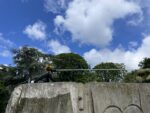
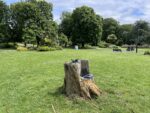

Wind is the subject of a half-day symposium at John Hansard Gallery in Southampton where I am presenting on behalf of open-weather. I am looking forward to the constellation of academics, scholar-artists, and members of the public who are going to share new work and join the conversation. A scientist called Richard Cornes from the National Oceanography Centre talks about histories of weather observation gleaned from the diaries of French and English scientists who kept careful records of temperature and pressure. An artist named Abelardo Gil-Fournier who has just co-written a book with Jussi Parrika presents his sculptures and experiments in the cinematography of wind. Scholars Maximilian Hepach and Bergit Schneider examine the diaries of John Muir, the drawings of Da Vinci and the paintings of Van Gogh to 'read one elemental media ecology against another', for example reading air through a description of ice in Muir's semi-spiritual field notes. JR Carpenter and Jules Rawlinson perform a sonic, poetry and visual piece called An Island of Sound featuring fossils, nautical charts, wind roses, walruses and other characters. We all stay out late at a local pub chatting and catching up, and I am filled with the nourishment of ideas, new reading recommendations, academic gossip, the sharing of intellectual projects and agendas, and generally feeling like we are all participating in an intellectual project around air, weather and wind. As I am rarely in a room with so many fellow air and wind scholars there is something momentous about this, and I am reminded of the ways that scholars used to travel for days, over hundreds of miles on land, to attend conferences together, to feel like they were taking part in a common project. I am by no means naive to the eliteness and exclusivity of this history, but I remind myself that it is also OK for today to be about the joy of shared and generous participation in overlapping academic work.
2024-05-29 12:11:41
Sasha Engelmann
Hackney Downs, London, United Kingdom
United Kingdom
NOAA-18
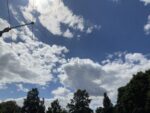
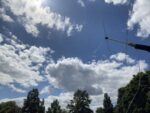
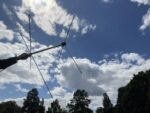
I have been thinking a lot about how scholars, artists and others investigating air try to 'substantiate' it in their work. In a chapter on 'Air's substantiations', anthropologist Tim Choy makes an analogy between a scholar/artist/practitioner studying air, and a PM sensor on the roof of a building. He writes, "enclosed machines on rooftops and streets ingest millions of mouthfuls of wind a day, calming it so that the particles it holds can be collected to count, to accumulate enough of the particular for it to register as weight, as substance worth talking about" (2011: 146). Choy continues, "miming this method, I collect the details in a diffuse set of contexts" to "turn the diffuse into something substantive" (2011: 146). This comes after a discussion of the ways in which air invites us to trouble binaries of the particular and the universal in cultural theory, both of which end up reifying solidity and 'ground'. 'Miming' the PM sensor, though, aren't we, as scholars and other practitioners, largely falling into the trap of 'particularising' air, counting particles so that our analyses add up to something worthy of empirical and conceptual attention? As I read across social science and humanities writing on air, I notice how often the 'particle' comes up, even when people are exploring the meso-scales of topics like breath and policy brutality. Is there something also about the outpouring of scholarly and artistic work on the citizen science of air quality that makes us feel we can and should be counting particles, even when that's not what we are doing? What if, in efforts to 'substantiate' air, we paid more attention to the fullness of air's aesthetics, its movements, gradients, vacuums, and porosities... the emptiness in between loosely tethered molecules? Rather than 'mouthfuls' of particles we might be substantiating something closer to texture, impressions, traces.
2024-06-10 12:25:53
Ray Dyer and Soph Dyer
Mošćenička Draga, Croatia
Croatia
NOAA-18
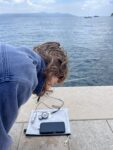
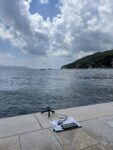
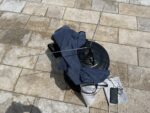
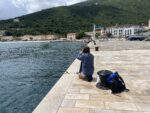
I am on holiday with my sister, Ray, and her partner Ben. When we check into our Airbnb the host, a women a little younger than our mother, apologies for our "bad luck" with the wet weather. We engage in pleasantries about how unpredictable the summer has been, and wet and warm the spring was. "We are not looking after Mother Earth", our host concludes. Her tone is serious. I think I detect fear, but cannot be sure. We say that "we do not mind", that "we will swim anyway", because "we are from the North".
2024-08-03 22:39:31
Soph Dyer
Lacknergasse, Wien, Austria
Austria
NOAA-18
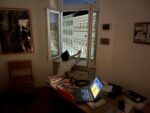
Still, mild, mottled clouds. Clear air. By contrast, there is so much to write about the turbulent, changeable weather of last week. And, yet, I know some weather is ineffable or Unwetter. Together, Sasha, we altered each other. My hormones were so low (by chance) and I was grieving how my body will be changed by the coming operation. You tried to lower the waves of adrenaline and cortisol with empathy, touch and grounding words. It worked, to a point. We were what M Murphy, co-director of the Environmental Data Justice Lab, calls "endocrine participating" (Murphy 2024). Yet the estrogen and progesterone in my body refused to join in, staying stubbornly low, disturbing my sleep, making my recall foggy. You felt so steady and strong, but I know that you too were tired and running on empty. Our boundaries, dangerously porous. Yet, in clear breach of feminist protocol, we worked. We worked on this project: carefully dismantling and debugging 3D-printed prototypes, testing digital interfaces, and making logistical plans for when and how to send hardware to far away locations. We swam and drank too many Weißer Spritzers. You tried to order a doppelter Espresso but instead made-up the word "dooblé". We laughed, mixing caffeine with dopamine, oxytocin and endorphins. We laughed too when, during a beautifully intense dance performance, we saw ourselves in the two dancers' energetic, full-bodied exchange. On the way back from lunch, I quite literally fell over your feet, bloodied my knees, and sat wordlessly gulping for air on the pavement. The activities list I drew-up before your arrival is now half crossed-out. Hungry to share, you and I pushed each other, as always. Next time, I hope for fairer weather between us.
2024-08-02 22:55:42
Sasha Engelmann
Kottbusser damm, Berlin , Germany
Germany
NOAA-18
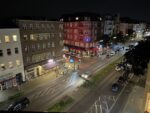
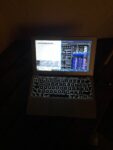
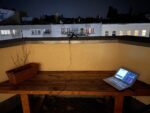
Berlin, Friday night, August. I peeked off the ledge of my friend Omid's fourth floor apartment on the Kottbusser damm, and set up my ground station looking East. The traffic 'rush' sounds below mingled with laughs, drunken conversation and sometimes yells or screams. I noticed how the antenna reacted to the side of the building, the almost-midnight radio environment, and to being hand-held - it preferred the balcony ledge. I had travelled all day by train from Vienna after an intense week of work with Soph, a week in which we ate market-fresh pickles, swam in the Danube, worked like crazy on open-weather, and sat together with pangs of uncertainty about the future, both immediate and further afield. From my midnight perch, I sent Soph a hug and some calm energies through the body-temperature air.
2024-07-26 19:58:20
Marlene Wagner and Soph Dyer
Seestadt, Wien, Austria
Austria
NOAA-19

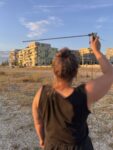
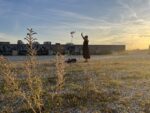
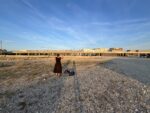
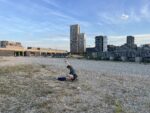
Warm wind, residual heat. U-Bahn, aeroplanes, kids on the beach, gravel under our feet. Long shadows where the city meets the landscape.
2024-07-26 10:48:57
Sasha Engelmann
Hackney Downs, London, United Kingdom
United Kingdom
NOAA-19
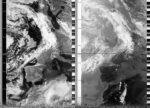
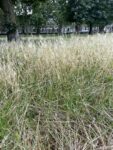
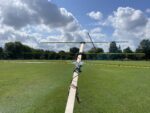
After another colder, misty and rainy day yesterday, and intermittent dark and gloomy clouds this week, it is a relief once again to feel some sun. The air is relatively calm, and a high altitude cirrus or haze makes the light a bit silvery. The ground is still moist in places, though elsewhere the grass has dried and turned a light beige. As I walked down the steps of my and T's house, a man on a bike, whose name I later learned is Duane, did a double take, then stopped and said he had seen me many times in Hackney Downs, and wanted to know about my Yagi antenna. We chatted briefly and, though he had to go toward Clapton, he said the next time he saw me in the Downs, he would come over and see what I was doing. We shook hands twice before parting. As I was leaving the Downs after the pass about twenty minutes later, an older man called out to me. He said he lived close to Hackney Downs and had seen me many times with the antenna, and now wanted an explanation. I showed the satellite image I had just live-decoded and he mentioned his own work as an artist. As his hands were trembling, he asked me to type in the open-weather website to the Notes on his phone.
2024-07-24 10:38:20
Soph Dyer
Danube Canal, Wien, Austria
Austria
NOAA-19
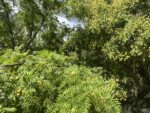
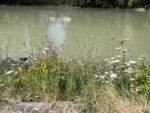
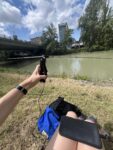
The sun went in and out flooding the lush foliage in a dramatic yellow light. I had run out of time to reach the park, so carried my bike down a flight of steps to the bank of the Danube Canal. To my right two, trees that I did not recognise bore seeds and globe shaped fruit. The uncut grass next to the water's edge was flush with wild flowers. Up stream, almost under a road bridge, a woman wearing a hippy paisley print vest was collecting something from the bank, slowly filling two plastic shopping bags. I assembled the antenna unhurried with the knowledge that in my sunken position the satellite would take need to be almost overhead before I could receive it. It's transmission arrived earlier than I expected but my phone crashed, corrupting the file and forcing me to restart the recording. Once done, I sat on the bank, listening to the satellite's rhythmic presence and enjoying the cool winds and waters of the Danube.
2024-07-22 19:33:19
Soph Dyer
Park bench, Lackerngasse, Wien, Austria
Austria
NOAA-15

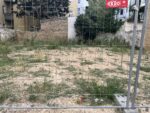
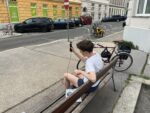
What I thought was the beeping of a heart monitor was actually the beeps of a pedestrian crossing. I feel hollowed out. Heavy and exhausted, I sit on the street corner bench. I began the satellite pass stood next to the empty plot beside our house but moved because there was so much radio noise. It has become a mysterious fact that, since the block of flats that stood there was demolished last summer, the void has been filled with radio waves. I imagine live electrical cables buried under the compressed rubbled. Electric snakes hidden under shattered brick. This image has stopped me from venturing behind the flimsy construction site fence to pick wild flowers. A woman walking to beautifully glossy dogs stops to ask if I am listening for bats. For a moment, I wish that I was engaged in a short-range, in-situ sensing that could connect me more directly to the nature that surrounds me. Before the building was demolished there was a large bat population. No, I say, weather satellites. Man-made, metal birds, a thousand kilometres away. One of the three sisters in my building passes and asks what I am doing. I offer a less than satisfactory explanation as I have decided to rush to the nearby supermarket before it closes to buy a 'sports drink' in an attempt to replenish the electrolytes in my body.
2024-07-23 12:28:13
Sasha Engelmann
Tide Square, North Greenwich , United Kingdom
United Kingdom
NOAA-18

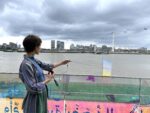
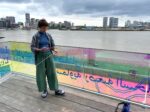
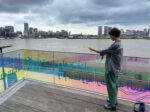
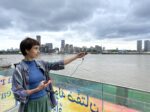
We woke up to dark skies again, but the air remained warm, humid. On my way to Southwark Bridge for a morning appointment it began to drizzle-rain and city-workers clutched their goose-bumped arms. Hours later I unfurled my antenna on the 'Tide River Walk' in North Greenwich, and almost immediately began to hear and receive an air traffic control downlink on a frequency overlapping with that of NOAA-18. A young man agreed to take some photos, and then went back to leaning on the railing, meditating on the water. Charli XCX's 'Brat' bounces through my headphones for most of the afternoon as I ride the overground and express mail some open-weather kit to Berlin. "When you're in the party b-b-bumpin' that beat / 666 with a princess streak..."
2024-07-22 11:37:21
Sasha Engelmann
Hackney Downs, London, United Kingdom
United Kingdom
NOAA-19

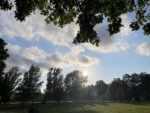
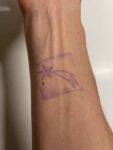
It is very windy today - the kind of surprising wind that gusts and blows in corridors. It was a struggle with my Yagi antenna, as it catches the air so easily, and at several points almost took me sideways with it. The tape measure joints swung at odd angles from the wood stick. An older woman and a small, white, curly haired dog were meandering nearby and I waved to say hi. We ended up speaking for most of the satellite pass. After considering my antenna for a few minutes she said: "the satisfaction... it gives satisfaction" and then "it's contact". I completely agreed.
2024-07-21 18:59:29
Sasha Engelmann
Hackney Downs, London, United Kingdom
United Kingdom
NOAA-15
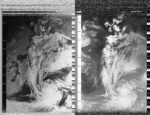

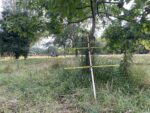
I wake up having had a nightmare, but it is really a memory of a real event that was playing out in my dreams. In the memory, I am seeing one of my PhD students get publicly attacked by a senior professor (who is also someone I respect and in some ways depend on). I run through all the ways I could have acted differently in that moment. I visualise myself standing up in front of the room and hitting back. It plays and plays, until I manage to have breakfast. By lunchtime, though, I am lost in the flow of an article I'm trying to finish before holiday. As a visual contribution to the article, after lunch I experiment with making a satellite image (one that features a current of 'Saharan Dust' moving northward over the Mediterranean) into a 'thaumatrope': an analog, double sided, spinning device that creates an optical 'illusion' of blurred borders, animated shadows, and miscible surfaces. It feels good playing with a satellite image not on a digital screen (as I overwhelmingly do in open-weather) and rather in tactile, DIY form, using a tool that is reminiscent of children's games. For me, the thaumatrope creates a kind of optical 'irritation' of moving forms, nebulous shapes and shadows, and disappearing or fading-out land and sea edges. It also seems to 'agitate' the cartographic orientation devices that we use when we see the coastline of North Africa and the 'boot' of Italy. Writing of images of the monsoon, Harshavardhan Bhat writes, "Satellite images empowered by spectroradiometer science and international coalitions begin to not just inform the science of the state but the imaginary that the monsoon unifies the entity called South Asia as part of a planetary system... This is a gift to political theory as the monsoon then becomes this technology through which the planetary infrastructure of surveillance and governance slowly unfold, silencing the complex work of the air of the monsoon" (2022: 240). Does the thaumatrope help to destabilise the 'unified entity' of the Scirocco or Jugo wind that brings 'Saharan Dust' to Europe? Does seeing a satellite image flicker and blur between channels demonstrate something about the 'slippages' of materials and elements in satellite imagery, inviting us to see beyond the 'optical ontology of pixels'? In contrast to a regional 'event', can we recognise something about the 'complex work of the air'?
2024-07-20 21:11:38
Soph Dyer
Postsportverein, Wien, Austria
Austria
NOAA-19
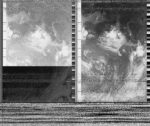
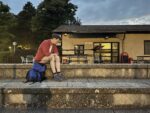
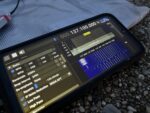
A welcome overcast day with light rain. Inexplicably, I heard air traffic control on the same frequency as the satellite NOAA-19. I was sitting on the concrete bleachers of the local sports ground, beneath a GSM mast for mobile (cellular) phones, but I cannot think think that could have had an effect. The transmission seemed too strong to be a harmonic. Decreasing the bandwidth to exclude the noise worked well. I feel lethargic.
2024-07-19 11:37:22
Sasha Engelmann
Hackney Downs, London, United Kingdom
United Kingdom
NOAA-18
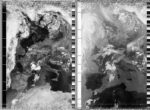
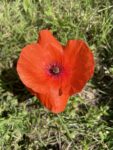
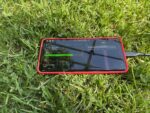
It was too hot to be in the sun so I perched on the edge of a pool of shade made by a plane tree. A man in a track suit who is a kind of local figure in the neighbourhood - often seen balancing on post boxes, tall gates and bus benches doing dance moves that resemble Tai Chi, always in a full track suit - walked by, waved and said 'So I expect you're listening to the Gods??' 'Yes sort of!' I replied, hoping he would understand I was joking. 'Nice one!' he replied, and then followed with "I like your glasses!!!'. 'Thanks!' I said, and remembered how I had gotten my sunglasses at the 'Accessorize' shop in Kings Cross station while waiting for a train a few summers ago. Another man in a neat vest, jeans and glasses approached me a few minutes later and quietly asked what I was tracking. After I replied, he exclaimed 'And I thought I had an interesting job!!' 'What's your job?' I asked. He said 'Oh I park cars... BMWs... train driver too'. He went on his way.
2024-07-19 12:35:34
Soph Dyer
Augarten, Austria
Austria
NOAA-18
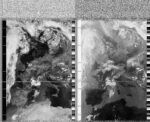
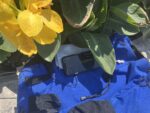
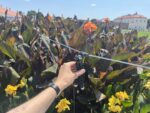
Blue sky, hot. The city is heating up again. Yet the park, usually busy on such days, is quiet. Presumably many residents are already on holiday. Summer holidays are taken seriously in Vienna. Its shops and restaurants can shut completely, sometimes for more than a month, only reopening in September. This ritual of city life and work grinding to a halt in high summer as people take in long holidays, is a side of Austrian culture that is, perhaps, less well know and more associated with our hotter neighbour, Italy. I hide the ground station's hardware under the shade of a plant, and limit my time in the sun by leaving as soon as the satellite pass is over. I am tried and a little nauseous today, but in the openness of the park these feelings are less.
2024-07-18 11:51:41
Sasha Engelmann
Hackney Downs, London, United Kingdom
United Kingdom
NOAA-18
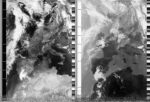
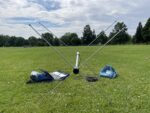
I've spent all day writing, and my thoughts are swirling around ideas of memory, wind, history, and the way wind makes 'traces' and 'marks' in satellite imagery. The article I'm editing feels to have its own weather too, one of 'rabid gales', blue vanishings, wind-blown dust, 'pigments and mist' and vast differentials in temperature and pressure, pulling air into all sorts of space and corners.
2024-07-17 10:58:28
Sasha Engelmann
Founder's Field, Royal Holloway University of London, United Kingdom
United Kingdom
NOAA-19
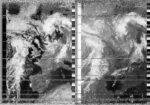
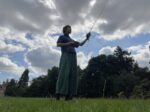
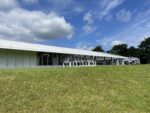
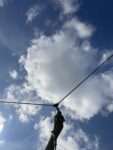
In the field that has been turned in to a parking lot for university graduation services, I link up my v-dipole, dongle and android. A maintenance man or security guard sitting in a blue van looks on with a bemused expression, but mostly he ignores me and talks on the phone. The air is warm for the first time in weeks and it is such a relief from the cold, rainy, at times torrential rain we have had in the U.K. Later in the afternoon I show my satellite image to SB, a physical geographer who specialises in studying past climates through tephra (volcanic ash). He points to the wavy line of the increasingly wobbly jet stream and explains how, with the poles warming faster than the equator, the difference in temperature and pressure that stabilises weather and holds the jet stream north is decreasing, causing the jet stream to curve and bend south more and more, bringing moisture laden air from the Atlantic to Northern Europe - this describes our recent weather experiences. Now that I’ve seen the curve of the jet stream with SB’s help I want to look back to all of the past imagery and try to spot it. Meanwhile, he says, ‘anywhere below 40 degrees (latitude) is burning’. Soph is just back from holiday and describes a level of heat in Croatia over the last week that was at the limit of their physical health. It doesn’t take much for heat to stress London- on my tube journey home, the air is so stifling that people are visibly haggard, some using makeshift fans and others flushed read and eyes closed, waiting for their train.
2024-07-16 12:15:09
Sasha Engelmann
Hackney Downs, London, United Kingdom
United Kingdom
NOAA-18
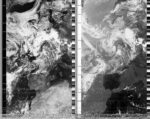
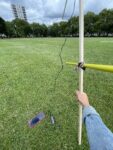
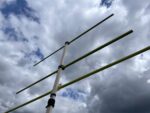
It poured last night, the kind of rain that quickly overwhelmed London's drainage system and caused pond-sized puddles on street corners and walkways. Somewhat fittingly, T and I were drenched in it while cycling home from a 'psychoanalysis and climate disaster' seminar at a pub in Finsbury Park. The conversation had been circuitous, and the speaker, a Lacanian psychoanalyst, had shared her research about the shift toward spiritual activism and intentional communities in Portugal testing different forms of spirit-informed collectivity. She kept saying that this research, or the research materials themselves, were 'embarrassing'. This was raised in the discussion- what is the root of our embarrassment when we talk about somatic practices or dance forms that give us more awareness of each other, or spiritual practices that give us room for wonder? Someone raised a theory from a source I can't remember that the earth has created beings with fully self-conscious brains - capacities to be embarrassed - in order to self-destruct on a planetary level. No reference was made to the many forms of human awareness and community that have not self-destructed, that are still trying to prevent destruction. I felt uncomfortable raising this point in the midst of so many unfamiliar, intimidating people, and because who am I, a white academic, to be the one to say 'aren't we forgetting indigenous lifeways and laws' when we theorise self-conscious self-destruction? I was reflecting on this during my satellite pass today. In the middle of it, two tall men in black t-shirts and knee-length shorts walked across the field staring at me so I smiled and waved. They came over and started asking questions. I was sitting on the grass holding my antenna upright and listening to the sound of the satellite on my Android phone. They approached very near but stayed standing, so I had to look vertically upward to see their faces. Their tall, looming shapes were outlined against the bright, cloudy sky. As I explained the tape measure Yagi and the passing satellite, one said, 'So are you an artist?' I keep wondering what sparks this question, as I have received it repeatedly over the last six months. Is it the fact that I use the word 'DIY'? Is it that I don't look like the type of person who is doing research or science?
2024-07-15 12:25:50
Sasha Engelmann
Hackney Downs, London, United Kingdom
United Kingdom
NOAA-18
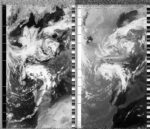
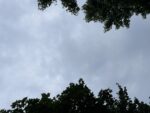
Low-hanging, medium-grey cloud with a light drizzle that grew into light rain as I knelt on the grass. The sound of a car-sized grass mower in the distance. Damp ground. Despite the un-summerlike conditions, the park was full of primary school children running races and exercising. As soon as one group saw me and came over to ask what I was doing, I became a magnet for others. One girl asked if I was 'traveling the world... with that thing [pointing to the antenna]?' I said in some ways, I was, but also, I was just listening to the world. Another small girl simply picked up my antenna and raised it to the sky, winking slyly at her friends, while the accompanying adult said 'you should ask first!'. But I appreciated their forwardness. As they huddled around, I showed them the growing satellite image and pointed to different countries so they could try identifying them. The answer was 'I don't know... ' until it turned out they did know. Among the parents or chaperones, several asked further questions and wanted to know how to follow the project. I had to hurry to pack up in between two waves of visitors to avoid disappointing anyone.
2024-07-14 12:40:13
Sasha Engelmann
Hackney Downs, London, United Kingdom
United Kingdom
NOAA-18
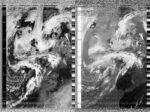
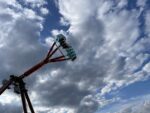
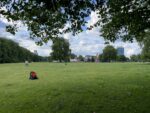
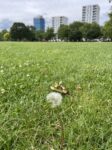
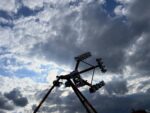
In 1989, Derek Jarman wrote of a day in July: "Lazy high summer. The drowsy bees fall over each other in the scarlet poppies, which shed their petals by noon. Meadow browns and gatekeepers flutter wearily across the shell-pink brambles disputing the nectar with a fast bright tortoiseshell. The bees clamber hungrily up the sour green woodsage. Drifts of mauve rosebay and deep yellow ragwort studded with orange and black burnt caterpillars" (Jarman, 1991: 107). This morning I read an article in the Guardian about the rate and long-term advancement of mass insect death. Based on research on the number of insects killed on the number plates of cars, the study says we have 90% fewer insects in the UK today than we did 100 years ago. During the satellite pass at midday, I note how the recently cut grass of the park has given way to a low layer of clover and dandelions, and how bees fly between the clover, only a couple centimetres above the grass, sometimes bumping into each other and weaving between the higher leaves of grass. Other than the random lazy fly, I don't see any other pollinators. Butterfly populations are especially affected this year, apparently, in part due to the very wet spring-summer that has washed out many of their homes. Derek was already aware of the changing climate in 1989, as he sometimes mentions the warming air and the 'hole in the ozone layer'. I wonder if he knew about mass insect death, though from his descriptions of the cottage garden in Dungeness, he was seemingly at home with a kaleidoscope of insect companions.
2024-07-13 12:52:06
Sasha Engelmann
Hackney Downs, London, United Kingdom
United Kingdom
NOAA-18
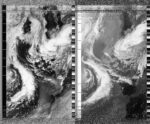
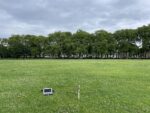
Grey, clouded, though lighter than yesterday. I noticed a thin, middle-aged man sat on a bench was watching me with my Yagi antenna. When I set my antenna down at the end of the pass, he walked over. He started with 'Just checking... you were tracking UFOs with that thing?'. I smiled and waved my hand in a 'sort of' gesture. As he turned to walk away I said 'I'm happy to show you what I've got?' and he veered back and sat on the grass near my laptop. We looked at the satellite image together. I pointed at the outlines of France, Spain and North Africa. He exclaimed 'Oh yeah, you're into weather!!' and he added 'I'm into weather too, always have been!'. 'How come?' I asked. He replied 'You can spell Rain, Cloud and Sun with my name... also Oak, Acorn... all the elements!' 'What's your name?' I asked. He replied 'Frances S ...' and a last name that I don't recall that begins with a 'K'. 'All the elements, then!' we laughed. He said 'Well keep lookin out for those UFOs' and I replied 'If I listen to any, I'll let you know!' And off he went, walking fast, south into the park. As I packed up I heard him yell to a man on a bike 'EH!! you have a GOOD DAY!!' As I walked home I thought about which elements I could spell with my name. By counting my middle name (Hildegard) I came up with 'shade', 'shine' 'hail' and 'snail'...
2024-07-12 10:20:14
Sasha Engelmann
Hackney Downs Funfair, London, United Kingdom
United Kingdom
NOAA-19
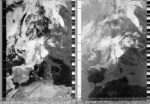
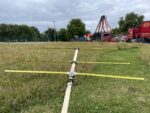

Low-pressing grey again. A feeling of melancholy. I'm missing Soph's presence on zoom calls and text channels. I go searching for the funfair in the northwest corner of the park. It has not yet been activated, but I can see people walking around inside, checking and testing things. I capture a satellite image with my Yagi antenna and Android phone, kneeling in the yellow grass. After the pass, I circle the perimeter of the fair, and notice that there is a line of trailer vans and mobile homes on the far side, facing the overground train tracks. Laundry is flung on the metal fence that divides the funfair from the park, or on small drying racks set up outside semi-ajar car doors. I hear a man speaking at an elevated volume on the phone. He says something like 'I thought I had 2 points! where are my points!' I realise, then, that the funfair is an entirely mobile operation: all the big machines are transported on two very large, glossy red trucks, but the real 'infrastructure' are the staff who likely follow in their vans and mobile homes. I wonder how many places they go. As I walk back to Downs Road I pass a couple walking their greyhound. As I pass I can hear the woman say to her partner 'Oh yes that's the lady with the...'
2024-07-11 11:35:36
Sasha Engelmann
Hackney Downs, London, United Kingdom
United Kingdom
NOAA-18
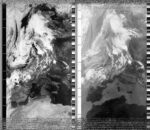

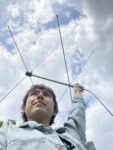
As we lift the blinds in the morning, T says 'what does it mean if the sky is blue!? I don't remember...' and we laugh at the fact that we have not seen a sliver of blue for what seems like weeks in the middle of the UK summer. A funfair is being constructed in Hackney Downs: the rides, swings and other contraptions make silhouettes against the blue on one side of the park. A man comes over to speak to me during the satellite pass, and comments 'you know I see people doing all kinds of things in the park - sitting, walking, like them [motions in the distance] but I never seen this!'. Later in the day, as we are cycling home from a pub on Columbia Road, the black outlines of the funfair machines, resting silently in the park, remind us of a horror film.
2024-07-10 12:25:14
Sasha Engelmann
Hackney Downs, London, United Kingdom
United Kingdom
NOAA-19
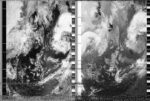
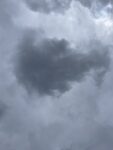
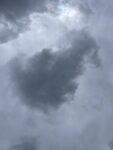
It is a grey, energy-less, dark-clouded day. My thoughts, however, are with the pale blue skies, swift winds and coastal swamplands of Buenos Aires as I re-read my field notes written during the month of fieldwork I carried out there last spring. As I make my way through my fast cursive handwriting, sometimes having to puzzle at words, I remember how breathlessly I wrote these notes, trying to record and remember everything. It mostly works. As I close-read, I am transported visually and sensually to Villa Inflamable, the community close to the centre of Buenos Aires that is the site of the research I am doing with a team of collaborators in Argentina. My colleague / friend Joaquin had taken me to VI after a morning spent on the rooftop of my other collaborator, Debora, eating pancakes and experimenting with radio antennas. There was not a speck or glimmer of cloud in the sky- and it was a wide open horizon. It took Joaquin and I only 12 minutes to drive from Debora's house to VI. My field notes read: "We arrived in the midst of heavy vehicle traffic - large tank trucks, mostly with Shell on them, entering and leaving the petrochemical facility. We passed to the right of a large sand dune - a sand production facility- there were thick clouds of dust in the air". From the open clarity of Debora's rooftop, it was a different experience being on the ground in VI. We walked around the neighbourhood with Claudio Espinola, a long-term activist and organiser in the community who also helps to ration water to families (the 'running' water is undrinkable, so families get a number of bottles of water per week). VI, like much of Buenos Aires, is on marshland, and we passed many pools of water and algae-covered ponds. The streets had been recently paved, but this had caused water-runoff problems and a man in a car told us he would prefer the dirt road if the sewage would not flood the streets. Later, as Joaquin and I left Claudia and made our way to an air quality monitoring station not far from the community, "We passed a plant that Joaquin suspects is where they began burning medical waste during the pandemic. It looked very old and dilapidated. Joaquin suspects that environmental regulations were relaxed during the pandemic to enable the repurposing of these kinds of incinerators. We also passed a smaller river - maybe 20m wide - that looked like slow-moving cement. There was on oil slick on top. Claudia had compared the river to cement too". I thought about who made the decision to start burning medical waste in an out-of-order incinerator in an already impoverished and environmentally stressed community like VI. I thought about what it takes to turn a river into cement. I also thought about the divergences in the experiences of people in this community and those only a few blocks away, somewhat sheltered from the 'weather' of the petrochemical facility. I thought about the 'weather' of Villa Inflamable, the weather of flammable. In a recent article on perceptions of air in Mumbai, two scholars write: "For the state, flammability is the result of the residents themselves. It is them, and their forms of work, that create fire risks, and so it is they who need to be removed. Residents, on the other hand, attribute causality to the gases that the garbage ecology itself produces. They are acutely aware of how the state has aligned blame in an opportunistic way with them rather than the material hazards of place, poverty and labor" (Tripathy and McFarlane, 2022: 12). From my fieldnotes alone (and without any experience of living in VI) the causality of the environmental toxicity in the neighbourhood is shockingly clear, yet my colleague Debora has written extensively of the 'labour of confusion' produced when residents of VI are told their environment isn't so toxic, or that nothing can be done about it. This is about perception indeed, and it is about whose perceptions are taken to mean 'truth' or 'causality' and whose are seen to trouble the order of things. I spend most of the day co-writing a draft chapter with Debora, returning in my memory to VI, trying to articulate in words the causalities and breathing relations at work there.
2024-07-09 12:01:53
Sasha Engelmann
Hackney Downs, London, United Kingdom
United Kingdom
NOAA-18
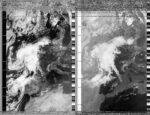
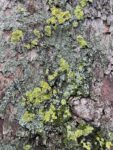
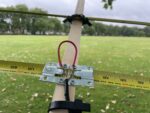
The gloomy weather in London persists. Yesterday, upon return home from the Isle of Wight, T and I joked that it felt like the summer was already over- our holiday had lasted two days, and now it is October again. It feels surreal to think that we still have some time in the Adriatic planned for later in the summer. It feels surreal to think of a 'normal' summer at all, at this point. I spend the morning organising open-weather finances in the university finance system called, fittingly, 'Agresso'. I manage to extricate myself from Agresso to go outside for a satellite pass- finding a slow, languid drizzle. Under a tree in the east-side of the park, my Yagi struggles to pick up the signal in the beginning of the pass, as if even the radio spectrum is sluggish, radio waves moving slower than the speed of light through this water-logged air.
2024-07-08 12:50:43
Sasha Engelmann
Ferry from Ryde to Portsmouth, The Solent Channel, United Kingdom
United Kingdom
NOAA-19

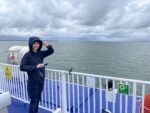
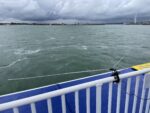
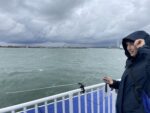
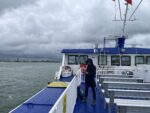
We made the 12:45 ferry to Portsmouth with one minute to spare, and opted for the 'sun deck' despite the total absence of sunlight. The deck felt more inviting than the humid, dark interior of the boat with airplane-like seats and sullen-looking people. We ate cheese and pickle sandwiches that neither of us liked very much. A NOAA-19 pass began just three minutes after the boat's departure. Though the maximum elevation was only 18 degrees to the west, I decided to try anyway, having never received a satellite image while moving in water! It worked far better than anticipated- I curled the legs of the V dipole antenna tripod around the metal railing, and a few minutes later the signal was ringing-in clearly. I wondered how my trajectory on the boat was affecting the image reception, if at all. A young man who had also come up to the deck asked if he could take a photo of me with his analogue film camera. He had travelled to the Isle of Wight for the weekend to 'see the stars'. Yet he also admitted to being 'very out of it' and having had 'little sleep'. He lamented the rise of Starlink and the other ways we are 'ruining the planet', and didn't say much more. When we approached the port, the clearly audible signal of NOAA-19 cut out sharply for a few seconds, so much so that I briefly wondered whether the satellite had stopped transmitting or glitched for these seconds. My experience of noise is normally a little 'softer', more like a gradient than a cut.
2024-07-07 12:31:03
Sasha Engelmann
Buddle Inn, Niton Undercliff, Niton, Isle of Wight, United Kingdom
United Kingdom
NOAA-18

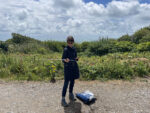
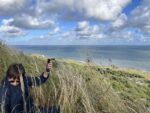
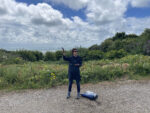
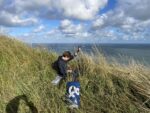
Crawww crawwww the crows spoke as they lifted and tumbled off their roosts along the cliff edge and fell into the strong westerly wind as if it was a blanket, finding shape as a flock seconds later. T and I were several hours in to a hike along the coastal path of the Isle of Wight and the silvery sea was shadowed by elaborate fast moving clouds. The weather forecast had predicted rain and yet we were in the sun most of the day. Our shoes and hands were speckled with the chalk that is characteristic of the island, and our legs happily tired. We learned about the local footpaths and the 'right to roam' across farmland. We also learned about the nettle and bracken that tower several metres high at points along the coastal edge, and send spikes into our ears and our shoes. We learned about some of the locals, too. Earlier in the afternoon, as we paused along the edge of a road to discuss our route, an older man tending a garden asked where we were from and if we needed help. We said we were from London. He said 'no your not!' so we had to explain further. The previous day, in the toilets of a seaside cafe, a bride-to-be looked at T and cried out very loudly and mockingly - 'are you a BOY or a GIRL??!' T found it funny. I ran through angry retaliations in my head for several minutes, then let it go. Back at the cliff, we lay in the tall grass as the crows swirled around us and T did some deep listening. I told T that I felt like falling off the cliff, it felt so tempting to follow the crows.
2024-07-05 12:56:19
Sasha Engelmann
Hackney Downs, London, United Kingdom
United Kingdom
NOAA-18

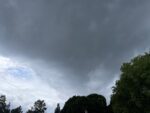
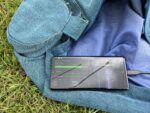
Last night on BBC weather, the presenter kept comparing current temperatures in the UK to what they 'should be' this time of year. The general trend was toward colder, wetter weather across England, Wales and Scotland. London's average in the first week of July is normally somewhere around 24 degrees C apparently, and it is currently rainy and dark, with a high of 18. As he reported this, the presenter even seemed a bit embarrassed, as if it was an awkward secret he was revealing. I met Muffin Man and a new miniature-Pomeranian rescue, Moonpie, out on the downs in the morning. When I went back out in the early afternoon, a very large, triangular rain cloud approached my ground station from the southwest side of the park, and fat drops began to fall on my antenna. They seemed unusually pendulous. I wondered whether warmer temperatures and the current humid conditions mean that drops grow larger before they fall.
2024-07-04 10:18:03
Sasha Engelmann
Hackney Downs, London, United Kingdom
United Kingdom
NOAA-19
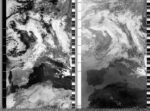
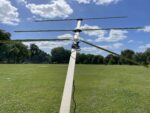
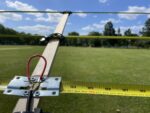
Finally the grey has passed and a crisp wind has blown away most of the low-hanging, misty clouds. The air has a sharp chill, but one that will fade soon, I suspect. I am reminded of Derek Jarman's weather note on June 4th 1989 (from his diaristic book Modern Nature) which, though clearly of another time, place and month, describes today's weather perfectly: "The billowing white flowers along the shore are gone; but the mountainous white clouds in the blue sky and the horses breaking across a silvery sea cheer their memory to the echo. Today wind and sunlight fill the landscape with laughter. An old window opened in the wind and sent the cobwebs flying. The grasses are clapping - even the seagulls loop the loop".
2024-07-03 10:29:29
Sasha Engelmann
Hackney Downs, London, United Kingdom
United Kingdom
NOAA-19
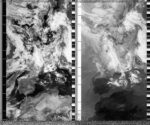
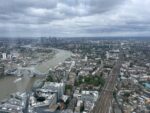

It is another grey, misty and cold-ish day in London. I spend the morning working and take a brief break to capture a satellite image. A curly haired black dog tackles me and rolls around on my laptop as I am mid-pass. His owner looks mortified but as soon as I say it's not a big deal he becomes interested in my antenna, and it turns out he used to be an engineer, working with Radar. We don't speak long. Later in the afternoon, I see the weather from the seventieth floor of the Shard (a sneaky birthday-week adventure with T, who has wanted to go to the top of the Shard for years but is always too anxious of the elevators). We rise sixty floors in what feels like five seconds, our ears popping. At the top, T and I carefully approach the knife-edge, holding on to the metal beams for reassurance. After a few minutes, though, we have our foreheads pressed against the glass gazing in every direction. A stranger offers to take photos of us. Though the view might be more stunning on a sunny day, the changeable clouds and shifting rain are spectacular, and we try to time how long a rainy cloud takes to pass over London. It sort of dissolves rather than making it the whole way. There are only a few other people, and so plenty of space to circle all edges and study all perspectives. Descending, we go on a hunt for an ivy-coloured wall on an old building at Kings College that we could see hidden a few blocks away from St Thomas' street. Once we find the wall, we spend a few minutes admiring the density of the ivy, its even spread and growth over red brick, nearly engulfing the entire building.
2024-07-02 10:41:06
Sasha Engelmann
Hackney Downs, London, United Kingdom
United Kingdom
NOAA-19
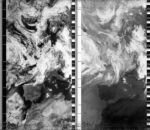
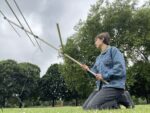
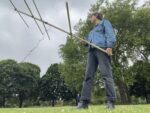
The day starts cold, gray and misty. During the satellite pass, I feel chilly in my Mom's flannel-lined denim jacket, jeans and boots. How is this the second of July, I think. In the slow-loading satellite image, the sun glints tantalisingly, catching its own reflection over the Mediterranean. I am wondering where Soph is at the moment, as they left for a two-week holiday on Sunday. I think somewhere in Croatia, soaking up sunrays and salty air. Thinking about it makes my heart hurt, both with happiness that Soph is there on holiday, but also with a feeling of deeply missing the Adriatic and especially the small bay called Zaraca, near the village Gdinj where my Baba grew up on a remote part of the island of Hvar. Is it possible to miss an atmosphere, or a weather pattern? Is it possible to be nostalgic for places, less through their material surfaces and more through their elements? Having spent so many long summers in Zaraca as a child, having climbed the windy road that goes from the bay to the sparsely populated village Gdinj, with its fig trees and olive groves, with its tunnel spiders catching impossible flecks of dew in the dry landscape and epic cumulonimbus clouds dancing over the Karst rock of the mainland, and wtih its slantwise sunlight that remains until the last drop (since the road climbs on a south-facing slope) I feel so entwined with this weather. It is perhaps easy to say on a day like this in London, as I shiver through my trousers in the first week of July. Yet I think there is something beyond the beauty of Hvar and the Adriatic Sea that I am missing so much. Maybe it's a direction I will always turn.
2024-07-01 10:57:13
Sasha Engelmann
Meadow near the Biological Sciences Bee Apiary, Royal Holloway University of London , United Kingdom
United Kingdom
NOAA-19

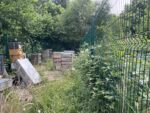
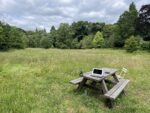
Bees, flies, ladybugs and other insects buzzed around my ground station, located near to the Biological Sciences bee apiary in a meadow on the campus of Royal Holloway. One long-winged fly, looking like a cross between a grasshopper and a moth, landed on my keyboard. Purple-pink cornflowers and daisies bloomed abundantly in the uncut grass. I remembered Jaime Sebastians' story that he had recorded the sound of a NOAA satellite together with the chirping of crickets or cicadas, and he could 'see' the chirrups in the resulting image. I resolved to return to the apiary one day and attempt a recording of both an orbiting satellite and honeybees.
2024-06-30 18:05:38
Sasha Engelmann
Hackney Downs, London, United Kingdom
United Kingdom
NOAA-15


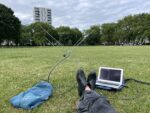
'So humid' proclaims T as we walk to Hackney Central to catch the overground to Stratford on a rare trip to the Westfield Mall. The air is misty with a light rain, though it is just as warm as it has been under bright sun for the last week or so. On the overground, two Moms are taking a large group of young boys paintballing. We arrive at the Mall hoping to be early enough to evade most crowds, but we find we are not the only people waiting for the Adidas store to open at noon. As soon as the metal gates have been pulled back, throngs of people enter, and it is almost impossible to locate and calmly try on shoes. We persevere in JD, Footlocker and Office before both me and T begin to feel physically unwell from the press of the crowds, the 'hall of mirrors' that is every sports apparel store, the stress of finding our way around, and the ultra loud grime tracks that are booming from every corner (though some lyrics have clearly been redacted for children's ears). We flee after no more than 45 minutes and head home, shoeless.
2024-06-29 12:27:48
Sasha Engelmann
West Hackney Recreation Ground, United Kingdom
United Kingdom
NOAA-18

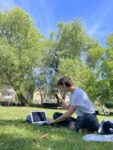
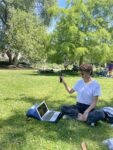
Dalila and I were relaxing on the grass of the garden around the corner from the Stoke Newington Farmer's Market (while I held up my V-Dipole antenna to casually capture a NOAA 18 pass) when a tall man suddenly interrupted us, asking what I was tracking. Within seconds he had laid himself down on the grass between me and D, head towards my laptop, and was asking a flurry of questions. I appreciated his curiosity, but the way he had just placed his body in the middle of our private conversation was annoying. It transpired that he was an academic in the sciences, though I can't remember the exact field, employed by Queen Mary University. When I mentioned later in the conversation that I work at Royal Holloway, he immediately asked "And you live in East London? Why don't you work at Queen Mary?!". I said I would love to have the option of a job at Queen Mary, things weren't that simple! Another tall man came over a few minutes later and asked similar questions, while the first one loaded the open-weather website on his smartphone. Yet as soon as he read the blurb, he exclaimed to his friend "Oh this is not for us... it's a 'feminist experiment'....". I replied actually, it was exactly for them. "I'll have to tie my hair back" said the first man. The second seemed to understand what I had said and backed me up. But at this point my feeling in speaking to them had completely changed- they had now separated me and D, and taken up a long stretch of time, while making remarks like the above. I decided to close my laptop.
2024-06-30 11:34:24
Soph Dyer
Hanging out of the window, sun on my face, Austria
Austria
NOAA-18

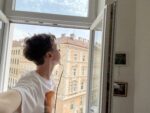
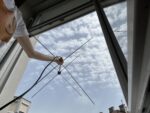
I woke relieved to see a cloudy sky and even a few drops of rain. By eleven o'clock the sky had mostly cleared and the temperature is rising again. I feel the heat on my face as I lean out of the window to receive this image. My left arm turned to jelly as I tried to maintain the pose, thrusting my antenna as far East as possible. The Kestrels nesting in the building across the street made frequent alarm calls. Two flying ants danced around the stone work below me. It's Sunday, but N and I leave for Split by train tonight, so I am working a funding application.
Sasha, I know that my contributions have been inconsistent recently. The pain I have weathered for the last year has surely left it's mark. It is 37 days until the operation.
2024-06-28 09:06:47
Sasha Engelmann
Hackney Downs, London, United Kingdom
United Kingdom
NOAA-15
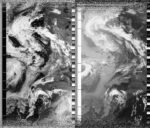
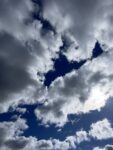
Last night I finished 'The Well of Loneliness' by Radclyffe Hall, first published (and then banned because of its lesbian content) in the UK in 1928. It follows the life of Stephen Gordon, a woman from a rich family who, in the words of the time, demonstrates "sexual inversion" from an early age. Her life story moves from the rejection of her mother and expulsion from her home in the English Countryside, to driving an ambulance in World War II, to moving to Paris where she can live a little more openly with her partner Mary. To find places where they can be and dance in public, Stephen and Mary visit 'the bars' in Paris where queer people can go without fear of prosecution, yet these places are also full of despair, substance abuse and sadness. At the end of the book, and though it breaks her heart, Stephen pushes Mary away from her, as she sees that Mary could have the possibility of a 'normal' life with a man called Martin. In the last few lines of the book, Stephen, in anguish, pleads to God: "give us also the right to our existence!".
I think of how much has changed in the 100 years since the publication of The Well. I can live together with T, I can live an openly queer life, and I can freely access and read this book. Yet the 'pull' of 'normal' has not lost its strength. Society's 'straightening devices' work in new and different ways today, but they still work. Living obliquely or 'slantwise' requires unusual and surprising effort at times. And in an even odder development, queer identities and politics are now being used to 'pinkwash' the actions of corporations or governments committing acts of violence. In many ways, and in Ahmed's terms, society today might be oriented 'to' different things on the surface, but in many ways it is still oriented 'around' the same 'straightening' logic.
2024-06-28 12:01:02
Soph Dyer
In the heat of Augarten, Austria
Austria
NOAA-18

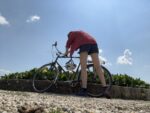
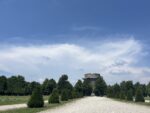
As I write this weather note there is a warm wind and the temperature has dropped. In the park, I could see large cloud to my West. It might have been a cumulonimbus but its top was cirrus-like and its shape not well defined. The heat is waking me early. This morning instead of rising, I read the news in bed. President Biden has performed poorly in a debate about Trump, unnerving even his allies. The American Democratic Party is panicking. If the situation wasn't so terrifying, it would be funny. Writing this note is taking longer that is should as I feel so drowsy. I have drunk a mate tea to wake-up, however it seems to be having opposite effect. The wind has dropped and the sun is shining again. I could fall asleep at my desk.
2024-06-27 20:55:10
Soph Dyer
Sitting on the window ledge, Austria
Austria
NOAA-19

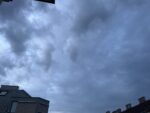

It's a warm evening and the street is loud. Starlings, children, adults shouting, car tyres screeching. The humidity has felt oppressive. As I recorded the image the sky was clouding over. The clouds are dramatic, they look high defintion and high contrast. They are moving quickly. I felt one large drop of rain on my way home, but that's it so far.
2024-06-27 09:35:31
Sasha Engelmann
Between Queens and Schilling Buildings, Royal Holloway University of London, United Kingdom
United Kingdom
NOAA-15

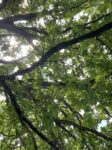
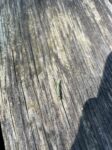
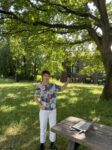
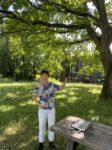
I awoke this morning not having slept because of the heat. T and I had left the bedroom and living room windows open but there was little breeze. In the middle of the night, the bedroom blinds started knocking against the window and I dreamed someone was trying to get in. Foxes screamed (or intensely rejoiced?) at 3am in the garden. In Waterloo station at 7:30am, an old, bearded, probably homeless man stood still with his eyes closed in the middle of the river of city commuters emerging from the tube and walking to the train platforms. I had to cross the current by hopping a few feet at a time through moving bodies in order to speak to him. He had an American accent but I shied away from asking about his origins. He didn't open his eyes when he spoke. By the time I bought him a coffee, he had got another one from someone else. We joked about the double coffee situation before I re-entered the commuter river. When I left he had opened his eyes, gazing straight ahead.
2024-06-26 11:22:27
Sasha Engelmann
Hackney Downs, London, United Kingdom
United Kingdom
NOAA-18
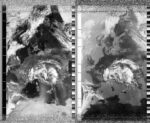
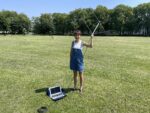
It's a hot, hot, hot day in London. People are bravely tanning on the grass in the park, though I imagine some might be roasting. The moment T and I wake up, we open all the windows in our second floor flat. T says, 'we need a storm'. I had brought out my turnstile antenna because, based on yesterday's image, I wondered if there might be more dust over the Mediterranean, and as the NOAA-18 pass was relatively low elevation (35 degrees to the East) I guessed I would see 'farther' than with my DIY yagi. Was Soph already 'seeing the dust', I wondered? As the pass got started, Nutmeg appeared suddenly, circling my ground station, and I turned around to see Bill and a woman walking toward me. Katherine had been briefed by Bill on my satellite ground station and open-weather, and complemented the project. We agreed that, 'you meet all sorts in this park' and 'you learn so much from chatting to people'. I mentioned my interest in seeing the dust, and Bill asked how many tons of dust actually travel in the air? Millions or trillions of tons? He spoke about an analysis he had seen about how long it takes mountains to erode into the rivers and the sea, and explained how scientists had measured weathering down the Colorado River by stringing a kind of line across it and taking many disparate measurements over time (I think). The takeaway was that it will take many millions of years for the mountains to return to the sea, but it will happen eventually! Bill asked whether my laptop was overheating, and I knelt down to hear the internal fan whirring at a high rate.They stayed a few more minutes before Bill said he needed to take Nutmeg to the shade. Later, remembering Bill's questions about dust, I read that "The Sahara is the largest source of aeolian dust in the world, with annual production rates of about 400-700 x 10^6 tons/year, which is almost half of all aeolian desert inputs to the ocean" (Wikipedia). That's 400,000,000 tons of dust per year. I wonder how much is airborne in any given 'dust' event. Or, phrase differently, how much air suspends the dust?
2024-06-25 11:37:32
Sasha Engelmann
Hackney Downs, London, United Kingdom
United Kingdom
NOAA-18
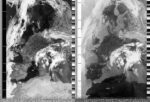
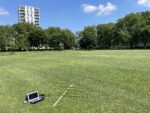
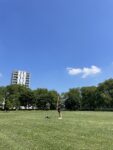
Today has been sunny and bright, but I've been fighting a sharp headache: taking pain killers, taking breaks and moving slowly, but nothing has worked. The one thing that might 'work' is to stop working. Hence why my weather note ends here.
2024-06-24 18:56:11
Sasha Engelmann
Hackney Downs, London, United Kingdom
United Kingdom
NOAA-15
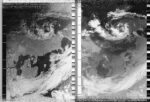
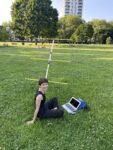
Hackney Downs was golden and glowing this evening, as the city held on to its heat. My arms and shins throbbed slightly from a fast cycle ride from Bloomsbury. I thought about my meeting with J earlier today. We had sat in Russell Square on an uncomfortable metal table, discussing place-based weather knowledges, hierarchies in academia, performance journals and practitioners, and a possible open-weather automatic ground station in Western Australia. J mentioned many collaborators, institutions and places who I imagined with fictional appearances and atmospheres. As I recorded the satellite pass, reflecting on the possible station in Australia, two people came over to speak to me. They appreciated the measuring tape. Their names were Alex and Tamsin, and Alex kindly took the attached photo (thanks Alex!).
2024-06-23 12:02:01
Sasha Engelmann
St Patrick's Catholic Cemetary, United Kingdom
United Kingdom
NOAA-18

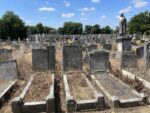
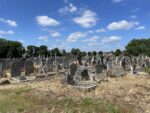
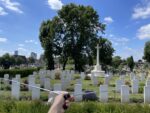
On my way to meet H at Leytonstone Library to see Graeme Miller's radio-borne sound work about the M11 link road, I stopped for a satellite pass at St Patrick's Catholic Cemetary. I had wanted to visit this cemetary for a long time, as it is situated on the prime meridian, 0.000 Longitude. Signs ringed the cemetary suggesting activities were heavily regulated - 'No Exercising or Picnics' 'Cemetary Open For Viewing Graves Only' and one sign that said the cemetary was regularly spraid with toxic chemicals for weeds, and people should wash hands after visiting. I initially put off the thought of collecting a satellite image until I had walked into the cemetary and found a quiet place to sit and reflect. I carefully unfurled my radio antenna. I thought of what I would say if someone asked me what I was doing- 'I'm doing a kind of ritual' or 'I'm just listening' or 'I'm performing a seance, I do this at cemetaries '. Though I am not religious, I said a small prayer to request access to the radio spectrum from the cemetary's residents. An hour later, walking a twisting route along the M11 road and holding radio receivers to the sky, the voices of people whose houses had been demolished to make way for the road emerged and disappeared in radio static. H and I learned the story of a woman who loved a five hundred year old Mulberry Tree that was still standing today, though instead of a communal garden, it is now in a Tesco car park. We heard other stories of older people who had to move out of their houses of forty years, and didn't know where they could go. 'Lonely' was repeated by several voices. The M11 road made a constant background hum, an incessant current of noise alongside our attempt to listen.
2024-06-22 11:03:52
Sasha Engelmann
Hackney Downs, London, United Kingdom
United Kingdom
NOAA-19
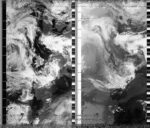

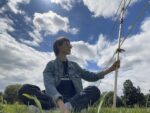
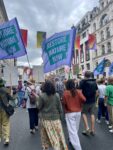
At the Restore Nature Now march in London today, signs read, 'To Bee or Not to Bee', 'Hey Kier OR Rishi! Bee Radical for Nature!', 'UK Arms Sales Destroy Life and Environment', 'Protect Essex Badgers!' 'I Just Really Like Bugs', 'SOIL not OIL', and 'No Justice, No Peas' (accompanied by a drawing of wailing peas). As the march wound South toward Piccadilly Circus, a burst of cheering led my partner and I to cross to the other side of the current of marching bodies, where we found a 'Dyke March' going in the opposite direction on the other side of the road. Their signs read 'Choose Butch. Choose Femme. Choose a Big Fucking Lesbian', 'Lesbianism is not a choice, it is a Blessing!', 'Dykes Against Occupation', 'Whose got a Wand and a Rabbit?', and 'Dykes For Trans Rights!'. Our allegiance to the XR march was seriously challenged! T said 'OMG, there's Stav B!', (legendary artist and performer who used to host underground nights for queer womxn in east London). We barely resisted jumping the street barrier and carried on in the Restore Nature Now crowd. An couple hours later, after meeting one of my old College friends in a pub near the Thames, we found ourselves on the southside of the river at Southbank Centre, where we stumbled upon a stage where people were gathering for a set of acts on the theme 'Queer C*ntry', part of Chaka Khan's curation of Meltdown Festival. There were just as many cowboy hats as dolly parton wigs. Two older men, dressed in matching pinstripe shirts and blue jeans, out-danced many of the gays. A day like this, of so many frequencies, actions, and parallel mobilisations, felt like a kind of litmus test of London, like pulling three colours out of a paintbox. On a day like this, we give our gratitude to this city.
2024-06-21 12:25:31
Sasha Engelmann
Wildflower Meadow in Hackney Downs, London, United Kingdom
United Kingdom
NOAA-18
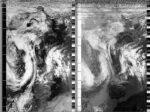
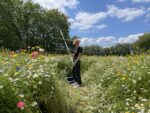
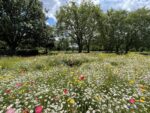
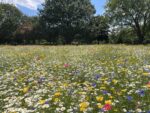
Walking through Hackney Downs at lunchtime today, in peak park-hour, my Yagi antenna was especially conspicuous. Yet I was excited to set up my ground station in the wildflower meadow which had recently begun to blossom with poppies, daisies, and many other beautiful flowers. As I didn't want to block the small paths that are cut into the meadow, I set up on an area just inside a path, where either a dog or a human or both had trampled the flowers, forming a thick mat of grass and aromatic vegetation. What I didn't properly think through was how this would look to other people coming to the meadow at lunch hour. From the path, it looked like me and my ground station were responsible for the squashed flowers. Also, me being off the path probably suggested I authorised or agreed with such flower-destroying activity. As I couldn't easily move when the pass had started, and I couldn't hide my tall Yagi antennna, I found myself exposed to all possible onlookers, park landscapers, dog walkers, mothers, and faraway judgers. Though I couldn't always see them, I heard people muttering under their breath and to each other about 'people' coming to trample the flowers. I stopped the recording early even though the pass was very high elevation and my yagi was performing great. I debated whether to post any photos at all but then decided not to hide what I did! I hope the ten minutes I spent in the off-path area of the meadow can be forgiven by humans and flowers alike.
2024-06-20 12:37:48
Sasha Engelmann
Hackney Downs, London, United Kingdom
United Kingdom
NOAA-18
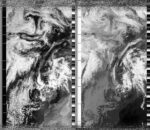
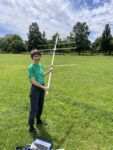
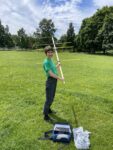

As I left the flat with my measuring-tape Yagi for the third time this week, Soph sent me a satellite image captured from Vienna this morning in which a large dust plume is clearly visible over the Mediterranean and Italy. I wondered if my DIY Yagi can pick up the dust so far away from the UK. Looking at the antenna lying on the semi-parched grass of the park, it seemed highly unlikely (how could something made of scrap materials pick up the traces of tiny particles in the atmosphere hundreds of kilometres away?). Yet despite the very weak signal received yesterday, my experience testing the antenna on Tuesday suggested it might be possible. And only thirty seconds after the satellite pass officially started, the signal from NOAA was clearly audible and visible, and only grew in strength over the next one or two minutes, so that by the time I began to angle West the signal sounded crisp. Unlike yesterday, tracking the satellite was easy, or perhaps the signal was strong enough that I didn't need to be so precise. Still, while talking to Bill who came over during the pass and kindly took both documentation photos (thanks Bill!), I did slightly dip the Yagi and noticed a drop in the signal. To my great surprise, I recorded almost fifteen minutes worth of audio, so long that WXtoImg automatically stopped recording when the satellite crested the Southern horizon. The image captures a long stretch of Atlantic weather featuring two mini-cyclones (one north of Iceland, one hovering over the north of France) and only a small part of Western Europe and Africa. The dust is out of the frame, to the East. Yet I wonder if my and Soph's images were georeferenced and composited together, might some swirls of dust be visible across both of our images? A fugitive 'weather between us' in the refractions and reflections of quasi-invisible traveling particles.
2024-06-20 12:00:35
Soph Dyer
Augarten, Wien, Austria
Austria
NOAA-18

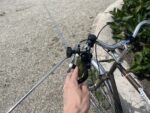

It's a balmy temperature, just warmer than my body. The sky is hazy and there is a cool breeze. The weather is mild, but I feel enraged.
At breakfast, I let rage well up inside of me as I read the New York Times newsletter's coverage of crisis of aid not reaching people inside Gaza. In my lay opinion, the article's conclusion is morally and legally bankrupt. I have worked on armed conflicts for the last seven years and yesterday, in preparation for a consultancy job, I read 'SOUTH AFRICA’S COMMENTS ON THE REPLY BY ISRAEL TO THE QUESTION POSED BY JUDGE NOLTE AT THE END OF THE ORAL HEARINGS HELD ON 17 AND 18 MAY 2024'. In short, denying civilians access to medical services and humanitarian aid is punitive and illegal. End of.
I suspect different colours of my rage are interconnected, like clouds of a cyclonic weather system. For example, I have such bad cycling rage at the moment and it’s very misandrist. Everything time a male cyclist overtakes me at the traffic lights and then proceeds to cycle slower then me – a regular occurrence – I mentally flip-out and practice the cycling equivalent of tailgating. I should stop this and find a better outlet for this negative energy. Recently, I chased down a male cyclist who had, unprovoked, shouted at me. Sadly, he didn’t notice and it was me who turned into a one way street in the wrong direction.
I could continue to list the things that have provoked rage in me, but there is little point as they are proxies for greater, less direct injustices.
2024-06-19 16:48:07
Sasha Engelmann
Hackney Downs, London, United Kingdom
United Kingdom
NOAA-15

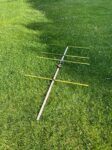
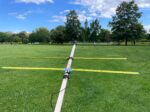
This is day two of measuring tape Yagi antenna experiments. I missed all of the 'good' passes in the morning, so I tried for a NOAA-15 pass in the early evening that peaked in elevation at 17 degrees to the East. In contrast to my experience yesterday, where the Yagi effortlessly picked up the signal of NOAA-18 at a max elevation of 45 degrees to the East, this lower elevation pass turned out to be a struggle for the Yagi. I felt either I was not being precise enough with my aiming, or the pass just wasn't high enough for a signal to be well received by the measuring tape components. As I tracked the satellite, I became uncomfortably conscious that I was pointing this conspicuously large antenna almost horizontally over an open field where some young boys were playing football. I hoped I wouldn't be noticed by an anxious parent or onlooker.
2024-06-18 10:14:12
Sasha Engelmann
Hackney Downs, London, United Kingdom
United Kingdom
NOAA-19
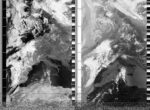
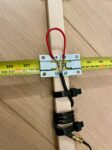

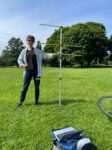
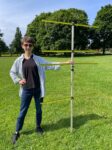
My first pass with a homemade, 'tape measure' Yagi antenna! I followed a design described in a YouTube video by India Rocket Girl, though I cross referenced India Rocket Girl's design with other sources for tape measure antennas and DIY dipoles. I also watched around seven YouTube video tutorials on how to solder wires to each other and to metal surfaces as my soldering skills are incredibly rusty. I lacked many of the components that India Rocket Girl uses, but made do with zip ties and metal brackets that I found at the local hardware store. Instead of PVC pipe, I used a long piece of wood that was intended for house moulding. The tape measure was an old heavy duty one that I had in my electronics box. Last night after dinner I started testing a few things, and before I knew it I was knew deep, spread all over the flat (T was away in Italy). I didn't think I had gotten it right, and I was convinced I would need to re-solder, but when I set up this morning, connected the antenna to my dongle and lifted the giant Yagi off the ground, pointing north, the signal was immediately strong! I tracked the satellite to a maximum elevation of 45 degrees to the East and then down to the Southern horizon. Toward the end of the pass a couple approached me from behind and were almost as excited as I was about the tape measure design and the image of the Mediterranean forming on my screen. Shortly after they left, Martin rode over on his bike and kindly took the photos of me shared here, very grateful for documentation of this DIY moment! More testing to follow soon...
2024-06-17 13:17:03
Sasha Engelmann
Hackney Downs, London, United Kingdom
United Kingdom
NOAA-18
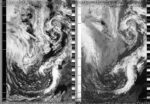
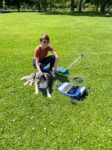
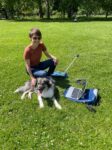
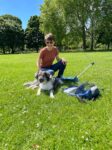
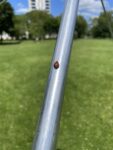
After what has seemed like weeks of rain, cold and relative darkness, today was a dramatic shift into sun and warmth. As I set up my ground station on Hackney Downs, a little grey dog around thirty metres away came sprinting over and jumped into my body, making contact with my face! One of its teeth even slightly knocked one of mine. It was a blur of curly fur for around thirty seconds during which I could hardly see my hands or antenna, and then it ran off again. I saw it go back to its owner, and then spot a sunbather on the grass that it could love-attack. Later, as I was packing up, a gorgeous Romanian sheepdog came over and sat down next to my laptop. This meant the woman accompanying him came over, and we ended up speaking for around ten minutes about satellites, data modes and encrypted / unencrypted data. I asked for some photos of 'Wookie' and she happily obliged and consented for the photos to be uploaded to the open-weather archive, on Wookie's behalf. As I left the field, more people had arrived and were cautiously undressing into swimsuits, checking the sky to see if it was really worth it. I went to the grocery store and bought portobellos, salad, cucumber, sweet potato and mochi.
2024-06-16 11:39:50
Sasha Engelmann
Intersection of Rue de Serbie and Rue du Croissant, Brussels, Belgium
Belgium
NOAA-19

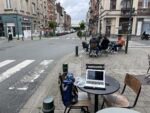
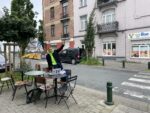
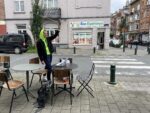
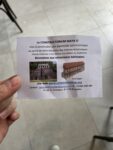
Camped out at a long table at a corner cafe, and feeling quite sleepy after a late night, five of us spoke for hours about our former lives, the legacy of communism in Bulgaria and the Balkans, developments in AI, and the politics of queer spaces. I set up my ground station at a cafe table on the streetcorner and was soon the subject of many looks and glances, though people were more hesitant to approach than the evening before. When Sofie arrived and began expressing enthusiasm about what I was doing and laughing at the situation, a small throng suddenly materialised around the ground station, including a man and a young boy, and an older man who gave me a small paper card that advertised 'La Constructorium Maya': "vise à construire une pyramide astronomique, un centre de démonstration des sciences et techniques, Précolombiennes à San Marcos (Lac Atitlan) au Guatamala". The man also insisted on showing us a photo of the Lake Atitlan, which was a pearl blue surrounded by deep green hills. Yet when I search for the website on the card I find what appears to be a french organisation that researches in the materials of building construction. Ten minutes through the pass, though we were still receiving a surprising signal given the five story surrounding buildings, rain began to cover my laptop and we went back inside. I placed my open laptop upside down on the brunch table so it could dry itself out. The following hours of the afternoon was a grey, dark, rainy mist until the sky suddenly cleared and sun poured out as Sofie and I left a bookshop where we had gone to a beautiful reading of a novel featuring vampires, a gay couple, a theatre festival and a skateboarding evangelist.
2024-06-15 21:43:18
Sasha Engelmann
Outside L'Athénée bar, Ixelles, Brussels, Belgium
Belgium
NOAA-18

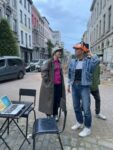
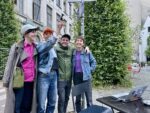
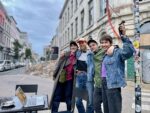
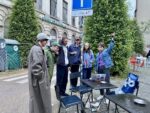
Sofie ran toward me in hall of the Gare du Midi in Brussels, and as soon as our bodies met we realised we were wearing almost the same thing: double denim, white trainers, a simple t-shirt. The next few minutes were a complete blur of overwhelming emotions, extreme happiness and my cheeks hurting from smiling too much. A group of us who had met at the Schloss Solitude art residency in Stuttgart, Germany during the Covid-19 pandemic had staged a reunion in Brussels, where Sofie lives. We spent the rest of the day talking at each other at hyper speed, visiting the exhibition of Belgian architect and feminist Simone Guillissen-Hoa, eating Congolese food in Ixelles, during which most of us ordered whole-fishes and plantain, speaking about life and loss in l'Athénée, and helping each other remember the many stories and moments we shared in the residency. Our experience of Schloss Solitude - a 17th century castle near a baroque forest - was particularly unusual as it happened during the second and third 'waves' of the Covid pandemic. We found ourselves - 35 artists from around the world - stranded in a castle on the top of a hill, affected by a rigorous German curfew and travel ban on movement between regions, let alone countries. Yet our 'castle of crossed destinies' ended up being some of the most memorable months of our lives, with experiments in collective living, workshops and teach-ins, dance classes, countless forest walks and excursions, mushrooms trips, meals and the making of what is now a family. When I went outside of l'Athénée to capture an image from NOAA-18, the night was late but there was still a thin light, and Sofie, Olivia and George came out with me. I spoke to a group of strangers who were immediatley interested in the radio antenna and satellite image, and we laughed in a semi photo shoot with the four of us. I wondered if the radio-borne satellite image, however noisy due to the tall surrounding buildings and angles of the city, registered the frequencies of our joy.
2024-06-14 12:14:18
Sasha Engelmann
Hackney Downs, London, United Kingdom
United Kingdom
NOAA-18
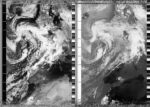
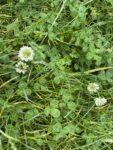
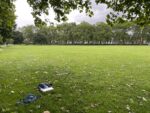
As sudden rains wash through London today, I share the cover of a Plane tree with a Deliveroo driver, an older man with a cane, and a couple of young people playing hookie from school. We form an unlikely bunch, me crouching over my laptop to protect it from stray drops and angling my antenna to the East, and the others either on their phones or sneaking glances at me and at the sky to assess when the rain will stop. We don't speak. In the relative silence, my thoughts continue to be jarred by news of events in Argentina, received in part through Democracy Now, and in part through intermittent texts and updates from two of my close collaborators (on a community air-sensing project) in Buenos Aires. The news media (specifically the Guardian) reports in characteristic language that "Argentina’s Senate narrowly voted to approve the first set of harsh austerity measures proposed by President Javier Miliei... Police used pepper spray, water cannon and teargas against the huge crowds while demonstrators set two overturned cars ablaze and threw molotov cocktails". I think about the generic-ness of this reporting, how little it actually says about the events occurring. Or, conversely, how much it says about how often similar events are occurring. A think tank in Oslo has just released a report that states that there were more armed conflicts in 2023 than in any year since World War II. From Buenos Aires, J writes a text explaining Milei's proposed legislation, that follows months of violent executive orders: "They're changing the retirement age for women and getting rid of a retirement pensions moratorium, making it impossible for informal workers to retire. Plus, they're giving foreign extractive companies the right to litigate in foreign tribunals. These companies get access to natural resources over everyone else, even the indigenous people of Argentina, who have lived in harmony with nature long before the nation state existed. It's really tough, especially in the middle of a years-long recession and economic crisis, with poverty rising to a staggering 55%". D shares that some students from her university have been unfairly imprisoned last night, not far from her house. She tells of an audio message from the mother of one of the students who has been allowed to visit the prison, and it reveals that seven women are on the floor [of the cell] since yesterday, including the students'. 'A form of torture' D adds. All of this as Milei prepares to travel to the G7 summit, a guest of Giorgia Meloni. All of this as 50,000 new fires have been reported in Argentina the past several days, despite the winter season. I spend the rest of my day thinking about Aya Nassar's question: "we hold our breath. Where do we go from here?" (2024: 3).
2024-06-13 12:25:27
Sasha Engelmann
Founder's Field, Royal Holloway University of London, United Kingdom
United Kingdom
NOAA-18
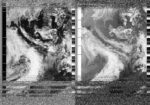
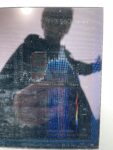
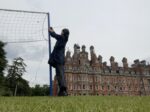
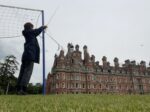
On the train to the university campus this morning, I think: what might it mean to ‘queer’ air, and our relations to it? Several scholars I read and admire have recently gestured to air’s queerness. Nerea Calvillo writes about queering as a practice that is useful when we consider airborne things like pollen. Nerea writes, “Because if air is commonly pictured as an inanimate (and often toxic) gaseous entity, queering it brings to the fore the whole world of animate and invisible entities that are part of it” (2023: 240). Queering air “brings desire, multispecies reproduction and interactions, excess, and ambiguity” to the fore (2023: 241). Nerea thus figures queering air as a tactic of honouring air’s multiplicity and deviancy.
Talkign about multiplicity: later in the day I am standing on tiptoes attaching an antenna to a football post while an airplane approaches Heathrow airport, flying very low over the university campus, and appearing in the corner of one of the documentation images. Minutes later, I am listening to the Russian satellite Meteor MN2-3 drown-out the weaker signal of NOAA-18. The electromagnetic trace of the Russian satellite is clearly visible in the gradations of static in the Southern portion of the image I capture from NOAA. Even later, I am “close reading close breathing” the work of poet Julianna Spahr, cited in the writing of queer theorist Lauren Berlant (2022: 101). An excerpt from Spahr’s poem ‘This connection of everyone with lungs’ goes as follows:
as everyone with lungs breathes the space between the hands and
the space around the hands and the space of the room and the
space of the building that surrounds the room and the space of
the neighbourhoods nearby and the space of the cities in and out
Earlier this week I cited Stephen Connor’s writing on the ‘spaces of observation’ created by scientists to treat air as an object, as a volume that could be controlled. Spahr’s poem offers a very different diagram of air to space, and I would argue this is a queer one. The word ‘air’ is never mentioned in the poem, yet ‘breathes the space’ arises several times. Air is an anterior, a semi-nothingness that nevertheless infrastructures lungs and spaces. Though the poem intersects scales from the space around the hand to the space of neighbourhoods and cities nearby, it doesn’t do so by ‘nesting’ scales in the way we often see in popular media and culture, where the ‘body’ is placed in the ‘local’ and this sits inside the ‘urban’. Instead, reading the poem (that spans several pages) is an interstitial experience where breath is hinged to space and space is in turn hinged to different and plural scales, from the intimate to the planetary. This is an "affective scene [that] focuses on receiving and metabolizing the world while unraveling its presumed solidity" (Berlant, 2022: 97). This is perhaps a "queer reboot of the common" (Berlant, 2022: 99) that comes about through the queering of air.
2024-06-12 12:36:57
Sasha Engelmann
Hackney Downs, London, United Kingdom
United Kingdom
NOAA-18
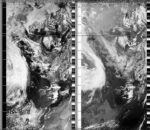
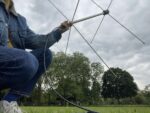
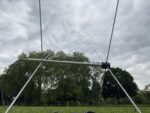
Watching the satellite image load on my screen around lunchtime, it is hard for me to identify bodies of land, the characteristic sharp edge of France or the icy fingers of Norway. I am not sure if I can make out the fingerprint that is Iceland in the North Atlantic, normally so disinguishable. With my 'orientation devices' missing, I am lost to dis/orientation in the swirls of water vapour, the speckles of reflective cloud-light and the nondescript grey pressing down on me from above. Later in the day, I am reading Mel Chen's piece 'Feminisms in the Air' and in the very last sentence Chen introduces a term I have not heard before, 'melancholic pragmatism'. They write, “Out of the desperation and melancholic pragmatism of this moment, at stake are a series of questions about the “about” of feminisms whose imaginations promise something in the end” (2020: 29). I follow the footnote to read more about 'melancholic pragmatism', and find the following: ““Melancholic pragmatism” is a phrase that emerged in my conversation with philosopher and activist Alisa Bierria on October 17, 2020, about melancholies that do not end in what can be a strangely idealistic form of lossful nihilism, or that are perpetually delayed or denied, but are permitted to exist, registering layers of complexity and acceptance of inevitable complicity and incompletion” (2020: 29). I can relate to this definition of melancholic pragmatism, as it feels like the affective texture of what remains in many of my friends and family members after experiencing the winter of 2024 and the collective witnessing of war crimes in Palestine, Sudan and elsewhere. I imagine that Chen, writing in the midst of the COVID-19 pandemic, might have been feeling a slightly different melancholy, with different layers of 'complicity and incompletion' but nevertheless I think there are similarities, not least of which is the sense that neither nihilism or denial are workable options. Instead, we permit our ethical and moral melancholies to exist, we permit the impenetrable grey skies to press down, and we permit the understanding of a year of climate catastrophe that is only beginning to show how much of an anomaly it truly is. As my workday draws to a close around 7pm I fantastise about writing Chen an email to ask: what is your melancholy layering now? what are you permitting?
2024-06-11 12:49:55
Sasha Engelmann
Hackney Downs, London, United Kingdom
United Kingdom
NOAA-18
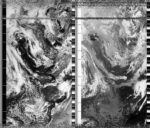
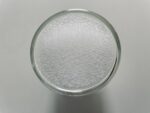
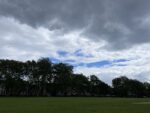
Today I am reflecting on volumes of air. In the book 'The matter of air: science and art of the ethereal', Stephen Connor recounts some of the seventeenth century scientific experiments that sought to examine air. He writes: "To study an object, one must pick it out from its surroundings, and concentrate it in one place. How was one to make of the air such an object? How was the air to be picked out of its surroundings, when air was ambience itself? How was the air to be brought before one, when it was of necessity and at all times about?" (Connor, 2010: 17). To 'pick something out' from its surroundings, to 'concentrate it' and to bring it 'before one' is to orient toward it. Yet this act of orientation proves tricky when the thing one seeks to 'pick out' is 'at all times about'. Connor continues: "What if, rather than trying to roll the air up into a ball that one could look at from the outside, one were to produce a space of observation - an air-lock - within the very space of the air?" (2010: 17). Thus, in lieu of condensing air, one might work to enclose it, to create a space in which air is 'locked'. I think of all of the times I have seen air get 'locked' and I think of Robert Boyle and his Enlightenment contemporaries, trying ceaselessly to get air into glass spheres, the better to isolate, contain and observe it. I think of all the 'holds' (Sharpe, 2016) in which humans were locked in ever-dwindling air, yet whose stories are rarely considered in narratives of Enlightenment science or scholarly histories of architecture, space and volume. Could Boyle have conceived of the consequences of volumetric air? Could he have examined the vacuums he created in so many glass spheres as caught up with, rather than removed from, vacuums of airelessness for vast numbers of humans in his time and hundreds of years beyond it? As 'volumetric thinking' is put to work in Gaza every day through the use of aerial weapons from white phosphorous to CS-gas, I wonder, with Aya Nassar: "What if we linger in the gaps between fragments and shards? Is there anything there? Not in the wreckage and debris - we know that well, too well - but in the space of making dust when it is not yet the aftermath?" (2024: 3).
2024-06-10 10:09:56
Sasha Engelmann
Hackney Downs, London, United Kingdom
United Kingdom
NOAA-19
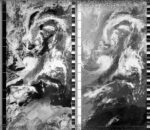
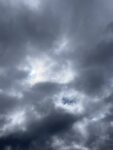
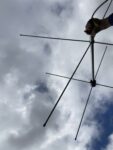
The sunlight comes sideways today. There are low-hanging, grey and dark blue clouds circling above, and I leave the flat for the park a few moments after rain has stopped, feeling daring with my uncovered laptop. A flash of sun comes from the horizon as a gap in the sky opens for a few seconds and closes again. I can tell the moment when the sun has come out for just long enough to lure a whole hoard of dog owners and dogs outside, yet as soon as they reach the field the darkness falls again. I am in the park just long enough to see Martin who rides over on his bike, and we briefly speak about his plans to build a satellite ground station. As I work at my desk for the rest of the day, I am surprised by the slantwise light, searching through the corners of our kitchen and living room, making the whole place seem a little off-kilter, making my admin tasks feel a little surreal. I find myself turning on and off the desk lamp and living room light, unable to find optimal emailing conditions. One clap of thunder booms across the city just after lunchtime, answered by a far away siren.
2024-06-09 12:04:33
Sasha Engelmann
Hackney Downs, London, United Kingdom
United Kingdom
NOAA-19
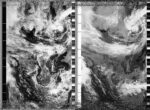
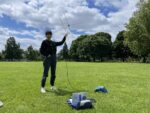
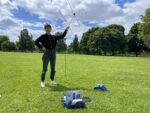
Pockets of deep cerulean blue shown through grey and white cloud this Sunday morning. I stole a few minutes to capture the satellite image before heading out to a local pub for a roast with my partner and one of her ex-partners who is staying with us for the weekend. As the pass was ending, a man named Paul rode over to me on his bike, and asked what I was tracking. He was suprised that the answer was satellites, as he had expected wildlife. After I asked Paul to take a photo of me (two of which are attached, thanks Paul!) he said he could show me a photo of him. The photo was of Paul next to a train with the lettering Dr Paul Stephenson on the side. 'In my dreams!' joked Paul. Later in the day I looked up the train, and found out that Dr Paul Stephenson is a well known civil rights campaigner in the UK who organised the 1960s Bristol bus boycott which overturned a ban on people from ethnic minorities working on buses in the city. Dr Stephenson's campaigns were instrumental in paving the way for the first Race Relations Act in 1965, and in 1992, he also helped set up the Bristol Black Archives Partnership, which protects and promotes the history of African-Caribbean people. Great Western Rail apparently has a programme called the 'Great Westerners' where people can be nominated to have trains named after them, as a mark of respect to contributions to UK society. I had not heard of this practice of dedicating trains, and this made me wonder whether airplanes or satellites are ever dedicated in this way. Soph and I had recently wrote a short text that includes a vignette of a woman who asks to have her name attached to a powerful storm, and it becomes Storm Babette. I had assumed that 'In my dreams' referred to the 'Dr' part of the name, but I realised maybe it was about having your name on infrastructure, or being recognised as a 'great westerner'...
2024-06-08 11:46:39
Sasha Engelmann
Hackney Downs, London, United Kingdom
United Kingdom
NOAA-18
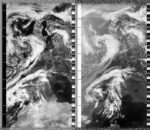
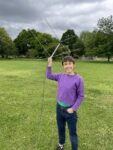
The air is warm but skies are grey, which has been a regular theme these last few weeks in London. A man named Rowan walked barefoot across the grassy field and introduced himself by saying "I think you can guess the question I'm going to ask you". We spoke for almost the duration of the pass, and he kindly took the attached photo of me. As I was explaining NOAA-18's Advanced Very High Resolution Radiometer and how it scans Earth's surface in six spectral bands, but only two of these six are represented in the APT image appearing on my screen, I remembered an article sent to me and Soph by Bill Liles (NQ6Z) that tells the story of Virginia Norwood, sometimes called the 'Mother of Landsat', who designed the Multispectral Scanner (MSS) on board the first Landsat satellite (Landsat-1) launched in 1972. Virginia famously worked with a team to invent a scanning instrument that used a mirror moving between two 'bumpers' at a rate that allowed precise scanning of Earth's surface. According to the article in the MIT technology review, Virginia worked hard to convince NASA and other scientists of the precision of the scanner, and many were sceptical of what they called the 'banging mirror' and how it would work in space. Learning of this history, and specifically the working of the MSS, made me wonder about the relationships between the MSS scanner and the AVHRR of the NOAA fleet. My guess is that early scanning instrument knowledge of the 60s and 70s was shared across NASA and NOAA teams, since these organisations are so entangled with each other and with defense operations. I do also know from previous research that the Automatic Picture Transmission common to most NOAA satellites was first tested in 1963 on TIROS-8, almost a decade before the MSS instrument was launched on the first Landsat satellite. The experimental APT transmissions from TIROS-8 used data from 'a five-channel scanning radiometer', but TIROS-8 also carried two TV cameras (images from these cameras were either transmitted directly to US ground stations when the satellite was in range, or stored on a tape recorder until transmission). A key difference between NOAA and Landsat programmes was purpose- since its formation in 1970, NOAA operated a fleet of TIROS-type weather satellites that were intended for meteorological uses, and so were relatively low resolution. According to NASA, the innovation of Landsat was to produce higher resolution terrestrial images of earth that could be useful to understand crop distribution or even geology, and would supplement the very high resolution of land captured from airplanes. Yet Landsat has further historical relations to NOAA. According to the Wikipedia entry on the Landsat Programme, "In 1979, President of the United States Jimmy Carter's Presidential Directive 54 transferred Landsat operations from NASA to National Oceanic and Atmospheric Administration (NOAA)". Under NOAA's tenure of the Landsat programme, prices for Landsat data soared, as NOAA sought to recover costs from users. This unfortunately led to a massive decrease in Landsat data, except for very powerful and resourceful companies like those in the fossil fuel industry (though we also know that the US government gave special access to satellite imagery for fossil fuel corporations at different points in history). Much like the three still-active NOAA satellites have recently been contracted to Parsons Corporation, the Landsat programme was also temporarily privatised. "This occurred in 1985 when the Earth Observation Satellite Company (EOSAT), a partnership of Hughes Aircraft Company and RCA, was selected by NOAA to operate the Landsat system with a ten-year contract" (Wikipedia). The transition to private maintenance was not smooth, and funds were very short, so in 1989 NOAA directed the shutdown of Landsat 4 and 5. The shutdown was averted by the US Congress, which shifted policy and found emergency funding for the Landsat programme, bringing it back under the control of the government and opening Landsat data once again for widespread use. This was a well timed rescue, since Landsat 6 failed during launch and crashed in the Indian Ocean. Like NOAA-15, 18 and 19, satellites that have remained active long passed their intended lifespans, there are similar stories in Landsat. According to a 2012 article by NASA, "Despite all of the ups and downs, Landsat 5 and 7 operated far beyond their designed lives. The Thematic Mapper (TM) on Landsat 5 only recently gave out after 27 years of imaging; around the same time as TM shut down, operators managed to turn the Multispectral Scanner System (MSS) back on after years of dormancy. Landsat 7 continues its work as well, 13 years after launch". Across NOAA and Landsat, then, there are some common stories of instrumentation, orbital patterns, attempts at privatisation and the longevity of the satellites themselves. As we prepare for the decomissioning of the three still-active analogue NOAA satellites, I'd like to go deeper into the interconnected histories of satellite programmes, scanning-instrument types and the different sorts of 'publics' they were intended to serve.
2024-06-06 20:50:00
Soph Dyer
Issey Sushi & Co, Wien, Austria
Austria
NOAA-15
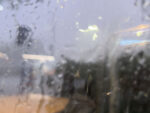
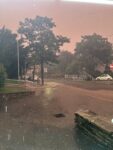
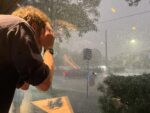
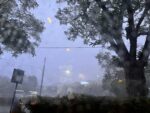
My sister, R, and her partner, B, are visiting from Cornwall. They have come to see me and N, with the hope of drying out after the wettest spring on record in the UK. They both work on the land so are very exposed to the recent extreme weather. R has decides to me how the land, after being so waterlogged has now dried smooth and cracked making planing difficult. Plus, the warm wet weather has caused the local slug populations to explode. I’ve been having nightmares of the weather being so terrible when they visit that R decides to emigrate with B to Australia. At least the first part of the nightmare comes true. R, B and me are trapped in a restaurant shop as the heavens open and day turns to night. Only an hour earlier we’d been swimming in an outdoor pool. Now the road is a torrent of grey water. A standing wave forms where the pavement used to begin. Everyone in the restaurant is watching the storm, impressed by its power. The lightening strikes close, the thunder cracking overheard with almost no delay. The limbs of trees flail, adding to the drama. R says that the sorting of sushi boxes into the square bags of delivery drivers looks like a three dimensional game of Tetris. At some point the delivery drivers must have headed into the storm as when I look up from trying to photograph the rain, they’re gone. When the rain lessens we pay up and leave. The rain has stopped but the lightening continues to flash until after midnight. I give up the idea of sticking an antenna out of the window and decode to upload this weather note instead.
2024-06-07 10:10:13
Soph Dyer
In the moist air of the park, Wien, Austria
Austria
NOAA-19

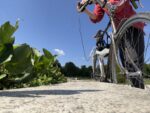
I miss the beginning of the satellite pass, but enjoy sitting in the humid, sun. It’s deceptively warm. The image crop is awkward but perfectly frames the Mediterranean Basin and Black Sea. In the ‘visible channel’ there are few clouds, however the infrared channel reveals of wispy veil of cloud over most of the continent. North Africa is cloudless.
2024-06-05 11:49:10
Soph Dyer
Pedestrian crossing, by work, Austria
Austria
NOAA-18


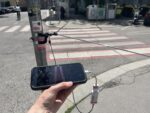
It’s noon and the weather is hot and steamy. My head is fuzzy from drinking pink Prosecco with M for her 40th birthday. My antenna is clutching a roadside pole next to the pedestrian crossing outside our studio. An older woman crosses the road, stooped and slow. She must have felt my gaze on her back, as she turns her face folded into a warm smile. I smile back. Trades people and children pass, openly curious but mostly unsmiling. I note how an electric scooter and hybrid bus cause bands of radio frequency interference.
2024-06-04 23:33:06
Soph Dyer
On the balcony, Wien, Austria
Austria
NOAA-18

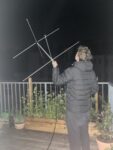
On WhatsApp, I write to my brother: "It rained so heavily in the night our flat was saturated by the sound. I half expected to wake to flooded streets".
2024-06-03 20:48:20
Soph Dyer
At home, Wien, Austria
Austria
NOAA-19

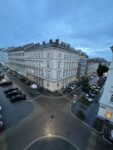
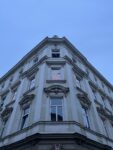
I have skipped two days of weather notes. It’s Monday. Thunder rolls as Sasha and I frequency shift from one open-weather Zoom call after another. First we heard from L and D in Scotland about how the satellite image decoder is up and running, and the redesign of the Public Archive is almost complete! We then spoke to G in Berlin who shared with us the code that he is writing for the automatic satellite ground stations. Together we started to speculate about how the 3D printed casing of the satellite ground stations could be. We imagine the ground station box resting on a bedroom bookshelf or mounted the wall of an art gallery. We tingled with excitement, encouraging each other in the game of visualising the work complete. In between, Sasha and I spoke with J, a curator in Barcelona who is planning an exhibition on the themes of navigation and orientation … let's see. I took some Ibuprofen to avert a migraine and then couldn't stop sneezing. Sasha giggle when, I turned of my camera instead of muting and loudly blew my running nose. As my work day ended, the thunder storm moved overhead. On a call with just Sasha , we draw on our remaining brain power and belief, I shared my proposal for a sounded-based transmission for the Year of Weather project. Inspired by the desire to 'meet people where they are' and by how past feminist alliances such as F.I.R.E. in Costa Rica and Pirate Radio Women in Ireland used radio to share with their community counter narratives and information, the transmission would share our weather notes intermingled with the realtime local weather updates of a meteorology service. A second important reference is the "VOLMET" radio broadcasts that are rolling weather forecasts for aircraft, read out often by highly gendered and increasingly automated female voices. Before hanging up, Sasha and I began to test the proposal and to think through different scenarios. I had planned to squeeze in a hours more work but my brother called and we spoke almost two hours. It rare that we speak for so long on the phone, so the call was special. Lightening seemed to knock of the signal so I move around the flat, searching for a more stable signal, plugging in my phone to different wall sockets.
2024-05-29 11:35:05
Soph Dyer
Augarten, Wien, Austria
Austria
NOAA-18

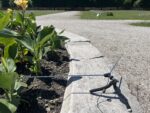
It is sunny. A few white and grey clouds move across an otherwise deep blue sky. A cool wind raises the hairs on my arms. As I receive the radio transmission, I imagine NOAA-18’s rapidly changing location. “Are you over Latvia or Lithuania? Perhaps now Belarus?” I ask. “What do you see?” The questions are not rhetorical nor do I expect a reply. I list the countries its invisible trajectory crosses: Ukraine, Romania, Bulgaria. The satellite’s signal begins to stretch, its wavelength subtly lengthening as it moves away from me. “Have you crossed into Greece?” I ask. “Are you over the blackness of the Mediterranean Sea?” My line-of-sight with the NOAA-18 is unbroken as looks down on Cairo and Egypt, then, it its East, Gaza and Israel. Here, I loose its signal and my line-of-sight. Later, I look up the poetry of Mahmoud Darwish, and re-read ‘Poetic Regulations’
“The stars had only one task: they taught me how to read.
They taught me I had a language in heaven
and another language on earth.
Who am I? Who am I?
I don’t want to answer yet.
May a star fall into itself, and may a forest of chestnut trees rise in the night
toward the Milky Way with me, and may it say:
Remain here!”
2024-06-01 21:11:06
Soph Dyer
Sitting on the window ledge, Wien, Austria
Austria
NOAA-19

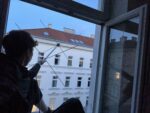
Today hasn’t been easy. The weather is sodden and my mood is low. I almost miss the satellite pass and make a last minute decision to try and receive the transmission from the flat. Sat on the window ledge, precariously positioned over the wet street three stories below, I receive an imperfect image. I am glad.
2024-05-28 12:24:53
Sasha Engelmann
Downs Road, London, United Kingdom
United Kingdom
NOAA-18

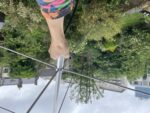

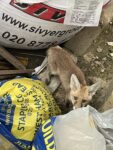
My senses are dulled and my body aches in a dull, persistent way that reminds me eerily of Covid. For most of the day I struggle with clouded focus and a heaviness in all of my limbs. Two lateral flow tests come back negative. I get worked up in an online committee meeting and sweat through my shirt as I wait for my 'raised hand' to be summoned. Soph wonders if I am fighting a (non-Covid) virus, and I remember the way my colleague was coughing in the office when we met on Friday. Yet what I am feeling is nothing like a 'common' cold or flu. On the way to the local health food store, we happen upon a baby fox hiding among sand bags next to a construction site. Passing me, my partner, and the fox, a man says this particular fox had been 'dropped' into his back garden by fox-parents some weeks ago and the fox's family would bring food until the little one was strong enough to jump out. What had it done, I wonder, to deserve such gentle entrapment? It peers up to us, seeming both mildly frightened and defiant. At the health food store, 'East of Eden', I browse a wall of herbal remedies, powders and cures. They have names like 'organic dog blood', 'raw moon' and 'bread nut'. I am surprised not to read 'fox tail'. I don't know what to choose and I end up with dark chocolate and bananas. I wait for my body to give me more signs - a sore throat? a fever? The full-body ache is both everywhere and nowhere, showing no signs of sharpening or waning.
2024-05-27 20:32:49
Soph Dyer
Sitting on the window ledge, Wien, Austria
Austria
NOAA-19


Humid, blue, warm skies. Tired, achy, loose body. Humid and tried, blue and achy, warm and loose.
There is lightening interference from a storm to my West.
I read the news, not making it more than a few paragraphs. "The Israeli missiles struck tents in an area to the west of Rafah city that was supposed to be safe from attack". "[A]t least eight missiles struck the camp – a designated safe zone – on Sunday night at about 8.45pm local time (17:45 GMT). "Witnesses described charred bodies and flames. A doctor said the majority of the victims he saw were women and children". (The New York Times, 27 May 2024) “'We pulled out people who were in an unbearable state,' Mohammed Abuassa told the Associated Press. 'We pulled out children who were in pieces. We pulled out young and elderly people. The fire in the camp was unreal.'” (Associated Press via The Guardian 27 May 2024)
Judith Butler asks, “Whose lives are regarded as lives worth saving and defending, and whose are not?” They continue: “One way of posing the question of who “we” are in these times of war is by asking whose lives are considered valuable, whose lives are mourned, and whose lives are considered ungrievable… We can see the division of the globe into grievable and ungrievable lives from the perspective of those who wage war in order to defend the lives of certain communities, and to defend them against the lives of others—even if it means taking those latter lives.” (Butler, 2009)
2024-05-27 12:36:10
Sasha Engelmann
Hackney Downs, London, United Kingdom
United Kingdom
NOAA-18
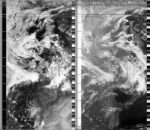
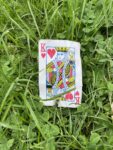
King of Hearts lying listlessly in the grass, crumpled from hands, wind and rain, and ripped (possibly burned?) on one of its edges. A woman and a dog walk past, and the dog makes a wide circle, looking at me inquisitively. "You must get many such looks of suspicion!" jokes the woman. A corner of Svalbard - Spitsbergen - appears at the top of the satellite image as I manage to capture the transmission from the 'High North', much earlier than usual, by standing on my tiptoes and stretching the antenna above my head and at a semi-parallel angle with the ground. I generally avoid such acrobatics as I usually run out of my flat and set up my station only moments before the pass starts, missing the noise from the North. My t-shirt threatens to come out of my denim jeans. For some weeks, a tent has been quietly living under the shade of the vines next to the bike parking area where Downs Road meets the park, and today there is a piece of laminated A4 paper saying '7 day notice'. The notice looks ridiculous strapped to the fabric of the tent with a black zip tie. The absurdity of the notice and the underlying violence it represents reminds me of D Asher Ghertner's (2020) work exploring how contemporary architectures of space and atmosphere "draw from colonial logics of bodily sequestration from outside threats". In other words, we are not just 'living' and 'breathing' the last several centuries of colonialism, extraction and exploitation building up as heat and toxicity in the air (as suggested by Denise Ferreira da Silva), we are also living and breathing "durable spatial dispositions governing how atmospheres are felt, arranged, and imagined". In other words, we are living and breathing ways of engineering and creating air/space that can be traced to the racialisation of the lungs of bodies of colour, the architectures of 'hilltop sanitoriums' where the wealthy could breathe 'clean air', and the personal technology of the air pollution mask, which has a very long history that far predates covid-19 or recent air pollution debates (Ghertner, 2020). Attempts at 'climates of enclosure' that work differently, like that of the streetcorner tent, and that engineer airspaces for those in crisis, are 'given notice' precisely because of this history.
2024-05-27 20:45:48
Soph Dyer
Leaning out of the window, Wien, Austria
Austria
NOAA-19

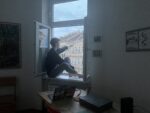
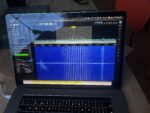
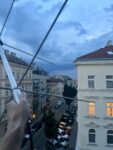
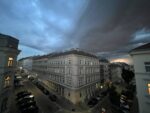
My image contains interference from lightening strikes. I have likely seen lightening interference before, but it a first for me to be able to confirm it. The sky above our house was blue but to the East I could see dark storm clouds. Each time the clouds flashed orange, even though they they were too far for thunder to be audible, I could 'hear' the strikes as bursts of radio noise. I have uploaded a photo of the waterfall display clearly showing a horizontal line of interference from a lightening strike. In the decoded imagery, the lightening is visible as broken lines, not more than a one to two pixels wide. Given the position of NOAA-19, the storm must have been between me and the it. I should note that that last photo of the storm clouds almost overhead was taken more than 10 minutes after I had finished recording and packed away my antenna. Under no circumstances is it wise to point an antenna in the proximity of a storm. I admit that the speed of the storm clouds surprised me. As they approached, a warm wind got up and shook trees on the street below, while I watched neighbours rush to closed windows on flapping curtains. The change in light levels was dramatic too. In less than half an hour, day turned to night.
2024-05-26 12:10:02
Jasper Knaebel
Vienna, Augarten, Austria
Austria
NOAA-18
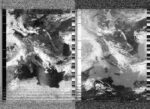

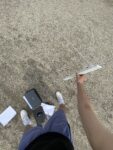
cloudy, warm and bright
2024-05-26 12:50:04
Sasha Engelmann
Hackney Downs, London, United Kingdom
United Kingdom
NOAA-18
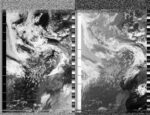
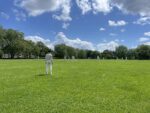
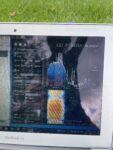
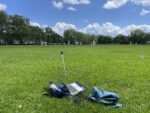
The pass started with an experience of signal flooding: Meteor MN2-3 drowned out the signal of NOAA-18 in a powerful broadcast many times the bandwidth of the analogue NOAA satellite. I could spot the Russian satellite by the characteristic 'surge' of energy that suddenly appeared around 137.9125 MHz, also the downlink frequency of NOAA-18. Only a few minutes later, I found myself speaking of another kind of flood with Ria and Philip, two Jehovah's witnesses who visited my ground station. We had a wonderful conversation about 'seeing' the satellite through radio waves and the types of clouds forming (of which Ria could identify many), and when I mentioned NOAA, Ria immediately connected the name to the Noah who predicted the great flood. I was immediately reminded of the words of Daisy Hildyard when she wrote a response to my and Soph's first open-weather performance, 'Open Work, Second Body'. Daisy begins with the story of Noah's ark as remembered by Proust: "Noah could never have had so a clear view of the world, wrote Proust, as when he gazed upon it from within his ark, sealed though it was, and when darkness was all over the Earth". Later, she describes, "that feeling that isolation and solitude can illuminate if not irradiate a feeling of the outside world". As it was for Ria, for Daisy, "it's hard not to see a gesture toward the old story of the ark that floats alone above the world it came from, a story that was also about making sense of strange weather and predicting or creating futures... a story about how different bodies weather the environment differently". As I leave the park, Ria asks if I can email her the satellite image, and of course I say yes. I think about the image as another kind of ark, floating between my laptop and Ria's, though perhaps on a journey that, by virtue of our conversation, is slightly less lonely.
2024-05-25 13:01:26
Sasha Engelmann
Hackney Downs, London, United Kingdom
United Kingdom
NOAA-18
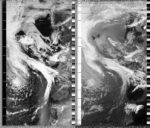
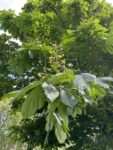
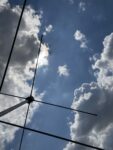
In a new book called 'The Nerves and their Endings: essays on crisis and response', Jessica Gaitán Johannesson writes, "For those who haven't yet experienced climate collapse in our own bodies, a history not yet written into us, the feeling [of] it arrives in the shape of shadows, an atmospheric wrongness, and harrowing predictions" (Johanesson, 2022: 6). When Johannesson refers to 'those of us who haven't yet experienced climate collapse in our own bodies' she invokes a double meaning. Those who haven't yet experienced climate collapse in a bodily way might refer to the privileged, largely global north 'us' who have yet to experience the world-endings of global heating in an immediate, visceral sense. However, since Jessica opens the book with a vignette from a hospital ward where she was treated for anorexia in her 20s, this phrase may also refer to 'those of us who haven't experienced climate collapse in our own bodies - i.e. an illness like that of an eating disorder' that is fundamentally an illness of control, but also one in which agency (the 'cause') is heavily blurred by the 'slow violence' of gradual but persistent self-harm, diet culture, fashion imagery, 'health magazines', enforced gender binaries, parents and friends too scared or busy to say anything, and the exposures of growing up in capitalism. Johanesson makes the point that by the time one ends up in a hospital ward because every day, for a long time, one has chosen death over life, the advertisers, celebrities, coaches and early childhood events are long gone- you are all that is left, and there may not be much of you left. By the time we cross 1.5 degrees Celsius warming, the 16th century colonisers of Africa and the Americas, the architects of 'development' and 'aid', and the engineers of late liberal capital, are long gone. I do think the analogy has its limits. But I wonder, with Johanesson: might it be that those who have reached the brink of inexistence (by their own means) and come back, who have responded to the harms of contemporary society by so severely harming themselves, and then returned, have something to say about 'climate collapse'? Might they see a bit further than most through 'the shape of shadows' the 'atmospheric wrongness' and the 'harrowing predictions' ? And might the tools of recovery be relevant - tools that require one, every day, long after one might be 'recovered' (as recovery 'never ends'), to consciously 'choose the world'; teachings that one is not 'in control', no matter how much control one may have demonstrated by not eating for days; and the insight that unless the world around us is nourished, we will fail to nourish ourselves.
2024-05-24 09:10:47
Sasha Engelmann
Founder's Field, Royal Holloway University of London, United Kingdom
United Kingdom
NOAA-15
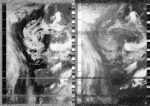
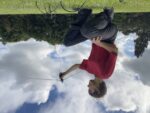
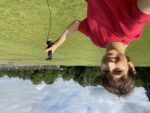
Today, the headlines say that the ICJ is delivering 'a new ruling on Israel's war in Gaza'. In doing so, reporters state, the ICJ could order a halt to Israel's offensive. This is coming months after the ICJ ruled that Israel was plausibly committing genocide back in January, and many thousands of deaths later. Meanwhile, Israeli forces intensify attacks in Jabalia and Rafah. Meanwhile, the Guardian warns that we are about to experience the busiest bank holiday in years with more than half the nation's cars on the road this upcoming weekend. Meanwhile, this last week's heavy rains have caused playgrounds in East London to flood with sewage, according to my geography colleague who lives on a boat and works as a river guardian. Meanwhile, students in my department are taking an exam in a third year cultural geography course on commodities. The university campus is green, leafy and quiet; there are no visible acts of protest, no encampment, no sit-in or lie-in. Yet, from a union meeting earlier in the week, I know the university has passed new policy making it more difficult for students to engage in protest in the form of encampments, though people objected to this new policy being called 'draconian'. In a poem titled 'Fuck your lecture on craft, my people are dying' Noor Hindi writes "Colonizers write about flowers / I tell you about children throwing rocks at Israeli tanks / seconds before becoming daisies". Later she writes, "Metaphors about death are for poets who think ghosts care about sound / When I die, I promise to haunt you forever".
2024-05-23 21:21:17
Soph Dyer
Friedhof Hernals (Hernals Cemetery), Wien, Austria
Austria
NOAA-19

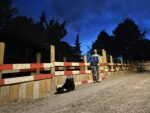
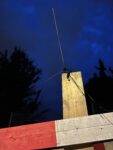
Again, my phone's weather app says that it will rain, but the day turns out fine. I doubt the algorithm's ability to account for the dramatic effect of the Alps on Vienna's weather. There can be huge thunderstorms only a couple hundred kilometres South, and Vienna will be basking in sunshine. My day, too, defies my expectations. I woke early, rough, the swelling in eye gone down but the pain in my side throbbing. Yet work was good and afterwards I cycle to an outdoor pool, then indulged in sushi at a neighbourhood restaurant with N. I received this image from a hilltop cemetery. In the silence afterwards, stood on a path between the flickering of red lamps of graves, I feel time thicken. I am reminded of how Libyan author Hisham Matar, when stood at a cemetery's edge, asks "What is it to remember the dead?" For Matar, "the scale is unfathomable". It is "[d]eath’s endless appetite", he writes. "The deceased outnumber the living by such a scale that the present suddenly seemed to me to be the golden rim of a cloth". (Matar 2019)
2024-05-23 11:45:30
Sasha Engelmann
Hackney Downs, London, United Kingdom
United Kingdom
NOAA-18
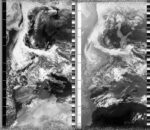
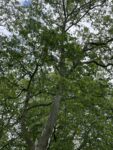
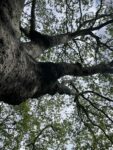
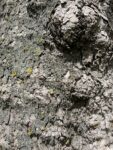
As I knelt in the cut grass watching an image from NOAA-18 form, I noticed a tall man drawing a yellow tape around the gnarly plane trees nearby. After measuring the circumference he started to circle the trees from below and make notes on a pad. When I was done with the satellite pass I went over to speak to him, and learned that his name was Nathan, and he was surveying the plane trees for health on behalf of the local council. He told me about Massaria disease, believed to be caused by the fungus Splanchnonema platani, which used to be known as Massaria platani until scientists discovered features that required a species name-change. Massaria disease has been found in several parts of the UK in the 21st century, but it is believed to originate in the Mediterranean region. Yet spores were even detected in the air by a survey ship stationed over the mid Atlantic oceanic ridge between the Carribbean and Africa. The distance was somehow fresh in my mind as I had just captured a long satellite pass that included a long stretch of the Atlantic. The fungus has a reddish colour and causes bark to peel off branches, and eventually branches die back. Massaria specifically affects plane trees, but because plane trees are so crucial to the health of London - their leave collect and absorb air pollution, they provide large amounts of shade, and they are resistant to other urban conditions including heat - the Massaria has implicitations for the exposures and vulnerabilities of London's human communities. Nathan suspects most plane trees already have the disease, but it is when they become stressed that they manifest symptoms and health issues. The plane tree in front of us was probably 200 years old, had a diameter of 160 cm, and was doing reasonably well despite its 'pruning scars' and one low-hanging branch that showed signs of Massaria. Nathan asked me in return about my antenna and what I had been measuring. There was something poignant in our encounter - a tree health specialist carrying a diameter tape and notepad, and me with a handheld antenna and laptop - reflecting on air-travelling spores, urban trees and climate.
2024-05-23 08:56:54
Jasper Knaebel
Vienna, Austria
Austria
NOAA-15


Sunny morning, slightly hazy sky
2024-05-22 11:58:09
Sasha Engelmann
Hackney Downs, London, United Kingdom
United Kingdom
NOAA-18
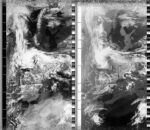
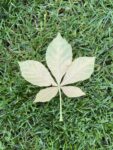
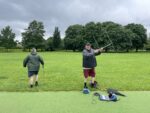
The surfaces of London are covered in traces of the downpour that happened last night. Though the rivers and ponds of water have drained away somehow, pools and thick mud remain. I meet Bill, his partner and their dog Nutmeg during a break in the rain on Hackney Downs. We speak about gravitational waves and the aurora. Bill asks to hold the turnstile antenna and kindly agrees to a photo. As they head on their way, I overhear Bill explaining to another dog owner what I am doing, and I feel grateful that Bill has become a mediator for the project in the neighbourhood, as I might otherwise get quite different reactions! Meanwhile the satellite stays 'in the sky' so long that my recording software automatically cuts off the recording when it nears fifteen minutes, but I can still 'see' the signal. As I decode and examine the weather image that reaches from Kirkenes, Norway to the Western Sahara, I join an online call where my union debates a motion to show solidarity with Palestine in the context of the ongoing 'scholasticide' in Gaza. After much discussion about 'logical fallacies' and whether the motion was 'doing too much', we are called to vote on a secondary motion to let the authors of the first motion take more time to amend its 'scope' before we actually vote on it. Meanwhile, someone in the room says, over 35,000 people in Gaza have been killed. Those who live in the ever-expanding houseless camps near Rafah are deeply unsafe and vulnerable. And yet those of us who are safe, who can 'drink a gin and tonic and go to bed' as one member puts it, are fighting about whether we should keep a point saying the university should divest from arms manufacturers involved in the unfolding genocide.
2024-05-22 09:25:54
Soph Dyer
At home, Hernals, Wien, Austria
Austria
NOAA-15

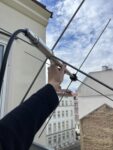
The air is fresh. Broken sun and wind. I left the bedroom window open during the night and half-asleep-half-awake dreamt of a fierce wind, rain lashing the window, and flying debris. I have been thinking and writing about 'fire weather'. This morning, staring my left eye that had swollen shut in the night, for not apparent reason, I wondered if inflammation is a an internal, bodily fire weather.
2024-05-21 13:12:14
Soph Dyer
Augarten, Vienna, Austria
Austria
NOAA-18
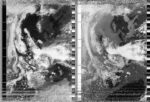
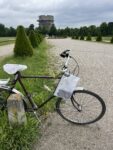
Its humid, muggy, close or "schwül" as my German speking studio mate, DD, said before we tried to find a good translation. Weather words rarely seem to translate one-to-one. Or, perhaps this is true for all words, and the high situated, experiential nature of weather exposes the limits of translation. Perhaps then we should get better at learning each other words for weather? Extend our fluency in talking about the 'ever starnger weather' and decoding memories of past weather. Or, maybe we should not rely too heavily on words to communicate weather? After all, its so bodily. Here, it is getting 'muggier'. I am going home as I feel a heaache coming on.
2024-05-21 10:58:24
Sasha Engelmann
Brunswick Square Gardens, London, United Kingdom
United Kingdom
NOAA-19

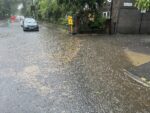
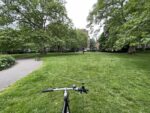
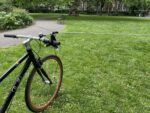
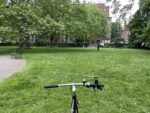
Brunswick Square Gardens was empty this morning except for a circle of exchange students trading stories about English habits of life, and a long-haired older man walking in circles, puffing on a joint and coughing vigorously. Despite the tall brick buildings around the square I was able to capture a relatively clear image of the UK and the middle of the continent. Yet I failed to recognise the impending rain that would baffle all predictions for the day's weather. Later in the afternoon, at a seminar where three of my PhD students were presenting their work while weather brewed above, ideas of the planetary were discussed in relation to sonic geographies. One of my students is building networks of 'live audio streams' as an investigative tool to listen to sites of extraction, and another is listening across great timespans and timelines through conservtion bioacoustics archives, through which scientists trace the changing compositions of species in landscapes, and observe how the memory of sound is intergenerational, held in the bodies of animals (even non vocal animals) in ways that far exceeds individual lifetimes. As I listened quietly, resisting the urge to speak as the rest of the research group asked probing questions, I reflected on the different modes of planetary 'stretching' and 'scaling' being enacted in their work, and the devices they were using, from DIY audio streamers to experimental notation systems. The climate crisis requires us to 'stretch' and 'scale' but sometimes our conceptual frameworks scale unevenly or in unexpected ways. By the time we had celebrated the seminar and had dinner, the brewing weather had arrived, and it was pouring (an event that had not been predicted on any platform I had checked which suggested 35 percent light rain). I cycled home for 40 minutes, at times coasting through rivers of water that came up to my standing knee. Of course I had also worn my nice white trousers. I felt thoroughly stuck in space-time, unable to stretch or extend, each peddle bringing me two metres closer to home.
2024-05-20 12:22:50
Sasha Engelmann
Hackney Downs, London, United Kingdom
United Kingdom
NOAA-18
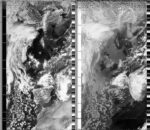
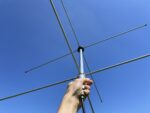
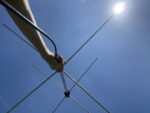
Some days I feel as if so much in the world 'matters', that what we choose 'matters' for us is a very risky and selective exercise. I am re-reading (for probably the twentieth time) Tim Choy's chapter on 'Air's substantiations' in his book Ecologies of Comparison (2011). Tim describes how, as an ethnographer in Hong Kong, he tried to ignore the city's worsening air pollution because wealthy, foreign business people were the ones most often complaining about the air. In contrast, local communities in Hong Kong were suspicious of middle-class and elite efforts to use air pollution data as a political device. It was only when Tim's partner developed a series of very bad sinus infections, and when air pollution made headlines when Disney's boss voiced concerns about locating a Disneyland in Hong Kong due to 'poor air' and its disruption to 'family values', that Tim started to take air's matter seriously. In ignoring the air, Tim was drawing 'lines of distinction' between himself and the largely white foreigners, though he is hardly a local either. In other words, by drawing lines of distinction as we all do every day, we are capable of ignoring what does not align with us, even when that thing is the most obvious element of life. I have been feeling this in relation to heat. I am noticing how people in the UK draw lines of distinction around heat, when for example someone claims to be a 'sunny person', 'warm blooded' or 'Mediterranean at heart', and so better served by sun than rain. This is a relatively inocuous alignment in some ways, but in others it suggests lines of affinity between people and certain geographies, some of which the people doing the aligning have never actually visited, or if so only rarely on holiday. Some of these geographies are also the ones most affected by global heating. What level of heat, or what new distinctions, will maintain or redraw these alignments?
2024-05-20 11:44:50
Soph Dyer
Diepoldpark, by the picnic benches, Vienna, Austria
Austria
NOAA-18

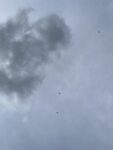
Happy launch-day satellite NOAA-18! It's been 19 years since on this day in 2005 you were launched from Vandenberg Space Force Base in California. Your planned mission was only two years, yet you are still transmitting. Back on Earth, I have cast aside my mum's landline telephone, for a Motorola mobile, for a my first smart phone (a friend's hand-me-down), for an iPhone 13. Can you imagine? It's a pocket-sized radio transceiver that has more computing power than Apollo 11. Dear NOAA-18, radio technology has not only transformed how we make phone calls, it has become cheap and easy to combine with code. While you have been in orbit, software defined radio has become a truly low cost alternative to conventional radio – it is what makes this project, open-weather, possible. Perhaps you already know this since last year, the American government outsourced the management of your data to the longtime defence contractor, Parsons Corporation. Parsons enrolled you in trial cloud-based ground system that is running off Microsoft Azure. As I mentioned in a previous Weather Note, Microsoft has announced that it is building a 'Planetary Computer'. Given your involvement in the trial, it is probable that in your "extended life" you are helping to build this 'digital double' of Earth. Next year, in September, the contract awarded to Parsons to maintain you expires. September 2025 could be date of your mission, but we don't that as information is hard to find. (Parsons, 2022; NOAA, 2023; NCEI, 2023). If true, you have one more birthday to celebrate. Until next year NOAA-18!
2024-05-19 22:10:44
Soph Dyer
On the window sill, Hernals, Vienna, Austria
Austria
NOAA-19
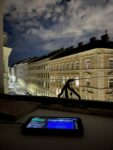
I willed myself to stay awake to capture the transmission, even if I knew that it would likely be more noise than image because of the low elevation of the satellite. I missed yesterday. Another absence in the archive due to another night's sleep lost to discomfort. The weather was better than expected today, so I dragged my body out of the house into the city and into contact with other bodies. I went to a beautifully queer refugee football tournament with M, where we sat in the sun and sweated; a solo swim in the cooling waters of Kongreßbad; to the Kino de France where I sat in the airless dark and watched GUAPO’Y by Peruvian director Sofía Paoli Thorne, my body tensing at the noise of a young guy in the row in front, munching popcorn; and lastly to the warmth of friend's flat for a takeaway curry with her adorable two-year-old. I am particularly excited about my first swim at Kongreßbad. It's incredible outdoor pool complex opened in 1928 during the 'Red Vienna' years, when the Social Democratic Workers' Party of Austria (SDAP) governed the city. Despite my sleeplessness, it has been a full day. I meditate on this and give my thanks as I receive NOAA-19.
2024-05-19 12:36:44
Sasha Engelmann
Private field near Leigh Woods, Bristol, United Kingdom
United Kingdom
NOAA-18
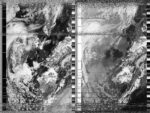
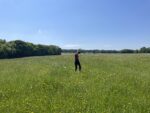
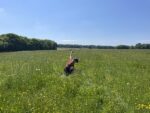
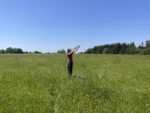
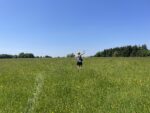
I awoke this morning with a slightly sore head after one too many Ardnamarchan whiskies in a pub on a hilltop in Bristol. Sun blazed through the ‘blackout’ curtains. Bristolians had been anticipating Sun for several days, as we learned when speaking to a friend who runs a small cafe on the Northwest side of the city. There were numerous jokes, practically by everyone who walked in the cafe, about how rarely the Sun appeared and how the summer would be ‘over in three days’. Today my partner and I got a ride to the edge of town and spent the day in Leigh Woods, pointing out sculptural roots and feeling our way through the landscape without much help from maps. I wondered how common the experience of ‘data free’ or ‘no connection’ zones might be in a Sar-linked or One-web future. We hopped a twisted wire fence into a field of high grass and wildflowers to capture a satellite image from NOAA-18. Later, passing by the wide silty banks of the River Avon we stopped to watch small rivulets carving lines into the hillside. Having walked for over four hours we finally arrived back in Clifton Village for a 3:30pm lunch and ordered piles of food. Before the food arrived a middle aged man fainted and nearly fell over while standing next to our table. My partner helped catch him, and while he recovered I remembered my own short-lived phase of fainting in public while standing on street corners in hot, humid Manhattan in the summer of 2011. This was the summer that Hurricane Irene hit New York City and much of Manhattan was evacuated, an eerie precursor to Hurricane Sandy.
2024-05-18 09:51:04
Sasha Engelmann
Hackney Downs, London, United Kingdom
United Kingdom
NOAA-19
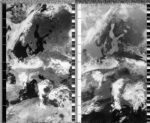
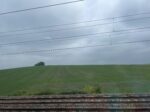
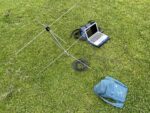
I knew I was out earlier than usual this morning as the fluorescent cones for the children's soccer practice had yet to be distributed across the field, and balls were piled in a corner. The air was grey, and though it wasn't exactly foggy, things felt muted, soft and indistinct. This made me think of Craig Martin's article on fog (one of the first articles I really engaged with in my studies of atmosphere as a young MRes student at Oxford). Fog, for Martin, "is located at the interstices of the incoming and the outgoing: lingering at this juncture, it could be said to determine the immanent connection between body and world" (2011: 456). In other words, fog makes us feel the air as something 'thickening', but in doing so, it demonstrates "a different absorption of time and space" (458), one that counters the 'invisible' and 'transparent' freedom we often associate with air. There is also something resonant between the experience of fog and that of heat. Martin quotes Taussig: "Heat... is a force like color, that sets aside the understanding in place of something less conscious and more overflowing, radiance instead of line, immanence instead of the famous bird's eye view" (Taussig, cited in Martin, 2011: 457). Later in the morning, on a train to Bristol, I decode the satellite image and the cloud-free lakes of Russia come into view once again. I think about the exactness of the image: today it feels full of lines, curves and arcs, land-shapes outlined against the darkness of ocean. Instead I try to feel the 'thickening' of air and fog, and the 'radiance' and 'immanence' of the too-warm land.
2024-05-17 12:22:00
Soph Dyer
Augarten by the flowers, Wien, Austria
Austria
NOAA-18
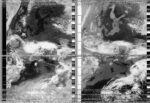
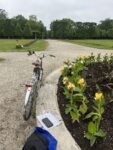
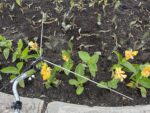
Dust, grey skies, low light. I am reading over lunch an article on Microsoft's Planetary Computer, shared with me by Sasha. I began reading it during my last hospital appointment, which felt appropriate as, in my experience, hospitals are sites dislocation, dissociation and disorientation (as well as the putting back together of bodies). The authors are arguing for "pluralising the planetary" and recognising its "radical incompleteness"; they are favouring "messy operation(s)" over smooth form (Richardson and Munster, 2023). I message Sasha extracts, so as to not forget them and share resonances. The first reads "a computational enclosure reimagined as liberation".
2024-05-17 10:03:25
Sasha Engelmann
Hackney Downs, London, United Kingdom
United Kingdom
NOAA-19
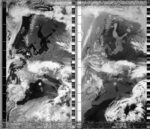
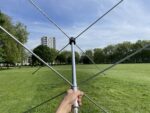
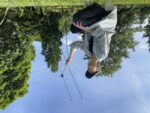
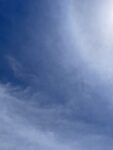

Water and dust: these are the two prominent features in the satellite image I collected today. In the North, Lake Onega and Lake Ladoga are dark prints in the land near the now ice-free Gulf of Bothnia. Northern Europe is unusually cloud-free and seeing these lakes so clearly makes me feel uneasy, as if these waters are 'laid bare' by the sun. Another notable 'body of water' in the satellite image is unmarked on Google maps, but searching further reveals this is the Rybinsk Reservoir built by Russia in 1935. It was the largest man-made body of water at the time of its construction. The reservoir caused 150,000 people to be displaced and over 600 villages were submerged. In contrast, further South, there are other geographies and histories of immersion and displacement. The borders of sea and land are obscured in places by a current of dust making a soft streak from Tunis to the Southern tip of Sicily. News media are alert to this dust in different ways: an online publication called Gloucestershire Live warns readers that a 'scorching' Saharan dust plume is about to 'hit' the UK, and goes so far as to offer advice for how to 'properly clean your car' (hint: 'brushing' is not enough!). In the Swindon Advertiser, Saharan dust will 'sweep' across the UK. Yet in the Metro, these alerts to dust are dismissed with evidence from the Met Office: "their forecasts have no suggestion of a Saharan plume heading our way – good news for our cars which would otherwise end up coated in dust". The car is, once again, the primary surface on which we 'see' dust in European news media, and the object that needs most protection from it. When there are half-hearted gestures to the way dust can affect breathing for 'vulnerable' and 'asthmatic' people, these are rarely gifted the same emotional fervor for protection. There, scattered across the windscreen or front hood, dust speckles and glitters, forming 'galaxies' (as described by Nicola via Soph in an earlier weather note) to be 'properly' and thoroughly removed in the wash.
2024-05-15 21:23:30
Soph Dyer
On the balcony, Wien, Austria
Austria
NOAA-19

Apparenly poets and shopping centre security guards can be assassins too. The media are reporting that there has been an assasination attempt on the incoming Prime Minister of Slovakia. The location is a few hundred kilometres from Vienna. News feeds identify the assassin not by name but by his profession: shopping centre security guard and poet. Poignantly, NOAA-19 passed between Vienna and Bratislava. I am certain that saw the satellite. I had set an alarm on my phone for the satellite pass but when it rang I had just drained a pan of boiled asparagus, so I gave into to hunger and ate dinner. After finishing, I ran outside to catch the second half of the pass. I used the new cable Sasha has sent me. It is a clear night and a gentle temperature. Earlier, I swam in the Danube. It was windy and spray forced my eyes shut. I had the water to myself, save for a swan and passing cyclists and whatever or whoever was lurking below. I dived in a couple of times before almost slipping on the plastic pontoon. Swimming is perhaps the most effective way I deal with pain. I hope today is the last day of my period-related pains and restless nights. My body is aching to begin the slow process of unknotting itself.
2024-05-16 11:34:21
Sasha Engelmann
Hackney Downs, London, United Kingdom
United Kingdom
NOAA-18
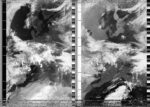
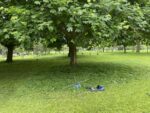
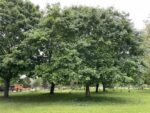
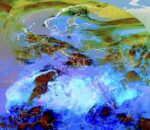
Though the sky was bright, a light speckling of rain fell as I walked to the park. A crowd of people was spilling outside the Open Doors Baptist Church. The attire was mostly black, however, so I wondered if there was a funeral or memorial service. I took cover under the canopy of a sycamore tree. In the distance, I could hear the human companion of Muffin Man (a small black terrier) explaining to two women what I was doing. They were pointing in my direction and I caught phrases like "she works for..." and "I see her...". As they were deep in the shadow of the grove of trees and I was on the edge of the shade I felt like I was on display in a lightbox, silently going through motions. They didn't approach. The satellite passed to the East and a large part of the Mediterranean appeared on my screen. I assumed there was sun-glint when I saw some blurriness over the ocean, but later realised there were wisps of dust. Using EumetView and the Dust RGB algorithm I confirmed the dust, which appears in a soft cloud of magenta-pink over Northern Africa, Sicily and the seawater in between. I thought of Aya Nassar's words about dust as an 'unravelling traveller' (2021: 458) and wondered how the dust was moving, circling, shifting in its passage. Through the tools of remote sensing and the algorithms used to 'enhance' what is sensed, the dust felt like another curious moving entity, silently on display.
2024-05-16 12:32:00
Soph Dyer
Augarten, Wien, Austria
Austria
NOAA-18
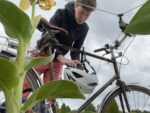
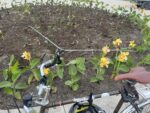
It didn't record, which was such a shame as the satellite pass was long and a sweet 60 degrees to my West. The weather is here warm, gusty and cloudy. The weather app on my phone says that it'll be cloudy for the next two weeks – I hope not. After reading a news story on how people with freckles are at high risk of skin damage, I purchased a pocket-sized tube of sun cream. I am ready for the sun and now its gone. The Slovakian Prime Minister has survived the attack on his life. The latest reports suggest the gunman is in his 70s. It is likely that he grew up in the Soviet era Czechoslovakia and lived through the 'Gentle Revolution', possibly even the 1968 Prague Spring.
2024-05-15 10:29:49
Sasha Engelmann
Founder's Field, Royal Holloway University of London, United Kingdom
United Kingdom
NOAA-19

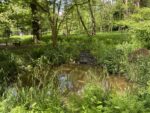
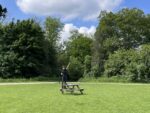
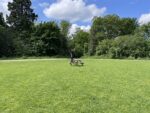
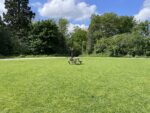
In a recent article on 'breathing climate crises', Blanche Verlie and Astrida Neimanis advocate for a move beyond strategies of bodily 'attunement' found widely in the environmental humanities and toward practices of 'conspiratorial witnessing' involving the use of 'proxy stories' as 'amplifiers and sensitisers' of our own attunements (2023: 126). For these authors, microscopes, qualitative interviews and poems might all be "mediating prostheses that open certain experiences for us" (2023: 126). As I stand on a picnic table on the west side of Founders Field at Royal Holloway, I think about the antenna I am holding as a prosethetic. This is not unfamiliar: together with other members of open-weather, Soph and I have written about the relationship of body to satellite (and DIY ground station) as a “subversive prosthetic” (Engelmann et al., 2022). In later writing (Engelmann, 2023), and in dialogue with Soph’s masters dissertation work on the material politics of radio (Dyer 2017), I have tried to understand the relationship of body to antenna (and satellite) not through the lens of the prosethetic but as a mutual 'agitation': an agitation of embodied and sensory weather knowledges, and, in turn, an agitation of the “scientific weather” made accessible through orbiting satellites. When we use technologies to tell 'proxy stories' of weather and climate, how much do we need to account for the way these stories come into friction, creating agitation and heat? How might this agitation, this heat, itself be a site of 'witnessing climate'? Midway through my satellite pass on Founder's Field I manage to ask a second-year undergraduate 'Financial and Business Economics' student to take some documentation photos of me waving the antenna at the sky. He politely keeps from looking amused or bewildered. Walking down from the field through the Royal Holloway woodland, I can't help but notice the swampy waters of the woodland pool and a green-feathered duck asleep at the bank. The woods are buzzing with green life, but they feel far too warm and languid for May. Later in the afternoon at a staff meeting, serious conversations about university finances cause various states of anxiety and worry, and bodies slope in their chairs. I think: how do we witness when things heat up? What is the 'heat' we witness?
2024-05-14 22:49:02
Soph Dyer
On my balcony, Wien, Austria
Austria
NOAA-18

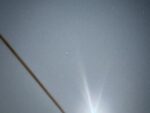
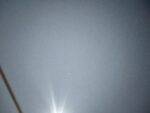
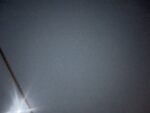
I saw NOAA-18. I tuned off the lights and then, like magic, mid-pass, a white dot appeared almost directly overhead. I could keep eyes on it for several minutes. The satellite glided across the sky, so much faster than I had imagine. It makes sense, that the satellite appears to accelerate when directly overhead and then slow down as it approaches the horizon. Despite this logic, I had always imagined it moving at a constant speed, like the hand of a clock. I am twitching with excitement.
2024-05-14 10:41:48
Sasha Engelmann
Mint Street Park, London, United Kingdom
United Kingdom
NOAA-19

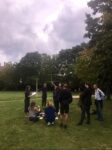
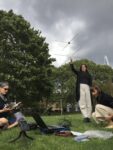
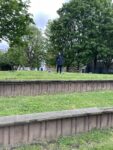
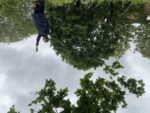
After an early morning appointment near London Bridge I paid homage to a site that hosted one of the first 'satellite seances' of open-weather in August 2019: Mint Street Park. As I set up my ground station next to a large flock of pigeons at the top of the park's terraced mound, I remembered the gathering of people who had participated in a satellite pass and poetry reading (by JR Carpenter) at the same location almost five years ago, as part of a series of gatherings and a reading group called 'Weather or not', led and curated by Arjuna Neumann. Soph and I contributed regularly to the reading group and discussion sessions for several months before open-weather was initiated. Today, the air is far colder and my laptop is speckled with rain. I ask a lone walker to take a photo and he takes fifteen. Later, I am meeting the author and scholar Jean-Thomas Tremblay for coffee in central London. They are visiting London for a conference and it is a rare chance to meet a North American scholar who I admire so much. Tremblay wrote the incredible book Breathing Aesthetics (Duke, 2022) that has circulated widely in the humanities and has inspired entire exhibitions in Canada, and I was asked to review it. The review came out last week. Over coffee, at the end of a conversation about book writing, air scholarship, environmental humanities and 'negative action' (another forthcoming book by Tremblay) I show them the satellite image and ask if they would like to contribute to this weather note. This is a half-typed, half paraphrased record of what Tremblay generously offered: "In the context of the Palestine solidarity movements I am thinking about the lack or absence of the possibility of gatherings for resistance [in London]. I am thinking a lot about denouncement... this has been a bit uncanny to see [here]. When I was in New York City a few weeks ago there was an omnipresence of the performance of politics (in the most generous sense of performance), and I've been looking for it here"
2024-05-13 23:01:31
Soph Dyer
Balcony, Wien, Austria
Austria
NOAA-18

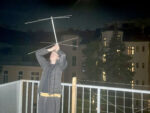
Sun, clouds, and a cool wind. Today is a day of body euphoria. This has become a monthly ritual and one I should get better at celebrating. I am back inside my body and its a wonderous feeling: I have energy and I feel (almost) clear headed. After a long day of work calls, I made it out of the house around 7:45 pm to buy food from the local supermarket before close. On my way home, the sun was low, hidden, except for explosions of gold at the end of every side street. I walked slowly and took in the soothing quality of the light.
2024-05-13 12:10:02
Sasha Engelmann
Hackney Downs, London, United Kingdom
United Kingdom
NOAA-18
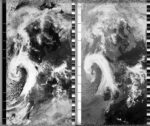


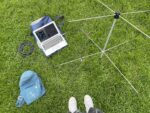
I received some bad news last night, and made the mistake of watching a TV show that is a dark, psychological thriller before bed. I dreamed I was in a city under siege and friends were scattered in distant countries. I was trying to send them messages hidden in the frequencies and lyrics of protest songs. A light but deeply gray cloud hangs over London and the park was almost entirely deserted, strange after the way it filled to the brim with people over the weekend. On my walk home I noticed the glossy new leaves of a young horse chestnut tree, and I wondered about its red pigmentation – is it absorbing different wavelengths of light?
2024-05-12 23:13:34
Soph Dyer
My flat, Wien, Austria
Austria
NOAA-18

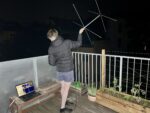
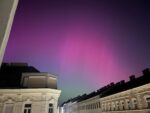
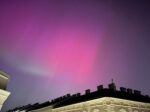
My hormones have been so low, I have felt dislocated from my body. Come this evening I finally felt a little better. Last night, I was up until 2am watching the Northern Lights or Polarlitchter from a north-facing window in our flat. I was incredibly lucky as I hadn't seen the space weather forecast, but a friend messaged, "Don’t forget there might be polar lights tonight!". At first, I thought that she had misunderstood – we're too far South. Google affirmed my skepticism. Still, it was a clear night so I looked outside. At first, I could see nothing. After around five minutes a bright pink glow appeared behind the rooftops. I completely freaked out. N and I dropped our plans to sleep and ran to a local sports ground. We were both in a state of shock and awe. In my elation called Sasha, texted my family in the UK "Look North!", patronised N for using a flash, and garbled "Danke" to a groundsman who was explaining that we needed to leave as he was locking up. We headed to a local park but the lights had dimmed to a level were I wasn't sure if I could still see them or the pink glow had burned itself into my imagination. Back at home they flared again, this time visible from the flat. N went to bed but I stayed up watching. The pink became almost as vivid as in the long exposure photos I had been taking. White shafts of light appeared and disappeared, so did a fainter green glow. My skin tingles just thinking about it.
2024-05-12 12:23:03
Sasha Engelmann
Hackney Downs, London, United Kingdom
United Kingdom
NOAA-18
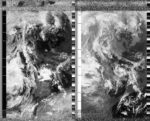
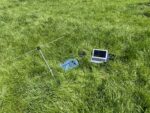
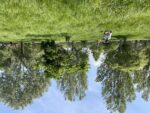
I spent an inordinate amount of my waking hours this weekend doing two things: 1) looking for and thinking about the aurora during the unfolding geomagnetic storm that started on Friday, and 2) re-reading Sara Ahmed's book Queer Phenomenology. My head and body are full of orientations. Last night I went out after 11pm to see the northern lights again. After the news media coverage of the G5 storm and the countless magenta-pink photographs on social media, the park was unusually crowded, and I could see people craning their necks to the sky. One person said in the distance: "does anyone see it? Oh come on!" as if urging the ions and Oxygen isotopes to light up on cue. The intensity of the solar storm had decreased and there was less chance of seeing any colour last night. Yet I couldn't help but think more about what was happening to everyone in the middle of their Saturday evenings, standing in a park and peering into the dark, trying to see pink. Ahmed writes, "Seeing such objects as if for the first time... involves wonder, it allows the object to breathe not through a forgetting of its history but by allowing this history to come alive" (2006: 163-164). The bodies in the park were certainly poised for wonder, eager to see the urban night sky 'as if for the first time'. It would be easy to suggest that people were disappointed, but I think something else happened. In the gesture of going out in the dark, waiting and gazing up, and in seeing this gesture repeated by many bodies, I think something did 'come alive'. We faced the same direction, we waited, we produced lines of orientation (and disorientation). While this sounds romantic, I don't think it was; indeed we can question how romantic a gesture of 'looking up' really is when the sky is occluded with light pollution, smog and strings of corporate satellites forming a shell around earth. Instead I think this was about "allowing the oblique to open up another angle on the world" (2016: 172). It was about seeing (and failing to see) something wondrous, something strange and unusual 'coming alive' in the opaque familiarity of the urban night.
2024-05-11 12:36:42
Sasha Engelmann
Hackney Downs, London, United Kingdom
United Kingdom
NOAA-18
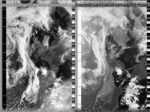
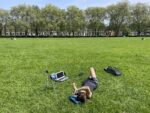


A geomagnetic storm reached Earth in the last twenty four hours, creating magenta-pink auroras as far South as Florida. Last night around 10:30pm Soph called me when a bright pink streak appeared over Vienna and I rushed to a window to look North, only to find that there was nothing pink in the sky of London. Heading out to the park, I found a spot in the middle of the largest field, where I normally set up my DIY satellite ground station, and waited. I could hear the club night in full swing at The Star, and I could practically feel the friction of bodies, torn tights and trainers on the sweaty dancefloor. In contrast, the open grass was invitingly dark and cool. A few minutes later I thought I could see a faint pink glow. It grew slowly in intensity. At first I thought I was wishfully imagining it, but suddenly I felt overwhelmed with its vastness and managed to take a photograph. My iphone could see the colour better than me. Like many thousands of other people I dreamed of the aurora last night, and woke up today with its colour fresh in my memory. I wondered what form of collective unconscious we were experiencing, and I remembered Sara Ahmed's words: "We are turned toward things. Such things make an impression on us". Where are we turned when we turn toward the nebulous aurora, collectively? What are its impressions? Another coronal mass ejection is apparently on its way to Earth now, according to space weather scientists. These ejections affect radio: "Radiation from the flare caused a deep shortwave radio blackout over the Pacific Ocean. Ham radio operators and mariners may have noticed loss of signal at frequencies below 30 MHz for as much as an hour after the flare's peak" (Spaceweather.com). The NOAA satellites transmit at 137 Mhz, far from the 'blackout' in the shortwave frequencies, but I still wonder whether transmission could be altered, distorted, even slightly 'agitated' by the spike in charged particles reaching us from our nearest Star. Today during the satellite pass, in the bright sun not far from where I stood last night, three girls passed by some distance away from me, and I could hear one say: 'what is she doing??... is she charging her phone?!' Maybe not my phone, I thought, but I couldn't help wonder if I was charging something else as I pointed my antenna to the solar winds in the sky.
2024-05-10 11:31:05
Sasha Engelmann
Burgess Park, London, United Kingdom
United Kingdom
NOAA-19
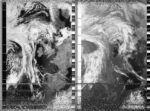
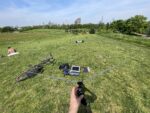
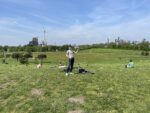
I have been thinking a lot about how atmosphere can gather like a force field around a person, an object, a space, a time. One of my favourite writers of atmosphere Kathleen Stewart, says: 'It was then that I began to think, along with others, that nameable clarities like family or friendship or love or collapse or laughing or telling stories or violence or place are all atmospherics. All forms of attending to what's happening, sensing out, accreting attachments and detachments, differences and indifferences, losses and proliferating possibilities' (2011: 448). This morning I cycled through the uncannily warm, dusty, petrol-infused air of London to Burgess Park, which used to be my local park and the place I captured many satellite images in the early days of open-weather. On the hill in the park I thought about its atmospherics, how my move to Hackney has changed my attachments and detachments to the park's hills, fields, communities and skyline. As if to interrupt my nostalgia, a couple men who had come to lie on the hill started speaking and then fighting. One started laughing at the other, clearly in a way to make him eveny more angry. I rushed to pack up my antenna and rolled down the hill on my bike, noticing that the other hilltop walkers had done the same.
2024-05-10 12:09:30
Soph Dyer
Just off Obere Augartenstraß, Wien, Austria
Austria
NOAA-18

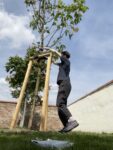
Woke up to Netanyahu's face on the front page of the Guardian. Felt grim despair. Got up, messaged my sister, made a medical appointment, and went to the studio. I received this image on my way in. Veronika, my studio mate, had made spare lunch so we ate together with her collaborator, T. Being cooked food quiets the soul. My hormones at still languishing somewhere at the bottom of the mid Atlantic trench. I feel dreadful. It's a beautifully sunny, clear day.
2024-05-09 11:44:18
Sasha Engelmann
Founder's Field, Royal Holloway University of London, United Kingdom
United Kingdom
NOAA-19

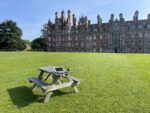
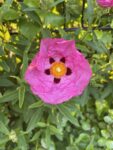
On my walk to the train station at 6:30am, the sun was already warming the park and highlighting its colours. I passed an orchid rockrose that looked eager to be seen, so I stopped and took its portrait. I learned later that rockrose flowers last one day. Later, at the university geography department where I work, I attended a seminar on 'plant humanities' in which someone suggested that plants 'scale time' in nonlinear ways. They hold hours, minutes, and seconds in recursive spirals, cycles and loops. This made me speculate about non-linear plant-weathers. In the orange rays slanting through windows on the train ride home, I wondered if the rockrose was finishing its rotation or defiantly resisting the dimming light, stretching time.
2024-05-08 10:16:19
Sasha Engelmann
Hackney Downs, London, United Kingdom
United Kingdom
NOAA-19
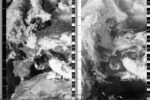
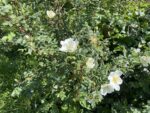
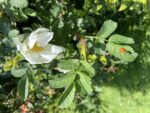
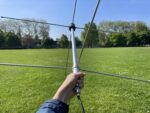
The sun has flooded London these last two days. I use the word 'flood' deliberately as the city feels like it is inundated with light, beyond its own capacity. In central London yesterday on an errand, I noticed people with their eyes closed, standing or lounging on streetcorners. The sun leaks into apartments and buildings through open doors and flung-wide windows. In the park today, I set up my ground station on the south side to feel even more of the sun's rays. Nearby a woman practiced throwing frisbees. A small terrier came running up to me with a growl, but soon softened as I said hello. 'You must be seeing a lot of weather today' the dog's owner said. I didn't know what he meant until he mentioned the thunderous rain on the bank holiday. As we spoke, the dog – who is named 'muffin man' due to an incident with some muffins – cuddled next to me on the grass. As I left I admired the burnet roses and the ladybugs asleep in their leaves.
2024-05-07 17:57:11
Sasha Engelmann
Hackney Downs, London, United Kingdom
United Kingdom
NOAA-15

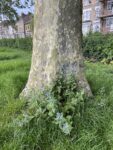
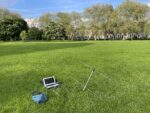
The solar elevation was only 10.2 degrees as NOAA-15 passed overhead in the early evening today. The chestnut trees, now dense with foliage and pink-white flowers, cast long shadows on the grass. A man and a young woman (I presumed his daughter) walked up behind me, the man asking 'are you in touch with outer space today?' or some variation. I explained the image loading in on the screen, though it was too dark to make out land and sea borders, and I fear it might have looked very abstract to them. As I left the park to do an errand I noted a burst of blue underneath a sycamore tree and identified the plant as 'green alkanet'. Reading later, I learned that the five petalled, deep blue flowers of green alkanet are edible and can be added to salads and drinks. The roots were traditionally used for red dye. And the leaves, though mildly toxic, have various medicinal properties, recommended for treatment of coughs, digestive issues and fevers. When crushed and combined with vinegar and rose water they are also an effective remedy for burns and ulcers. As I walked through the neighbourhood to the grocery store, I noticed how much green alkanet was springing out of cracks in brick, in shady corners and in other uncared-for places.
2024-05-06 19:19:44
Soph Dyer
On the corner of Diepold Park, Wien, Austria
Austria
NOAA-15

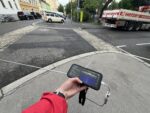
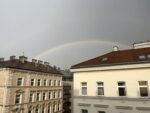
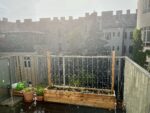
Bright sunlight, thunder booms and rain drops the size of marbles. Israel has ordered civilians to leave Rafah, but to where? In Vienna, European Election posters line the larger streets: Patriotisch, Zusammen in Europa, … I will try to collect the slogans.
2024-05-06 10:42:23
Sasha Engelmann
Downs Road, London, United Kingdom
United Kingdom
NOAA-19

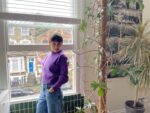
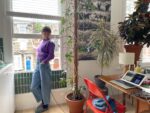
The Met Office have issued a 'thunder warning' and a 'wet washout' to the end of the Bank Holiday weekend. One forecaster commented, 'if you manage to avoid showers, then it will be nice in the sun'. The contrast in these comments struck me as I held my antenna out of the flat window to catch the signal of NOAA-19. If sun... then very nice sun! If rain... then thunder and floods.
2024-05-05 19:47:02
Soph Dyer
Reclaimed community garden, Hernals, Wien, Austria
Austria
NOAA-15
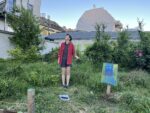
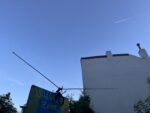
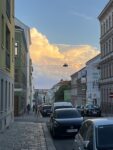
First day of summer, first mosquito bite of the 2024, my first ever swim in the Alte Donau (Old Danube). The forecast on my phone predicted rain at 3pm, but the clouds passed us and Veronika, her dog and I enjoyed several hours at the Alte Donau. We made the most of the cooling clear waters before they turn murky with summer algae and river weed. I didn't realise until I got home, how much my face had 'caught the sun'. I received an broken-up transmission from NOAA-15 in a long abandoned building lot, recently commandeered as an unofficial community garden. On the way home, I could see a towering anvil cloud to the South. Tomorrow should be sunny, despite multiple storms in the region.
2024-05-05 10:51:28
Sasha Engelmann
Hackney Downs, London, United Kingdom
United Kingdom
NOAA-19
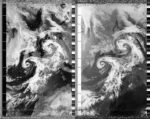
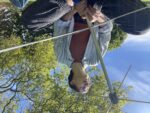
I returned home from Brighton very late last night after celebrating with a group of close friends, and memories of the beach, the sparklers we lit, the twilight and our group dances are fresh in my memory. The sun feels too bright for these memories! In the satellite image, two swirling cyclones curve over the Atlantic and northern Europe, and I am reminded of the von Kármán vortex streets, or repeated patterns of swirling vortices, described by Esther Leslie in her essay on 'Fog, Froth and Foam': 'stress factors on a curve, the agitation of the air, clouds, the wind...'
2024-05-04 21:54:40
Soph Dyer
On the balcony, Wien, Austria
Austria
NOAA-19

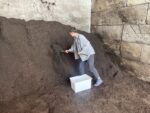
I think I saw NOAA-19! I was looking at the sky at exactly where I imagined NOAA-19 to be, 50 degrees above the horiszon to my West, and there was a faint white dot moving steady across the sky. It's a clear night but there visibility isn't exceptional and the stairwell lights of the neighbouring building kept turning on making it harder to see the stars. Yet, the position and velocity matched those of NOAA-19. I could only track the faint point of light for a few seconds before loosing it. Sasha and I have speculated about what it would be like to 'return the gaze'. I felt that I was locking eyes with an old but elusive friend. I need to think more about this moment and what it means to watch a satellite, watching earth. Watching you, watching me. I was so concentrated that I forgot to take any documentary photo. So, I've uploaded a photo from earlier in the day of me shoving free compost from the city's recycling centre.
2024-05-04 11:04:28
Sasha Engelmann
Hackney Downs, London, United Kingdom
United Kingdom
NOAA-19
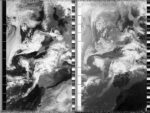
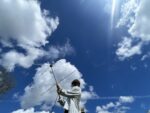
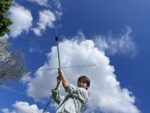
This week in London, there have been lightning storms in the middle of the night. My partner woke up one morning earlier in the week with a story of how the sky flashed brightly at 2am in quick successions of electricity with no thunder. I slept through the lightning. The sky today is a deep cerulean blue, so deep and bright it feels charged, amplified. I wondered about the residual effects of lightning: what happens to the electromagnetic pulses of energy, the sferics, that are emitted? How far do they travel around earth, and do they return?
2024-05-03 12:34:52
Sasha Engelmann
Hackney Downs, London, United Kingdom
United Kingdom
NOAA-18
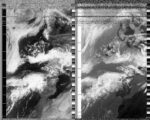

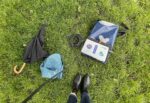
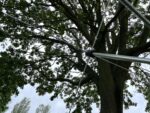
Drops splashed lightly on my laptop as I took cover under a Sycamore tree during the satellite pass today. While the tree mostly sheltered me and my ground station from the rain, periodic wind gusts would shake the leaves and a rain of large droplets would fall down, teaspoons of rain that pooled above. Thankfully, I could always tell when this would happen because of the sound of the upper tree leaves, and only a few splashes managed to reach my keyboard. As I was focused on this, an elderly couple walked by and both smiled at me.
2024-05-03 11:55:30
Selma, Karlotta, Pau
Vienna, in front of the Academy of Fine Arts, Schillerplatz, Austria
Austria
NOAA-18

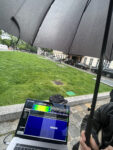

Rainy, cloudy.
2024-05-03 11:52:59
Martin EIchler
Vienna, Schillerplatz, Austria
Austria
NOAA-18


Overcast with a light rain.
2024-05-03 10:38:36
Soph Dyer
Schillerplatz, Institut für Kunst und Architektur (Institute for Art and Architecture), Akademie der bildenden Künste Wien, Austria
Austria
NOAA-19



This image was received during a workshop with third year architecture students at the Akademie der bildenden Künste. It is raining heavily, however we got lucky with the weather and satellite orbits. During a dry moment between down pours and drizzle, we stood in Schillerplatz and pointed the turnstile antenna toward NOAA-19. For some reason the signal to noise ratio was poor. I will try to understand why, perhaps the dongle I was using has seen one too many workshops. We tried later in the day with v-dipoles and the students got clear images, so, it must have been my set-up. A noisy image can be intersting in a workshop. Overall we had a good day. During the WebSDR exercise the students heard lots of radio amateur chatter, including two men with heavy British accents talking about one of the men's father passing away. Another students heard a man in Germany describing how the Rhine River had flooded his cellar. All in all, it was a very radio active workshop.
2024-05-03 12:01:22
Philipp Ortinger
Vienna, Austria
Austria
NOAA-18
It was a rainy day.
2024-05-02 12:07:54
Soph Dyer
On the corner of , Augarten, Wien, Austria
Austria
NOAA-18
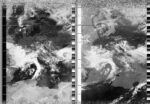
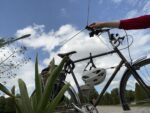

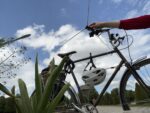
It remains windy today. I learned today that the expression "winds of change", which I had taken as old adage, was coined in 1969 by British Prime Minister Harold Macmillan. In a speech in Cape Town, Macmillan referred to the "wind of change […] blowing through this continent", in reference to the decolonisation of Africa. Now I know the expressions origin, I am wary of how it naturalises a social-political struggle, making it feel as inevitable as the changing of weather patterns. I am reminded of a poster I picked up in a corridor in Goldsmiths after the terrible passing of Mark Fisher. Printed in riso red, the poster reads "emancipatory politics must always destroy the appearance of a ‘natural order’, must reveal what is presented as necessary and inevitable to be a mere contingency, just as it must make what was previously deemed to be impossible seem attainable" (Fisher 2009). I see traces of the Polar Jet Stream in the clouds in the satellite image. Or rather jet streams in plural because the more I read the weather and its winds, the more my imagination of a single wind, a kind of wind super highway, breaks down. Instead I see many jet streams: curling and unravelling, breaking up and rejoining, strengthening and weakening. Sasha has shared with me an article on 'global stilling': a prediction that the climate crisis will cause global winds the weaken and possibly, eventually, still.
2024-05-02 08:38:36
Sasha Engelmann
Myddelton Square Gardens, London, United Kingdom
United Kingdom
NOAA-15

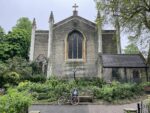
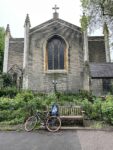
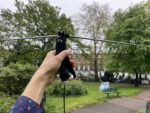
Myddelton Square Gardens is the name of a green, flower-filled square on top of a hill in Islington, and in which St Marks Church stands. According to the St Marks website, it is 'a country church in an urban setting'. As I held my V-dipole antenna to the sky, I tried to imagine where I was standing 'as country' without the church or surrounding three-story Victorian buildings. The Thames would probably be glistening in the distance, widening on its way to the sea. Or, given the density of the mist in the morning air, the hill would be shrouded in a small cloud, wrapped up without a view of the horizon.
2024-05-01 19:47:52
Soph Dyer
My flat, Wien, Austria
Austria
NOAA-15

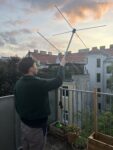
It's 1 May or Workers' Day or Labour Day. It's still novel for me live in a country that celebrates the 1 May with a national holiday and street parties. I cycled into my studio and instantly felt guilty for working, as if I were a 'scab'. Vienna has a festive, carefree atmosphere. I crossed two rallies for the Sozialdemokratische Partei Österreichs (SPÖ) and for the KOMintern at Sigmund-Freud-Park. According to a crude translation of their German-langauge website, the KOMintern is a "combative, internationalist association and trade union fighting alliance of working people, councils, the unemployed and trade union political activists". The weather is sun with some cloud and wind. If I had a barometer, it would have pointed to "Change".
2024-05-01 11:41:15
Sasha Engelmann
Hackney Downs, London, United Kingdom
United Kingdom
NOAA-19
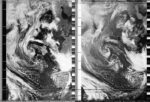
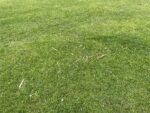
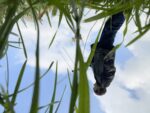
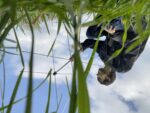
Warmer air has arrived in the UK over the last couple days, and I realised I was overdressed on my way to the park. The grass was still cool and damp to sit on. I wondered about the number of wood shards on the ground before realising how many dogs had been chewing sticks and branches. Two german shepherds chased a ball nearby, and one of them kept lying down not far from me, panting-heaving with his/her whole body. Yet when the ball was thrown again, she went for it. I later met the dog, Akira, when her owner came over to chat. My activities were approved with a 'good on you', and 'we need to know whats going on up there' (hand gesturing to the sky).
2024-04-30 22:25:17
Soph Dyer
Beside the Rathaus, Wien, Austria
Austria
NOAA-18
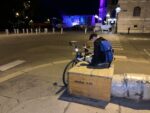
As I receive the satellite transmission, I listen to pop music from a large concert for the SPÖ youth organisations. To get to the street corner we walk through groups of teens. In the shadows of the park they could have passed as much older, but occasional childish impulse to jostle, shout or run after one other gave them away. I read that each year the socialist youth organisation's march through the city with torches, this year their motto is 'Vienna against the Right' or „Wien gegen Rechts“.
2024-04-30 11:34:06
Sasha Engelmann
Hackney Downs, London, United Kingdom
United Kingdom
NOAA-18

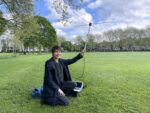
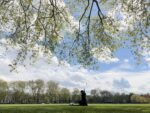
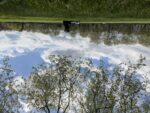
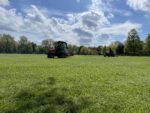
A pair of orange grass cutter machines, like small tractors, circled around Hackney Downs today, carving edges around trees and casting grass perfume into the air. It was sunny and bucolic. Over the weekend I attended a rally in support of Diane Abbott that took place at the centrepoint of the park, in similarly beautiful weather. As a new resident of Hackney (since last October) I didn't know much about Diane Abbott's story, how she was the first black woman elected to the UK parliament, but also how she faced so much overt discrimination and agression while an MP. Several speakers at the rally mentioned Diane's record of standing up in Parliament advocating for the rights of working people and communities, but also how she was frequently shut down or attacked. I also didn't know that in 2023, due to an article she wrote, Diane's 'whip' was removed, effectively suspending her from the Labour Party. As a foreigner in the UK, the idea of a 'whip' is a strange one, and I read that it comes from language around hunting, where a 'whip' keeps hounds from running off the path. Despite all of this, the atmosphere at Diane's rally was exuberant and energetic, with rousing chants of 'We stand with Diane!!!' echoing to all corners of the park. As I meditated on this and received a satellite image, Martin came riding over again. After I shared that I had been comically trying to take photos of myself by propping my phone up in a nearby bank of grass and running to my ground station to pose, he helpfully took some photos of me (thank you Martin!). The satellite image was made by live decoding with SDR++ and an RTL-SDR V3 dongle (sadly I tried the V4 again and there was no signal at all). The troubleshooting continues...
2024-04-29 21:16:51
Soph Dyer
Diepoldplatz, Wien, Austria
Austria
NOAA-19

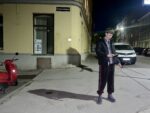
2024-04-29 18:02:25
Sasha Engelmann
Hackney Downs, London, United Kingdom
United Kingdom
NOAA-15

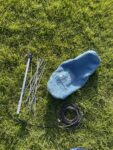
Hackney Downs was golden in the late afternoon light, dogs frolicking and wrestling with each other across the grass. I had chosen a place for my ground station in the thicket of the action. A woman kept yelling for 'Eric!!!' though she didn't seem worried, it was more of a 'come on!' kind of yell. Eric turned out to be a small bulldog who paid zero attention to the calling of his name as he stole tennis balls from other dogs. The satellite image I collected was unusually dark- I wondered whether this could be because of 'night time' mode, or because I am live-decoding with SDR ++ for only the second time and some settings are off.
2024-04-28 19:26:34
Soph Dyer
On my balcony, Wien, Austria
Austria
NOAA-15

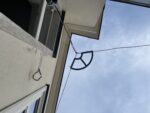
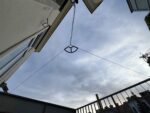
Sun. I sat in the sun and willed my vitamin D level to rise. I have been feeling under the weather since Friday and blame it on a lack of vitamin D. After sunset the temperature dropped quickly, then stabilised. N and I sat on the balcony without the lights off and watched the stars for a good hour. Bored from bring at home all day resting for the day, I used the broken co-ax cable, magnet wire from Shortwave Collective and some copper tape to improvise a full wave length v-dipole antenna. I can't find any documentation online of full wavelengt v-dipoles to receive NOAA POES satellites, so maybe it is not a good design. I recived a faint, noisy signal from NOAA-15. Perhaps the poor signal was because I had accidentally cut the dipole wire 30cm too short or becasue the balcony didn't allow for a true North-South orientation. Regardless, the anntena was satisfyingly sculptural.
2024-04-28 12:01:18
Sasha Engelmann
Hackney Downs, London, United Kingdom
United Kingdom
NOAA-18

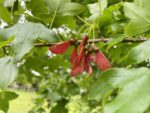
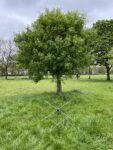
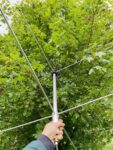
The air of Hackney Downs was wet – sparkling with water – and though it wasn't exactly raining, droplets fell on my body, antenna and laptop. After so many days attempting to record satellite passes during hail, drizzle and rain in Hackney Downs this last month, I wondered if a tree could serve as a tempoorary ground station holder and shelter. A Montpellier Maple tree was close by, bright red, winged seeds were clustered along its branches. My antenna was too heavy for its branches but I observed how the branches and leaves were porous to the radio signal of NOAA-18 to the east.
2024-04-27 23:04:59
Soph Dyer
At home, Wien, Austria
Austria
NOAA-18
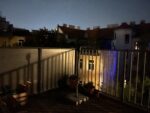
2024-04-27 12:13:44
Sasha Engelmann
Beach of the River Thames near Trig Lane Stairs, London, United Kingdom
United Kingdom
NOAA-18

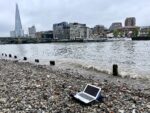
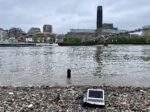
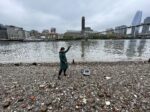
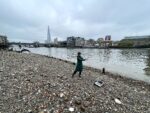
I arrived at the beach of the River Thames shortly after low tide. The curve of stony beach accessible from Trig Lane Stairs was criss crossed by mudlarkers who hardly noticed me as they bent to the ground and turned over pebbles and pieces of seashell. Arriving at the beach straight from a symposium at the Tate, my head was filled with dialogue about sirens, alarms and states of emergence / emergency. The radio spectrum had its own sirens. Around every two minutes or so, the relatively calm 'ocean' of spectrum in which I tuned my ground station was interrupted by what I can only describe as 'blasts' of energy that drowned out all other signals. The blasts would disappear, allowing a minute or two of calm, before returning. I tried to discern whether they coincided with the Uber Boats traveling up and down the Thames. A mudlarker passerby – who turned out to be an art history professor at a university in London – speculated on this wtih me for a few minutes. As I took a final few photos of my ground station the tide was already beginning to come back in.
2024-04-26 20:17:23
Soph Dyer
At home, Wien, Austria
Austria
NOAA-15

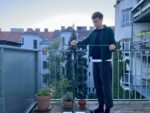
2024-04-26 12:22:18
Sasha Engelmann
Hackney Downs, London, United Kingdom
United Kingdom
NOAA-18
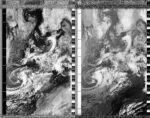

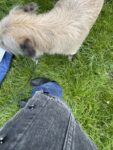
My ground station was visited by a number of dogs. At one point there was a big husky, a german shepherd, two small terriers and a middle sized dog circling and moving through the radio wires and narrowly overstepping my laptop- a dog seance! They arrived with three people who had come over to see what I was doing. Two people I recognised before (they immediately identified the 'weather satellite') plus a woman I hadn't met. While the dogs carreened about, and the others continued walking, the two of us spoke briefly about environmental science and education. One of the smaller terriers came to sit next to us, as if to get some shelter from the german shepherd, and the three of us watched the image load together as the satellite orbited south over France and Spain.
2024-04-25 12:35:37
Sasha Engelmann
Hackney Downs, London, United Kingdom
United Kingdom
NOAA-18
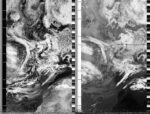
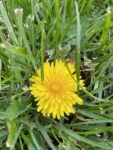
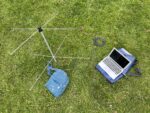
I arrived on the grass with ideas for an evolving piece of writing spinning in my head. I made a mental post-it board and logged some ideas for the last few sentences of the collaborative essay I was working on. Crows were pacing around on the Downs, maybe making mental notes of their own. One passed close by my ground station and I thought I picked up on a sense of curiosity in my actions. A very large husky, looking strikingly similar to a wolf, charged several of the crows and was only kept from my ground station by a very long tether.
2024-04-25 10:36:33
Soph Dyer
On my balcony, Wien, Austria
Austria
NOAA-19

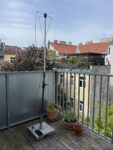
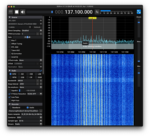

Sehr geehrte W, Ich habe im Januar dieses Jahres eine QFH-Antenne und zwei Zwischenkabel bei Ihnen bestellt.
Ich fürchte, dass ich einige Probleme hatte. Ich habe ein schlechtes SNR bei Verwendung des QFH und eines der Zwischenkabel ist kaputt.
Ich befürchte, dass ich möglicherweise die internen Lötverbindungen an der QFH-Antenne gebrochen habe, obwohl ich nicht glaube, dass sich die Buchsen im Kunststoffteil verdrehen. Haben Sie einen Rat? Wie kann man beispielsweise das Problem eingrenzen?
Sasha Engelmann und ich nutzen Ihre Antennen schon seit vielen Jahren und hatten vorher keine Probleme. Vielen Dank für jede Hilfe.
Mit freundlichen Grüßen, Sophie Dyer
2024-04-24 18:32:05
Sasha Engelmann
Shoreditch Park, London, United Kingdom
United Kingdom
NOAA-15

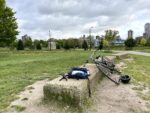
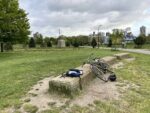
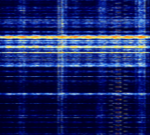
I arrived in Shoreditch Park after meeting a friend for a coffee on the Strand. It was very cold but people were lounging on the grass and strolling around the park making every effort to enjoy a semi-sunny early evening. The 'radio weather' was very active. The amplitude of the signal jumped around wildly, and the waterfall display was checkered and criss-crossed by lines of radiation. I belatedly took a screenshot to record this, but only after I had unplugged my antenna so it is not as representative as I hoped. I wondered about very tall, black streetlights installed throughout the park that looked like they had cameras or other attachments on them. The signal of NOAA-15 would jump into audibility for one or two seconds and then get swallowed up by interference, even at the height of the pass.
2024-04-24 19:27:05
Soph Dyer
Augarten, Wien, Austria
Austria
NOAA-15
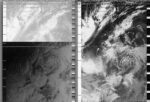
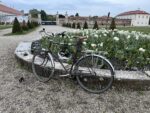
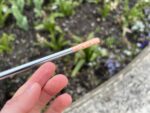
Athens is enveloped in Saharan dust, but it remains so cold here! On Friday it is forecast to drop as low as 1C degrees. An Austrian friend told me that it has snowed nearer the Alps, harming the fruits trees, which had budded early and were already in full leaf. On an emotional level the cold and damp is making me want to curl up and stay away from more energetic tasks, such as work and exercise. I checked 'wind map' to improve understanding hoping that this would bring me comfort. The slick data visualisation shows cold air coming from the artic, passing Sasha in London, before arriving in Southern and Central Europe. Sasha are you cold?
2024-04-23 20:52:44
Soph Dyer
Lorenz-Bayer-Park, Wien, Austria
Austria
NOAA-19
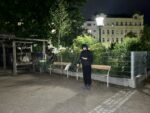
The software defined radio app I was running on my phone crashed as two teenage boys walked right up to N and I and got in our faces. I was a wary. "I'm from Tschetschenien (Chechnya)" one of the boys said. When I told them that I was from the UK, they proceeded to speak in awe about how "you know in London you get stabbed, just like that". When I said that we had lived in South East London they were unduly impressed. The boys willingness to come into our personal space made some sense when they told us that they were on drugs. I asked what and they said cocaine and then, as if to prove it, did a line in front of us on the picnic table. We chatted, I tried to restart the software defined radio and recorded this image (the first recording had corrupted), they offered us a cigarette. The satellite dipped below the horizon. We wished each other "Schön'n Abend", and N and I left the two boys in the darkness of the park.
2024-04-23 12:58:47
Sasha Engelmann
Hackney Downs, London, United Kingdom
United Kingdom
NOAA-18
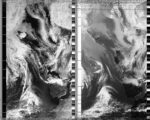
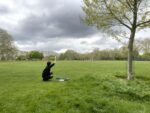
Today is one of those typical days in London where, from the inside, it looks like it is raining outside, but once you are outside you can tell that it's just a wet mist that has made all the surfaces shine with water. The park was relatively empty except for a few people dressed in coats and dogs dressed in little jackets and gillets. The clouds overhead seemed to match the weather systems swirling over the Atlantic, making dense white and off-white shapes.
2024-04-22 22:21:27
Soph Dyer
Hanging out of my window, Wien, Austria
Austria
NOAA-18

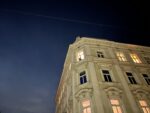
Clear skies, still cold. I am tired yet relaxed. It is a long day. In the afternoon and evening I helped to remotely interview applicants for the design school where I teach. Every 15 minutes a student joined the call from a different location: Moscow, Guangzhou, a city I can't recall in Canada, then maybe Barcelona, Offenbach in Germany, a few streets away from me in Vienna, the list went on. Our questions were a variation of: why this course now? The answers overlapped, but the reasons for studying and urgencies were diverse, so too were the concerns about visas, queerness or work after graduation. About half of the candidates expressed a desire to develop a personal creative practice while the others leant toward collaborative or collective work. It is exciting to hear so many desires in one day.
2024-04-22 13:11:32
Sasha Engelmann
Hackney Downs, London, United Kingdom
United Kingdom
NOAA-18
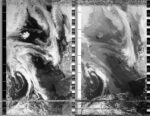
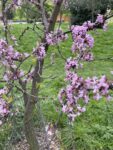
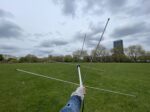
On my walk to the park today I noticed the blooming branches of an eastern redbud tree, and I learned about how eastern redbuds are in fact closely related to legumes. This made sense as the flowers resembled those of sweet peas. The pass was cold and grey, though a man kept riding back and forth on the nearby path singing to himself, which made everything a little more joyful.
2024-04-21 11:44:23
Sasha Engelmann
Hackney Downs, London, United Kingdom
United Kingdom
NOAA-18
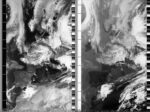
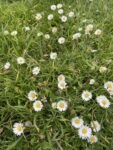
Kites flew high in the park today, though the variable wind meant that they often crashed and needed re-launching. The grass has erupted in daisies recently, making white speckles across the ground. Yesterday I went to a local action for Palestine: a rally and march that began at Gillet Square and stopped traffic on Kingsland Road before turning down Dalston Lane and ending at the Hackney Picturehouse (the Rio Cinema and Hackney Picturehouse were chosen as start / end points as they have cancelled/ boycotted events in solidarity with Palestinian artists and people). I find local marches like this extremely moving, in some ways more so than the national protests attended by hundreds of thousands in central London (there is one of these next weekend). Yesterday the march ended with a speech by one of the organisers of Palestine Solidarity UK, about how we need to keep showing up in public spaces, especially as London remains an active site of public protest unlike other cities in Europe. Despite the strength of these local actions, I sense a growing despair and raggedness in the protests, a myriad of ways to conceal feelings of despair.
2024-04-20 10:34:06
Sasha Engelmann
Hackney Downs, London, United Kingdom
United Kingdom
NOAA-19
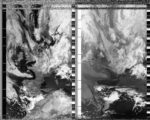
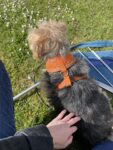

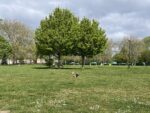
On the far side of the park close to the basketball courts I found myself surrounded by daisies. My head ached from a late night out with old friends, but I felt relaxed and happy to be in the air. The pass was a very social one- two joggers came over to me and inquired about what I was doing. They kept jogging in place for our whole conversation. Bill and Nutmeg appeared, and I learned about an app that notifies you whenever scientists detect gravitational waves- gravitational wave weather? A man on a bike, trailed by two kids, asked one question as he glided past. Finally I was visited by a small terrier who stared longingly at an older woman as she walked away over the field. She called to him but he would not follow her, and she kept going. Instead he came over to me and sat in the middle of my ground station for a couple minutes before bounding over to another dog.
2024-04-19 12:08:53
Sasha Engelmann
Hackney Downs, London, United Kingdom
United Kingdom
NOAA-18
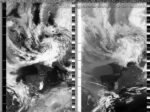
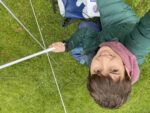
I forgot to bring an umbrella on my way to the park today, and yet again had to use my body as a shield for my laptop when light rain started. I have been testing the water damage boundaries of my computer during satellite passes recently. As I was packing up two young men and a large curly haired dog approached and we chatted for a few minutes about how often and frequently the NOAA satellites orbit. I showed them the satellite image on my droplet-speckled screen and one said 'I am so glad I asked!'
2024-04-18 12:20:59
Sasha Engelmann
Hackney Downs, London, United Kingdom
United Kingdom
NOAA-18
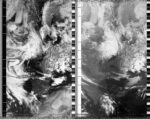
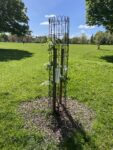
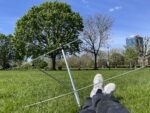
Positioned in the middle of the freshly cut East field of Hackney Downs in full sun I felt like a planet with its own orbiting moon(s) and gravitational fields. Dogs – like asteroids or meteors – approached and veered away in long and fast trajectories. I studied my position and made sure to look in all directions. On my way back from the downs I passed a young, 4 foot high horse chestnut tree that I hadn't properly observed before. The tree is ringed by a small cage on which there are handwritten notes to 'Dad' and 'grandpa'.
2024-04-17 12:35:19
Sasha Engelmann
Hackney Downs, London, United Kingdom
United Kingdom
NOAA-18
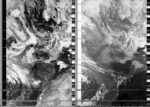
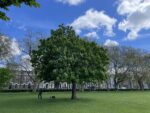
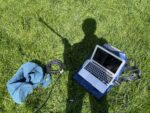
The horse chestnuts are beginning to bloom, and their leaf foliage is now so dense that they cast deep, dark shadows on the grass of the downs. There is a big difference between standing in the sun on exposed grass and standing under a horse chestnut, in its cool shadow. A small, large-eared welsh corgi bounded over to me during the satellite pass, telling me I shouldn't be there. In the long grass the dog had to leap through the green, challenging for short legs.
2024-04-17 13:33:12
Soph Dyer
In the car park Hotel Mariënhage, Eindhoven, The Netherlands
The Netherlands
NOAA-18

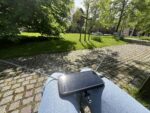
I caught the image between bursts of rain. Drowsy after the night train from Vienna, I enjoy catching rays in the hotel car park. The air is moist and fresh. The clouds few but ripe. Tomorrow my experimental and sometimes unwieldy Critical Cartographies course at Design Academy Eindhoven ends. I'm excited to see the students work, its always energising and surprising. Hopefully they've enjoyed the experience as much as me.
2024-04-16 12:46:32
Sasha Engelmann
Hackney Downs, London, United Kingdom
United Kingdom
NOAA-18

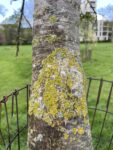
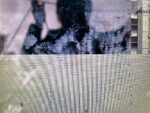
The image I collected was crafted in between sudden downpours of hail! The first time the hail started, I crouched over my laptop and used my body as a quasi-umbrella, and it passed in about a minute. A break of three to four minutes gave me time to recover. In this gap, a young person jogged over from under a nearby tree to me to ask what I was doing. I started to explain by saying 'there is a weather satellite...' but as soon as I said 'weather satellite' he interrrupted me saying, 'oh yeah, I know it, I seen it, I seen it...' and he jogged back to his friends, repeating to them 'it's a weather satellite, I seen it'. Then the second downpour of hail arrived. This time I worried it was here to stay, so I quickly shut things down and got back inside, chunks of ice still in my hair!
2024-04-16 12:08:18
Soph Dyer
Local park, Wien, Austria
Austria
NOAA-18

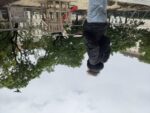
Can relief be an atmosphere? If so, it is enveloping me. I finally managed to speak to someone who would about my health insurance problem. I think that an end could be insight. It is dry but the clouds are low and the temperature has dropped significantly, again. These days I am alternating between shorts and tee shirts and a heavy winter coat.
2024-04-15 22:08:13
Soph Dyer
Hanging out of my window, Wien, Austria
Austria
NOAA-18

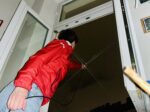
A sunny morning was followed by heavy rain in the late afternoon. At one point, I opened the window facing onto the street and smelled cut grass, which is strange as there are no parks nearby. Before leaving the flat to attend a fundraising meeting, I check the weather radar on my phone and see two large bands of rain almost upon Vienna. Geopolitics is even stormy today. Israel is threatening retaliation against Iran, and stories of dissidents being silenced in Russia and Belarus are in the news. Meanwhile, here, Austria is keeling over to the right. Today, I also learned that abortion is still illegal in Germany.
2024-04-15 12:58:25
Sasha Engelmann
Hackney Downs, London, United Kingdom
United Kingdom
NOAA-18
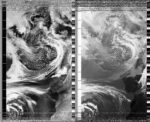
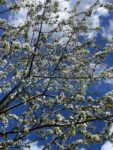
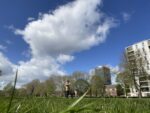
The wind roared in Hackney Downs today. I tried to figure out what the 'roar' consisted of – was it the cumulative effect of all the tree branches and leaves moving against each other? the city-wide friction of wind around buildings, streets and train lines? the scaled-up whoosh of the air across the grass? dog walkers threw sticks into the wind. They sailed high up and were pushed back to where they were released, the dogs doing circles, looking frenzied
2024-04-14 11:30:08
Sasha Engelmann
Hackney Downs, London, United Kingdom
United Kingdom
NOAA-18
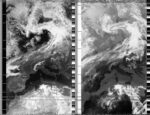
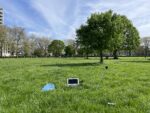
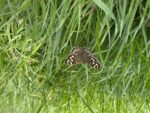
Somewhat hidden amongst some young trees and tall grass, and dazed by the bright sun, I heard a joyful 'hello!'. Bill and Nutmeg were walking over. We spoke for a few minutes while the satellite pass began. Bill had looked at the open-weather website, watched our talk at Sonic Acts, and then shared the project with his colleagues (Bill is a train driver). This was amazing to hear- I had never imagined that people I met in the park would take enough interest to follow the project online (I am learning fast about the social life of the Downs). Bill said he liked to think about how, while trains are moving over the ground in our daily lives, satellites are circling and sending signals overhead. The point of his story was to tell me that he had 'stood up for me'. Some of his colleagues are skeptical about feminism.
2024-04-13 11:42:23
Sasha Engelmann
Saint Paul's Church Garden and Labyrinth, United Kingdom
United Kingdom
NOAA-18
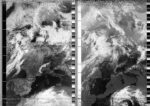
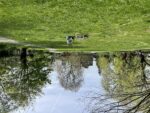
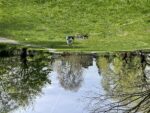
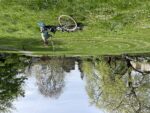
The Stoke Newington Farmers Market was at peak activity in the courtyard of Saint Paul's Church while I set up my ground station on the edge of the garden labyrinth. I could smell the Turkish gözleme being cooked on the large round stone, and an herb that I imagined was wild garlic. A man dressed in black with a thick-wheeled, heavy duty electric bike scowled at me from the distance. Another man sat down on a bench near the wall behind me and when I looked around and smiled he exclaimed 'technology!'. That one word hung in the air as I held my antenna to the horizon.
2024-04-12 11:57:27
Sasha Engelmann
Hackney Downs, London, United Kingdom
United Kingdom
NOAA-18
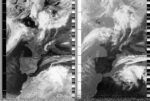
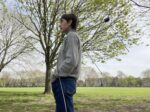
The satellite image I captured today has so many striking details. There are clouds formed by orographic lift off the coast of Scotland – they look like short stripes or patterns, what are called 'gravity waves' in fluids. What I thought were ship's tracks yesterday, today look like contrails from airplanes criss-crossing France, the UK and the North Atlantic. The Alps are strikingly visible in the full sun and against the too-hot land of central Europe.
2024-04-11 10:07:28
Sasha Engelmann
Hackney Downs, London, United Kingdom
United Kingdom
NOAA-18
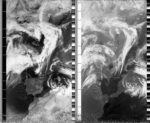
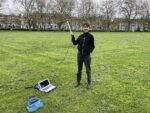
The sky feels heavy and low to the ground, and the atmosphere suspended, a bit surreal. There is a strange calm. We feel sleepy and low in energy. It is kind of warm and humid but it won't rain – this is where 'suspension' comes from, there won't be a release. In the satellite image, we notice the sharp intersecting lines of ships' tracks across the North Atlantic caused by aerosols released from the ships' exhaust. This morning, when we looked at iPhone weather app, the app said we are 'seven degrees above the historical average' for this time of year.
2024-04-11 10:04:37
Soph Dyer
Resting on the grass, Augarten, Wien, Austria
Austria
NOAA-19
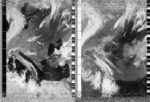
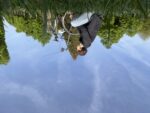
Israel-Palestine, Gulf of Suez, Cairo. Each image yeilds a different combination of landforms, coastlines, rivers and seas by which to orientate by. In land, light and dark patches index dry steppes and deserts, river basins thick with vegetation and cities. I did not capture an image yesterday because I was feeling worn down. In the morning, I had another emergency appointment to diagnose my chronic pain. To express my anger and dispair, I wrote a poem. I am submitting this word-image in place of yesterday's image: 'Try this' It's not an emergency the doctor concluded. / I become so submissive during medical appointments, it was / only when I left the hospital, and / lost another night's sleep to pain, that / I felt like crying and shouting. / Try living with this pain? / Try working after lying awake for multiple nights because / you cannot sleep because / the pain is gnawing at your insides. / Try living with this pain / for more than five years and being told by medical professionals (who you naively assumed would help) / that it is stress, / indigestion, / "your body is changing as you age", / "I have reassured Ms Dyer that the pain is nothing to worry about." / Try living with this pain and repeating those claims. / Screw your lack of emergency. / The discharge note I was sent home with yesterday said I had / blood in my "Douglas Pouch" and advised an operation / using a "DiVinci robot". / How fitting that my body part is named after a man / and the machine that will be used to to probe, cut, mince, remove the my offending flesh is named after a 'male genius'. / Try weathering this climate of sexism. / Try weathering a climate of sexism / in which women's health issues such as endometriosis are still so poorly researched and understood. / Try living with this pain, / then tell me that this not an emergency.
2024-04-10 11:00:03
Sasha Engelmann
Hackney Downs, London, United Kingdom
United Kingdom
NOAA-19

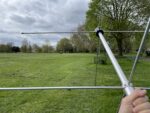
Today my heart is racing and my chest feels tense. I have been in a sprint toward several deadlines. I have several chapters and many thousands more words to review of collaborators' and students' writing today, and every minute counts. Sitting in the grass of the downs was a welcome respite, at first, until a dog fight broke out nearby. One dog owner tackled his dog to the ground, and began agressively yelling and hitting the dog in front of several other dogs and people. An older woman with a terrier tried to intervene to say he should stop hitting his dog, but he yelled at her and she walked off. In the aftermath, the owner of the dog who had been attacked remained, and said to the one who had been violent, 'I would have done the same... everyone knows you here, mate'.
2024-04-09 12:36:32
Sasha Engelmann
Downs Road, London, United Kingdom
United Kingdom
NOAA-18





As a bulb of fennel sizzled in olive oil on the stove, I leaned outside the second floor window of our flat, angling my turnstile antenna at around seventy degrees to the West. It didn't feel that long ago that doing so would have made me shiver with cold, but today I reached out the window withoat a coat or gloves. The air helped to soothe a splitting headache I developed from staring too hard at my computer screen this morning. The pain also made my perceptions fuzzy – a slight 'shimmer' in my peripheral vision.
2024-04-08 12:45:57
Sasha Engelmann
Hackney Downs, London, United Kingdom
United Kingdom
NOAA-18
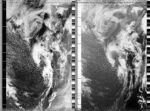
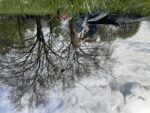
Sun has been shining through the shutters of our south-facing flat's windows all morning, making ladder-like spotlights on the wood floor. The park was full of dogs and people: a body builder lifting what looked from afar like a giant, square piece of concrete, as if pulled up out of a London sidewalk; a young couple submerged and entangled in the grass; an office-attire wearing woman who spoke loudly to herself and a smartphone. The air smelled faintly of lemons and coffee.
2024-04-07 11:36:53
Sasha Engelmann
Hackney Downs, London, United Kingdom
United Kingdom
NOAA-19

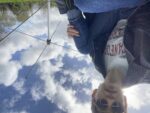
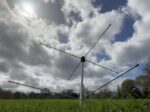
Writing of the atmospheres of the South Asian monsoon, Harshavardhan Bhat describes how the wind 'carries the ocean to the sky... transforming its air and everything in its temporal wake with the possibility of life' (2021: 6). Though monsoons do not occur in the North Atlantic, the aftermath of Storm Kathleen makes me think of the wind 'carrying the ocean to the sky'. The clouds feel like wave crests in fast-moving currents, spinning away from the weakening epicentre of the cyclone. In the park, as I was hurrying to set up under fast-moving clouds, a man and his dog asked what I was doing. After my reply, he said with more than a hint of humour, 'I wonder why I didn't wake up and think of doing that today'
2024-04-06 13:10:09
Sasha Engelmann
Hackney Downs, London, United Kingdom
United Kingdom
NOAA-18
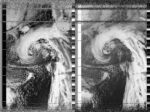
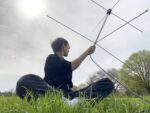
Across Europe the air is unusually warm and skies are cloudy and hazy today, but the atmosphere in London is bucolic, with picnickers spread out over the grass of Hackney Downs. I spotted an incredibly beautiful bird in the garden, I suspect a kind of Jay with very striking blue array of feathers on its wings. In my satellite image, Storm Kathleen swirls in a dramatic line over the Atlantic, and I wonder how it can be so un-stormy in London. According to one online news article, Ellie Glaisyer, a Met Office meteorologist, says: “The storm [Kathleen] is the reason we are seeing the warmer temperatures, because the location of the storm – situated out towards the west – is bringing a southerly wind across the UK.”
2024-04-05 11:42:53
Sasha Engelmann
Clapton Pond, London, United Kingdom
United Kingdom
NOAA-18
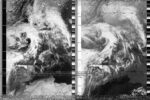
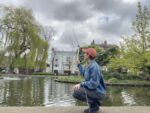
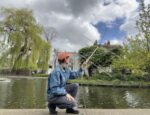
I have been thinking all morning about the wind, so I was particularly attuned to the creaks and murmurs of the wind around our flat and street this morning. The wind in my thoughts, though, was different to the one chasing clouds across the sky of London in big gusts. Instead, I was tracing my family's memories of the 'Jugo', a wind that originates in the South over Africa, and blows over North Africa and the Mediterranean. Once it reaches the Balkans, the Jugo has picked up many particles and water droplets along the way. In my family's lore, shared across many in the Balkans and former 'Jugo-slavic' peoples, the Jugo brings certain feelings and emotions to the foreground. Yet unlike the Bora, a brisk, cold wind from the Northeast, very little has been written about the Jugo's cultural value, its meanings, and how it maps onto ideas of 'the south' in ways that need attention and critique.
2024-04-04 10:29:25
Sasha Engelmann
Hackney Downs, London, United Kingdom
United Kingdom
NOAA-19
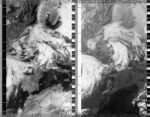
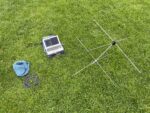
I felt happy to be back on the grass of Hackney Downs setting up my turnstile antenna this morning. After so many satellite passes in this location, I know the heights and depths of the park and its surrounding buildings like a favourite dreamscape. People in the park found me familiar, too. I man on a racing bike cycled over on the grass, and immediately recognised my Funcube Dongle, saying he had the same, as well as a full amateur radio license. We compared approaches to satellites and ADSB, I told him about open-weather, and he said this encounter had inspired him to break out his dongle again. A few minutes later, Bill and his dog Nutmeg came strolling over. Apparently Bill had been talking about me to his friends on the other side of the park, explaining what I was doing, and he approached to take a look at my image, while Nutmeg raced after a tennis ball. It was a good day to share the image, which was a long view of Europe and much of North Africa. Chott Melhrir lake is visible in Algeria, standing out as a dark spot against the lighter hues of Land. I read that this kind of lake, one characterised by Chott geology, is usually dry, but fills with water at certain times of the year. I want to keep a lookout for the lake in the coming months as it dries and most likely becomes crystelline and reflective with salt.
2024-04-03 10:42:32
Sasha Engelmann
London Bridge, over the River Thames, London, United Kingdom
United Kingdom
NOAA-19
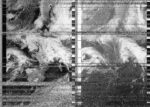
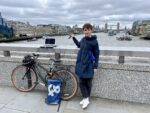
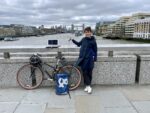
I found myself near London Bridge after an appointment at Guy's Hospital early this morning, a meeting with a specialist doctor which had me thinking a lot about the energy flows through and out of my body. Cycling out to the middle of London Bridge involved ducking and weaving through throngs of tourists and families who, despite the grey and blustery weather, were determinedly taking group photos and pointing at London landmarks. I had to hold my laptop with one hand and orient the antenna with the other, as gusts of wind wobbled both laptop and antenna dangerously close to the edge of the bridge's railing. Passing by my ground station and curiously observing my antenna, a young boy said 'Dad, what is she doing' and was answered with a flat 'dunno.. tracking something'.
2024-04-03 08:43:01
Soph Dyer
Rossauer Brücke, Wien, Austria
Austria
NOAA-15
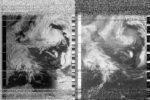
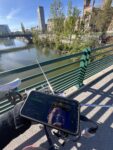
It is beautifully clear and sunny. I woke early feeling rested after a good swim in the Stadthallenbad last night, which surely helped rid my body of stress hormones. This morning, I stopped on a bridge on the way into the studio to receive an image from NOAA-15. I've noticed that its imagery appears degraded, less detailed, compared to the other two satellites. At this time of day, the sunlight bounces off the Mediterranean, Aegean and Black Seas creating a white flare around the the coastline of Crete and other Greek islands. No Saharan Dust was visible in the image, just two large anticyclonic clouds.
2024-04-02 09:10:37
Soph Dyer
Dornerplatz, Wien, Austria
Austria
NOAA-15

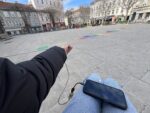
It rained all night. Not "blood rain" coloured by Saharn Dust, normal rain. I sat on a bench in Dornerplatz and received the satellite image in the sun and wind. The sky is a true blue this morning. Seeing it made me realise how grey and brown it has been the last couple of days. It's amazing how quickly one can forget the colour of the sky, and then be shocked by its rediscovery. In The Memory Police by Japanese author Yōko Ogawa, a community living under a phantasmagorical authoritian leader slowly forget the existance of mundane things: hat, ribbon, bird, rose. These things disappear in the night. Once they are gone they no longer have meaning. In the community, forgetting is policed and takes three stages (1) the erasure of the thing (2) the erasure of the memory of the thing (3) the erasure of the memory of the memory of the thing. The news this morning is all about the war in Ukraine and the war in Palestine, and how Israel had killed Iranian Military Commanders in Syria. Iran has sworn to take punitive action against the United States. [Interval] Three people close to me messaged today to say that someone they knew had died. I have sent my condolences, even thought this never feels enough. Today, has grown into a day marked by learning of the passing of people who I will never know. I am writing this down as a minor act of recognition and remembrance.
2024-04-01 19:19:06
Soph Dyer
Ferienhaus Post Sozial, Wien, Austria
Austria
NOAA-15

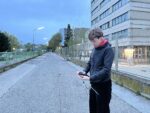
A cold wind cuts through my flimsy Uniqlo jacket, making me shiver during the satellite pass. Only three hours earlier, I'd been sat on our balcony in shorts and a cut-off tee-shirt, reading Lucy Sabin and Jorge Olcina Cantos' article 'Weathering Saharan dust beyond the Spanish Mediterranean Basin: An interdisciplinary dialogue'. In it, they paraphrase Michael Marder writing that "to face dust is to face not the Other, but the self" (Marder, 2016: 6) Taken out of context, for me, there is something liberating in the idea that we can change state, transmutate, to the extent that we are unrecognisablle, even to ourselves. Back in inside the flat, a change in the soundscape of the street alerts to the rain. Perhaps a interin "cold drop" or the end of the dust weather. N and I take the opportunity to return to the balcony in raincoats and, under the cover of darkness, throw fists fulls of flower seeds into the empty lot next door. Last year, when the old building that had to occupied the lot was being torn down, angry, I had bought online two litres of wildflower seeds. Now we were completing the plan. The seeds rained down, hopefully accomopanied by nutrient rich Saharan Dust.
2024-03-31 12:04:22
Soph Dyer
Asperleiten (favourite place), Wienerwald, Austria
Austria
NOAA-18
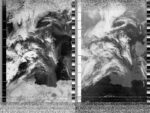
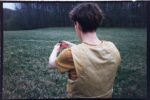
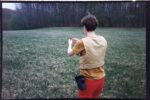
We went seeking satellites and Saharan Dust. Last night, I discovered the chrome mudguards of my bicycle patterned with rust coloured droplets. N said that they look like small galaxies. Now we are walking to my favourite tree-lined field in the Wienerwald (Vienna Woods). The light levels have increased, but even when the sun is out there is a thick haze. On reaching the field, I slip on a golden vest, clip belt and tool pouch. The beautifully gender neutralising astronaut-athleisure 'look' is intended to disrupt the documentary style photos we are about to take. Stood in the centre of the field among tubular Cowslip flowers, I scan the Northern horizon with the antenna while N snaps away on my iPhone. I almost forget to adjust the antenna's Gain. When I do, NOAA-18 appears. We spend the next 10 minutes enacting a satellite hunt, much to the confusion of a couple who walk past twice with two yapping lap dogs. The results of the very real satellite hunt photoshoot are great. To have spotted the iron and mineral-rich Dust cloud in imagery two days ago, and to now be immersed in it, to be experiencing it as 'weather', is uncanny. The walk to the bus home is longer and sweatier than I expected. A warm wind is being drawn North, and presumably with it the dust – a billion small crystalline galaxies.
2024-03-31 10:38:31
Sasha Engelmann
Via Giovanni da Udine, Latisana, Italy
Italy
NOAA-19

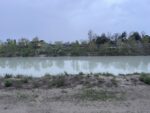
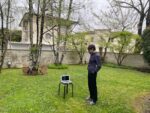
My satellite pass happened in the midst of preparations for 'pranzo di pasqua', and I could year the operations of the kitchen continuing as I set up my ground station and orientated myself in the garden. After driving directly into the saharan dust plume seen on my satellite image yesterday, and spending the night with family in Friuli, I wasn't surprised that the air was still hazy, and the clouds an obscure matte grey. There had been red spot patterns on vehicles and other stationary metal surfaces when we woke up this morning. Later in the day, while on a walk along the Tagliamento river, my throat and eyes felt the dust. As I got ready for bed, a 'tempesta' broke, causing a downfall of rain that my italian hosts called a water 'bomb', a new coloquial term for an extreme, unpredictable and heavy rain.
2024-03-30 11:19:06
Sasha Engelmann
Playground at the Area di Servizio, Novara Sud, Italy
Italy
NOAA-18

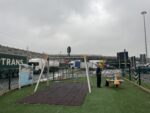
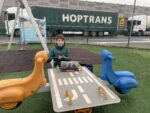
Continuing our road trip, we descended from Courmayeur through the Vallee d'Aosta and around mid-morning were surrounded by a thick, matte grey haze just north of Novara, en route to Milan. As a satellite pass was imminent we decided to stop at an 'area di servizio' and take a short break. The AdS turned out to be crowded with trucks (one with a banner reading HOPTRANS) and cars, so the only place to set up the ground station was in a tiny children's playground called PlayLand, ringed with a fence. As the image loaded it showed a promiment veil of dust crossing the Mediterranean and completely covering Italy. Later as we were driving further east, we noticed that rain drops made small red marks on the windscreen.
2024-03-30 11:17:58
Soph Dyer
Diepoldpark, Wien, Austria
Austria
NOAA-18
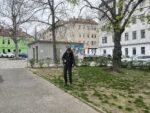
Why is it that I am so low energy? The sunlight that has made it through the dense semicircle-shaped cloud over Vienna is dim and omnidirectional. It's warm and humid. I woke early and could not fall back asleep. I had hoped to begin the day clear headed, ready to write. Yesterday, after uploading my satellite recording to this archive, I noticed a large plume of Saharan Dust over the Mediterranean. I wrote to Sasha who relied saying that she had not spotted the cloud in her imagery had observed a "light sprinkling" of a reddish dust on the snow. We share an interest in the ways satellite imagery is, “drawn to the dust, the particulate, which it has itself apparently become.” (Leslie, 2021: 102). I want to get better at reading particles, not just pixels.
2024-03-29 11:28:18
Soph Dyer
Usual spot, Augarten, Austria
Austria
NOAA-18
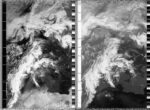
It feels like the first day of spring, again. It is windy but sunny, warm and dry. I sit on the stone flowerbed in the park and receive a long image with the satellite just under 70 degrees to my West. Stupidly, knowing that we had to get up early this morning to view two flats, I worked late last night and then doom scrolled the Internet. Now, I am tried and annoyed with myself. I have been feeling unsettle for multiple days now, I hope this feeling passes. This afternoon I must focus on writing an essay for open-weather. I think that I will write about how NOAA-15, NOAA-18 and OAA-19 may be decommissioned as soon as September 2025. It is less the "ending", more the not knowing when it will happen that is a concern for the project.
2024-03-29 10:06:28
Sasha Engelmann
Courmayeur, Aosta Valley, Italy
Italy
NOAA-19

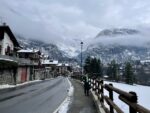
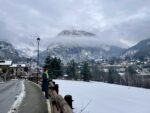
We awoke in Courmayeur, the famous Italian ski resort near Mont Blanc. The weather was a hot topic from our first conversation with the hotel manager at Stella Del Nord, who advised us that the most accurate weather info would not be in our smartphones but in the hands of the ski shop owners. The person we spoke to yesterday evening said definitively 'non e bello', but today the verdict is that the clouds are 'high' and snow won't fall. A strong wind that was rumoured to arrive yesterday, also didn't materialise. To our good fortune- we are headed to the slopes!
2024-03-28 20:06:43
Soph Dyer
Standing outside my flat, in the rain, Austria
Austria
NOAA-19
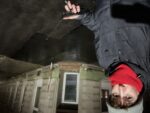
I rush home from the tram in the wind and rain, hoping to leave my things inside before the satellite arrives. I don't make it so stand buffeted by the wind on a street corner. Cars pass me, headlights on. Despite the tall apartment buildings, I catch a strong signal and am feeling happy until, for reasons I don't understand (perhaps the wet) my phone crashes, ending the recording. The experience does not help my sense of being off kilter or out of sync.
2024-03-28 11:42:10
Sasha Engelmann
Aire de Châteauvillain, France
France
NOAA-18

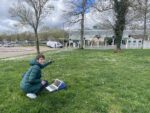
The rather grandly named 'Aire de Chateauvillain' is a gas station, electric car charger port and a food court with a Paul and a bistro. After waking at 6am and driving the best part of the day, my partner and I were absolutely starving, but we had trouble finding anything to eat. After being shown to a table between two other traveling couples, we were turned away from the bistro when they said they were 'out' of both the squash soup I wanted, the cheese plate we were going to share, and the goat cheese in the salad my partner ordered. As many other people were eating there, I had a sneaking suspicion that the bistro wasn't really 'out' of all of these separate dishes (how can a french bistro be out of chevre!? or cheese in general?!) but that we were turned away for other reasons. We made the best of it, and after I captured a rather noisy satellite image from NOAA-18, we went on our way.
2024-03-27 21:42:54
Soph Dyer
Malzgasse bus stop, Wien, Austria
Austria
NOAA-18

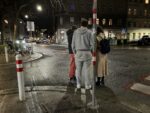
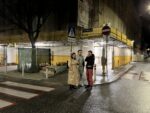
"And this is how it sees storms!" I write to Michaela, sharing a vividly coloured enhancement of the satellite image that we had received earlier, standing at the bus stop outside our shared studio space. "That’s just another name for us", she replies with the wit of the screenwriter she is. I like this thought – that we are storms. Robert, standing next to me, looking at my laptop screen, points out the Gaza Strip. I dismissed his observation because the the section of image beneath the map overlay appears to be only noise. Later, when I turned off the map overlay, to my surpsie Gaza's coastline was still visible – noisy but indisputably present in the image. How many times has Gaza been visible, only for me to not see it? I have spent the day working remotely with colleagues in London on digital platform for investigations into Gaza War. And now, somehow, without realising, from my local bus stop I have formed an indirect yet unbroken line-of-sight with the Palestinian territory.
2024-03-27 09:26:58
Sasha Engelmann
Hackney Downs, London, United Kingdom
United Kingdom
NOAA-19
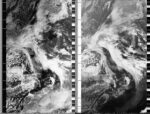
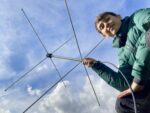
The last twenty four hours have been rainy in a nonstop, relentless kind of way. Today, shadows chase each other across the grass of the park as clouds give way to bright sun. My observations of shadows were interrupted by a squeeling bundle of dogs leaping by. One of the owners got upset that his dog had nipped another. For the next few minutes the park echoed with loud cry: 'Bruce!! that's THREE dogs today!!!'
2024-03-26 19:32:35
Sasha Engelmann
Downs Road, London, United Kingdom
United Kingdom
NOAA-19

The sound of the satellite, low and noisy over the nighttime horizon, mixed with the sizzling of a frittata and the slicing of salad leaves.
2024-03-25 22:09:44
Soph Dyer
Diepoldpark, Wien, Austria
Austria
NOAA-18

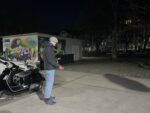
It is still but cold. I receive the image in our local park, standing by the toilets. Earlier in the day, on the train platform in Brno, I see a man dressed like a cattle herder, in full leathers, carrying tall boots. At the vegetable market, I buy a woven fruit basket from aother burly man who shows me and N a photo of him dressed as Obelix the Gaul. Tomorrow is meant to be sunny.
2024-03-25 11:17:59
Sasha Engelmann
Hackney Downs, London, United Kingdom
United Kingdom
NOAA-18
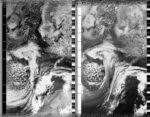
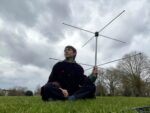
The grass in Hackney Downs has been freshly mowed either last night or this morning, and the smell is all-pervasive and enveloping, and feels even more potent given the relatively low wind. I could hear snippets of conversations across the downs (a dog walker asking another dog walker: 'poodle?!' 'no, labradoodle!'). A man walked nearby and when I smiled, he asked in an eastern european accent 'what is it'? When I replied, he asked 'are you a meteorologist'? I was surprised by my hestitation in answering, though I eventually confirmed 'no'.
2024-03-24 18:26:50
Soph Dyer
Tyršův sad, Brno, Czechia
Czechia
NOAA-15

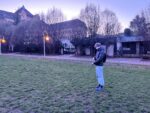
I saw people carrying palms leaves and realised that its Palm Sunday. I am stood a well kept park at dusk. There is cut grass, old trees, and a goats in a petting zoo. Local dogs and their owners gather nearby. Its a full moon and the satellite transmission clear. The air feels moist, cool, spring-like.
2024-03-24 11:30:45
Sasha Engelmann
Springfield Park, London, United Kingdom
United Kingdom
NOAA-18
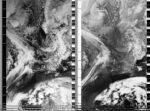
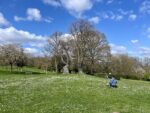
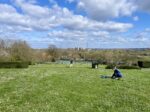
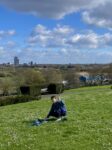
I realised as I left the flat today that I was wearing all-blue: old blue denim jeans from Uniqlo, a faded blue denim jacket with a warm lining that was my Mom's and has always smelled faintly of cigarettes, a striped navy blue jumper from my partner, royal blue socks, and a blue backpack and antenna bag. In Springfield Park in North Clapton I set up my ground station in a pool of daisies. A young couple asked me if I would take photos of them with their new baby. After I did so I asked for the favour in return, ending up with about twenty very skewed photos of me crouching over my ground station. When I explained what I was doing, the man who took the photos remembered seeing a string of Starlink satellites, which for him was 'weird' and 'frightening'. We had a brief chat about satellite resistance before they continued on their stroll.
2024-03-23 18:50:46
Soph Dyer
Pítko Letenské sady východ, Prague, Czechia
Czechia
NOAA-15
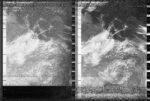
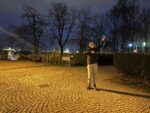
The cold wind cuts through the light clothes that I packed. N and I are staying in Prague's old town but have spent the evening in Holešovice district. There are lots of Ukrainian and Czechia flags in the windows and on buildings. I was reluctant to go on holiday and leave work but I'm glad I came. The writing block I have had is softening with conversation, reading time, and thoughts about unrelated things. I am unsticking myself.
2024-03-23 11:44:08
Sasha Engelmann
Hackney Downs, London, United Kingdom
United Kingdom
NOAA-18
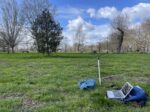
The temperature dropped by at least five degrees and a cold wind is sweeping over London. I was excited to 'see the wind' from above in the cloud fronts over the North Atlantic, but my laptop died within two minutes. In the sliver of an image that I managed to capture the white fingers of Iceland are just about visible. I remembered a conversation I overheard in a hair salon earlier this week about someone's upcoming trip to Iceland. They said 'we're going now as it's so volcanic, it might not be safe soon... then again, it's such a big destination, I'm sure 'they' will figure it out'
2024-03-22 19:38:12
Soph Dyer
Leaning out of the window at home, Wien, Austria
Austria
NOAA-19
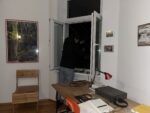
2024-03-22 11:59:02
Sasha Engelmann
Downs Road, London, United Kingdom
United Kingdom
NOAA-18

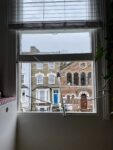
A weather system
tremulous and noisy
between walls
2024-03-21 12:10:23
Sasha Engelmann
Russell Square, London, United Kingdom
United Kingdom
NOAA-18

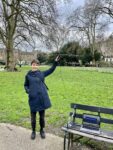
On my bike ride to central London this morning, I noticed a cherry tree in full pink bloom in the courtyard of a church, and several magnolias in either late bloom or already dropping their oversized white petals. Yesterday was the spring equinox, but it feels like the singularity of spring happened some time ago. In Russell Square there were cordoned-off gatherings of bright yellow daffodils (though I wondered why it was necessary to ring these with black spokes and wire).
2024-03-21 11:26:48
Soph Dyer
Flowerbed, Augarten, Wien, Austria
Austria
NOAA-18
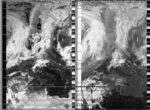
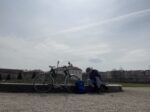
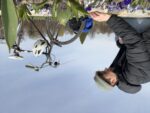
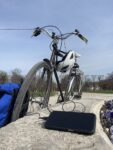
My phone says that it's 3C but it feels warm in the heat of the sun. I take off my coat and sit on the edge of the stone flowerbed, taking in the bulbs that have sprouted, listening to the satellite's signal, and offering a polite smile to the people who stare as they walk past. I mostly get blank looks, but one older man returns a scowl. It is not just the rise in temperature that makes it feel like spring is here, the air is scented.
2024-03-20 18:26:26
Soph Dyer
Augarten, Wien, Austria
Austria
NOAA-15

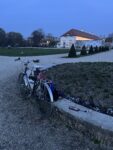
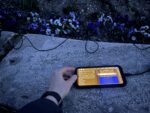
It's so peaceful in the park. The air is rich and still. Dusk has always been my favourite time of day. I need this moment of stillness after working on a project about the war in Gaza. I feel a familiar combination of profound gratitude and guilt. The sky is clear, it helps me.
2024-03-20 09:12:20
Sasha Engelmann
Hackney Downs, London, United Kingdom
United Kingdom
NOAA-19

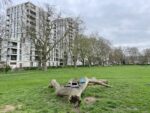
I perched my ground station on a forked tree trunk that lies on the grass in Hackney Downs. The bark and most of the trunk is wet but, unlike fallen trees that I've seen in forests, it doesn't feel like its decomposing. I wondered whether this tree has been preserved in some way, or whether its decomposition is slowed by the relative bareness of its surroundings.
2024-03-19 21:44:25
Soph Dyer
Leaning out of the window, Wien, Austria
Austria
NOAA-18

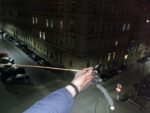
I catch the last satellite pass of the day, dog tired. I am still waiting for a medical intervention to relive me of the pain that comes in night, preventing me from sleeping soundly. It is cold but clear out. I have given into the warmth of my flat and am leaing out of out the window. This morning on my way to the studio, I a man cycles past me carrying a full-sized bow and arrow.
2024-03-19 09:23:53
Sasha Engelmann
Hackney Downs, London, United Kingdom
United Kingdom
NOAA-19
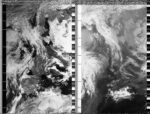
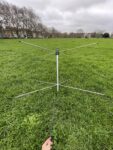
In today's satellite image, the the rivers Garonne and Dardogne are very prominent, carving a dark line into the west coast of France and joining into a delta meeting the Atlantic. In the High North, Lake Onega is a pale white, suggesting it is entirely frozen.
2024-03-18 10:30:30
Soph Dyer
Augarten, Wien, Austria
Austria
NOAA-18

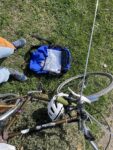
I enter the radio frequency incorrectly and only discover half way through the satellite pass. My bike is leant against a Yew bush. The park is full of children and adult carers, sat on benches in the sun. In my usual spot there was an older woman talking animately to herself, I decide not to risk interupting her. The temperature has dropped, but the sky remains clear. I will call Sasha to discuss this project.
2024-03-18 09:35:45
Sasha Engelmann
, United Kingdom
United Kingdom
NOAA-19
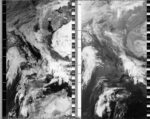
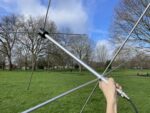
Last night, while sitting in the corner of the park on a bench under a streetlamp, an older, long-beareded man on a bike stopped, circled around, and told me I was 'too far into the park'. He advised me to go to the edge of Downs road to be safe, and added 'you are my daughter too'. This encounter stayed with me as I went back to the park this morning for a satellite pass, and looked at the distance between the bench and the streetcorner – a matter of metres – but in the dark, perhaps much more than that.
2024-03-17 11:17:21
Sasha Engelmann
Hackney Downs, London, United Kingdom
United Kingdom
NOAA-18
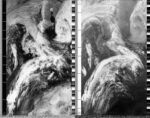
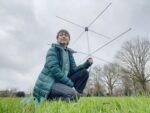
A gentle rain fell for the first half of the morning but conveniently began to let up before I headed outside to the park. The grass felt warm somehow, even though it was slick and waterlogged. As I stood with my antenna in the usual field, reflecting on the horizon, a jogger passed close by and in the space of twenty seconds we had a brief exchange. As he ran off he remarked 'the things you can do in the local park!'
2024-03-16 18:33:56
Soph Dyer
Diepoldplatz, Wien, Austria
Austria
NOAA-15
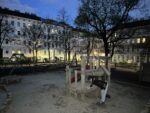
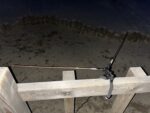
Experimental copper tube v-dipole antenna.
2024-03-16 11:29:32
Sasha Engelmann
Hackney Downs, London, United Kingdom
United Kingdom
NOAA-18
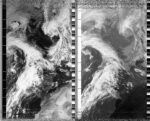
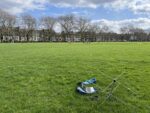
The sun came brightly through our windows this morning. Hackney Downs was brimming with activity, including the usual small persons' soccer practice on the open field. I set up a good distance away from the soccer, but still two balls came my way, kicked high into the air by players whose fluorescent jerseys came down over their knees.
2024-03-15 11:42:52
Sasha Engelmann
Greville Court Park and Playground, United Kingdom
United Kingdom
NOAA-18
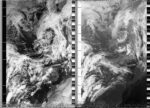
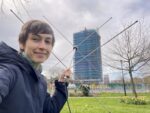
An animated wind is bending tree branches, ripping petals off magnolia trees and making waves in the deep green grass that has sprung up in parks, squares and pavement-free soil around Hackney. En route to a pharmacy, I stopped in a small park in between the Greville and Rogate estates. A tower block, wrapped in blue fabric, was being constructed (or refurbished) at the far side of the park, sending drilling and hammering sounds into the wind.
2024-03-15 09:32:12
Soph Dyer
Augarten, Wien, Austria
Austria
NOAA-19
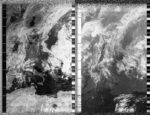
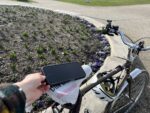
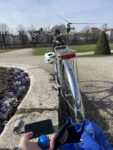
This is the first weather note I write in almost a month. The pansies have been planted out in Augarten. I rested my bike on the stone of circular flowerbed and used a mobile phone and my v-dipole antenna to receive a long image. I took with me a cooked painted egg, which I dropped in the gravel when peeling and had to throw away. It is a clear, sunny day.
2024-03-15 09:32:12
Soph Dyer
Augarten, Wien, Austria
Austria
NOAA-19
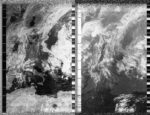
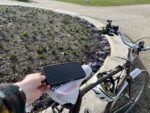
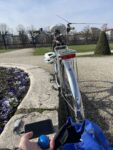
This is the first weather note I write in almost a month. The pansies have been planted out in Augarten. I rested my bike on the stone of a circular flowerbed and used a mobile phone and my v-dipole antenna to receive a long image. I take with me a painted cooked egg, which I drop in the gravel when peeling and have to throw away. It is a clear, sunny day.
2024-03-14 11:55:01
Sasha Engelmann
Hackney Downs, London, United Kingdom
United Kingdom
NOAA-18
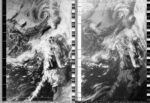
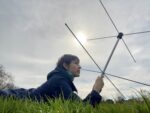
I wanted to field the ground today, so I laid onto the grass of Hackney Downs while capturing the satellite image. It was wet, yes, and musty too, and it smelled a little like unhealthy compost and dogs, but it was nice to feel my whole body flat against the surface of the ground. The air was cool and mild and lots of people were out in the park, some staring at me as they passed a safe distance away.
2024-03-14 11:15:08
Soph Dyer
Augarten by the flowers, Wien, Austria
Austria
NOAA-18
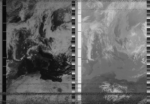
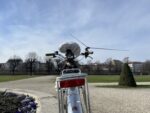
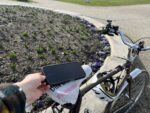

I did not press 'stop recording' before closing SDR++, and so corrupted the file.
2024-03-13 09:00:48
Sasha Engelmann
Royal Holloway University of London, United Kingdom
United Kingdom
NOAA-19
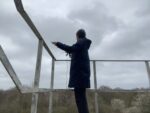
I went for a very low pass today – only around thirty degrees over the horizon – but thought I could get something from the top of the fire escape at the back of Queens Building where the Geography Department is situated. Unfortunately there wasn't much of a signal, and for several minutes at the height of the pass, bursts of interference blocked any chance of clear reception. Still, standing at the top of the fire escape gave me an amazing view of the residential neighbourhoods to the East of the university campus, and I could clearly see airplanes taking off and landing at Heathrow Airport, just over the reservoirs.
2024-03-12 10:43:42
Sasha Engelmann
Downs Road, London, United Kingdom
United Kingdom
NOAA-18


The darkness of yesterday has bloomed into spring rain today. Sitting by the open kitchen window, I could hear the pigeons cooing on the roof, perhaps making use of the partial cover of the chimney wall. Many people walked by on Downs Road, though their umbrellas and quick paces meant that they kept their eyes on the sidewalk, oblivious to a strange metal object being held out of a third floor window.
2024-03-11 12:40:03
Sasha Engelmann
Hackney Downs, London, United Kingdom
United Kingdom
NOAA-18
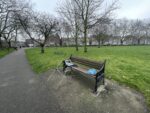
This Monday in London in early March is grey and dark. I had the living room lamp on for most of the morning while I was on zoom calls. I was several minutes late for the low-elevation NOAA-18 satellite pass at lunchtime but I'm still glad I went out to the park, as I met a young mom pushing a stroller, who stopped by to ask what I was doing. I showed her the clouds slowly forming over the South Atlantic, and we spoke briefly about the weather 'above and below'.
2024-03-10 11:08:28
Sasha Engelmann
Downs Road, London, United Kingdom
United Kingdom
NOAA-18

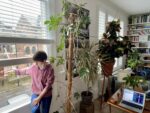
A light rain is forecast to fall all day today. It is coating the street, parked cars, trees, bricks and asphalt in a layer of water that is perpetually replenished from the sky. In weather like this, I wonder how the bugs and creatures of the soil are doing. As water logs the pores between grass roots and humus, do the smaller creatures begin to swim? do they breathe underwater?
2024-03-09 11:17:08
Sasha Engelmann
Hackney Downs, London, United Kingdom
United Kingdom
NOAA-18
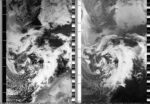
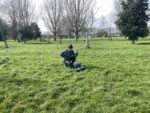
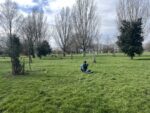
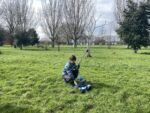
A golden light has suffused the whole morning. The grass of the downs feels warmer, like the earth has heated up underneath. Near where I had set up my ground station, purple crocuses were pushing up through the weeds.
2024-03-08 13:10:12
Sasha Engelmann
Hackney Downs, London, United Kingdom
United Kingdom
NOAA-18

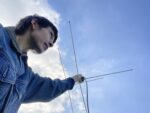
I am writing this weather note on a laptop that has been stepped on by a dog. I can almost see the outline of a paw on the lower right hand side of my laptop keyboard! While I was out in the field this afternoon, a man came up to me and asked what I was doing. He said he was following groups on Facebook doing similar things, but had never tried himself. He seemed genuinely interested in learning about open-weather and as we spoke his dog circled us several times, getting in the midst of the ground station and possibly changing the frequency I was tuned to...
2024-03-07 10:11:22
Sasha Engelmann
Hackney Downs, London, United Kingdom
United Kingdom
NOAA-19
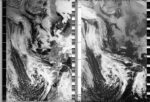
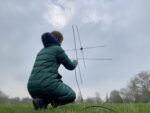
A cold mist is hovering over Hackney today. Fewer people seemed to be out with their dogs, though it could also have been the timing of the satellite pass. However a group of people had gathered on the far side of the open field near Downs Road, bikes fallen sideways on the grass. They were stood in a wide circle doing slow movements with their arms and legs. As they were mostly dressed in long puffer coats and thick scarves, and because of the blurring fog, they looked like people made of cushions or marshmallows, moving slowly in coordination.
2024-03-07 10:59:59
Soph Dyer
Augarten by the trees, Wien, Austria
Austria
NOAA-18
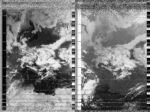
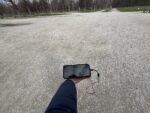
2024-03-06 19:34:04
Soph Dyer
At home, Wien, Austria
Austria
NOAA-19
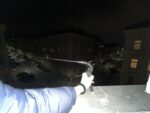
2024-03-06 10:25:49
Sasha Engelmann
Founders Field, Royal Holloway University, United Kingdom
United Kingdom
NOAA-19

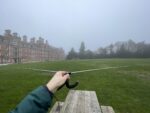
The university campus is coated and swathed in fog today. I set up my ground station on the near-end of Founders Field and could barely make out a group of students smoking (or just breathing in the cold) on the picnic table on the other side of the field. I met some colleagues in the local cafe afterward and they mentioned the fog to me too: 'it must be nice to see out of the fog today'...
2024-03-05 22:09:44
Soph Dyer
Tyršův sad, Brno, Czechia
Czechia
NOAA-18

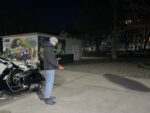
2024-03-05 18:57:46
Sasha Engelmann
Windowsill on Downs Road, London, United Kingdom
United Kingdom
NOAA-15



Today is the first day I felt a slight note of spring in the air. When I woke up at 7am there was already plenty of light in the garden. On my cycle ride to Bloomsbury, my hands didn't feel the bite of cold on my handlebars. I was overdressed for the temperature, and had to unzip my coat halfway through the ride. Later in the evening I perched on our flat's back windowsill holding my radio antenna in full exposure to the night air.
2024-03-05 11:27:55
Soph Dyer
On the balcony, Wien, Austria
Austria
NOAA-18

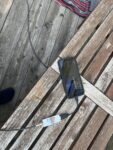
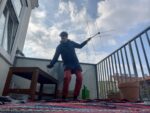
2024-03-04 21:28:15
Soph Dyer
At home, Wien, Austria
Austria
NOAA-18

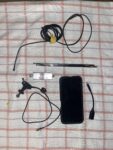
2024-03-04 12:19:32
Sasha Engelmann
Hackney Downs, London, United Kingdom
United Kingdom
NOAA-18

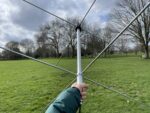
My allergies have been horrible today- so bad that none of my emergency allergy medications and measures are working. While capturing the satellite pass, my eyes watered so much that I couldn't read the frequencies clearly; once back inside the symptoms didn't let up. When this happens I find myself desperately searching for the cause, but the thing about allergies is that sometimes there isn't one that is clearly defined. I am speculating about dust, springtime pollen, a low immune system, or lack of sleep- but none of these feel like the obvious source.
2024-03-03 20:39:23
Soph Dyer
Diepoldpark, Wien, Austria
Austria
NOAA-18

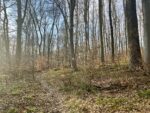
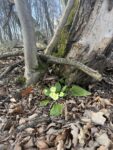
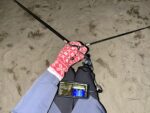
2024-03-03 11:00:47
Sasha Engelmann
Hackney Downs, London, United Kingdom
United Kingdom
NOAA-19

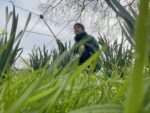
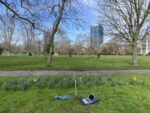
The bulbs and magnolias in Hackney Downs have been blooming in wild and 'spontaneous' groups. Across the UK, magnolias and camellias are blooming four weeks earlier than last year. As if in counterpoint to the conversations I had yesterday, today two older women and their dogs came up to me as I was kneeling by the daffodil beds in the park. One of their dogs, a terrier with huge whiskers, had come over to check out my antenna. The women were both wearing dark sunglasses and wool coats, and apologised for being 'nosey' before asking what I was doing. One of them remarked, 'there must be a whole group of people like you out here, I have seen them around'. I replied I didn't know who this group was, but that perhaps she was seeing me, as I had been in the park with my antenna almost every day (though the possibility of a secret Hackney Downs satellite group stayed with me). A younger woman then ran up to us, apparently having gotten confidence from the older women, and asked more questions with a lot of excitement- she had assumed I was tracking 'geotagged' animals, like birds.
2024-03-02 12:45:48
Sasha Engelmann
Hackney Downs, London, United Kingdom
United Kingdom
NOAA-18

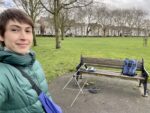
This was a social day in Hackney Downs! I was approached by two men and their dogs, and speaking to them took up most of my attention during the pass. The first was an older, very large man named Bill and his dog nutmeg, a medium sized, curly haired deep brown dog, maybe a kind of terrier. The second was a younger man with a very big and wide laborador. Bill told me stories of his father who had used radio during WWII to listen to the Germans, and later erected aerials at racecourses across the UK (for reasons I didn't entirely understand). He also told me about a lecture he had attended by someone called Chris Lintott that was about microwaves and radio astronomy. The second man whose name I didn't catch had set up an antenna on the roof of his second floor flat to listen to ADSB. He mentioned he had gotten a dipole and tried capturing a satellite image but was unsuccessful. He also asked if I was into amateur radio and when I said yes, he said 'you and about five other people in the world, right?'
2024-03-01 22:06:11
Soph Dyer
At home, Wien, Austria
Austria
NOAA-18

2024-03-01 11:15:14
Sasha Engelmann
Munro Fox Lab, Royal Holloway University, United Kingdom
United Kingdom
NOAA-18


My socks and shoes were already damp from weathering my morning commute to campus, and they got even wetter as I traipsed around the university grounds trying to find a good place for the satellite pass. The field to the back of Queens Building (where the Geography department is based) was virtually spongy with water. I decided to try to set up on a picnic table in the middle of two science laboratories. In full view of biological sciences researchers fiddling with pipets and samples through a bungalo window, I set up my ground station and hand-held the V-dipole. I was lucky that the first eight minutes were rain-free, but toward the end I had to lean my body over the laptop to protect it from drowning.
2024-02-29 18:41:05
Soph Dyer
Augarten, Austria
Austria
NOAA-15

Leap day.
2024-02-29 09:57:27
Sasha Engelmann
Hackney Downs, London, United Kingdom
United Kingdom
NOAA-19

There weren't clear signs of rain when I left my house to go to the park, but as I arrived in the open I could feel a sideways blowing mist of very fine droplets. Once my laptop was out for a matter of minutes it was complete coated in water. I debated the risks of completing the pass vs laptop damage, and decided to keep going, though huddled over the computer with my body. I imagine I looked quite strange to passerby- a hooded person bent over a small screen, trying to hold an antenna with one oustretched arm.
2024-02-28 10:08:55
Sasha Engelmann
West Field, Royal Holloway University, United Kingdom
United Kingdom
NOAA-19

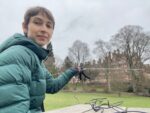
I was aware today that a meadow has its own weather. As I captured the satellite pass, I was conscious of the way the air in 'West Field' at Royal Holloway, surrounded by oak and plane trees, seemed denser than it had felt on my walk up the hill to campus. The open sky over the meadow seemed closer than it had when I woke up in London.
2024-02-27 11:51:48
Sasha Engelmann
Hackney Downs, London, United Kingdom
United Kingdom
NOAA-18
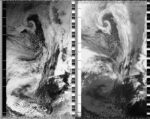
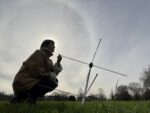
This is the first day that feels a little like spring in London. The air has that shimmer that happens when it is misty but also bright. The green of the grass of Hackney Downs is vivid, an invitation to lie down (which I did) though I quickly learned it was also very soggy underneath. The satellite image I captured has a small cyclone curling over the North Sea, its long tail curving and sweeping all the way to the coast of Morocco.
2024-02-26 12:05:23
Sasha Engelmann
Hackney Downs, London, United Kingdom
United Kingdom
NOAA-18

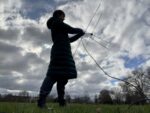
All night the wind howled around our flat. It caused unusual squeeks and whistles in different rooms. As a worked alone at my desk in the living room, the smaller, more random sounds made me imagine other people in the house, so much so that I went into the bedroom and studio to check! The wind had calmed by the time I went outside to catch the satellite pass, but I kept thinking of the wind-people.
2024-02-25 10:44:07
Elliott Engelmann
New York City, United States
United States
NOAA-18
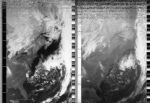
Sunny day at Jacob Riis park in New York, about 2 degrees C, bit of wind from the southwest. I see mostly clear skies all the way up and down the east coast of the U.S. with a few clouds in mainland Canada and a weather system over the Atlantic. I'm noticing very little snow cover in the northeast U.S. until Maine, which is not typical for this time of year.
2024-02-22 22:05:16
Soph Dyer
Reaching out of the door, Wien, Austria
Austria
NOAA-18
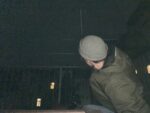
2024-02-22 11:25:02
Elliott Engelmann
Classon Ave, Brooklyn, United States
United States
NOAA-18

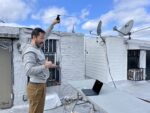
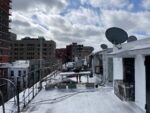
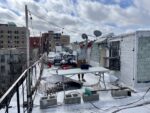
Freezing air, but cotton-ball like clouds hovered over Prospect heights today. We noticed how the satellite signal came through, bouncing around nearby highrises and possibly affected by the elevated hill of prospect park to our West.
2024-02-21 08:10:33
Sasha Engelmann
Soph Dyer
Wave Farm, Acra, New York, United States
United States
NOAA-15

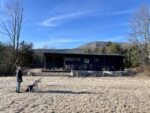
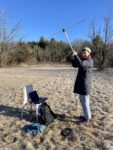
Wave Farm was quiet on this Wednesday morning in February except for the 'whoosh' of sometimes-passing cars on route 23, and the chirping of finches and other birds. The grass outside the Wave Farm building was white and crunchy with frost. We were late to set up for the NOAA 15 pass , but as both our ground stations launched, NOAA-15's signal virtually lept into the waterfall displays on our laptops. We shuddered with cold as the pass progressed. The image captured from the V-dipole antenna I was using shows the outline of the east coast of the US and the impressively large fingerprints of the great lakes.
2024-02-21 08:09:54
Sasha Engelmann
Soph Dyer
Wave Farm, Acra, New York, United States
United States
NOAA-15

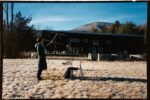
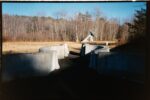
2024-02-14 17:29:33
Sasha Engelmann
Hackney Downs, London, United Kingdom
United Kingdom
NOAA-15

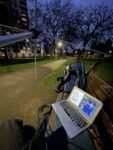
Ashen, cinereal, dusky, smoky, slated, drab, grey: this is how I would describe my experience of the weather today. It is in many ways unremarkable weather, as it is not very cold, nor very wet, nor stormy or very windy. It is simply grey- a matte feeling of the colour like it surrounds you everywhere, inside and outside, dampening even your thoughts.
2024-02-13 10:44:38
Soph Dyer
On my balcony, Wien, Austria
Austria
NOAA-18

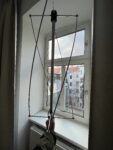
QFH antenna test.
2024-02-13 09:43:50
Sasha Engelmann
Hackney Downs, London, United Kingdom
United Kingdom
NOAA-18
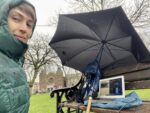
As I hurried out the door and toward the park, I realised that an invisible drizzle had become a light rain. I grabbed one of the broken umbrellas by the front porch and went to the park anyway. Crouching under the makeshift shelter on a park bench, I assembled my ground station and tuned to the frequency of NOAA-18. I knew the pass would be very low in elevation – only 19 degrees to the East – but I was hopeful. After a few minutes of weak signal as the satellite struggled to crest the horizon, a clear image began to appear- showing what I thought were Nordic glaciers and reflective lake surfaces. Only a minute or two later, the unmistakeable 'mound' of Meteor M N2-3 appeared surrounding and engulfing NOAA-18. Though the NOAA signal was strong, it was simply drowned out by the much wider and more powerful digital signal of the Meteor satellite, like someone trying to whisper in a crowded bar. I stopped the recording early, reasonably drenched by the rain, and returned with the glinting shapes of Nordic lakes in my mind.
2024-02-12 11:40:06
Sasha Engelmann
Hackney Downs, London, United Kingdom
United Kingdom
NOAA-18

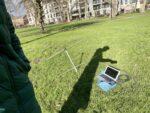
I counted the seconds in the pass I captured this morning. Though the pass was of good elevation, and the weather is beautifully sunny and uncharacteristically warm, I truncated my recording and practically ran home with my antenna still assembled and my cables and laptop dangling. I was worried I would miss saying goodbye to my partner as she finished packing up and left for the airport.
2024-02-11 11:48:14
Sasha Engelmann
Hackney Downs, London, United Kingdom
United Kingdom
NOAA-18
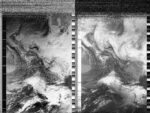
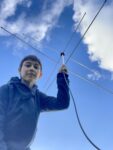
After a weekend of rain and mist, this Sunday morning is glorious, with bright sun coming through very soft clouds. The local Baptist church is in full swing and fragments of choir music and raucous laughter echo into the park from the church's open door. A small group of teenagers gather on the street corner in between the church and the park, angling their faces to the sun. As I recorded the satellite pass I was visited by a small grey curly-haired dog with a red collar who then sped over the wet grass in circles around me. I think about 'dog satellites' and speculate on what they might transmit.
2024-02-10 10:26:48
Sasha Engelmann
Hackney Downs, London, United Kingdom
United Kingdom
NOAA-19
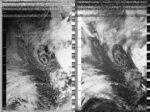


My ground station merged with the wet grass and mud of Hackney Downs field this morning. Mud was everywhere- attaching itself to my antenna bag, on the RF cables, the antenna dipoles, my coat and shoes. Nearby a young boys' soccer team was playing a morning match, egged on by a very loud coach who kept yelling at players by name and asking them 'who are you playing for?!'. I had forgotten my phone so I took photos of my ground station with my laptop camera. They were dark and gloomy but they somehow captured the atmosphere of the field, the game and the intermittent storm clouds.
2024-02-09 17:58:13
Sasha Engelmann
Hackney Downs, London, United Kingdom
United Kingdom
NOAA-15

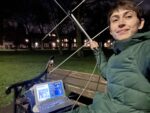
A break in the rain allowed me to duck outside to catch a NOAA-15 pass. The sun had set already, and very few people were out in the park and nearby streets. I searched for a bench near a streetlamp and assembled my ground station. I sat on the bench in the orbit of light provided by the streetlamp and extended the antenna, its metal dipoles glinting.
2024-02-09 10:46:17
Sasha Engelmann
Hackney Downs, London, United Kingdom
United Kingdom
NOAA-18
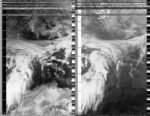
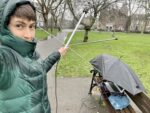
Rain pattered on the windowsills all morning. Water pooled and ran down the glass, and mist seemed to hover in between the three story houses on either side of our one-way street, like a wet cloud trapped in a crevice of our neighbourhood. I contemplated staying inside with my antenna held out the window, but ended up braving the rain with a big broken umbrella and a long insulated raincoat. Once outside, I propped the umbrella over a bench and set up my laptop and dongle under its shelter, with the antenna and cables curling out. At one point during the pass, the wind moved the umbrella and its flimsy, broken side sent pools of water splashing onto the keyboard of the computer- which I hurriedly brushed off with the sleeve of my coat, hoping no damage would be done. A man in full high-vis weather gear with a wheelbarow that looked like a recycling collection stopped next to the bench and asked what it was I was doing out here.
2024-02-07 21:47:26
Soph Dyer
On my balcony, Wien, Austria
Austria
NOAA-18


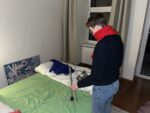
I was buffeted by mild but squally weather through the satellite pass. When I looked behind me the sky was ominously dark. For a moment, I thought that I should put down my antenna in case an electrical storm was coming, but none was forecast so I kept recording. It has been a tough day and I am feeling tired.
2024-02-07 09:22:06
Sasha Engelmann
Founders Green, Royal Holloway University of London, United Kingdom
United Kingdom
NOAA-19
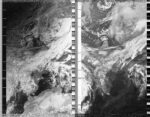
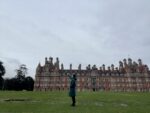
Today is wet, cold, soggy and muddy. A storm swept through London last night, and pattered the windows of my flat for most of the night. Most commuters early this morning had an air of being half-asleep and were hunched down into their scarves and woolly hats, like sea urchins. Founder's field, where I collected the satellite pass, was empty except for me with my V-Dipole antenna and laptop.
2024-02-01 11:30:57
Soph Dyer
Beside the round flowerbed in Augarten, Wien, Austria
Austria
NOAA-18

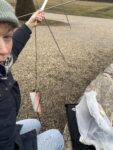
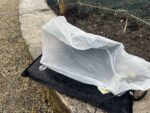
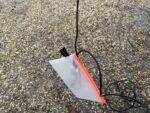
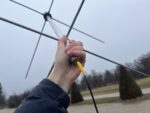
Wet! I have just come back inside from the satellite pass, dripping. I stood in Augarten park, in the intensifying rain, my laptop inside a small bin bag tent. From the warmth of my shared studio, I decoded the image. A huge white arc of water sweeps across my screen from North from Spain to Norway. Is this what it feels like to be at sea – to orientate by waves of water and light? Sometimes Sasha and I joke that open-weather is a queer, feminist space agency. Right now, I feel less like an astronaut and more like an aquanaut.
2024-02-06 09:35:09
Sasha Engelmann
Russell Square, London, United Kingdom
United Kingdom
NOAA-19

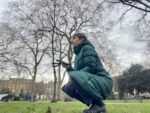
The westerly wind was so strong this morning that, on my bike ride from East London to Bloomsbury, I felt at times that the strength of my body wouldn't manage to move my bike forward, and I regretted my choice to cycle in the first place. I was sweating so profusely inside my green puffer jacket that, once I arrived in the square, I risked the cold air and took off my coat to try to air myself out. I coudl tell that passerby were wondering what a person in nothing but a thin shirt and blazer was doing holding a metal object to the sky at half past nine, but no one approached me. On my cycle home in the evening, the wind, as I hoped it would, practically carried me forward, so that the roads felt glossy and smooth.
2024-02-06 10:32:11
Soph Dyer
Children's play area in Diepoldpark, Wien, Austria
Austria
NOAA-18

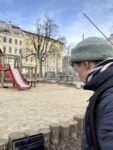
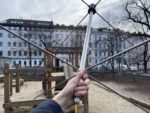
Blustery, blue and spring-like. The wind was so string this morning, it almost blew me off my bike.
2024-02-05 20:36:24
Soph Dyer
At home, on the window ledge., Austria
Austria
NOAA-19

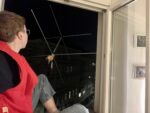
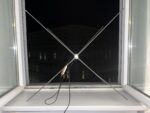
Turbulence: outside, between me and my partner, in my body. I saw on a forecast map that the jet stream is between me and Sasha. The winds leaving London appear to arrive in Vienna. I like this thought, that we are asynchronously sharing the same air. I imagine messages, aeroplankton (Luftplankton), and water vapour moving between us.
2024-02-05 11:23:11
Sasha Engelmann
Hackney Downs, London, United Kingdom
United Kingdom
NOAA-18
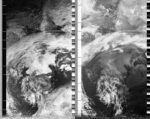
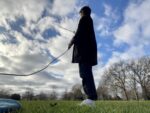
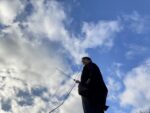
There is high wind today, it feels like gusts are slicing across the surface of the city, though it is hard to tell from what precise direction. The clouds are patchy and partial, like a fast-moving lattice, and sun pierces through in very quick beams that meet earth's surface and disappear again. I imagine that from the position of the clouds, it might be like a high-speed game of shadow puppets. What shapes they must be casting!
2024-02-04 19:08:31
Soph Dyer
In a field by the motorway, somewhere outside Klagenfurt, Austria
Austria
NOAA-19
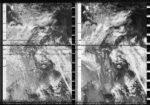
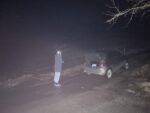
Today I swam in an alpine pool next to melting ice. I am recieving this image a dark hill, by a motorway, under the stars.
2024-02-04 11:36:07
Sasha Engelmann
Hackney Marshes, London, United Kingdom
United Kingdom
NOAA-18
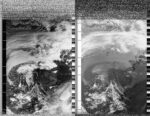
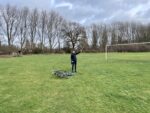
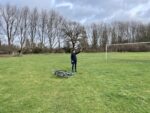
A cold wind slowed me down on my cycle ride out to Hackney Marshes. Once in the marshes, I weaved between Sunday strollers, kids on bikes, canal boaters and athletes to find a corner of the marshes to set up my ground station. At first the NOAA-18 signal was drowned out by the characteristic signal of the Meteor satellite fleet, which caused a 'mound' of energy extending around 80hz to either side of the NOAA-18 signal. I started recording during this noisy occlusion, thinking NOAA-18 was about to pierce through (helped by Automatic Gain Control) but it took a couple more minutes for the signal to make it through the surrounding energy and noise. The wind continued to bluster as the pass progressed. A kind looking man with long gray curly hair and headphones stopped nearby and offered to take a photo of me. We spoke briefly about radio and satellites before he continued on his windy walk.
2024-02-03 18:10:42
Soph Dyer
Near Pontebba, Friuli, Italy
Italy
NOAA-15

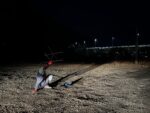
We are in the mountains but it is above freezing. A thin layer of water covered the last of the melting snow. In Vienna last night, the wind was so strong it crashed against the bedroom windows, keeping me awake. After working on open-weather during the day, I was too excited too sleep deeply anyway.
2024-02-03 13:29:01
Sasha Engelmann
Hackney Downs, London, United Kingdom
United Kingdom
NOAA-18

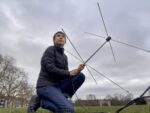
Today I attempted to receive a satellite image from a pass that I assumed would be 'out of the sensible range' of my ground station. The maximum elevation of the pass was 13 degrees to the West, and I hadn't previously tried to receive anything under 30 degrees. Expecting to get nothing, I found a spot in the middle of Hackney Downs and held my antenna as high as possible to catch whatever radio waves could bend around the curve of the Earth as the satellite barely crested the horizon. Surprisingly, the signal was already visible at 13:28 and I had a reasonably strong signal by 13:30. As I watched the image load line by line, I realised I was seeing cloud patterns over Greenland and the north Atlantic, so far to the west that no coastlines of Europe were visible. Meanwhile in Hackney Downs a group of dogs played around me and the gray clouds hung low. There was something incredibly strange about seeing the North Atlantic so many kilometres to the west, while Saturday morning life kept unfolding in London.
2024-02-02 10:28:19
Sasha Engelmann
Downs Road, London, United Kingdom
United Kingdom
NOAA-19


London is gray and cold today, with a haze that feels like a soft blanket. On my way to buy bread this morning, the air made street corners, cars and shops look a little fuzzy. Being inside a bakery, and back in my flat with a warm loaf of bread and a coffee, was deeply comforting. It feels like good weather to be tidying up the house, changing sheets and watering plants.
2024-02-01 10:33:13
Sasha Engelmann
College Green, Goldsmiths University of London, United Kingdom
United Kingdom
NOAA-18
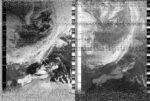
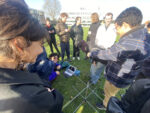
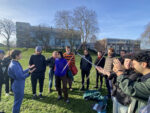
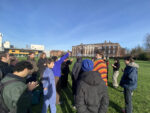
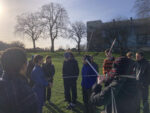
I met the Centre for Research Architecture students on the top of College Green at Goldsmiths University on a brilliantly sunny morning of the 1st of February. I introduced the DIY satellite ground station we would use to capture an image from NOAA-18, and immediately there were about a dozen questions. Melodie held the antenna first, tracking the satellite from the southern horizon to a maximum elevation of 43 degrees. Excited chatter was constant throughout, and laughter rang out as Melodie and later Penelope tried different poses and antenna orientations. The atmosphere was joyful and lively, but as the pass came to a close, the group was happy to return inside to warm up and look at the image in darker / calmer conditions.
2024-01-31 20:38:08
Sasha Engelmann
Hackney Downs, London, United Kingdom
United Kingdom
NOAA-18

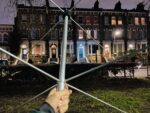
The weather of Hackney Downs park close to 9pm at night on a Wednesday was surprisingly calm. A whispy wind blew blades of grasses but didn't manage to move dry leaves on the ground. I caught the wrong satellite – I had intended to capture an image from NOAA-19, and tuned to NOAA-18 instead – and unexpectedly started recording a 30 degree eastward pass. This first felt inconvenient because a line of Victorian houses blocked my 'line of sight' to the east. But the signal came through anyway, and this accident meant that I captured a dramatic cyclone swirling over eastern Europe and Russia. Seeing the image startled me- a dramatic disconnect from my experience of mild weather in the park.
2024-01-31 11:45:19
Soph Dyer
Gefechtsturm Augarten, Wien, Austria
Austria
NOAA-18

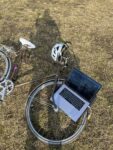
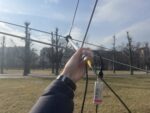
Open skies and bird song – almost spring like. I did not weather my thermal leggings under my trousers today! At first I thought that I'd made a mistake but quickly I warmed up and enjoyed the free feeling of air on my legs.
2024-01-30 21:46:34
Soph Dyer
Dornerplatz, Wien, Austria
Austria
NOAA-18

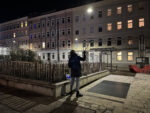
I worked from home so didn't leave my flat until the evening. Today was dry, clear and cold, but not too cold – you could take your gloves off without your fingers hurting. The stars were bright.
2024-01-30 10:57:24
Sasha Engelmann
Lesoco Building, Goldsmiths University of London, United Kingdom
United Kingdom
NOAA-18

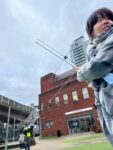
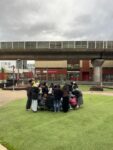
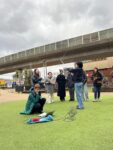
Low, gloomy clouds hung over London as we gathered in the middle of a green circular lawn outside of the LESOCO building in which Goldsmiths design students study for their masters degrees and work in their studios. Deptford creek gurgled just a few metres away, though it was closed for access by a tall metal fence. A highway overpass arced to our east and a six lane intersection around the corner made a constant soundscape of motorbikes and car engines. In this context we huddled around my turnstile radio antenna and attempted to orientate our bodies in relation to the satellite orbiting overhead and the series of urban infrastructures around us. A constant interference pattern caused audible distortion to the satellite signal and produced regular and oblique lines in the image, like counter-currents of wind or a graphical anti-pattern.
2024-01-29 20:20:46
Soph Dyer
Entrance of Augarden, Wien, Austria
Austria
NOAA-19

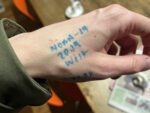
It's clear and cold again, when I left for work this morning the rooftops were frosted white. Frost always takes me back to childhood. When there was a heavy or hoarfrost, I would go out before school to slide down the field opposite our house on a tray. Sledging on frost felt more risky, edgy, than on snow – the frozen ground could easily inflict bruises. It was also a sport no one else seemed interested in, so I had the field to myself – bold and alone.
2024-01-29 11:14:13
Sasha Engelmann
Downs Road, London, United Kingdom
United Kingdom
NOAA-18


The weather of my body today is turbulent and choppy. Though I am usually able to remain calm on the surface, today is proving difficult. I am surprised when my bodily, emotional weather bursts out into the conversations I have with students and colleagues throughout the morning. I have begun to edit apology notes (probably unnecessary) to be sent later over text and email.
2024-01-28 20:35:07
Soph Dyer
Inside with the antenna strapped to a curtain rail, tied to my balcony in Wien, Austria
Austria
NOAA-19

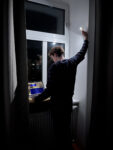
Beautifully sunny. The woods are free of snow and ice, and full of walkers. I went on a solo hike in the Wienerwald, stopping for lunch at Toiflhütte, and breathing plenty of Waldluft. The birds continue to sing. I heard blackbirds, crows, wood peckers, a jay, and small song birds. The temperature is a frosty 5 degrees centigrade, with no wind.
2024-01-28 11:20:46
Sasha Engelmann
Hackney Downs, London, United Kingdom
United Kingdom
NOAA-18
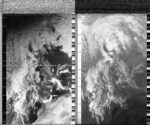

Today is an unusually warm Sunday in London in January. Although the weather has been overcast, the clouds feel veil-like and thin, and the Sun either burns them up or pushes them away by midday. As I was due to make a Sunday lunch for some friends, I spent most of the pass alternating between looking up recipes on my phone and checking the satellite signal. By the end of the pass I had both a long WAV file and a list of ingredients.
2024-01-27 22:26:10
Soph Dyer
On my balcony, freezing my ass off, Austria
Austria
NOAA-18

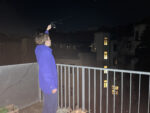
Cold, but only because I didn't expect to stand outside, so I didn't have my coat, hat and gloves on. More bird song today. I was around 7 Centigrade. Clear, clear skies. So many stars.
2024-01-27 11:34:33
Sasha Engelmann
Abney Park Cemetery, London, United Kingdom
United Kingdom
NOAA-18
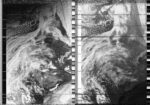
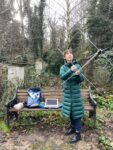
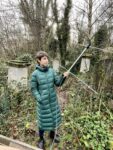
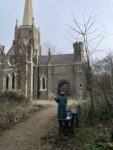
Abney Park Cemetery was muddy, wet, and full of dog walkers and strollers on this Saturday Morning. The density of the winter trees and the humidity of the air created a mist that felt appropriate to the vine-covered tomb-stones, monuments and crosses. I thought of the way early radio enthusiasts heard 'something in the static' that spoke of other spaces and times of the past and future. I pointed my antenna at the moist ground, wondering if the static would pick up frequencies underneath.
2024-01-26 19:06:51
Soph Dyer
Augarten, near the gun towers, Wien, Austria
Austria
NOAA-18

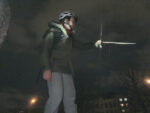
Today, the bird song was louder than the beep-beep of the satellite. Gardeners in the park were clearing the dead leaves into piles. I heard that it's better to leave them to decompose and return their nutrients to the trees from which they fell – they don't kill the grass. The temperature is mild and there is no wind, but there is a heavy blanket of cloud. Although it is nearly midday, the cars have their headlights on. This evening I willl go to the 'Defend democracy' protest outside the Austria Parliment.
2024-01-26 10:10:04
Sasha Engelmann
Hackney Downs, London, United Kingdom
United Kingdom
NOAA-19

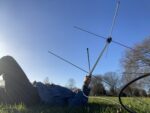
The sky is a deep cerulean blue today – cloudless, and slightly purple in hue. I spent part of the satellite pass lying on my back looking up. The grass was so wet and cold that I didn't stay on the ground long, but the feeling of being engulfed in a January blue has stayed with me.
2024-01-25 21:31:00
Soph Dyer
My bedroom, Wien, Austria
Austria

Silent migraine.
2024-01-25 10:21:30
Sasha Engelmann
Hackney Downs, London, United Kingdom
United Kingdom
NOAA-19
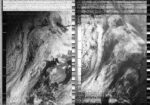
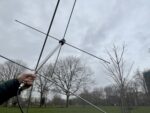
Today the park was spontaneously drizzly and I hunched over my laptop to keep it dry for the ten minutes of the pass. As I was crouched so low to the ground for most of the time, I experienced the weather of the park at the height of a small child or animal.
2024-01-24 19:06:51
Soph Dyer
Augarten, Wiem, Austria
Austria
NOAA-15

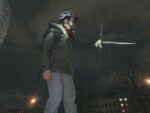
It almost feel warm today. In the afternoon, it rained but I was inside the studio so didn't notice until I saw the wet pavement. My body also feel springy-ier, the migraine and stiffness I've had since Saturday is receding.
2024-01-24 10:32:45
Sasha Engelmann
Royal Holloway University of London, United Kingdom
United Kingdom
NOAA-18

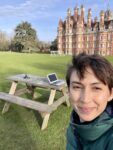
In comparison to the windy and wet weather of Storms Isha and Jocelyn over the last few days, today feels calm, even balmy. I walked to 'Founder's Field', the highest point on the university campus, to set up my spare V-Dipole and test a new dongle (RTL-SDR V4). The atmosphere of the university is also calm, as if the machines of departments, university managers and administrators are hibernating.
2024-01-23 21:33:09
Soph Dyer
On the North West corner of Diepold Park, Wien, Austria
Austria
NOAA-18

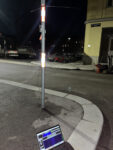
I think heard a Great Tit calling this morning. It rained today and feels milder. I was meant to be on a night train to the Netherlands this evening but German train drivers have walked out. They will be on strike until Monday. I have cancelled my trip. Life feels turbulent at the moment.
2024-01-22 20:08:39
Soph Dyer
Leaning out of the Northeast facing window of my flat, Wien, Austria
Austria
NOAA-19

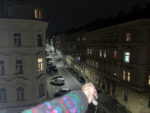
I have been inside most of today. The weather inside is stuffy.
2024-01-22 10:57:26
Sasha Engelmann
Hackney Downs, London, United Kingdom
United Kingdom
NOAA-18

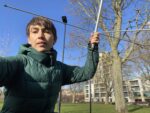
Wind has changed the surface of the park and neighbourhood overnight, leaving large piles of torn leaves, knocking down branches, ripping coverings off parked motorcycles and bending 'for rent' signs on their axes. Whistles and howls echo through the streets and across the downs, joined by the sirens of ambulances and fire trucks. On local radio this morning there was mention of wifi and phone service cuts. This is London in the aftermath of Storm Isha, which has swept across the southeast overnight. Its long arm is dramatically visible in the satellite image I captured today – curving over France, Germany and the continent, and spiralling toward Sweden and Norway.
2024-01-21 20:19:49
Soph Dyer
The balcony of my flat, Wien, Austria
Austria
NOAA-19

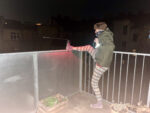
Frosty, slowly defrosting. This morning, I woke to a blackbird singing. There is still snow on the ground in the woods. Sasha and I have been receiving NOAA satellite imagery everyday for one month!
2024-01-21 11:08:40
Sasha Engelmann
Downs Road, London, United Kingdom
United Kingdom
NOAA-18

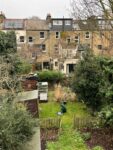
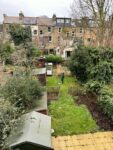
Storm Isha has been sweeping across the UK this weekend, with amber weather warnings issued by the Met Office in many parts of Wales, Scotland and Western England. Though the conditions weren't that bad in London, I stayed in the back garden of our flat to keep sheltered from wind. A curious cat named Dylan came padding quietly up behind me to check out what I was doing.
2024-01-20 20:32:35
Soph Dyer
Inside my bedroom! Wien, Austria
Austria
NOAA-19


It's clear but cold. I'm still feeling unwell (again!) that I think it feels colder to me than it actually is. I stayed inside during the satellite pass.
2024-01-20 11:20:08
Sasha Engelmann
Hackney Downs, London, United Kingdom
United Kingdom
NOAA-18
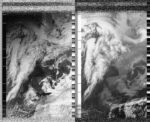
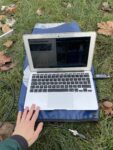
It was a gray blustery morning in Hackney Downs. A man with a dog stopped nearby and asked 'what's that mate?' to which I replied 'a radio antenna, I'm trying to catch the signal of a weather satellite'. He gave a thumbs up and said 'so it's a weather thing? a weather thing?' I nodded, and he walked off without further questions. I had apparently given a satisfactory answer. Yet I wondered what kind of 'weather thing' he was convinced I was operating.
2024-01-19 11:32:55
Sasha Engelmann
Downs Road, London, United Kingdom
United Kingdom
NOAA-18
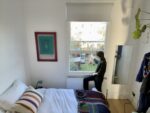
I was in between two meetings on Microsoft Teams – one finishing and another one starting at 11:30. NOAA-18 was due to start its orbit over London at 11:31. I wondered – was there time for the weather? I tried to 'create time' by writing a 'I'm five minutes late' message to the person I was due to meet, and took my laptop to the bedroom to the nearest possible window to receive the satellite pass. As I was counting the minutes of the pass I was also counting how late I would be. I wished I could stay in the 'weather' of the bedroom and sunny back garden, and avoid the 'weather' of the Teams meeting room!
2024-01-18 08:13:21
Soph Dyer
The balcony of my flat, Wien, Austria
Austria
NOAA-19
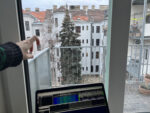
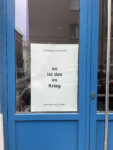
So icy underfoot! My body felt sluggish this morning from a lack of sunlight and and my period. I ventured outside only to grip the v-dipole antenna to the balcony railing and then stayed inside for the duration of the satellite pass.
2024-01-18 11:44:26
Sasha Engelmann
Hackney Downs, London, United Kingdom
United Kingdom
NOAA-18
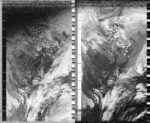
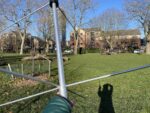
The weather was bright and gusty, and bitingly cold. Hackney Downs was wide open and clear, so clear it made me wonder what it was before there was London. There were so many dogs being walked in Hackney Downs – I saw one person holding eight dogs – and a short-haired Australian Shepherd ran up to my laptop during the satellite pass. I stopped to pet her, and I wondered if her energy was having an influence on the satellite image.
2024-01-18 09:26:57
Soph Dyer
The balcony of my flat, Wien, Austria
Austria
NOAA-19

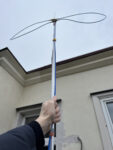
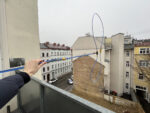
I tried the loop antenna again, this time squashing it into a folded dipole. The result was not good. Despite the near overhead position of the satellite, I could barely hear its transmission. I experimented with orientating the antenna vertically and horizontally.
The temperature feels a warm 2–5 degrees this morning. It is raining lightly.
Over WhatsApp, my brother sent a photo of the sun rise off the coast of Cornwall. In return, my mum shared a photo of her frosty garden. In both photos, the sky was clear. Yet an hour later my sister’s partner sent a video of large snow flakes falling in Truro. The weather in the UK is so much more changeable than in Austria. Here we have steady, continental weather. British weather is sea weather.
2024-01-17 21:49:09
Sasha Engelmann
Downs Road, London, United Kingdom
United Kingdom
NOAA-18

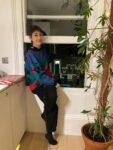
I had finally made it home after a fourteen hour day at work at the university and on many commuting trains. It's been so cold in the UK with a current of Arctic air reaching down across northern Europe this week, but it has also been very clear and bright- I could see the stars as I reached my antenna off the kitchen windowsill.
2024-01-17 09:39:48
Soph Dyer
The balcony of my flat, Wien, Austria
Austria
NOAA-19

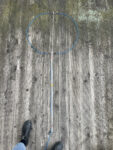
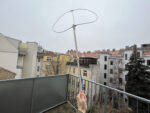
Cold, small, icy snow flakes. I had to keep my laptop inside. I used the loop antenna, elevated by a curtain pole to 1.5 metres. The antenna was highly directional, and so was challenging to keep tuned to the satellite.
There is still pockets of snow on the rooftops. It feels around –3C outside. It wasn't forecast to snow today but the clouds are a pale white-grey and city has the deadened acoustic quality of a snow day. The light level is low.
2024-01-10 08:48:00
Soph Dyer
Carnegieplein, Peace Palace, The Netherlands
The Netherlands
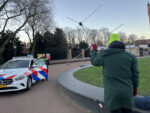
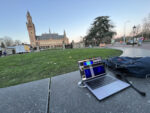
Lizzie and I stood outside the Peace Palace. Its public square was the closest the open space to our apartment. But we had also retuned out of curiosity to record the atmosphere before tomorrow’s court hearing. “The world will be watching The Hague,” several Dutch people had told me. On arrived, the square was empty except for people going to work or walking dogs. At the palace gates, security guards were using LED-lit mirrors to check the underbellies of vehicles. Perhaps this level of caution at the Court was normal? Lizzie and I assembled the antenna and tuned to the satellite's frequency. At first, a security man walked over and asked us to leave. We negotiated 10 more minutes. Annoyingly, we had not yet picked up a signal. I was about to begin troubleshooting when the a police car pulled-up. A police man asked for our IDs and took them into the patrol car, while his colleague stood, leaning on its open door. Still no satellite signal. Lizzie experimented with the position of the antenna, when she rotated it, I was sure that I briefly saw the telltale lines of the transmission. Cold, we gave-up, packed down, and waited for our IDs to be returned. Lizzie lamented having not pressing record: at least then we would have documented radio environment. As it was, we left twitchy from police check and without an image. From inside a nearby cafe, I tuned to the tension in my muscles and their alertness. Perhaps we hadn’t needed the radio antenna. Our bodies had picked up a tension in the air that I had failed to see.
2024-01-16 12:09:16
Sasha Engelmann
Hackney Downs, London, United Kingdom
United Kingdom
NOAA-18
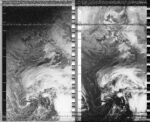
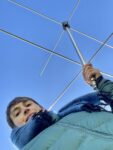
The weather today is gorgeous – bright blue skies and golden sunlight. All morning the DJs on NTS radio have been remarking on the beautiful (if cold) weather conditions. To soak up the weather as much as I could, I found a spot in the middle of the widest field in Hackney Downs and set up my ground station. I was exposed in other ways too- many people stared and pointed at me from a distance, but none came near.
2024-01-16 11:29:29
Soph Dyer
Augarten, Wien, Austria
Austria
NOAA-18

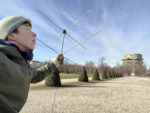
A piercingly clear day. Fresh. Chilly! I was glad to feel the sun on my face.
2024-01-15 21:29:44
Soph Dyer
Wien, Austria
Austria
NOAA-18

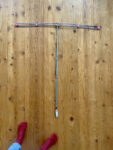
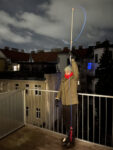
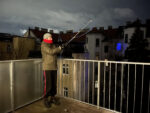
Cold, dark, damp. I feel "under the weather". Today, I stayed home and experimented with the loop antenna. To adapt the antenna to receive Very High Frequency transmissions, I squashed it into folded dipole. Despite what the online instructions recommended, this seemed to make things worse. I reverted to the open loop – the circumference of which is just under a half wavelength of 137 MHz. It okay but was highly directional. I will try again soon.
2024-01-15 10:41:52
Sasha Engelmann
Clapton Pond, London, United Kingdom
United Kingdom
NOAA-18
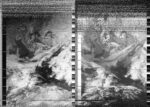
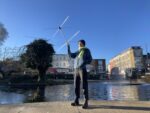
Half of Clapton Pond was frozen on the surface, the other half (receiving the sun over the tops of buildings) was not. Pigeons stayed out of the shade, milling about the edge of the pond and periodically bursting into the sky. In the decoded satellite image, I noticed that the mainland UK appears sandwiched between two bodies of east-moving cloud, receiving its own intermittent winter sun.
2024-01-14 20:03:14
Soph Dyer
Wien, Austria
Austria
NOAA-19

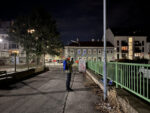
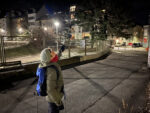
I wore too many wooly layers! It was milder than I expected, around zero Celsius. My ground station was between the bins and the Austrian Post Academie. A few stars were visible between the clouds and light pollution. People hurried past: a dog walker, a parent and child, a runner. I have felt restless today. I asked Nicola about the weather: he says people are ice skating on the nearby pond in Türkenschanzpark.
2024-01-14 11:02:15
Sasha Engelmann
Downs Road, London, United Kingdom
United Kingdom
NOAA-18
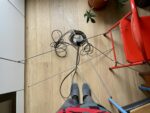
I stayed almost entirely inside during this satellite pass, in sweatpants, slippers and an oversized jumper I had found in a vintage store in Buenos Aires. Even before I stuck my arm outside the kitchen window to catch the last half of the satellite pass, the antenna was picking up NOAA-18 inside the flat. This made me wonder about the porousness of our flat to the 'weather' of radio. Nicola took a look at my satellite image, he pointed out a cluster of white pixels where Mt Etna should be: the volcano is snow covered!
2024-01-13 17:53:11
Sasha Engelmann
Hackney Downs, London, United Kingdom
United Kingdom
NOAA-15

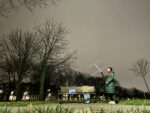
I assembled my antenna on a bench in a dim pool of lamplight after sunset in the local park. I had just come back from the march for Palestine and still had my placard with me. As I was already so cold and tired from being out at the march all day, and the park was even colder than the streets, I struggled to concentrate, almost dropping my antenna and laptop.
2024-01-13 18:50:29
Soph Dyer
Wien, Austria
Austria
NOAA-15

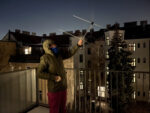
Cold but clear. I enjoyed being in the weather because I have a new coat and I have been inside all day. Amazingly, the snow on the balcony is the same as when I left a week ago. I take pleasure in this stability because I am feeling disorientated: I did not sleep on the night train and I stayed in bed all today.
2024-01-12 19:22:06
Soph Dyer
Between Amsterdam and 's-Hertogenbosch, The Netherlands
The Netherlands
NOAA-15
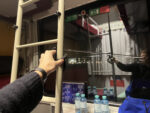
I am on the night train. The weather inside is controlled by a continuous cold draft from an overhead ventilation duct. I rigged my v-dipole antenna to the ladder for the beds, and tuned to NOAA-15 mid-pass. As the train sped between lit buildings, I could see the satellite dip in and out of reception. I finish the recording just before we reach the next station. I am thinking about how the current political climate renders some lives disposible, ungrievable. "An ungrievable life is one that cannot be mourned because it has never lived, that is, it has never counted as a life at all", wrote Judith Butler. Is this fascism? Golrokh messaged from Tehran. There is so much weather between us. At 's-Hertogenbosch, a woman paediatrician boards the train. She is wearing a blue surgical mask and says that she’s got the flu (later, she corrects, she thinks that she has Covid). Our shared compartment feels tense as we exchange gases, aerosols, and possibly virus. She is going on a skiing holiday.
2024-01-12 11:26:31
Sasha Engelmann
Downs Road, London, United Kingdom
United Kingdom
NOAA-18
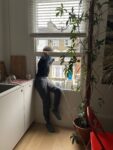
I tried to stay away from the weather today as my asthma had kept me up the previous night and I was worried about too much time in the cold. I leaned out my second story window to catch the segment of the satellite pass that managed to creep in between the Victorian buildings on my street.
2024-01-11 09:51:05
Sasha Engelmann
Hackney Downs, London, United Kingdom
United Kingdom
NOAA-19
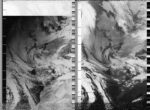
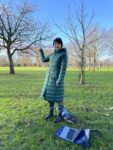
I wanted to catch the satellite pass in my back garden, but the gate was so cold the lock had frozen or stuck, and I couldn't open it. I hurried to Hackney Downs and found a spot very close to the entrance in the long shadows of the plane trees. As I was listening to the satellite a woman with bright pink gloves came up behind me and asked what I was doing. When I told her about the satellite and my radio antenna, she immediately asked – are you a creative? This is the second time a person in Hackney Downs has asked me whether I am a 'creative' while I am holding my antenna. She kindly took the photo I uploaded.
2024-01-11 10:46:05
Soph Dyer
Eline Vere Park, Den Haag, The Netherlands
The Netherlands
NOAA-19
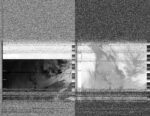

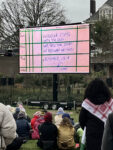
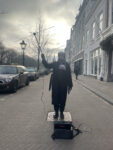
"GLOBAL SOLIDARITY CALL WITH SOUTH AFRICA. JUSTICE FOR GAZA, MANIFESTATION AND LIVESTREAM OF COURT HEARING. Bring banners and signs with text: 'No genocide, No ethnic cleansing, Anywhere', 'Justice for the Palestinians', IsraelOnTrial for its #GazaGenocide'" @free.palestine.nl
Today, I am unable to organise my experience of the weather into the coherent report.
At lunch, I stood in the park behind the ICJ and watched a live stream of South Africa's lawyers argue that Israel is intended to commit genocide.
Outside it is still below freezing.
A street away, the students are build antennas:
Ice-tennas,
Tree branch-tennas,
Finger-tennas.
2024-01-10 20:50:30
Carmen
Zuiderstrand Den Haag, Netherlands
Netherlands
NOAA-19

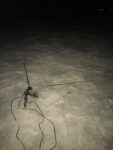
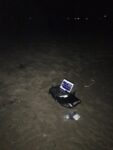

It was a super cold night. Around that time polar jet streams brought cold air onto mainland euorpe as the polar vortex at the north pole was discrupted beginning of this year. The beach was surprisingly calm. No wind interferred with the recording and the sound of the satellite came in clearly.
2024-01-10 10:02:11
Sasha Engelmann
Hackney Downs, London, United Kingdom
United Kingdom
NOAA-19
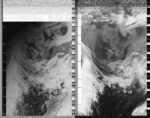
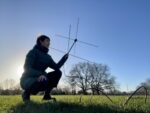
The grass crunched with frost this morning, and the air was so cold that my hands felt clumsy while assembling the antenna. Midway through the pass, a beautiful Italian greyhound in a pink sweater came over to investigate.
2024-01-09 11:56:24
Sasha Engelmann
Hackney Downs, London, United Kingdom
United Kingdom
NOAA-18
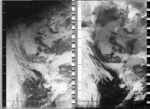
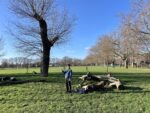
I made a poor choice not to bring a hat and gloves when I went out for the pass today, as Hackney Downs was sunny but extremely cold and windy. Even the dogs running in the park had sweaters and multicoloured outfits on. A man stopped and asked what I was doing, and a woman and a dog happily took some photos of me.
2024-01-09 11:13:34
Soph Dyer
Malieveld, Den Haag, The Netherlands
The Netherlands
NOAA-18
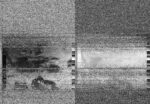


It’s bloody freezing!
Today’s image is from the workshop demonstration.
I am too brain-fried from teaching to write more.
2024-01-08 19:18:03
Soph Dyer
Peace Palace, Den Haag, The Netherlands
The Netherlands
NOAA-15

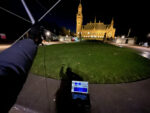
Brrrr. It is bitterly cold! I almost stopped the recording early because I couldn't feel my fingers despite my gloves. The sky was icy clear so I tried to spot NOAA-15, without luck I arrived in the Netherlands this morning after taking the the night train from Wien. I woke to thick snow flakes floating outside the train window. Inside the weather was toasty. It's no long snowing, but a wide current of cold air, coming down from Russia, is chilling Central and Western the Europe to the bone! Tomorrow I will wear my thermal leggings.
2024-01-08 12:08:23
Sasha Engelmann
Hackney Downs, London, United Kingdom
United Kingdom
NOAA-18
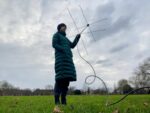
Snowflakes started to fall on my laptop during the satellite pass. They were very small and fragile, fluttery fragments of crystalline ice, not heavy like hail or water.
2024-01-07 08:58:27
Rectangle
Mount Florida, Glasgow, Scotland, United Kingdom
Scotland, United Kingdom
NOAA-15

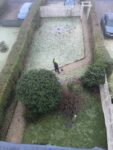
It was really misty, I couldn't see anything beyond the garden, cold too.
2024-01-07 08:21:24
Soph Dyer
Wien, Austria
Austria
NOAA-15

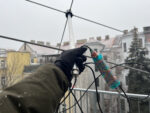
White-grey sky. Not too cold. It began to snow just before the satellite pass, so I had to change plans and stay on my balcony, where my laptop could stay dry, instead of going to the park. I used a stretchy piece of plastic to weatherise my dongle.
2024-01-06 11:26:55
Sasha Engelmann
The Bluffs at Pacific Palisades, California, USA
USA
NOAA-18
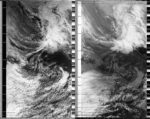
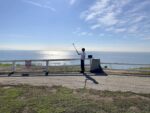
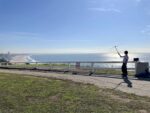
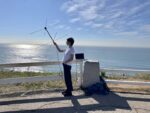
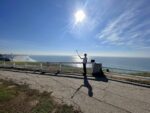
From the 'point on the bluffs' in Pacific Palisades, Los Angeles, I could see as far as Palos Verdes and Catalina Island. It was a bright, warm day, and many people were out walking. The satellite 'set' over the Pacific Ocean- I felt I could hear it for much longer than I normally can from a place in the city, as there was only air between me and the horizon.
2024-01-06 20:00:00
Soph Dyer
Wien, Austria
Austria
NOAA-19

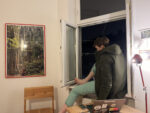
Cold. It's been raining all day. I held my antenna out of the window.
2024-01-05 20:16:07
Soph Dyer
Wien, Austria
Austria
NOAA-19

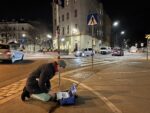
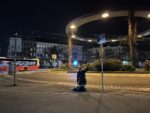
Chilly and noisy (cars, mopeds, buses)
2024-01-05 09:59:43
Sasha Engelmann
Heather Village, Fox Hills, California, USA
USA
NOAA-19

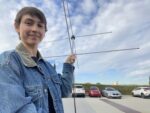
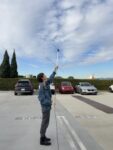
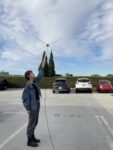
Standing in an elevated parking lot attached to the Heather Village condominium complex in Culver City, Los Angeles, I could hear engines starting and wheels tentatively moving as commuters started their day. The nearby 405 Freeway made a constant whoosh-hum, and airplanes took off and landed at LAX.
2024-01-04 08:26:26
Sasha Engelmann
Yucca Valley, California, USA
USA
NOAA-19
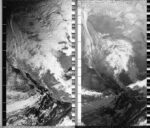
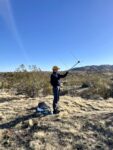
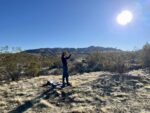
A pack of coyotes howled in the distance as I captured this satellite image. I was on the edge of Yucca Valley bordering Joshua Tree National Park, and while the air was cold, the sun was very strong, reaching into the crevices of the hills and boulders. The wind whistled among the Joshua Trees and Cholla Cacti. I felt very 'close' to the satellite too- there was so little radio noise, the moment I picked up my antenna, the satellite signal came through clearly, even though it had barely crested the northern horizon. I didn't need to look at the compass on my phone because the north star had shone so brightly the previous evening and it was easy to remember where 'north' was.
2024-01-04 07:54:36
Soph Dyer
Venice, Italy
Italy
NOAA-15
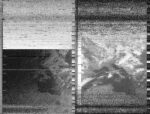
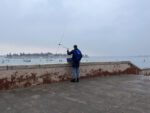
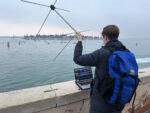

Chilly, damp morning air. It is misty on the lagoon. Cloudy, soft light, pastel colours. There is lots of radio frequency noise. The satellite's signal is weak, perhaps because of the noise or because my turnstile antenna is missing a pole.
2024-01-03 20:34:37
Soph Dyer
Fondamente Nove, Venice, Italy
Italy
NOAA-19
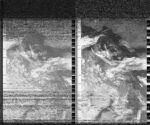
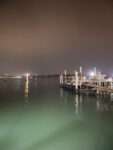

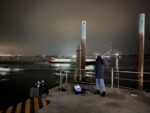
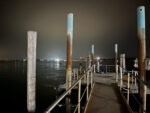
It is a beautifully still night on the Venice lagoon; overcast, but with good visibility. I captured the image from a floating pontoon on the Fondamente Nove. As the satellite passed overhead, the pontoon was rocked by passing Vaporetti. I made a sound recording of water and radio waves mixing with the and clinking metal of the pontoon and a man singing.
2024-01-03 07:51:57
Sasha Engelmann
Heather Village, Fox Hills, California, USA
USA
NOAA-15

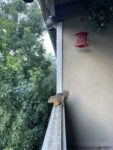
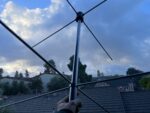
A storm has passed through southern California overnight, and there are still impressive clouds in the sky. The air is brisk and full of water. I captured an image from NOAA-15 which turned out without glitches but unusually dark – as if the satellite was somehow sensing the atmosphere on the ground.
2024-01-02 22:17:00
Soph Dyer
Fondamente Nove, Venice, Italy
Italy
NOAA-18

Damp cold, overcast and dark. My second failed satellite pass! Nicola was helping but dropped one of my antenna poles onto the marble of Fondamente Nove, crushing the screw thread. I also for my USB adapter. I am very tired.
2024-01-02 10:35:18
Sasha Engelmann
Heather Village, Culver City, California, USA
USA
NOAA-18
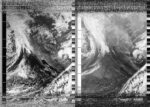
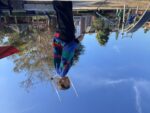
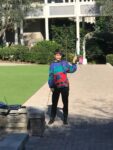
I experienced the weather of a private children's playground on a bright morning in January in LA. I could hear small children's voices echoing out of the Montessori School nearby, and the creaking of the playground equipment as swings and ladders moved.
2024-01-01 10:48:44
Sasha Engelmann
Regent Street, Culver City, California, USA
USA
NOAA-18

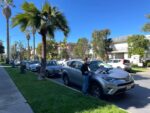
I was on a palm tree-lined neighbourhood street in Culver City, around the corner from the Diorama-Museum of Bhagavad-gita, where I had booked a tour for the morning of January 1st. I balanced my laptop on the hood of my brother's car and held the antenna to the clear blue sky. The weather was bucolic, as if even the light had slowed down.
2024-01-01 11:15:10
Soph Dyer
Carezza, Italy
Italy
NOAA-18

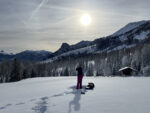
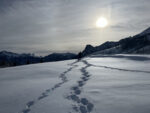
There was heavy snowfall yesterday afternoon and overnight. This morning it is sunny and clear with no wind. I was able to take my winter coat off.
2023-12-31 11:02:00
Sasha Engelmann
Fox Hills, Culver City, California, USA
USA
NOAA-18
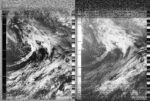
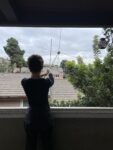
The air is so clean today- the rain has washed and blown away the particles that caused the air pollution spike at the end of last week.
2023-12-31 11:38:40
Soph Dyer
Carezza, Italy
Italy
NOAA-18
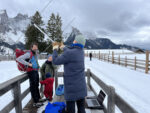
Very cold, a few snowflakes in the air. I failed to press record!
2023-12-30 09:32:43
Sasha Engelmann
Fox Hills, Culver City, California, USA
USA
NOAA-19

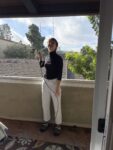
On my way to LAX airport to drop off my brother this morning, the air was so misty and wet, and the rain was so "strong", that people were driving at almost half the normal speed limit- a sign that the rain is affecting how people feel in LA. I didn't think the same would be true of people or drivers in the Pacific Northwest or Europe. By the time I caught the satellite pass, the clouds had parted and the sun was hot on the balcony.
2023-12-30 11:46:17
Soph Dyer
Lago Inferiore, Mantova, Italy
Italy
NOAA-18

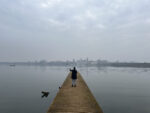
Still, damp air, mild. Beautifully misty. Mottled sky.
2023-12-29 09:43:41
Sasha Engelmann
Fox Hills, Culver City, California, USA
USA
NOAA-19

The air has been warm but the visibility is low- a light fog has settled over the Los Angeles basin. Throughout the day the fog became more dense, and was likely trapped by the marine layer of cold air coming in from the Pacific.
2023-12-29 11:51:45
Soph Dyer
Near Mantova, Italy
Italy
NOAA-18
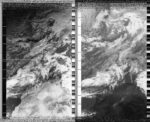
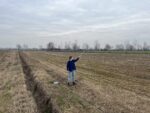
Low, thick cloud cover. The air was warm and moist. Low light despite it being nearly midday.
Standing between the fields, there were no obstructions other than telegraph and electricity pylons. It was amazing to as “see” the southern boarder of Algeria.
2023-12-28 19:00:15
Soph Dyer
Bergamo, Italy
Italy
NOAA-15

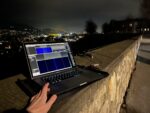
It is my second night in Bergamo at same location but with my v-dipole antenna instead of the turnstile. Yesterday I learned that that the radio environment was noisy, however I was still surprising to receive no image.
During the day Nicola and I observed an opaque haze hugging the alluvial plains of Lombardy. At dusk, a narrow slip of sky, frame by the haze below and clouds above, glowed blood red. Having heard how the Alps trap air pollution from the small factories on the plain, the red glow felt menacing.
2023-12-28 09:58:30
Sasha Engelmann
Heather Village, Culver City, California, USA
USA
NOAA-19


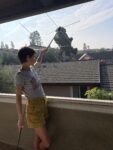
A very warm, bright balcony
2023-12-27 22:05:20
Soph Dyer
Bergamo, Italy
Italy
NOAA-18

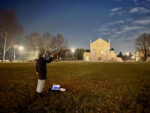
Hazy, damp cold. First night in Bergamo.
2023-12-27 10:08:41
Sasha Engelmann
Culver City, California, USA
USA
NOAA-18
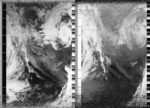
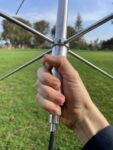
It is a sunny and bright morning. As many people are working today after a few days holiday break, the air is filled with sounds of vacuum cleaners, washer/dryers, leaf blowers and home DIY equipment.
2023-12-26 10:20:51
Sasha Engelmann
Culver City, California, USA
USA
NOAA-18
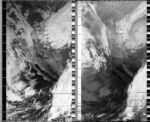
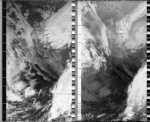
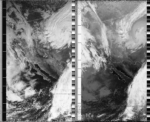
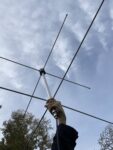
The humidity is unusually high today- around 88% The local park was very vibrant and active, with a young soccer team and a group of people throwing frisbees. On my way back home I noticed several policemen checking parked cars along Green Valley Circle. One group had what looked like a kit with a brush- I wondered if this was for fingerprints. Had the humidity of the air affected which fingerprints could be lifted off car doors, handles and windows?
2023-12-26 18:10:44
Soph Dyer
Wien, Austria
Austria
NOAA-15

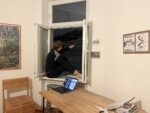
Dark, mild.
2023-12-25 10:36:26
Sasha Engelmann
Culver City, California, USA
USA
NOAA-18

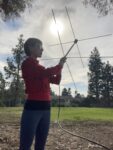
There is a soft light today, like the air is filled with small reflecting particles, whether water droplets or dust.
2023-12-25 09:20:08
Soph Dyer
Wien, Austria
Austria
NOAA-19

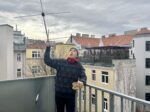
Grey and so warm. It's Christmas (and my birthday). The horrors being reported from Gaza seem to be worsening: Heavy weather, lethal weather. Clouds maps are always moving. Clouds make visible our shared breath.
2023-12-24 10:46:10
Sasha Engelmann
Culver City, California, USA
USA
NOAA-18
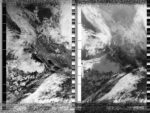
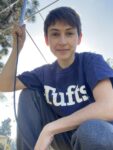
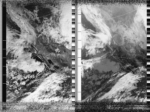
The sun was very bright and the air so warm today, I ended up in a t-shirt while capturing the satellite pass. The park was lively as a soccer team started warming up and a group of walking womxn did laps on the sand trail. I was on a video call during the whole satellite pass, and this made me reflect on the ways the signal from my phone was relaying through a nearby cell tower and onward to the other side of the planet, while the NOAA satellite above me sent radio waves to the ground – I wondered, did the signals touch?
2023-12-24 09:29:15
Soph Dyer
Wien, Austria
Austria
NOAA-19

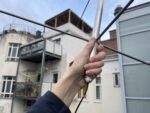
windy, mild, a small amount of blue sky, it's Christmas eve!
2023-12-23 21:14:06
Soph Dyer
Wien, Austria
Austria
NOAA-18

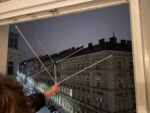
Mild, very windy, raining
2023-12-23 09:12:47
Sasha Engelmann
Culver City, California, USA
USA
NOAA-19
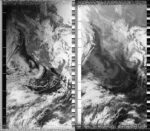
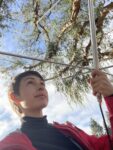
Today the light is a pale yellow and the air shimmers with leftover water evaporating from puddles and storm drains in LA. The city smells more intensely, as if all the materials on concrete surfaces, roads and sprawling buildings have sublimated. Throughout the satellite pass, the roar of airplanes taking off from runways at nearby LAX was palpable, though the misty clouds meant none of the planes could be seen.
2023-12-22 09:25:50
Sasha Engelmann
Culver City, California, USA
USA
NOAA-19
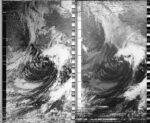
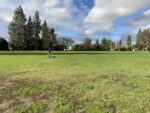
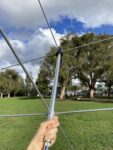
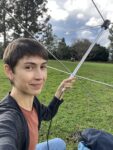
There were flood risks in Southern California over the last few days as the region received storm cell bursts. I recorded my image during a clear break in the rain, though the air, ground, trees and sidewalks were still soggy. A woman was throwing a branch to her Australian Shepherd in the park while I was recording the image. The dog was kicking up so much mud its multicoloured fur was completely mud-coloured after a few minutes. As I returned inside after the satellite pass, another burst of rain began pounding the roof of my Mom's condo.
2023-12-22 09:53:21
Soph Dyer
Wien, Austria
Austria
NOAA-19

clear skies after a storm, solstice sun, strong warm wind, wet wood of the balcony
2023-11-08 07:34:42
Anna Madeleine Raupach
Ngunnawal / Ngambri Country, ACT, Australia
ACT, Australia
NOAA-15

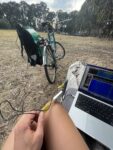
The sun was bright although there were clouds in the sky. I remember there were flies and insects in the air. While receiving this image I noticed my mobile network was down, and after returning home I found out that Optus (one of Australia's main data networks) had a nation-wide outage. I am not sure if this would have affected the signal from NOAA15, but I did notice the radio landscape was more clear than normal that morning – however that did not result in a particularly clear image.
(This is not the best image of the bike-tenna but the one I took on the day of this capture.)
2023-06-01 10:46:06
Rectangle
Mount Florida, Glasgow, Scotland
Scotland
NOAA-19


Warm and cloudy
2023-05-18 12:48:37
Ankit Sharma
West Lafayette, Indiana, USA, United State
United State
NOAA-18
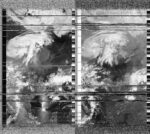
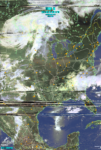
Clear Sky, 20 deg Celsius temperature.
2023-05-18 10:25:53
Ankit Sharma
West Lafayette, Indiana, USA, United States
United States
NOAA-19
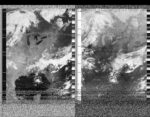
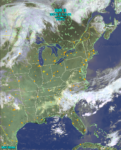
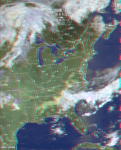
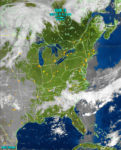
Clear sky, temperature – 20 deg. Celsius
2023-05-18 09:51:51
Ankit Sharma
West Lafayette, Indiana, USA, United States
United States
NOAA-15
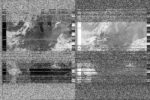
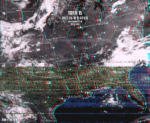
Clear Sky, temp around 20 deg celsius
2023-03-13 11:43:00
Faye Leonie Fine
London, New Cross, UK
UK
NOAA-18
windy, excited, bright but cloudy, noisy
2023-03-13 11:39:33
CRA
Goldsmiths University London, United Kingdom
United Kingdom
NOAA-19
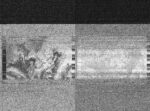
2023-03-13 11:39:00
Centre for Research Architecture: team 1
London, UK
UK
NOAA-18

Wind! Breeze as though we were on a Kent-ish beach
2023-03-13 11:39:00
Leila_Asli_Heloise_Susan
GOLDSMITHS UNIVERISTY OF LONDON, UK
UK
NOAA-18
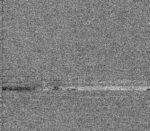
Overcast, Blustery Wind, Patches of Blue
2022-12-07 19:36:41
Maddie J.
Egham, Surrey, United Kingdom
United Kingdom
NOAA-19
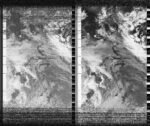
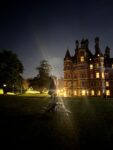
The weather was very cold, hitting 0 degrees celsius during the pass. There was very little wind, only 4mph from the north west.The sky was mostly clear, with some wispier clouds towards the south eastern horizon. The UK is currently experiencing a cold turn with air from the Arctic spreading south across the country and bringing freezing to near-freezing temperatures. In response the Met Office has issued a Level 3 Cold Weather alert across England with very cold nights expected. Due to the ongoing UK Energy Crisis, which has driven household energy costs up, I fear what this cold spell could mean for those trying to save money by not using their heating, those who cannot afford to turn on the heating, and indeed those without heating at all.
During the satellite pass, the warmth of my hands against the cool metal of the turnstile created condensation, making it slippy to hold. As the pass went on my hands lost more feeling, until by the end I couldn't feel them at all, making it difficult to hold the turnstile and afterwards stop the recording and begin to decode it.
2022-10-14 20:23:03
Andrea González
Amsterdam, Netherlands
Netherlands
NOAA-15

Rainy night
2022-10-14 20:21:04
Mei Liu
amsterdam, netherlands
netherlands
NOAA-15
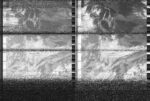
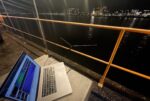
humid, post-rain weather with pretty clear sky
2022-10-08 07:20:00
Jotunheimr
Barra, Rio de Janeiro - RJ, Brazil
Brazil
NOAA-19
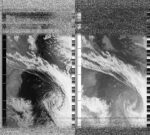
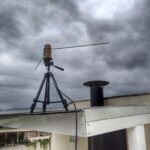
Day pass over South American east coast
2022-09-30 10:32:00
DeAzevedo
Rio de Janeiro, Brazil
Brazil
NOAA-18
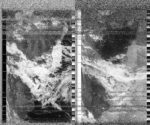
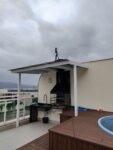
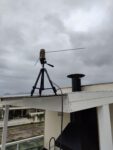
2022-08-14 12:44:15
DaliMDN
Grezieu La Varenne, France
France
NOAA-18

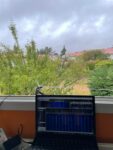
After weeks of dry, extremely hot and sunny days, the sky was thickly loaded with light greys and white clouds.
Some thunder claps woke me up in the early morning and the rain started to pour heavily, watering finally the earth which suffered from drought. That morning, the temperature dropped for almost 10 C degrees in a couple of hours.
2022-05-08 11:35:31
Garyfallenia Tsinopoulou
Athens, Asteroskopeio, Greece
Greece
NOAA-18
2022-08-02 22:23:34
DaliMDN
Saint Barthelemy, France
France
NOAA-18

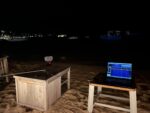
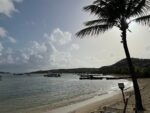
During the pass I was facing the Atlantic Ocean from Grand Cul de Sac beach. The night was dark, warm and breezy. I could hear the sound of the waves slowly lapping the sandy shore while observing the stars thanks to a clear sky. The forecast caption shows the Atlantic Ocean and the Caribbean sea, spanning North to South from Florida to the French Guiana.
2022-07-16 11:44:21
Olga
Warsaw, Poland
Poland
NOAA-18
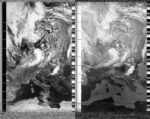



2022-07-15 11:57:41
Olga Miekus
Warsaw, Poland
Poland
NOAA-15

2022-05-07 20:36:17
RQ
Onasis Stegi, Athens, Greece
Greece
NOAA-15

Windy and cool while the sun was setting
2022-06-15 11:56:53
Karolina Pawelczyk
Warsaw, Poland
Poland
NOAA-15
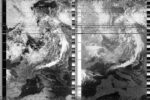


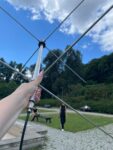
Nice and sunny.
2022-05-08 11:37:41
subrealic
Athens, Greece
Greece
NOAA-18
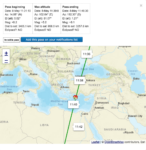
clear view, some clouds
2022-05-08 11:37:03
Matina K.
Athens, Greece
Greece
NOAA-18
2022-05-08 11:36:00
Lily Has
Athens, Greece
Greece
NOAA-18

The weather these days is so unpredictable that I brought a jacket with me. That was really unnecessary as it was really warm and sunny. I was afraid that my computer would overheat and crash again.. I am used to sweat and feel warm, but my devices are not.
2022-05-08 11:36:00
chris
Athens, Greece, Greece
Greece
NOAA-18



interesting
2022-05-08 11:33:42
open-weather
Athens, Greece
Greece
NOAA-18

2022-05-08 09:49:50
subrealic
Athens, Greece
Greece
NOAA-19
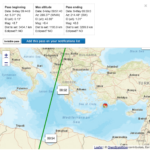
clear sky, surrounded by higher buildings
2022-05-07 19:38:41
anna
athens, Greece
Greece
NOAA-15
noaa15
2022-05-07 20:36:00
Christos Tsetsis
Athens, Greece
Greece
NOAA-15

2022-04-17 20:04:07
DaliMDN
London, England
England
NOAA-19

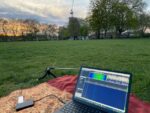
There was almost no wind, the sky just above was clear and the temperature was slowly lowering as the sun was setting behind distant clouds.
2022-02-12 19:14:52
Andric Spaeth
Kassel, Germany
Germany
NOAA-19
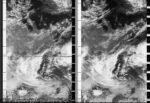

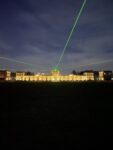
Partly Cloudy
2021-11-21 08:14:24
Jon Uriarte
Hilly Fields Stone Circle, Hilly Fields, Brockey, London, England
England
NOAA-19
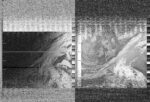
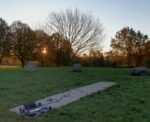
Bluesky cold and beautiful sunrise
2021-11-01 08:56:00
Yoshi MATSUOKA
Atsugi Kanagawa, Japan
Japan
NOAA-15

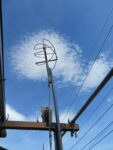
Pattern of cloud is the beauty of the nature.
2021-10-31 19:41:20
WXVids
Albany, NY, USA
USA
NOAA-19

2021-10-31 19:29:13
WXVids
Albany, NY, USA
USA
NOAA-15

2021-11-01 07:30:00
Yoshi MATSUOKA
Atsugi Kanagawa, Japan
Japan
NOAA-19

Pattern of cloud is the beauty of the nature.
2021-11-01 07:15:00
Yoshi MATSUOKA
Atsugi Kanagawa, Japan
Japan
NOAA-15

Pattern of cloud is the beauty of the nature.
2021-11-01 08:07:13
Natasha Honey
Newcastle, NSW, Aaustralia
Aaustralia
NOAA-19




Bright, Sunny. Not many clouds in the sky, cool breeze.
2021-11-01 05:44:00
Yoshi MATSUOKA
Atsugi Kanagawa, Japan
Japan
NOAA-19

2021-10-31 16:12:30
Catherine Fletcher
Norfolk, VA, United States
United States
NOAA-18
mostly sunny, light breeze, 14 degrees C/58 degrees F
2021-10-31 10:59:12
Steve Engelmann
Los Angeles, CA, USA
USA
NOAA-18

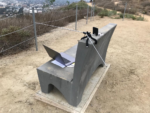
2021-10-31 11:50:19
L. Paul Verhage
Homedale, Idaho, USA
USA
NOAA-18
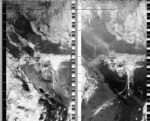
2021-10-31 17:57:31
Sybille
Berlin, Tempelhofer Feld, Germany
Germany
NOAA-19




A clear sky, slightly damp, fresh autumn air, windstill.
2021-10-31 18:56:46
Aouefa Amoussouvi
Bucharest, Romania
Romania
NOAA-19

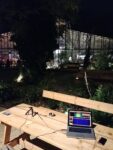
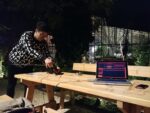
cosy chill evening
2021-10-31 08:33:00
Zack Wettstein
Seattle, Washington, USA
USA
NOAA-19
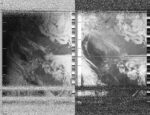
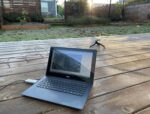
I was crouched on the ground, huddled against the cold, my knees pressed on the frosty wood slats, as I was capturing the NOAA19 pass this morning. The sun had just risen and was gently warming the surroundings, and I watched the frost melt during the recording. This cold, dry, autumn, morning, with no wind in sight, is in stark contrast to the weather of the past week, when we were struck with an atmospheric river of rain from a bomb cyclone off the Pacific.
2021-10-31 08:47:49
Carl Reinemann usradioguy.com
Jefferson Wisconsin, United States
United States
NOAA-15
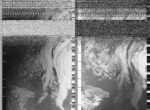

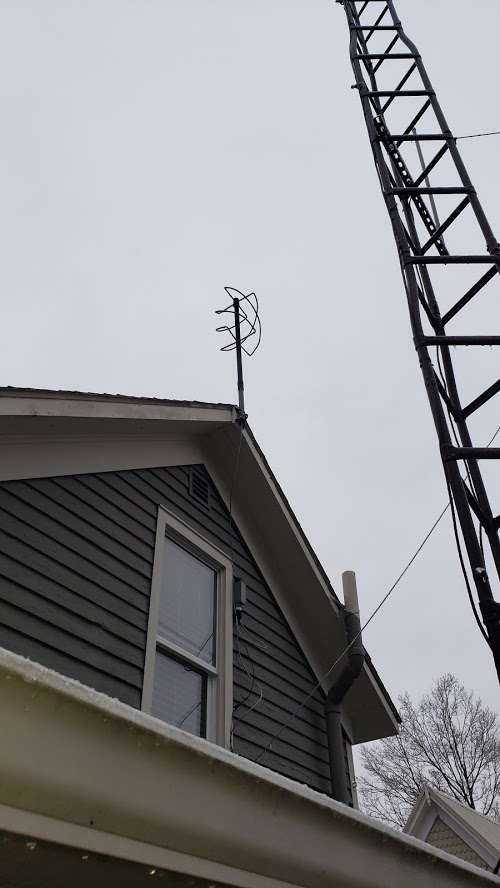
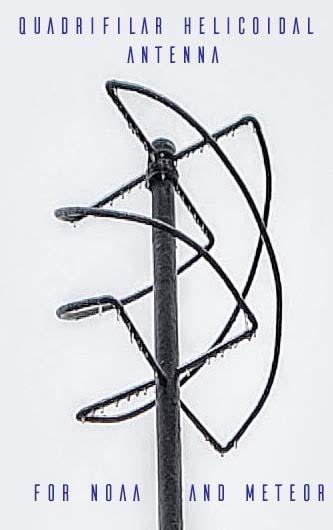
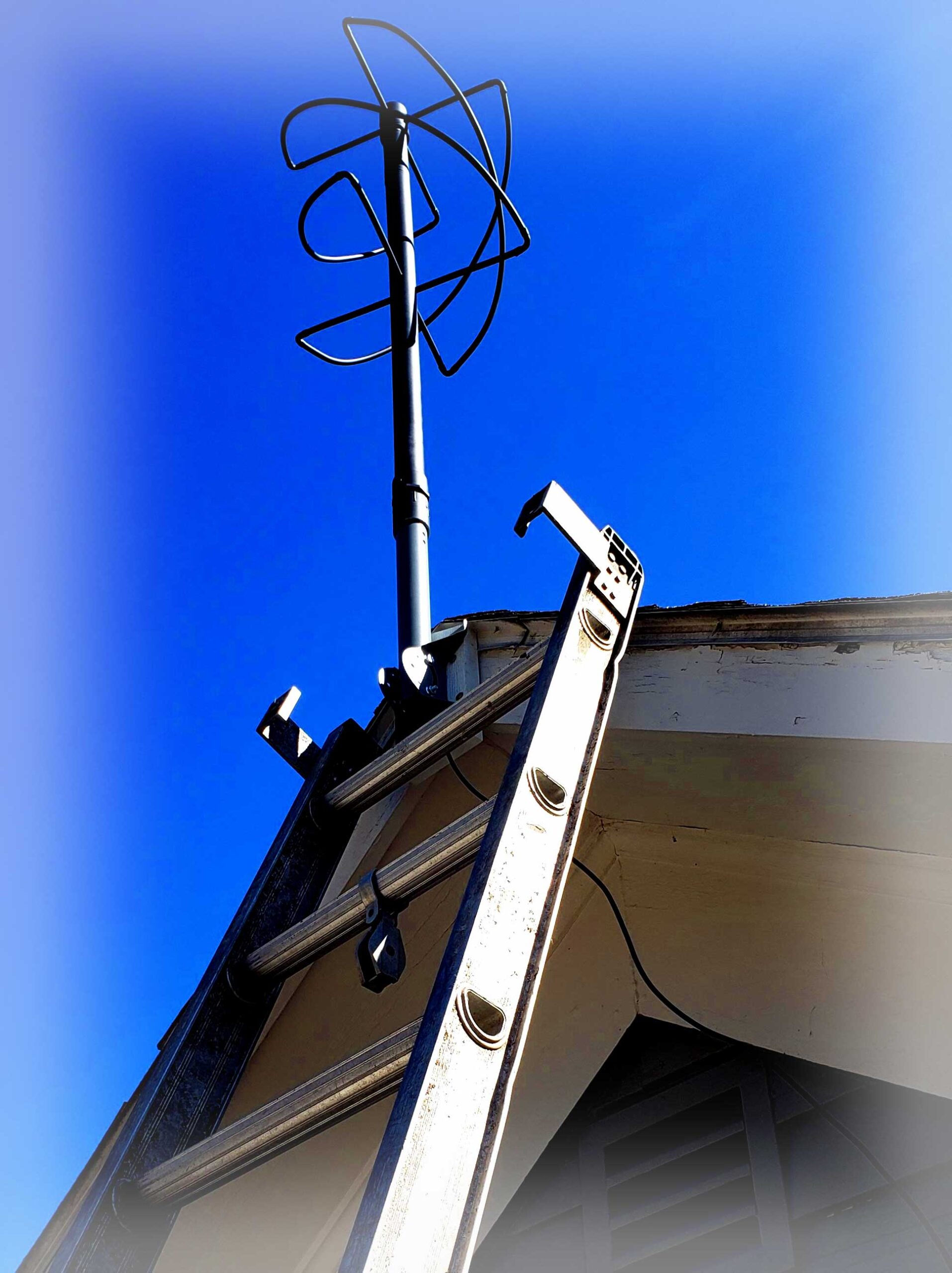
Fall is here. Tempsdown to a chilly 44°F this morning and the leaves are a briliant crimson
2021-10-31 10:05:49
Aimee Juhazs
Joaquin Ezcurra
Parque Nacional Ciervo de los Pantanos, Campana, Argentina, Argentina
Argentina
NOAA-18
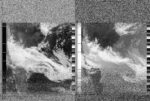
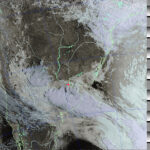
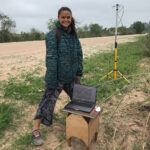
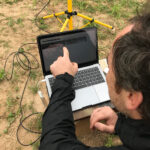
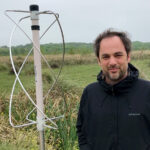
Today was a day of unexpected low temperatures, after many days of intense heat in the region of Buenos Aires and surrounding areas. After a week of record high temperatures -this has been the hottest October in record- the, but the arrival of a Sudestada, cooled the region. The Sudestada (Southeast blow) is a common meteorological phenomenon in the region of Río de la Plata and surrounding areas, of cold winds from the south to the southeast quadrant, which saturates polar air masses with moisture. Since the Río de la Plata is immensely wide and rather shallow, this wind has been historically associated with rising waters and floods. As we were recording the NOAA satellite passes, the wind was blowing at roughly 30kms per hour – and increasing- from the SE, and the temperature falling. The moving mass of air lifted the dust of a dirt road, and at times, the screen of my laptop moved when it received a sudden wind gust. The arrival of this breeze had us a little worried if it would be accompanied with precipitation, but thankfully no, we could do the whole satellite pass without getting wet. The wind did give us a sense of excitement and connection with what we were doing. In this respect, as the sky was overcast, we reflected on how the satellite download link was offering us a glimpse above the very same clouds we were seeing.
2021-10-31 08:11:09
Carl Reinemann Usradioguy.com
Jefferson Wisconsin, United States
United States
NOAA-19
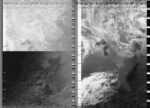
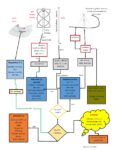

Cold, 44° F Fall is upon us and the leaves are crimson red
2021-10-31 08:10:59
Bill Liles
Reston, Virginia, USA
USA
NOAA-15

It is 11.1 Degrees C. Misty pleasent
2021-10-31 12:55:43
Barfrost
Kirkenes, Norway
Norway
NOAA-19
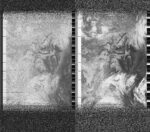

cold and fog
2021-10-31 11:06:30
George Ridgway
Melbury Abbas, England
England
NOAA-18

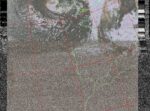
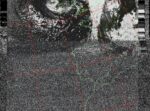


Very gusty and squally. Open skies and with intermittent passing cloud cover in strong winds. Wind from South Westerly direction.
2021-10-31 12:01:59
Olivia Berkowicz
Paris, France
France
NOAA-18
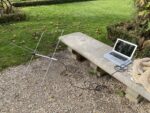
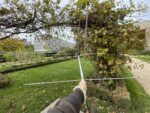
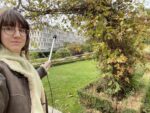
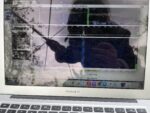
The weather in central Paris around noon was predominantly sunny and quite warm for the season. It didn't rain as it has been doing for the last few days, and I was surprised. What was also peculiar, was the warm temperature. It's almost the beginning of November and I had to take off my jacket and only wear a jumper. I have been wondering whether Paris really is this warm around this time of the year. I grew up in Scandinavia, and autumn is usually quite cold and crisp. I worry sometimes that things are not quite right with the temperature and amount of precipitation that I experience here.
2021-10-31 11:01:12
Aaron McCarthy
Alison Scott
Glasgow, Scotland, Scotland, UK
Scotland, UK
NOAA-18

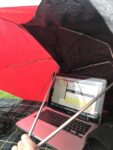
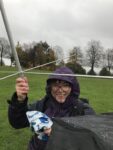
I normally check the N2YO NOAA satellite predictions alongside the MET office weather forecast, trying to pick ‘good’ passes on ‘good’ days. Because we’re heading into winter, with shortening days and darkening skies, this doesn’t always happen. Today is Halloween, Samhain, marking the end of the harvest and the start of winter; thought to be a liminal time when boundaries thin between worlds. Today I would be out whatever the weather to take part in the nowcast, to tune in to the transmission of an orbiting body. I decided this morning to stay away from the COP26 crowds: stay close to home for a quick escape from the rain, setting up in my usual spot in a park in the Southside of Glasgow. I had planned to head down to the river – get close to the summit site, the UN territory, and the many offshoots – but couldn’t think of an open space (not being used, closed or heavily policed) where I could see the sky.
Today the weather became an obstacle – as it does when it makes itself known – and a challenge. How to protect a laptop and a tangle of cables? I can handle rivlets running up sleeves, raindrops on glasses, and there are waterproofs designed for my body. Still, for a city that gets a lot of rain, there’s very little shelter in public places. With the help of my partner I fashion protection for my ground station by balancing two umbrellas on a picnic blanket, on a bench, up the grassy hill in the park. He very kindly keeps the brolly-shelter set up under control while I tune in to the satellite, pointing the antenna to the North North East, into the rain cloud hanging over the city. He points out to me I’m aiming towards the SECC (the COP26 summit site) – on a clear day this is a good vantage point. It’s pretty dreich: consistent heavy rain, but not quite an absolute battering. Normally I would stretch my arm out more, move around with the satellite’s transmission as it moves from NNE to SSW, but this time just stay low and move less in an attempt to keep the dongle and cables as dry as I can. This makes me a bit clumsy and the recording a bit short. I don’t know if the umbrellas have an effect or likewise the extra-closeness of bodies to the antenna. The sound of the satellite transmission comes brightly through the static, through the cloud. A woman appears behind me and asks a question. I think I must look like I’m holding an umbrella without the fabric. It’s a variation of the usual response I’ve got to being in public with an big turnstile antenna (‘what is it you’re trying to do?’) but I don’t hear her at first as I’m listening to the radio transmission with headphones on. Wet dogs run about at our feet. She is friendly, not that interested, just tidying up her allotment in the plot in the park and noticed something unusual. She tells me she is drenched but if you wanted to stay dry in Scotland you’d never do anything, would you?
2021-10-31 11:00:17
Sasha Engelmann
Soph Dyer
The Photographers' Gallery, London, UK
UK
NOAA-18

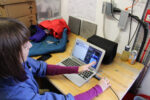
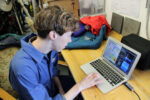

We woke to the sound of sheet rain. The weather apps on our phones marked our location on the edge of cyclonic weather system, its eye over Ireland. A yellow weather warning was in place for the South of the England. On way to The Photographers' Gallery, our location for the satellite pass, a branch fell on the car’s windscreen. A man on the radio ranted about the hypocrisy of world leaders flying into COP on “their private jets”, while he was expected to holiday on the Gower Peninsula. An Extinction Rebellion spokesperson joined in, live from Glasgow, only to be thrown off message by hostile questioning. We were in heavy weather!
The conversation in the car shifted to the more-than-meteorological weather, of London and the UK. What are the conditions that weigh and press on us and the people we know? London is vibrant with events and open pubs after years of lockdown, yet we know we do not weather the unfolding pandemic equally. There are signals of political and social movement. University workers are voting this week to potentially take strike action due to precarious labour conditions, an unacceptable gender pay gap and unequal policies in higher education.
By the time we reached the gallery, the rain had stopped. During the satellite pass it was still grey and squally, but by the end of the pass there was bright blue sky.
In background, the spinning screens of the BT tower announced the first day of COP26.
2021-10-31 07:48:00
pablo cattaneo
mar del plata, Argentina
Argentina
NOAA-15
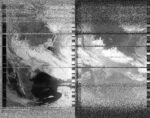


muy bueno hacer la antena instalar configurar sdr para ls recepcion, hay mucho para mejorar sin duda.
2021-10-31 07:47:48
Aimee Juhazs
Joaquin Ezcurra
Parque Nacional Ciervo de los Pantanos, Campana, Argentina, Argentina
Argentina
NOAA-15

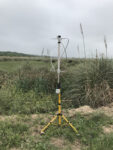
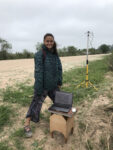
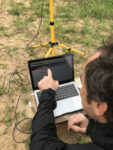

Today was a day of unexpected low temperatures, after many days of intense heat in the region of Buenos Aires and surrounding areas. After a week of record high temperatures -this has been the hottest October in record- the, but the arrival of a Sudestada, cooled the region. The Sudestada (Southeast blow) is a common meteorological phenomenon in the region of Río de la Plata and surrounding areas, of cold winds from the south to the southeast quadrant, which saturates polar air masses with moisture. Since the Río de la Plata is immensely wide and rather shallow, this wind has been historically associated with rising waters and floods. As we were recording the NOAA satellite passes, the wind was blowing at roughly 30kms per hour – and increasing- from the SE, and the temperature falling. The moving mass of air lifted the dust of a dirt road, and at times, the screen of my laptop moved when it received a sudden wind gust. The arrival of this breeze had us a little worried if it would be accompanied with precipitation, but thankfully no, we could do the whole satellite pass without getting wet. The wind did give us a sense of excitement and connection with what we were doing. In this respect, as the sky was overcast, we reflected on how the satellite download link was offering us a glimpse above the very same clouds we were seeing.
2021-10-31 10:21:01
Anna Pasco Bolta
Munich, Germany
Germany
NOAA-18
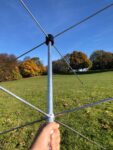
2021-10-31 20:44:11
Natasha Honey
Newcastle, NSW, Australia
Australia
NOAA-19




Windy and cool, misty and foggy.
2021-10-31 10:22:23
Jasmin Schädler / FamSchä
Schloss Solitude, Gerlingen, Germany
Germany
NOAA-18



The weather this morning was beautiful and since we just ended daylight saving last night it was already really bright and also quite sunny. The temperature felt very agreeable even at 10 degrees due to the sun. The fog had by now disappeared – this is my second pass of the day. By now the clouds were of cirrocumulus and cirrus kind. The second location I chose for sensing was further outside the city on the balcony of a small castle. It was more windy there and the trajectory was partially blocked by surrounding buildings which has substantial influence at an elevation of 47°. However, the reception was much clearer most of the time than during the first pass with an elevation of 77°. Theoretically the pass started at 18 past but I was only able to receive a proper signal at around 22 so I also only started the recording at this moment in time.
2021-10-31 10:21:00
Flow
Venice, Italy
Italy
NOAA-18

weather was good but cloudy
2021-10-31 08:07:11
Jasmin Schädler / FamSchä
Stuttgart, Germany
Germany
NOAA-19




The weather this morning was beautiful and since we just ended daylight saving last night it was already really bright and also quite sunny. The temperature felt very agreeable even at 9 degrees due to the sun. There was some fog lying over the city and the sun light was defused by some thin clouds. There was almost no wind. I chose an outlook platform for this pass that is located such that the trajectory from N-E-S was free of obstacles. I had a perfect view over the valley that the inner city of Stuttgart is located in. Even though the pass had an elevation of 70°, I had trouble receiving the signal. It felt somehow deflected and was difficult to capture. The whole pass was very noisy and the resulting image is almost pure distortion.
2021-10-31 11:32:06
Ankit Sharma
Mumbai, India
India
NOAA-18
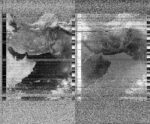
Very hot and Humid as well as Very very dusty.
2021-10-31 09:51:39
Ankit Sharma
Mumbai, India
India
NOAA-18
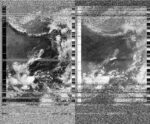
weather had changed to hot and humid . More windy and clear sky. Peak Increase in Dust up to the limit that my laptop had a layer of dust on it when checked post reception. heavy pollution was felt .
2021-10-31 09:42:51
Chonmapat Torasa
Bangkhen, Bangkok, Thailand
Thailand
NOAA-18

2021-10-31 07:34:44
Ankit Sharma
Mumbai, India
India
NOAA-19
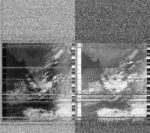
Weather during this reception was pleasant, windy moderate temp of 27 degree Celsius felt like 25. Humidity was high. Sky was totally clear with no clouds.
2021-10-31 07:25:00
Chonmapat Torasa
Bangkhen, Bangkok, Thailand
Thailand
NOAA-19

2021-10-31 10:37:16
Natasha Honey
Newcastle, NSW, Australia
Australia
NOAA-18




Bright Sunny morning, A few clouds, but generally clear. A bit warm with a soft breeze.
2021-10-31 07:35:08
Dey Kim
Goyang, South Korea
South Korea
NOAA-19
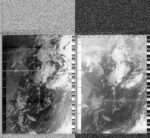
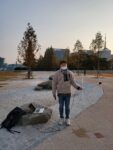
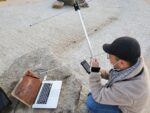
Partly cloudy
2021-10-30 11:37:17
Sofia Cyclone
Santa Vittoria In Matenano, Italy
Italy
NOAA-18
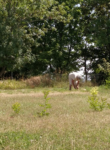
It seemed like the weather was in my favor. I positioned my DIY Satellite Station on a sunny spot on the field. The day was sunny, and I felt warm sitting in the sun. However, I could tell I was “experiencing” the winter weather by looking at the cirrus clouds in the sky and by the sudden cold breeze, that would surprise me when I was concentrated holding the antenna and looking at the SDR waterfall.
2021-10-29 11:47:18
Sofia Cyclone
Santa Vittoria in Matenano, Italy
Italy
NOAA-18

2021-10-28 09:30:49
Cédrick Tshimbalanga
Kinshasa, DR Congo
DR Congo
NOAA-18





FR: Mon expérience pendant cette période était que je n'ai jamais travaillé avec la météo, et et non plus avec des antennes, mais j'étais très impatien pour voir les images satélitaire et aussi une chose que j'ai aussi aimé c'est que j'ai apris a capté le passe satelite. C'était très difficile au début mais après très facile et un peu comme un jeu ou je dois reclter des images avec précision mais aurienté par un son c'était trés interéssant et j'ai beaucoup aimé. EN: My experience during this period was that I never worked with the weather, nor with antennas, but I was very impatient to see the satellite images and also one thing that I also liked is that I I learned the satelite pass. It was very difficult at the beginning but afterwards very easy and a bit like a game where I have to capture images with precision but being directed by a sound it was very interesting and I liked it a lot. (English translation by Sasha Engelmann)
2021-10-07 03:51:53
Asst. Prof. Dr. Chonmapat Torasa
,
NOAA-19
2021-09-19 03:51:53
Lothringer 13 Halle
,
NOAA-18

2021-09-19 03:51:53
Lothringer 13 Halle
,
NOAA-19

2021-09-18 03:51:53
Lothringer 13 Halle
,
NOAA-19

2021-09-17 03:51:53
Lothringer 13 Halle
,
NOAA-19

2021-09-14 03:51:54
Lothringer 13 Halle
,
NOAA-18

2021-09-13 03:51:54
Lothringer 13 Halle
,
NOAA-19
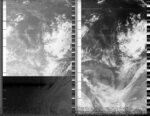
2021-09-11 03:51:54
Lothringer 13 Halle
,
NOAA-18

2021-09-06 03:51:54
Lothringer 13 Halle
,
NOAA-18

2021-09-02 03:51:54
Sasha Engelmann
,
NOAA-18
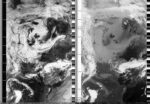
2021-08-20 03:51:54
Lothringer 13 Halle
,
NOAA-18
2021-08-13 03:51:55
Lothringer 13 Halle
,
NOAA-19

2021-07-29 03:51:55
Lothringer 13 Halle
,
NOAA-19

2021-07-24 03:51:55
Lothringer 13 Halle
,
NOAA-19

2021-07-23 03:51:55
Lothringer 13 Halle
,
NOAA-18

2021-07-20 03:51:55
Sasha Engelmann
,
NOAA-18
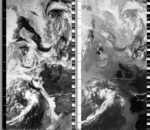
2021-07-13 03:51:56
Lothringer 13 Halle
,
NOAA-18

2021-03-28 03:51:56
Fanteugia
,
NOAA-18
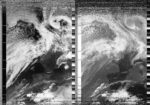
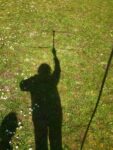
2021-03-28 03:51:56
flow
,
NOAA-18
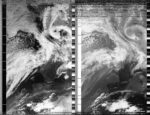
2021-03-28 03:51:56
Olivia Berkowicz
,
NOAA-18
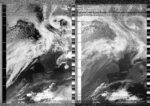
Decoding with Akademie Schloss Solitude fellows, second day of decoding
2021-03-05 03:51:56
George Ridgway
,
NOAA-18

2021-01-26 03:51:56
n.n.n. collective
,
NOAA-15

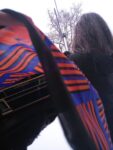
This stellite pass was recorded while it was snowing. Although the pass was happening at almost 90 degrees it was very difficult to receive the signal. We were standing on a hill that overlooks valleys on both sides. Theoretically there were no large obstructions blocking the signal and the direction of the pass was clear.
2021-01-24 03:51:57
FamSchä
,
NOAA-18
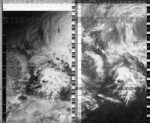

This was my dad's very first satellite sensing session. We did it in the open field on a beautiful sunny morning and a pass at almost 90 degrees.
2021-01-23 03:51:57
FamSchä
,
NOAA-19

This image was received together in collaboration with my mum. We were not able to receive a signal although all the settings were correct so we tried to change location and walked to the open crossway close by. Eventually I saw the signal at 138.009.662 instead of the regular NOAA 19 frequency which I had set Cubic SDR to. I changed frequency and suddenly we received the signal and started recording. So far nobody has been able to explain this frequency shift of the satellite to me. Any hints are welcome.
2021-01-23 03:51:57
FamSchä
,
NOAA-18

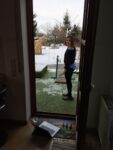
This image was received simultaneously with a friend in a different location. We had exchanged the passing times earlier in the day and then both sensed from our locations and shared our images later on. The sensing was done domestically on the porch – just stepping outside to check the satellite.
2021-01-23 03:51:57
FamSchä
,
NOAA-15

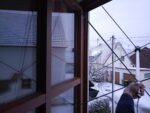
When I woke up I wanted to check the satellite passes for the day and realized there was one happening in that very moment, passing right in front of my window. I quickly assembled the antenna and caught the second half of the pass through the open window of my room.
2021-01-20 03:51:57
n.n.n. collective
,
NOAA-15
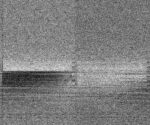
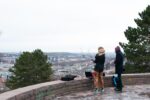
The sensing happened on a hill everyone refers to as Teehaus due to the tea house that stands there. The hill allows a North-West-South view over the city valley. It was difficult to climb the hill due to ice and there was a cold wind blowing. Our hands were extremely cold during the sensing. Since the satellite passed only at 49 degrees and the hill we were standing on was not higher than the hills surrounding the valley on the other side, we received only a very weak and partial signal.
2020-11-07 03:51:57
n.n.n. collective
,
NOAA-19

The recording was done in the proximity of Kunstverein Wagenhallen e.V. The occasion was the preparation of an exhibition dealing with Hegel's universalism and its influence on location and mapping as political practices. The area is industrial and surrounded by a lot of large metal constructions.
2020-11-07 03:51:58
n.n.n. collective
,
NOAA-18
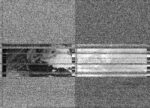

The recording was done in the proximity of Kunstverein Wagenhallen e.V. The occasion was the preparation of an exhibition dealing with Hegel's universalism and its influence on location and mapping as political practices. The area is industrial and surrounded by a lot of large metal constructions.
2020-10-07 03:51:58
Sasha
,
NOAA-18
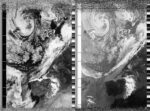
2020-10-07 03:51:58
Yoshi
,
NOAA-18
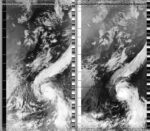
2020-09-22 03:51:58
Yoshi
,
NOAA-18
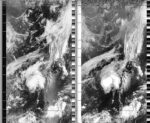
2020-09-21 03:51:58
FamSchä
,
NOAA-19

This recording happened by accident. We were playing around with the antenna on the porch and suddenly the signal appeared so we decided to record it. The antenna was held by three people, one did it for the first time. It was a pleasant evening with the BBQ just heating up.
2020-09-21 03:51:58
FamSchä
,
NOAA-18
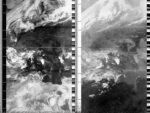
This was a family effort. Three people involved in the recording, two did it for the first time. It was an open field in the country side, clear blue sky. Many passersby were irritated by the activity. Afterwards we listened to some radio together.
2020-09-21 03:51:59
Yoshi
,
NOAA-18
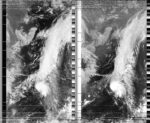
2020-09-20 03:51:59
Yoshi
,
NOAA-15
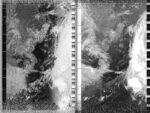
2020-09-18 03:51:59
FamSchä
,
NOAA-19

This image was taken in the proximity of many more turnstile antennas during a group sensing session as the finale of an amazing workshop. The surrounding was an artist built compound. It was my very first recording.
2020-09-09 03:51:59
Carl Reinemann
,
NOAA-19
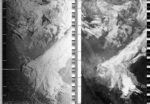
Overcast with rain showers all day. High 56F. Winds NE at 10 to 15 mph. Very Gloomy
2020-09-06 03:51:59
Ankit Sharma
Mumbai, India
India
NOAA-18
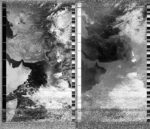
Sky – Totally Clear, Very sunny and warm Atmosphere, Ambient Temperature – 36 Degree Celsius. Country – India.
2020-09-06 03:51:59
zwettstein
Seattle, Washington, USA
USA
NOAA-18

2020-09-06 03:52:00
zwettstein
Seattle, Washington, USA
USA
NOAA-19

Currently experiencing wildfire particulate drifting in from the Pacific Ocean, originating from forest fires in Oregon and California…
2020-09-07 03:52:00
Steve Engelmann
Hills of Malibu, CA, USA
USA
NOAA-19

I drove up into the hills of Malibu. It was 41°C. I hope everything recorded correctly. I heard the ticking. I'm very interested to see what it looks like.
2020-09-06 03:52:00
Joaquin Ezcurra
Island in Sarmiento river,
NOAA-15


Recorded on an island in Sarmiento river, part of the Delta of Paraná river, where wetlands have been burning in the last months.
2020-09-06 03:52:00
Audrey Briot
Saint André, France
France
NOAA-15
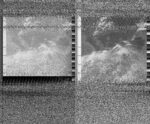
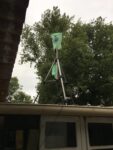
It was raining today so I installed my V-Dipole antenna on one of my studio's rooftop. I covered it with plastic bags to protect connexions. The antenna is facing south, which means that it is kind of facing the house of my neighbour. This neighbour is often spying us, so I wonder what she thinks about this antenna.
2020-09-06 03:52:00
Sasha Engelmann
Schloss Solitude, Stuttgart, Germany
Germany
NOAA-19
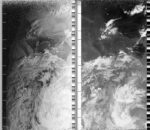

Excerpt from 'Autumn' by Rainer Maria Rilke:
The leaves fall, fall as from far,
Like distant gardens withered in the heavens,
They fall with slow and lingering descent.
And in the nights, the heavy Earth too, falls,
From out the stars into the Solitude.
2020-09-06 03:52:00
Bill
Reston, Virginia, USA
USA
NOAA-18

2020-09-06 03:52:01
Bill
Reston, Virginia, USA
USA
NOAA-15

2020-09-06 03:52:01
Ankit Sharma
Mumbai, India
India
NOAA-19
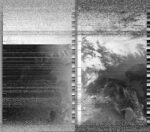
Sky – Clear, Ambient Temperature – 29 degree Celsius, Night Pass, Country – India.
2020-09-06 03:52:01
Ankit Sharma
Mumbai, India
India
NOAA-15
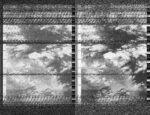
Sky – Clear, Ambient Temperature – 29 Degree Celsius, Night pass, Country – India.
2020-09-06 03:52:01
Bill
Reston, Virginia, USA
USA
NOAA-19

2020-09-06 03:52:01
Bill
Reston, Virginia, USA
USA
NOAA-15

2020-09-06 03:52:01
WXVids
Albany, NY, USA
USA
NOAA-15
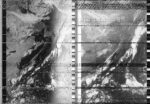
not sure of the political climate, seems mixed.
2020-09-06 03:52:02
Ankit Sharma
Mumbai, India
India
NOAA-19
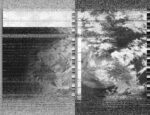
Sky – Cloudy, Ambient Temperature – 31 degree celsius, Country – India.
2020-09-06 03:52:02
Soph Dyer
London, United Kingdom
United Kingdom
NOAA-18
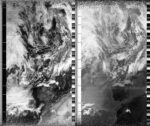
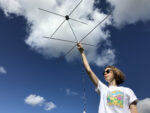
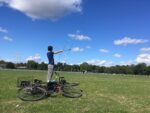
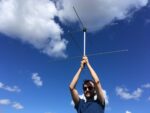
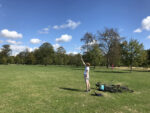
2020-09-06 03:52:02
L. Paul Verhage
Homedale, Idaho, USA
USA
NOAA-18

2020-09-06 03:52:02
Sofia Caferri
Santa Vittoria in Matenano, Italy
Italy
NOAA-15
As the temperature rises, the political climate gets heated here in my village. The extremely high temperatures during both summer and winter have negatively influenced the amount of drinkable water during the year. The local government implemented strategies for preserving water by cutting off water supply during the night hours. Collectively the community is trying to rationalize water. The shortage and scarcity of water are creating tension between citizens. The fear of not having water or being able to take a shower, wash your vegetables, cook meals is growing among the villagers. Particularly during the pandemic where washing hands is an important hygienic step, water scarcity generates an unsettling climate.
2020-09-06 03:52:02
Ankit Sharma
Mumbai, India
India
NOAA-15
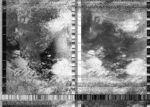
Sky – Mostly clear with few Clouds, sunny day , Ambient Temperature – 35 Degree Celsius, Country – India.
2020-09-05 03:52:02
Bill
Reston, Virginia, USA
USA
NOAA-19

2020-09-05 03:52:03
Yoshi Matsuoka
Atsugi Kanagawa, Japan
Japan
NOAA-15
2020-09-05 03:52:03
Yoshi Matsuoka
Atsugi Kanagawa, Japan
Japan
NOAA-19
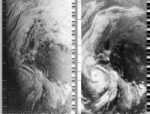
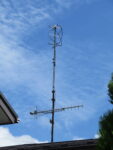
2020-07-26 03:52:03
Sasha
,
NOAA-19
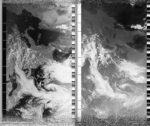
2020-07-16 03:52:03
Sasha
,
NOAA-18
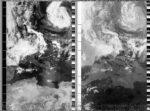
2020-05-17 03:52:03
Sasha
,
NOAA-18
